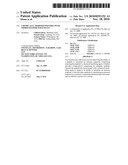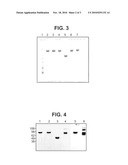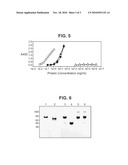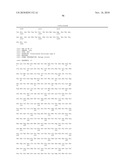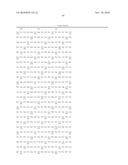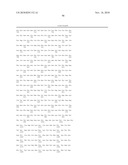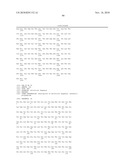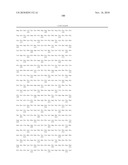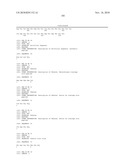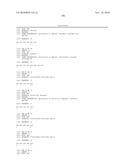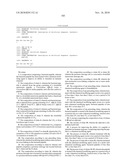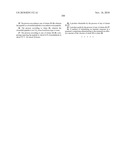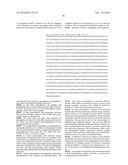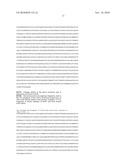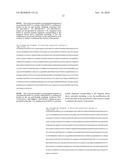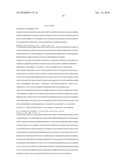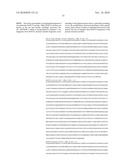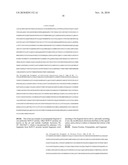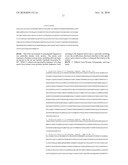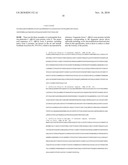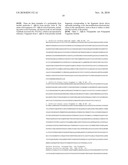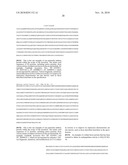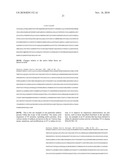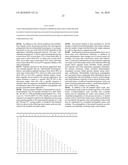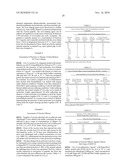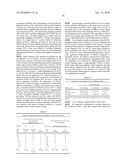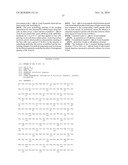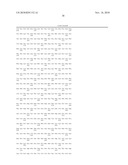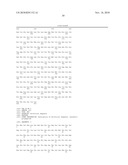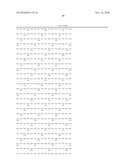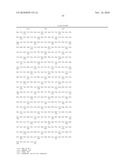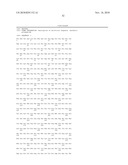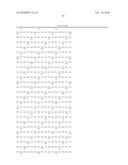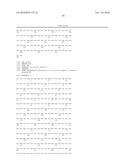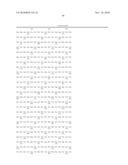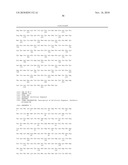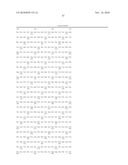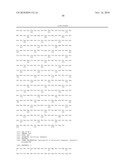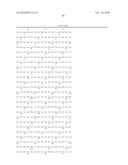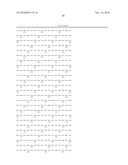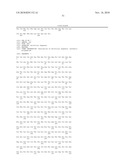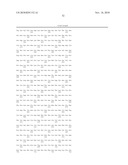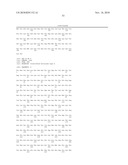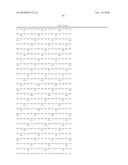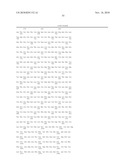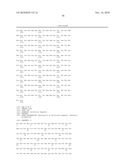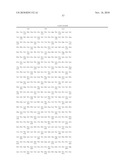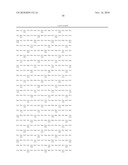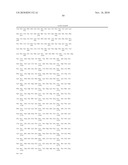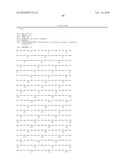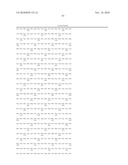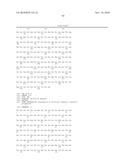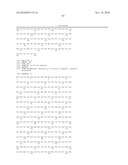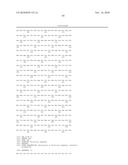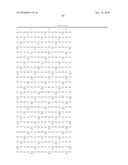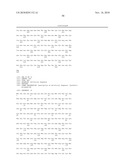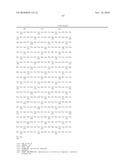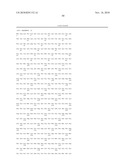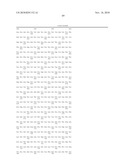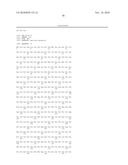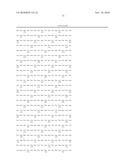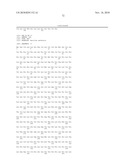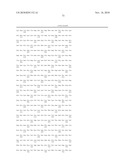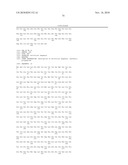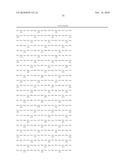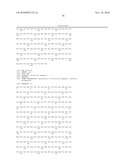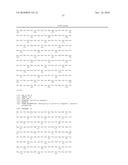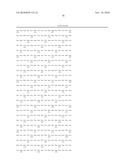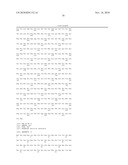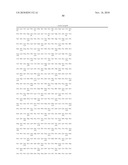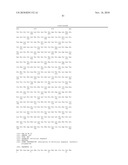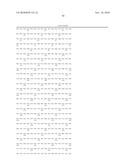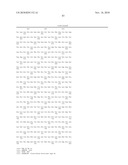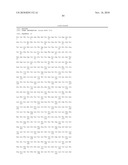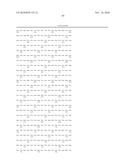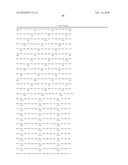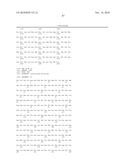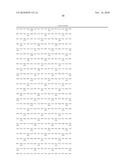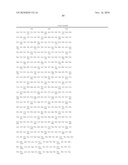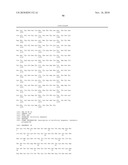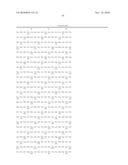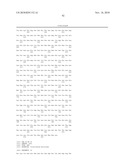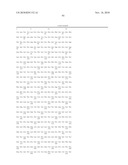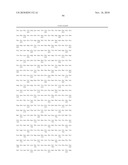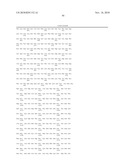Patent application title: CHEMICALLY MODIFIED PEPTIDES WITH IMPROVED IMMUNOGENICITY
Inventors:
Clifford Shone (Wiltshire, GB)
Xiaomi Tong (Leesburg, VA, US)
Joanna Clancy (Wilmington, NC, US)
Mili Gu (Gaithersburg, MD, US)
IPC8 Class: AA61K3907FI
USPC Class:
4242461
Class name: Antigen, epitope, or other immunospecific immunoeffector (e.g., immunospecific vaccine, immunospecific stimulator of cell-mediated immunity, immunospecific tolerogen, immunospecific immunosuppressor, etc.) bacterium or component thereof or substance produced by said bacterium (e.g., legionella, borrelia, anaplasma, shigella, etc.) bacillus
Publication date: 2010-11-18
Patent application number: 20100291152
Claims:
1. A composition comprising a bacterial peptide, wherein the bacterial
peptide has been treated with a chemical modifying agent to improve its
ability to stimulate an immune response.
2. The composition of claim 1, wherein the bacterial peptide is selected from the group consisting of a clostridial neurotoxin peptide, a Clostridium difficile toxin, a Clostridium difficile surface peptide, and a Bacillus anthracis peptide.
3. The composition of claim 2, wherein said bacterial peptide is a clostridial neurotoxin peptide that lacks a functional HC of a clostridial neurotoxin heavy chain.
4. The composition of claim 2, wherein said bacterial peptide is selected from a group consisting of a C. difficile Toxin A, C. difficile Toxin B, C. difficile binary toxin or C. difficile Cwp 84 peptide.
5. The composition of claim 2, wherein said bacterial peptide is selected from the group consisting of a Bacillus anthracis PA, LF or EF peptide.
6. The composition of claim 3, wherein the clostridial neurotoxin peptide is LHN.
7. The composition of claim 6, wherein the LHN is from botulinum type A toxin.
8. The composition of claim 7, wherein the LHN comprises amino acid residues 2-871 of botulinum neurotoxin serotype A.
9. The composition of claim 7 or claim 8, wherein the LHN comprises a Glu to Gln mutation as residue 224 and a His to Tyr mutation at residue 227.
10. The composition according to any preceding claim, wherein the chemical modifying agent induces intra-molecular cross-linking in the bacterial peptide.
11. The composition according to claim 6, wherein said peptide comprises a protease cleavage site located between the L-chain and the H-chain.
12. The composition according to claim 11, wherein the protease cleavage site is located at a position that corresponds to a position between residues 440 and 455 of SEQ ID NO: 1.
13. The composition according to claim 11 or claim 12, wherein the protease cleavage site is a non-native clostridial neurotoxin cleavage site.
14. The composition according to claim 10, wherein the intra-molecular cross-linking comprises one or more methylene bonds.
15. The composition of any preceding claim, wherein the chemical modifying agent is formaldehyde.
16. The composition of any preceding claim, wherein treatment with the chemical modifying agent occurs over a period of less than 3 days, less than 2 days, or over a period of 36 hours or less.
17. The composition of any preceding claim, wherein treatment with the chemical modifying agent occurs at a molar ratio (chemical modifying agent: bacterial peptide) of less than 50:1 or less than 25:1.
18. The composition of any preceding claim, wherein the bacterial peptide is treated with chemical modifying agent in a reaction mix at a ratio (chemical modifying: reaction mix) of less than 2%, less than 1%, or less than 0.5%.
19. A vaccine comprising the composition of any of claims 1-18 and an adjuvant.
20. The vaccine of claim 19, wherein the adjuvant is aluminium hydroxide.
21. A process for improving the ability of a peptide to stimulate an immune response, comprising exposing the peptide to a chemical modifying agent.
22. The process of claim 21, wherein treatment with the chemical modifying agent occurs over a period of less than 3 days, less than 2 days, or over a period of 36 hours or less.
23. The process of claim 21 or claim 22, wherein treatment with the chemical modifying agent occurs at a molar ratio (chemical modifying agent: bacterial peptide) of less than 50:1 or less than 25:1.
24. The process of any of claims 21-23, wherein the peptide is treated with chemical modifying agent in a reaction mix at a ratio (chemical modifying: reaction mix) of less than 2%, less than 1%, or less than 0.5%.
25. The process according to any of claims 21-24, wherein the peptide is a clostridial peptide or an anthrax toxin peptide.
26. The process according to claim 26, wherein the clostridial peptide is an LHN from botulinum type A toxin.
27. The process according to any of claims 21-26, comprising exposing the peptide to about 0.2% formaldehyde at about 35.degree. C. for about 24 hours.
28. A product obtainable by the process of any of claims 21-27.
29. A product made by the process of any of claims 21-27.
30. A method of stimulating an immune response in a mammal, comprising administering to the mammal an effective amount of the vaccine of claim 19 or claim 20.
Description:
CROSS REFERENCE TO RELATED APPLICATIONS
[0001]This application claims the benefit of U.S. Provisional Application Nos. 60/929,125, filed Jun. 14, 2007, 60/960,771, filed Oct. 12, 2007, and 61/060,978, filed Jun. 12, 2008 (USPTO confirmation No. 8650), the entire disclosure of each of which is relied upon and incorporated by reference in its entirety.
SEQUENCE LISTING
[0002]This application contains a Sequence Listing that has been submitted via a printed paper copy, and it is incorporated by reference in its entirety.
FIELD OF THE INVENTION
[0003]The present invention relates to methods of preparing compositions and vaccines comprising chemically modified peptides. The invention also includes compositions and vaccines comprising chemically modified peptides.
BACKGROUND
[0004]Many viruses and toxins require inactivation before they can be used as vaccines and chemical modifying agents such as formaldehyde have been widely used in vaccine production. Notable examples include, for instance, polio, tetanus, diphtheria, botulinum and anthrax vaccines. Protein modification by formaldehyde is complex and involves the chemical modification of several amino acid residues (such as arginine and lysine) and also the formation of cross-links (methylene bridges) which can lead to extensive protein aggregation (Metz et al. (2004) J. Biol Chem., 279: 6235-6243).
[0005]The use of formaldehyde for vaccine production does have its drawbacks, the most common of which is the modification of protein structure which results in a loss of immunogenic epitopes and an over all decrease in the immunogenicity of the protein (Vani et al. (2006) J. Immunol Methods. 317, 80-89). However, for some small proteins, formaldehyde has been reported to enhance the immune response through protein aggregation. For instance, it has been reported that formaldehyde treatment increases the immunogenicity and decreases the toxicity of low molecular weight Haemophilus ducreyi cytolethal distending toxins (HdCDT) (Lagergard et al. (2007) Vaccine: 25, 3606-14). Problems associated with formaldehyde treatment, particularly the frequent reduction of immunogenicity and the complexity of the final product through aggregation, have led to a decline in its use, especially with the introduction of recombinant technology which provides a means of rendering harmful proteins inactive through site directed mutagenesis.
[0006]The botulinum neurotoxins (BoNTs) are a family of seven antigenically different protein toxins (serotypes A-G). These neurotoxins are extremely potent neuroparalytic agents which act primarily at the peripheral nervous system where they inhibit the release of acetylcholine at the neuromuscular junction (Niemann (1991) In Sourcebook of Bacterial Protein Toxins (Alouf, J. E. & Freer, J. H. eds.), pp. 303-348, Academic Press, London). This is mediated via highly specific zinc-dependent endopeptidase activity directed at small proteins involved in the fusion and release of synaptic vesicles. The botulinum neurotoxins are structurally similar; they have 30-40% sequence homology and, as diagrammatically shown immediately below, each neurotoxin consists of a heavy chain (100 kDa) and a light chain (50 kDa) linked by a disulphide bridge (Niemann, 1991, as above). Despite structural similarities, antisera raised against purified neurotoxins show no cross-protection between the neurotoxin serotypes and thus necessitate the development of a separate vaccine for each serotype. In addition, within each serotype, various subtypes exist (Minton (1995) In: Current Topics in Microbiology and Immunology 195 `Clostridial Neurotoxins` (Montecucco, C., ed.) pp. 161-194, Springer, Berlin). Since these subtypes differ in their antigenic properties, the presence of these toxin variants needs to be taken into account in vaccine design to ensure adequate cross protection.
[0007]Structure of Botulinum Neurotoxins and the LHN Fragment
##STR00001##
[0008]The C-terminal 50 kDa fragment (HC fragment) is responsible for receptor-binding at the presynaptic nerve surface (Halpern & Loftus (1993) J. Biol. Chem. 268, 11188-11192); (Shone et al. (1985) Eur. J. Biochem., 151, 75-82). The N-terminal 50 kDa portion of the heavy chain (HN fragment) is involved in translocation of the enzymatically active light chain to within the nerve terminal (Shone et al. (1987) Eur. J. Biochem., 167, 175-180). Removal of the HC domain from the BoNT leaves a fragment (LHN) consisting of the light chain and translocation domain which, although virtually non-toxic, is stable and soluble. Any residual toxicity is eliminated by double mutations in the enzymatic domain yielding a non-toxic LHN vaccine.
[0009]Tetanus and the botulinum neurotoxin are extremely potent, bacterial neurotoxins produced by various strains of Clostridia. The botulinum neurotoxins consist of seven distinct serotypes and a separate vaccine is required for each. First generation tetanus and botulinum vaccines consist of purified or partially purified toxins treated with formaldehyde to eliminate the neurotoxic action of these protein toxins. In the case of the botulinum toxins, complete detoxification requires incubation of toxin preparations for over three weeks in order to generate the toxoid vaccine derivative. In addition, since the botulinum toxins are in the form of high molecular weight (300-900 kDa) protein complexes, the resulting toxoid product is an extremely heterogeneous mixture consisting of very high molecular weight species (Singh et al. (1989) Toxicon 27, 403-410). Another disadvantage of formaldehyde treatment is that in the case of some of the botulinum toxoid serotypes (e.g., type A), several epitopes are destroyed in the prolonged toxoiding process (Hallis et al. (1993) Characterization of monoclonal antibodies to BoNT/A. In: Botulinum and Tetanus Neurotoxins, (DasGupta, B., Ed.) p 433-436, Plenum Press).
[0010]Second generation botulinum vaccines are based on non-toxic fragments of the botulinum toxins and are designed to eliminate the requirement for a detoxification step with formaldehyde. One such vaccine candidate is the LHN fragment (light chain domain plus HN translocation domain), which consists of the N-terminal two-thirds of the botulinum neurotoxin moiety. This fragment is a single chain polypeptide which lacks the ability of the parent neurotoxin to bind to nerve endings and in addition may contain one or more amino acid mutations within the light chain domain to render it completely non-toxic. In addition to being non-toxic, the LHN fragments are easy to characterize being monomeric in solution with none of the complex aggregation associated with the corresponding toxoid which is normally purified as a toxin complex. See, for instance, U.S. patent application Ser. Nos. 11/717,713 and 11/077,550, which are herein incorporated by reference in their entireties.
[0011]The diversity within the BoNT family is a major problem for vaccine design and the extent of this problem is only now becoming appreciated. While it is widely recognised that the different BoNT serotypes are antigenically distinct and require separate vaccines, it is less well appreciated that antigenically different sub-types exist within each of the main BoNT serotypes (Smith et al (2005) Infect Immum, 73:5450-5457). BoNT/A, for example, is now known to contain at least 4 sub-types and a similar number of sub-types exists within the BoNT/B family. Differences in the primary structure within the various subtypes are reflected in differences in their antigenic profile, with the result that a vaccine which protects against one toxin subtype may not protect against another. Providing adequate protection against toxin sub-types is an important consideration for vaccine design.
[0012]There is therefore a need for improved botulinum and tetanus vaccines, such as vaccines having one or more of: an improved protective effect; improved stability; improved cross-serotype protection; and improved cross-subserotype protection.
[0013]In addition to the above-mentioned clostridial species, Clostridium difficile is now a major problem as a healthcare acquired infection (HCAI). The bacterium causes nosocomial, antibiotic-associated diarrhoea and pseudomembranous colitis in patients treated with broad-spectrum antibiotics. Elderly patients are most at risk from these potentially life-threatening diseases and incidents of hospital infection have increased dramatically over the last 10 years. Strains of C. difficile produce a variety of virulence factors, notable among which are several protein toxins: Toxin A, Toxin B and, in some strains, a binary toxin which is similar to Clostridium perfringens lota toxin. Toxin A is a large protein cytotoxin/enterotoxin, which plays a key role in the pathology of infection and which also appears to have some role in the gut colonisation process. Toxin B, which is primarily a cytotoxin, appears to act synergistically with Toxin A.
[0014]Antibodies to Toxins A and B have been shown to protect against Clostridium difficile associated disease and hence non-toxic fragments of either Toxin A, B, or the binary toxin have potential as vaccines or as antigens for producing therapeutic antibodies. Recombinant fragments of Clostridium difficile toxins, however, generally do not produce a strong neutralising response in animals in conjunction with an adjuvant such as aluminium hydroxide (e.g., Alhydrogel).
[0015]Again, there is therefore the need for an improved C. difficile vaccine such as a vaccine having one or more of: an improved protective effect; and improved stability.
[0016]Anthrax is an acute infectious disease in humans and animals that is caused by the bacterium Bacillus anthracis and which in some forms is lethal. Protective antigen (PA), lethal factor (LF) and edema factor (EF) are components of anthrax toxin which play a key role in mediating its biological effects and the disease. PA contains domains that bind cell receptors and which can effect the translocation of EF and LF into cells. Once inside the cell, LF and EF have lytic actions via different mechanisms. PA, EF, and LF on their own are non-toxic and are only active in combinations in which one component is PA.
[0017]Since PA is the common factor required for both the actions of LF and EF, a recombinant fragment has been assessed as a vaccine for anthrax. Recombinant PA, however, does not elicit a strong protective response against the disease and there have also been issues with its stability.
[0018]There is therefore the need for an improved anthrax vaccine, such as a vaccine having one or more of: an improved protective effect; and improved stability.
SUMMARY OF THE INVENTION
[0019]The invention provides a method of increasing the protective effect or improving the stability of a peptide or polypeptide by chemically modifying it. In some embodiments, the increased protective effect is an improved ability to stimulate an immune response. In other embodiments, the increased protective effect may be improved cross-serotype protection. In yet other embodiments, the increased protective effect may be improved cross-subtype protection. In still other embodiments, the increased protective effect is a combination of one, two, or three of an improved ability to stimulate an immune response, an improved cross-serotype protection, and an improved cross-subtype protection. Often, although not always, the increased protective effect of the peptide or polypeptide is associated with an increase in stability of the peptide or polypeptide.
[0020]In one embodiment, the increase in the protective effect or the improvement of the stability of a peptide is due to the formation of cross-linking or methylene bridges induced by the chemical agent. For instance, the invention includes methods of treating a Clostridium neurotoxin fragment with a chemical agent such as formaldehyde that induces the formation of methylene bridges between arginine, lysine and histidine residues.
[0021]In one embodiment, the increased protective effect of the methods and vaccine compositions of the invention is not due to polypeptide aggregation. In another embodiment, the increased protective effect is the result of little to no polypeptide aggregation. Specifically, the invention includes methods of treating a bacterial peptide with a chemical agent in such a manner that does not result in peptide aggregation or that does not result in a significant increase in peptide aggregation. For instance, the invention includes treating a Clostridium neurotoxin fragment with a chemical agent such as formaldehyde under conditions that do not result in aggregation or a significant amount of aggregation.
[0022]In one embodiment, the method involves contacting the peptide or polypeptide with a chemical modification agent for a brief period of time or for a time sufficient to obtain a desired property in the peptide or polypeptide. For instance, in some embodiments, the peptide or polypeptide is contacted with the chemical modification agent such as formaldehyde for a period of less than about 5 days, less than about 4 days, less than about 3 days, less than about 2 days, less than about 1 day, or less than about 12 hours.
[0023]In one embodiment of the invention, a chemical modification agent that induces cross-linking increases the immunogenicity and/or stability of a bacterial peptide. In another embodiment, a chemical modification agent that induces methylene bridging increases the immunogenicity and/or stability of a bacterial peptide. In one embodiment of the invention, the chemical modification agent is formaldehyde. However, other agents may also be used. For instance, additional chemical modification agents that induce cross-linking or formation of methylene bridges, include, but are not limited to, C6-succinimidyl 4-hydrazinonicotinate acetone hydrazone, C6-succinimidyl 4-formylbenzoate, BIS-(Sulfosuccinimidyl) suberate, disuccinimidyl suberate, dimethyl suberimidate dihydrochloride, dimethyl pimelimidate 2 HCl, dimethyl adipimidate dihydrochloride, succinimidyl 4-hydrazidoterephthalate hydrochloride, and disuccinimidyl glutarate.
[0024]Irrespective of the identity of the chemical modification agent, many embodiments use the agent at a low concentration. In those embodiments, the concentration is less than about 2% (v/v or w/v based on the ratio of the modifying agent to the total reaction mixture). Alternatively, the concentration may be expressed as a molar ratio of agent:polypeptide, in which case the ratio is generally between about 3:1 and about 50:1. In addition, the temperature at which the chemical modification agent and the peptide or polypeptide are contacted may vary. In many embodiments, the contact temperature is between about 3° C. and about 45° C.
[0025]Immunogenicity, the protective effect and/or stability of many different peptides or polypeptides can be increased by chemical modification in accordance with the methods of the invention. For example, the methods may be used to increase the protective effect of clostridial neurotoxins. Examples of such clostridial peptides and polypeptides include C. botulinum BoNT/A, C. botulinum BoNT/B, C. botulinum BoNT/E, tetanus toxin, and the different subtypes of each of the BoNT serotypes (e.g., BoNT/A1, BoNT/A2 and BoNT/A3). In various embodiments, the peptide or polypeptide is the native clostridial neurotoxin, a recombinant protein modified to render it non-toxic, or fragments, which may also have been rendered nontoxic via amino acid substitutions or deletions. In other embodiment, the clostridial neurotoxin is a fusion protein comprising a native clostridial neurotoxin, recombinant neurotoxin or neurotoxin fragment and a second polypeptide. The second polypeptide includes, for instance, a toxin (native, recombinant or fragment), a polypeptide useful for the isolation and/or isolation of the fusion protein, and/or a polypeptide useful for increasing the stability of the fusion protein.
[0026]Clostridial fragments encompassed by the methods of the present invention include, but are not limited to, the LHN fragment of BoNT or tetanus toxin. In one embodiment, the Clostridial peptides do not comprise a Hc fragment. Further the Clostridial polypeptides and fragments may be modified so that they are endopeptidase-negative. For instance, in one embodiment, the Clostridial peptide is a formaldehyde-treated LHN/E fragment modified to be endopeptidase negative. In another embodiment, the Clostridial peptide is a formaldehyde-treated LHN/A fragment modified to be endopeptidase negative. In yet another embodiment, the Clostridial peptide is a formaldehyde-treated LHN/B fragment modified to be endopeptidase negative.
[0027]In still other embodiments, the methods are useful for increasing the immunogencity and/or stability of Clostridium difficile peptides and polypeptides, for instance, Clostridium difficile toxins or toxin fragments or toxin fusion proteins. For example, the invention includes, but is not limited to, Clostridium difficile Toxin A, Toxin B, binary toxin, or Clostridium difficile surface peptides, such as the Cwp 84 peptide.
[0028]In yet other embodiments, the methods are useful for increasing the immunogencity and/or stability of Bacillus anthracis polypeptides and peptides. Examples include lethal factor and protective antigen. Of course, there are many other peptides and polypeptides for which it is desirable to increase their protective effect, and those peptides and polypeptides are also encompassed by the invention.
[0029]The invention also provides compositions comprising chemically modified peptides and polypeptides. In some embodiments, the chemically modified peptides and polypeptides have an increased protective effect that may be measured by their improved ability to stimulate an immune response when compared to an unmodified peptide or polypeptide. In other embodiments, the increased protective effect may be measured by the ability to provide improved cross-serotype protection when compared to an unmodified peptide or polypeptide. In yet other embodiments, the increased protective effect may be measured by the ability to provide improved cross-subtype protection when compared to an unmodified peptide or polypeptide. In still other embodiments, the increased protective effect may be measured by a combination of one, two, or three of the ability to provide an improved immunogenicity, induce a protective immune response, provide an improved cross-serotype protection, and provide an improved cross-subtype protection. Often, although not always, the peptide or polypeptide may display an increase in stability compared to the unmodified peptide or polypeptide. The increased immunogenicity and/or stability is due, at least in some embodiments, to intra-molecular cross-links, such as those comprising one or more methylene bonds. Also, in some embodiments, the peptide or polypeptide does not form aggregates.
[0030]Vaccines comprising one or more of the chemically modified peptides or polypeptides are also provided. In one embodiment, the vaccine comprises a Clostridium botulinum LHN fragment that has been treated with formaldehyde for less than about 5 days, less than about 4 days, less than about 3 days, less than about 2 days or less than about 1 day. In one embodiment, the formaldehyde-treated LHN fragment is modified to to be endopeptidase negative and is a LHN/A, LHN/B or LHN/E fragment. The invention includes, for instance, a bivalent or trivalent vaccine comprising one or more of formaldehyde-treated, endopeptidase negative LHN/A, LHN/B or LHN/E fragments.
[0031]The vaccine may further comprise one or more adjuvants. One non-limiting example of an adjuvant is aluminium hydroxide. In one embodiment, the invention includes a monovalent, bivalent or trivalent vaccine comprising one or more of formaldehyde-treated, endopeptidase negative LHN/A, LHN/B or LHN/E fragments and an adjuvant.
[0032]The invention also provides methods of stimulating an immune response in a mammal, such as a human, by administering to the mammal an amount of a vaccine of the invention sufficient to stimulate an immune response. The invention includes a method of stimulating an immune response in a subject comprising administering to the subject a monovalent, bivalent or trivalent vaccine comprising one or more of formaldehyde-treated, endopeptidase negative LHN/A, LHN/B or LHN/E fragments and, optionally, an adjuvant. The invention also includes, for instance, a method of stimulating an immune response in a subject comprising administering to the subject a vaccine comprising a chemically modified bacterial peptide from a BSL-3 pathogen or BSL-4 pathogen, such as B. anthracis.
[0033]In some embodiments, immune stimulation is measured by an increased protective effect compared to a vaccine comprising the unmodified form of the same peptide or polypeptide. In other embodiments, immune stimulation is measured by an increase in antibody titer that is specific for the antigen in the vaccine. In still other embodiments, immune stimulation is measured by an increased frequency in cytotoxic T lymphocytes specific for the antigen in the vaccine.
[0034]The invention also provides methods of preventing or treating an infection in a subject comprising administering a chemically modified bacterial peptide of the invention to a subject. In one embodiment of the invention, the peptide is administered at a dose necessary to induce a protective immune response. In one embodiment, the peptide is administered at a dose necessary to produce neutralizing antibodies. The invention includes, for instance, methods of preventing or treating a Clostridium botulinum invention in a subject comprising administering to the subject a monovalent, bivalent or trivalent vaccine comprising one or more of formaldehyde-treated, endopeptidase negative LHN/A, LHN/B or LHN/E fragments and, optionally, an adjuvant.
[0035]The invention also provides antisera isolated from animals that have been immunized with a vaccine of the invention. In some embodiments, the antiserum is purified to provide a monoclonal or polyclonal population of antibodies that are specific for the antigen in the vaccine. In one embodiment of the invention, the antisera is isolated from an animal administered one or more peptides of the invention, for instance, one or more of a formaldehyde-treated, endopeptidase negative LHN/A, LHN/B or LHN/E fragment. In one embodiment, the isolated and purified population of monoclonal or polyclonal antibodies are from an animal administered one or more peptides of the invention, for instance, one or more of a formaldehyde-treated, endopeptidase negative LHN/A, LHN/B or LHN/E fragment.
[0036]The purified polyclonal antibodies may provide improved survival when administered to an animal prior to or shortly after exposure to a toxic form of the antigen (such as an agent comprising the toxic form of the antigen) used to prepare the vaccine. The invention includes methods of preventing or treating an infection in a subject comprising administering a population of antibodies to the subject pre- or post-infection, wherein said antibodies are isolated from the antisera from animals administered one or more of the peptides of the invention. In one embodiment, the purified antibodies are specific to one or more of an endopeptidase negative LHN/A, LHN/B or LHN/E fragment.
BRIEF DESCRIPTION OF THE FIGURES
[0037]FIG. 1 shows an SDS-PAGE of formaldehyde-treated and control LHN/A vaccine. Lane 1: mass markers. Lane 2: control LHN/A. Lane 3: formaldehyde-treated LHN/A. `D` indicates the position of the LHN/A dimer if it is present.
[0038]FIG. 2 shows an SDS-PAGE of formaldehyde-treated and control LHN/A vaccine. Lane 1: mass markers. Lane 2: control LHN/A. Lane 3: formaldehyde-treated LHN/A (0.1 mg ml-1). Lane 4: control LHN/A. Lane 5: formaldehyde-treated LHN/A (1.0 mg ml-1). `D` indicates the position of the LHN/A dimer if it is present.
[0039]FIG. 3 is an SDS-PAGE gel showing the presence of intra-molecular cross-links in formaldehyde-treated LHN/A vaccine. Lane 1: mass markers. Lane 2: LHN/A untreated. Lane 3: LHN/A untreated+DTT. Lane 4: LHN/A trypsin treated. Lane 5: LHN/A trypsin treated+DTT. Lane 6: LHN/A formaldehyde and trypsin treated. Lane 6: LHN/A formaldehyde and trypsin treated+DTT.
[0040]FIG. 4 is an SDS-PAGE gel of LHN/A and B fragments under various conditions. Lane 1: purified LHN/A fragment. Lanes 2 and 3: LHN/A treated with 10 μg ml-1 trypsin for 30 minutes at 37° C. under non-reducing and reducing conditions (10 mM DTT), respectively. Lane 4: LHN/A (1 mg ml-1) treated with 0.2% (v/v) formaldehyde for 24 hours at 35° C. Lane 5: purified LHN/B. Lane 6: LHN/B treated with 0.2% (v/v) formaldehyde for 24 hours at 35° C.
[0041]FIG. 5 is a graph showing the results of ELISA and endopeptidase assays on LHN/A and BoNT/A. Endopeptidase activities of BoNT/A (◯) and LHN/A (Δ) were assessed by the cleavage of SNAP-25 (synaptosomal protein of 25 kDa) bound to microtiter plates followed by detection of cleavage product using specific antibodies. ELISA of BoNT/A ( ) and LHN/A (.tangle-solidup.) were performed using goat antibodies raised against BoNT/A toxoid.
[0042]FIG. 6 is an SDS-PAGE gel showing the presence of intra-molecular cross-links in formaldehyde-treated LHN/A vaccine. Lane 1: LHN/A control. Lane 2: LHN/A (0.1 mg ml-1) treated with 0.2% (v/v) formaldehyde for 24 h at 35° C. Lanes 3 and 4: LHN/A treated with 10 μg ml-1 trypsin for 30 minutes at 37° C., under non-reducing and reducing conditions (10 mM DTT), respectively. Lanes 5 and 6: LHN/A treated with trypsin and with 0.2% formaldehyde for 24 hours at 35° C., under non-reducing and reducing conditions, respectively.
DETAILED DESCRIPTION OF THE INVENTION
[0043]The section headings used herein are for organizational purposes only and are not to be construed as limiting the subject matter described. All documents, or portions of documents, cited herein, including but not limited to patents, patent applications, articles, books, and treatises, are hereby expressly incorporated by reference in their entirety for any purpose. In the event that one or more of the incorporated documents or portions of documents defines a term that contradicts that term's definition in the application, the definition in this application controls.
[0044]The use of the singular includes the plural unless specifically stated otherwise. The word "a" or "an" means "at least one" unless specifically stated otherwise. The use of "or" means "and/or" unless stated otherwise. The meaning of the phrase "at least one" is equivalent to the meaning of the phrase "one or more." Furthermore, the use of the term "including," as well as other forms, such as "includes" and "included," is not limiting. Also, terms such as "element" or "component" encompass both elements or components comprising one unit and elements or components comprising more than one unit unless specifically stated otherwise.
[0045]I. Definitions
[0046]In order that the present invention may be more readily understood, certain terms are first defined. Additional definitions are set forth throughout the detailed description.
[0047]BoNT: botulinum neurotoxin. When a letter follows this designation, the letter indicates the serotype. For example, BoNT/A is botulinum neurotoxin type A.
[0048]LHN: a fragment of a clostridial neurotoxin (botulinum or tetanus) of approximately 100 kDa which may be a single-chain or di-chain molecule comprising the light chain and the HN domain. The latter domain represents the N-terminal 50 kDa of the neurotoxin heavy chain and is closely associated with the light chain domain in the fragment.
[0049]C. difficile Toxins A and B--large peptide toxins (approx 300 kDa) with cytotoxic and enterotoxic activity which are the principal virulence factor of the C. difficile.
[0050]C. difficile surface peptide--peptides which are expressed by the bacterium and which are presented on its outer surface. Such peptides play a role in adhesion to the gut wall. More than 29 genes with the prefix cwp (cell wall peptides) have been identified within the C. difficile genome. Examples of C. difficile surface peptides are described in Pechine et al. (2005) J. Clinical Microbiol. 43, 5018-5025, which reference is hereby incorporated by reference in its entirety.
[0051]Protective antigen (PA)--the component of anthrax toxin (approx 83 kDa) which contains the receptor-binding and translocation domains. PA binds to cell receptors and is activated by surface proteases. This allows either anthrax lethal factor or edema factor to bind and internalise within the cell. PA peptides may be modified to lack a functional binding site, thereby preventing PA from binding to either Anthrax Toxin Receptor (ATR)--see Bradley, K. A., et al (2001) to which native PA binds, or to native LF. By way of example, a modification made within or near to amino acid residues 315-735, or in some embodiments within or near to residues 596-735 of Domain 4, may render PA incapable of binding to ATR. Alternatively (or in addition), the PA furin cleavage site (i.e., amino acid residues 193-196 of SEQ ID NO: 16) may be inactivated. Furin is an enzyme that activates native PA (i.e., the 83 kDa form) in vivo into the 63 kDa form by proteolytic cleavage, and thus exposes a specific binding site for which LF and EF compete in order to form LT and ET, respectively. One or more amino acid residue changes (i.e., deletion, insertion, or substitution) within or near to the furin cleavage site (RKKR) may inactivate the furin cleavage site and thereby inactivate PA. By way of example, all of residues 193-196 of native PA (i.e. SEQ ID NO: 16) may be deleted.
[0052]Lethal factor (LF)--a component of anthrax toxin containing an endopeptidase activity which can modify proteins in mammalian cells leading to cell death. LF peptides may be modified to lack a functional binding site for PA. By way of example, LF peptides may include a modification within or near to the N-terminal Domain of LF, such as within or near to amino acid residues 1-255. Particular examples include mutagenesis of the VYYEIGK (SEQ ID NOS: 17 and 18) motif of LF (residues 180-186), which renders LF unable to bind to PA. Usually, one or more of the tyrosine, isoleucine, or lysine residues are modified to prevent binding to PA and hence formation of active toxins. Alternatively (or in addition) LF peptides may be modified to lack a functional endopeptidase activity or zinc-binding site. By way of example, LF peptides may include a modification within or near to the C-terminal Domain of LF, such as within or near to the "HEFGHAV" (SEQ ID NOS: 17 and 18) motif found around residues 719-725 of the native LF sequence.
[0053]Edema factor (EF)--a component of anthrax toxin containing an enzyme activity which can modify proteins in mammalian cells leading to cell lysis. EF peptides may be modified to lack a functional binding site for PA. By way of example, EF peptides may include a modification within or near to the N-terminal Domain of EF, such as within or near to amino acid residues 1-250 of SEQ ID NO: 21 or 22. Alternatively (or in addition), EF peptides may be modified to lack adenylyl cyclase activity e.g. by mutagenesis of histidine 351 to alanine (SEQ ID NO 22). By way of example, EF peptides may include a modification within or near to the ATP-binding site (e.g., residues 314-321 of SEQ ID NO: 21 or 22) and/or within or near to the calmodium-binding site (e.g., residues 613-767 of SEQ ID NO: 21 or 22). Particular examples include mutagenesis of the VYYEIGK motif, which is found at residues 136-142 of EF (SEQ ID NO: 21 or 22). Mutations in this motif render EF unable to bind to PA. Usually, one or more of the tyrosine, isoleucine, or lysine residues are modified to prevent binding to PA and hence formation of active toxins.
[0054]Isolated: a molecule that is substantially free of its original environment. For instance, an isolated peptide is substantially free of material or other proteins from the cell, bacterial, or tissue source from which it was derived.
[0055]Purified: a molecule that is substantially free of its original environment and is sufficiently pure for use in pharmaceutical compositions. A substantially pure peptide, as used herein, refers to a peptide at least about 50% (w/w) pure; at least about 60% (w/w) pure; or at least about 70% (w/w) pure; or at least about 80% (w/w) pure; or at least about 85% (w/w/) pure; or at least about 90% (w/w) pure; or at least about 95% (w/w) pure; or at least about 95%, 96%, 97%, 98%, 99%, or 100% (w/w) pure.
[0056]Bacterial peptide: refers to proteins, polypeptides, peptides or fragments or variants thereof, wherein the nucleic acid encoding the peptide is derived from a bacterium. The terms peptide, polypeptide and fragment are used interchangeably herein. The term bacterial peptide includes native peptides and recombinant peptides. The bacterial peptide of the invention can be a toxin.
[0057]In one embodiment of the invention, the bacterial peptide is a recombinant peptide or toxin fragment. Recombinant bacterial peptides include fusion proteins. For instance, the present invention includes fusion proteins comprising a first bacterial peptide fused to a second peptide, wherein the second peptide is useful for the purification and/or half-life extension of the bacterial peptide.
[0058]The peptide may be expressed by the bacterium or may be expressed by a host cell such as a non-pathogenic bacterial host cell, yeast host cell, or mammalian host cell. The bacterial peptide of the invention can be derived from a highly pathogenic bacterium, for instance, Clostridium difficile, Clostridium botulinum, C. tetani, Bacillus anthracis or other biosafety level 3 or 4 (BSL-3 or BSL-4) pathogen.
[0059]The bacterial peptide may be a fragment of a toxin, for instance, a Clostridium LHN fragment or other non-toxic fragment. Toxin fragments may be prepared by treating native toxins with trypsin. Toxin fragments may comprise a truncated portion of the Hc domain as disclosed in WO 2007/044382, which is herein incorporated by reference in its entirety.
[0060]Toxin fragments such as the Clostridium LHN fragment may contain amino acid modifications. For instance, the term bacterial peptide includes LHN fragments which have been modified to reduce endopeptidase activity and/or have been codon optimized for expression in a host system (e.g., E. coli).
[0061]In one embodiment of the invention, the bacterial peptide is a therapeutic peptide. In one embodiment of the invention, the peptide elicits a protective immune response when administered to a subject.
[0062]The bacterial peptide of the invention can be a moderate to high molecular weight protein in its native state. In one aspect of the invention, the bacterial peptide of the invention is not a low molecular weight peptide. As defined herein, a low molecular weight protein is a protein that less than about 50 kDa. Accordingly, the bacterial peptide of the present invention includes peptides that are at least about 50 kDa, 55 kDa, 60 kDa, 65 kDa, 70 kDa, 75 kDa, 80 kDa, 85 kDa, 90 kDa, 95 kDa, 100 kDa, 105 kDa, 110 kDa, 115 kDa, 120 kDa, 125 kDa, 130 kDa, 135 kDa, 140 kDa, 145 kDa, 150 kDa, 155 kDa, 160 kDa, 165 kDa, 170 kDa, 175 kDa, 180 kDa, 185 kDa, 190 kDa, 195 kDa or 200 kDa or more. Molecular weight can be determined by methods known in the art, for instance, SDS PAGE. Small molecular weight proteins that aggregate to form high molecular weight complexes are not considered to be high molecular weight peptides.
[0063]Minimally aggregated: refers to the aggregation or clumping of peptides. The term "minimally aggregated" distinguishes the chemically treated peptide (or population of peptides) of the invention from aggregated peptides that result from prolonged treatment with a chemical-modification agent (such as formaldehyde) as required for detoxification of a toxin.
[0064]A minimally aggregated peptide or polypeptide (or population of peptides or polypeptides) can be monomeric or at least predominantly monomeric. A peptide or polypeptide (or population of peptides or polypeptides) is predominantly monomeric if it is, for instance, it is greater than about 70%, 75%, 80%, 85%, 90%, 95%, or even 98% monomeric. In one embodiment, a minimally aggregated population of peptides or polypeptides is at least about 75%, 80%, 85%, 90%, 95%, or even 98% monomeric and dimeric. For instance, included in the definition of minimally aggregated peptides is a population of peptides or polypeptides comprising monomers, dimers and trimers, wherein the population of peptides or polypeptides is at least about 75%,%, 80%, 85%, 90%, 95%, or even 98% monomeric and dimeric.
[0065]A population of chemically-modified peptides of the present invention exhibit at least about 1.5 fold, 2 fold, 3 fold, 4 fold, 5 fold, 6 fold, 7 fold, 8 fold, 9 fold, 10 fold, 12 fold or 15 fold less peptide aggregation compared a population of peptides treated with a chemical-modifying agent according to traditional chemical detoxification protocols (e.g., treatment with formaldehyde up to about 25 days). For instance, the chemically-modified peptides of the invention can comprise at least about 2 fold, 3 fold, 4 fold, 5 fold, 6 fold, 7 fold, 8 fold, 9 fold, or 10 fold or fewer trimers or larger complexes than peptides treated with a chemical-modifying agent under conditions required for detoxification (e.g., treatment for a prolonged period of time such as treatment with formaldehyde for up to about 25 days).
[0066]The peptides of the invention may be partially purified, substantially purified or purified prior to determination of aggregation.
[0067]Endopeptidase negative: displays no endopeptidase activity by conventional assays. In one embodiment, a Clostridium neurotoxin or neurotoxin fragment (e.g., LHN) is made endopeptidase negative by modifying one or two or more amino acids by methods known in the art. Amino acid modifications that confer an endopeptidase negative phenotype, include, but are not limited to modifications at residues E224 and/or H227 for C. botulinum type A neurotoxin or fragments such as LHN/A (see, for instance, SEQ ID NOs: 1, 2, 3, 8 and 9 which can be modified at one or both of amino acids E224 and H227); residues E231 and/or H234 for C. botulinum type B neurotoxin or fragments such as LHN/B (see, for instance, SEQ ID NOs: 6, 23 and 24, which can be modified at one or both of amino acids E231 and H234); and residues E213 and/or H216 for C. botulinum type E neurotoxin or fragments such as LHN/E (see, for instance, SEQ ID NOs: 4, 25, 26 and 27, which can be modified at one or both of amino acids E213 and H216. For instance, the invention includes LHN/A comprising E224Q and/or H227Y modifications, LHN/B comprising E231Q and/or H234Y modifications and LHN/E comprising E213Q and/or H216Y modifications.
[0068]An example of an assay that can be used to measure the endopeptidase activity of the botulinum neurotoxins is described in detail by Hallis et al. (1996) J. Clinical Microbiol. 34:1934-1938, which is incorporated by reference. Thus, absence of detectable endopeptidase activity in the Hallis assay provides a functional definition of "endopeptidase negative."
[0069]Protease cleavage site: native proteins may comprise one or more natural protease cleavage sites (e.g., a trypsin cleavage site). For example, the clostridial neurotoxin holotoxin includes a cleavage site located between the L-chain and the H-chain. Cleavage of that site results in the formation of a di-chain molecule, wherein the L-chain and the H-chain are linked together via a disulphide bond. In some embodiments of the invention, a protein, polypeptide, or peptide may include one, some, or all of its native cleavage sites. Examples of native protease cleavage site, and methods of inactivating them, are described elsewhere for the various proteins, polypeptides, and peptides. In some embodiments, however, it is desirable to include a non-native cleavage site, for example, to permit `controlled` cleavage. For example, in the case of clostridial holotoxin, a non-native cleavage site may be inserted to permit controlled cleavage of the single chain molecule into its di-chain counterpart. Suitable non-native cleavage sites include those for enterokinase (DDDDK↓), Factor Xa (IEGR↓/IDGR↓), TEV(Tobacco Etch virus) (ENLYFQ↓G), thrombin (LVPR↓GS), and PreScission (LEVLFQ↓GP), but other non-native cleavage sites may also be used. Also embraced by the term protease cleavage site is an intein, which is a self-cleaving sequence. The self-splicing reaction is controllable, for example by varying the concentration of reducing agent present.
[0070]Intra-molecular cross-linking: chemical bonding introduced within a peptide molecule such that non-contiguous peptide sequences of the same molecule become linked together. Intra-molecular cross-linking does not cross-link different peptide molecules together (this would require inter-molecular cross-linking), and there is little or no aggregation resulting in the generation of higher molecular weight species. The peptides of the present invention include at least one introduced intra-molecular bond. Intra-molecular cross-linking may be demonstrated by SDS-polyacrylamide gel electrophoresis (SDS-PAGE), which displays peptides as bands according to molecular size. A molecule which has been intra-molecularly cross-linked by a chemical agent appears as a peptide band of similar size on SDS-PAGE to the untreated molecule. If, however the molecule is treated with a protease (e.g., trypsin) then the untreated molecule will appear as fragments on SDS-PAGE while the intra-molecularly cross-linked molecule will remain the same size as the original molecule demonstrating a change in peptide tertiary structure of the molecule such that it is no longer susceptible to digestion with the protease (e.g., trypsin) under the conditions of digestion tested. In one embodiment of the present invention, the clostridial intramolecular bond(s) crosslink the L-chain (or fragment thereof) to the H-chain (or fragment thereof).
[0071]Antibody: an immunoglobulin or fragment thereof. The term encompasses any polypeptide comprising an antigen-binding fragment or an antigen-binding domain. Examples include, but are not limited to, polyclonal, monoclonal, monospecific, polyspecific, non-specific, humanized, human, single-chain, chimeric, synthetic, recombinant, hybrid, mutated, grafted, and in vitro generated antibodies. An antisera refers to a population of antibodies in serum that possess detectable binding, e.g., by ELISA or flow cytometry, for a particular antigen. Unless preceded by the word "intact", the term "antibody" includes antibody fragments such as Fab, F(ab')2, Fv, scFv, Fd, dAb, and other antibody fragments that retain antigen-binding function. The present invention is not necessarily limited to any particular source, method of production, or other special characteristics of an antibody, unless the context makes clear that such a limitation is intended. Further, particularly when used in the context of diagnostic or therapeutic embodiments, the antibodies may be tagged with a detectable or functional label. These labels include radiolabels (e.g., 131I or 99Tc), enzymatic labels (e.g., horseradish peroxidase or alkaline phosphatase), and other chemical moieties (e.g., biotin).
[0072]Specific binding: formation of a complex between two or more molecules that is relatively stable under physiologic conditions. Specific binding is characterized by a high affinity and a low to moderate capacity, as distinguished from nonspecific binding which usually has a low affinity with a moderate to high capacity. Typically, binding is considered specific when the association constant KA is higher than 106 M-1. If necessary, nonspecific binding can be reduced without substantially affecting specific binding by varying the binding conditions. The appropriate binding conditions, such as concentration of antibodies, ionic strength of the solution, temperature, time allowed for binding, concentration of a blocking agent (e.g., serum albumin, milk casein), etc., may be optimized by a skilled artisan using routine techniques.
[0073]Effective amount: a dosage or amount that is sufficient to achieve a desired biological outcome. As used herein, a "therapeutically effective amount" refers to an amount which is effective, upon single or multiple dose administration to a subject (such as a human patient) at treating, preventing, curing, delaying, reducing the severity of, ameliorating at least one symptom of a disorder or recurring disorder, or prolonging the survival of the subject beyond that expected in the absence of such treatment.
[0074]Treatment: a therapeutic or preventative measure. A treatment may be administered to a subject already having an infection or disease, condition or symptoms associated with an infection. When administered to a subject that already having an infection or disease, condition or symptoms associated with an infection, the therapeutic can cure, delay, reduce the severity of, or ameliorate one or more symptoms, and/or prolong the survival of a subject beyond that expected in the absence of such treatment. Alternatively, it may be administered to one who ultimately may acquire the disorder in order to prevent, cure, delay, reduce the severity of, or ameliorate one or more symptoms of a disorder or recurring disorder, or in order to prolong the survival of a subject beyond that expected in the absence of such treatment. Peptides, vaccines, pharmaceutical compositions, anti-sera and antibodies of the present invention are encompassed, for instance, by the term "treatment."
[0075]Vaccine: a composition that, when administered to an animal, stimulates an immune response against an antigen contained within the composition. A vaccine stimulates a protective immune response. The vaccines of the invention can stimulate a humoral and/or cell-mediated immune response when administered to a subject.
[0076]A vaccine of the invention can be used, for example, to protect an animal from the lethal effect of a toxin. Vaccine compositions of the invention comprise at least one chemically modified peptide and a pharmaceutically acceptable carrier, excipient, diluent and/or adjuvant. Vaccines include, for instance, monovalent (e.g., a vaccine comprising endopeptidase negative LHN/A or LHN/B or LHN/E, bivalent (e.g., a vaccine comprising endopeptidase negative LHN/A+LHN/B or endopeptidase negative LHN/A+LHN/E or endopeptidase negative LHN/B+LHN/E) or trivalent (e.g., a vaccine comprising endopeptidase negative LHN/A+LHN/B+LHN/E) compositions.
[0077]Similarly, multivalent (e.g. bivalent, or trivalent) vaccines of the present invention may include antigens from different sources, for example, a clostridial antigen (such as endopeptidase negative LHN/A and/or LHN/B and/or LHN/E) in combination with an anthrax antigen (such as PA and/or LF and/or EF) and/or a C. difficile antigen (such as Toxin A peptide and/or Toxin B peptide).
[0078]Vaccines of the present invention include passive vaccines, which include corresponding antibodies that bind specifically to peptides of the present invention.
[0079]Vaccine efficacy: the ability of a vaccine to protect animals from the lethal effects of toxins. Efficacy can be measured by obtaining an ED50 value. The ED50 value is the vaccine dose that will protect animals from a pre-defined challenge dose of toxin. In one format of such an assay, animals are injected with varying doses of the vaccine and then at a defined endpoint (e.g., 28 days from the date of immunisation) are challenged with a lethal dose of toxin (e.g., 1000 mouse lethal doses (LD) 50s). The ED50 value is then calculated as the vaccine dose that protects 50% of the animals against the challenge dose of toxin. ED50 values are commonly expressed as micrograms or nanograms of peptide. The lower the ED50 value, the higher the efficacy of the vaccine. The invention includes a chemically modified peptide vaccine with an ED50 value at least about 1.5 fold, at least about 2 fold, at least about 2.5 fold, at least about 3 fold, at least about 3.5 fold, at least about 4 fold, at least about 4.5 fold, at least about 5 fold, at least about 10 fold, at least about 15 fold, at least about 20 fold, at least about 25 fold, at least about 30 fold, at least about 35 fold, at least about 40 fold, at least about 45 fold or at least about a 50 fold greater than the ED50 value of a vaccine composition comprising an untreated (i.e., not chemically modified) version of the same peptide.
[0080]II. Methods of Increasing a Protective Effect
[0081]The invention provides methods of increasing the protective effect of a peptide or polypeptide by chemically modifying it. Surprisingly, the inventors of the present invention found that treatment of peptides, including Clostridium avirulent neurotoxin fragments, with formaldehyde under conditions that resulted in minimal to no peptide aggregation increased immunogenicity of the peptides.
[0082]Protective Effect
[0083]In some embodiments, the increased protective effect is due to an improved ability to stimulate an immune response. In other embodiments, the increased protective effect is due to improved cross-serotype protection. In yet other embodiments, the increased protective effect is due to improved cross-subtype protection. In still other embodiments, the increased protective effect is a combination of one, two, or three of an improved ability to stimulate an immune response, an improved cross-serotype protection, and an improved cross-subtype protection. Often, although not always, the increased protective effect of the peptide or polypeptide results from an increase in stability.
[0084]Also, in some embodiments, the increased protective effect is not due to aggregation. That is, the peptide or polypeptide is monomeric, or at least predominantly (e.g., greater than about 70, 75, 80, 85, 90, 95, or even 98%) monomeric.
[0085]Methods of the invention comprise contacting the peptide or polypeptide with one or more chemical modification agents for a brief period of time or for a period of time sufficient to obtain a desired property in the peptide or polypeptide. In one embodiment of the invention, the peptide is contacted with at least one chemical modification agent for a period of time sufficient to obtain an increase in immunogenicity with minimal to no peptide aggregation.
[0086]Treatment with a modifying agent in accordance with the present invention is designed to give minimal aggregation and is carried out over a relatively brief incubation period, for example, when compared with the traditional toxoiding process used in first generation vaccine botulinum candidates, which required an incubation period of up to 25 days. Thus, in one embodiment of the invention a vaccine is based on a peptide (e.g. a toxin fragment), which is treated with a modifying agent (e.g. formaldehyde) at a relatively low concentration of modifying agent for a relatively brief incubation period.
[0087]Contact Period
[0088]The contact period is the time during which the chemical modification agent and the peptide or polypeptide are incubated together in a reaction mixture. The end of the contact period is generally considered the time at which the reaction is stopped, for example, by dialysis of the sample to remove the modification agent or by type of inactivation. As noted, this is generally a brief period of time. For example, the contact period may occur over a period of less than or about 144 hours, less than or about 120 hours, less than or about 96 hours, less than or about 72 hours, less than or about 60 hours, less than or about 48 hours, less than or about 36 hours, less than or about 24 hours, less than or about 18 hours, less than or about 12 hours, less than or about 6 hours, or less than or about 3 hours.
[0089]The contact period may also be within a range of time points. For example, in one embodiment, the contact period is from about 3 to about 96 hours, from about 6 to about 96 hours, from about 12 to about 96 hours, from about 18 to about 96 hours, from about 24 to about 96 hours, from about 36 to about 96 hours, from about 48 to about 96 hours, from about 60 to about 96 hours, or from about 72 to about 96 hours. In other embodiments, the contact period is from about 3 to about 72 hours, from about 6 to about 72 hours, from about 12 to about 72 hours, from about 18 to about 72 hours, from about 24 to about 72 hours, from about 36 to about 72 hours, from about 48 to about 72 hours, or from about 60 to about 72 hours. In still other embodiments, the contact period is from about 3 to about 60 hours, from about 6 to about 60 hours, from about 12 to about 60 hours, from about 18 to about 60 hours, from about 24 to about 60 hours, from about 36 to about 60 hours, or from about 48 to about 60 hours. In other embodiments, the contact period is from about 3 to about 48 hours, from about 6 to about 48 hours, from about 12 to about 48 hours, from about 18 to about 48 hours, from about 24 to about 48 hours, or from about 36 to about 48 hours. In still other embodiments, the contact period is from about 3 to about 36 hours, from about 6 to about 36 hours, from about 12 to about 36 hours, from about 18 to about 36 hours, or from about 24 to about 36 hours. In yet other embodiments, the contact period is from about 3 to about 24 hours, from about 6 to about 24 hours, from about 12 to about 24 hours, or from about 18 to about 24 hours. In some embodiments the total period of contact between the chemical modification agent and the peptide or polypeptide is less than a day, for example, the contact period is from about 3 to about 18 hours, from about 6 to about 18 hours, from about 12 to about 18 hours, from about 3 to about 12 hours, from about 6 to about 15 hours, or even from about 3 to about 6 hours.
[0090]It is also possible to measure the contact period in days. For example, the contact period can be about 5 days or less, about 4 days or less, about 3 days or less, about 2 days or less, or about a day.
[0091]As can be appreciated by a skilled artisan, the contact period may vary based on several factors, including, but not limited to, the type and concentration of the chemical modification agent used, the peptide to be treated and incubation temperature.
[0092]The contact period may also be expressed as the time period necessary to attain a particular end result. For example, the contact period may be that period of time that is necessary and sufficient to achieve intra-molecular cross-linking with minimal to no peptide aggregation. In another embodiment, the contact period is the period of time sufficient to achieve production of intra-molecular methylene bridges with minimal to no peptide aggregation.
[0093]In another embodiment, the contact period is the period of time sufficient to achieve intra-molecular cross-linking without the modification of key epitopes which can result in loss or reduction of immunogenicity. The invention also includes a contact period that is the period of time sufficient to achieve production of intra-molecular methylene bridges without the modification of key epitopes which can result in loss or reduction of immunogenicity.
[0094]In yet another embodiment, the contact period is the period of time necessary and sufficient to achieve at least about a 1.5 fold, at least about a 2 fold, at least about a 3 fold, at least about a 4 fold, at least about a 5 fold, at least about a 10 fold, at least about a 15 fold, at least about a 20 fold, at least about a 30 fold, at least about a 40 fold or at least about a 50 fold enhancement in the efficacy of the polypeptide or peptide when used as a vaccine, compared to untreated peptide or polypeptide, as measured by an ED50 value. In yet another embodiment, the contact period is the period of time necessary and sufficient to achieve at least about a 1.5 fold, at least about a 2 fold, at least about a 3 fold, at least about a 4 fold, at least about a 5 fold, at least about a 10 fold, at least about a 20 fold, at least about a 30 fold, at least about a 40 fold or at least about a 50 fold enhancement in the efficacy of the polypeptide or peptide when used as a vaccine, compared to peptide or polypeptide treated with formaldehyde under traditional detoxification protocols (e.g., treatment with formaldehyde up to about 25 days), as measured by an ED50 value.
[0095]Chemical Modification Agents
[0096]The peptides of the present invention are treated with chemical modification agents that are capable of increasing immunogenicity. In one embodiment of the invention, the chemical modification agent induces cross-linking in the bacterial peptide. In another embodiment, the chemical modification agent induces the formation of methylene bridges in a bacterial peptide.
[0097]In certain embodiments, the chemical modification agent is formaldehyde or formalin. However, other agents may also be used. Non-limiting examples of other cross-linking agents that may be employed include C6-succinimidyl 4-hydrazinonicotinate acetone hydrazone, C6-succinimidyl 4-formylbenzoate, BIS-(Sulfosuccinimidyl) suberate, disuccinimidyl suberate, dimethyl suberimidate dihydrochloride, dimethyl pimelimidate 2 HCl, dimethyl adipimidate dihydrochloride, succinimidyl 4-hydrazidoterephthalate hydrochloride, and disuccinimidyl glutarate.
[0098]Irrespective of the identity of the chemical modification agent, many embodiments use the agent at a low concentration. In most embodiments, the concentration is less than about 2% (v/v or w/v based on the ratio of the modifying agent to the total reaction mixture). In some embodiments, the concentration is less than about 1%, less than about 0.75%, less than about 0.5%, less than about 0.25%, or even less than about 0.1%. Other embodiments employ a concentration range for the modifying agent. Thus, in some embodiments the modifying agent is at a concentration between about 0.05 and about 2.0%, between about 0.1 and 2.0%, between about 0.15 and 2.0%, between about 0.2 and 2.0%, between about 0.25 and 2.0%, between about 0.3 and 2.0%, between about 0.5 and 2.0%, between about 0.75 and 2.0%, or between about 1.0 and 2.0%. In other embodiments, the modifying agent is at a concentration between about 0.05 and about 1.0%, between about 0.1 and 1.0%, between about 0.15 and 1.0%, between about 0.2 and 1.0%, between about 0.25 and 1.0%, between about 0.3 and 1.0%, between about 0.5 and 1.0%, or between about 0.75 and 1.0%. In still other embodiments, the modifying agent is at a concentration between about 0.05 and about 0.75%, between about 0.1 and 0.75%, between about 0.15 and 0.75%, between about 0.2 and 0.75%, between about 0.25 and 0.75%, between about 0.3 and 0.75%, or between about 0.5 and 0.75%. In yet other embodiments, the modifying agent is at a concentration between about 0.05 and about 0.5%, between about 0.1 and 0.5%, between about 0.15 and 0.5%, between about 0.2 and 0.5%, between about 0.25 and 0.5%, or between about 0.3 and 0.5%. In some embodiments, the modifying agent is at a concentration between about 0.05 and about 0.3%, between about 0.1 and 0.3%, between about 0.15 and 0.3%, or between about 0.2 and 0.3%. In still other embodiments, the concentration of the modifying agent is between about 0.05 and about 0.25%, between about 0.1 and 0.25%, between about 0.15 and 0.25%, between about 0.2 and 0.25%, between about 0.05 and about 0.2%, between about 0.1 and 0.2%, between about 0.15 and 0.2%, between about 0.05 and about 0.15%, between about 0.1 and 0.15%, or even between about 0.05 and about 0.1%. In certain embodiments, the concentration is about 1.0%, about 0.2%, or about 0.1%.
[0099]Alternatively, the concentration may be expressed as a molar ratio of agent:polypeptide, in which case the ratio is generally between about 3:1 and about 50:1. Thus, in some embodiments, the modifying agent may be employed at a molar ratio of about 50:1, about 25:1, about 20:1, about 15:1, or about 10:1. In other embodiments, the molar ratio may be expressed as a range, for example, between about 3:1 and about 50:1, between about 10:1 and about 50:1, between about 15:1 and about 50:1, between about 20:1 and about 50:1, or between about 25:1 and about 50:1, between about 3:1 and about 25:1, between about 10:1 and about 25:1, between about 15:1 and about 25:1, between about 20:1 and about 25:1, between about 3:1 and about 20:1, between about 10:1 and about 20:1, between about 15:1 and about 20:1, between about 3:1 and about 15:1, between about 10:1 and about 15:1, or between about 3:1 and about 10:1.
[0100]As can be appreciated by a skilled artisan, the concentration of the chemical modification agent needed to modify a bacterial peptide without causing damage to the peptide can vary based on several factors, including, but not limited to, the type of chemical modification agent used, the peptide to be treated and other incubation parameters such as incubation time and temperature.
[0101]Incubation Temperature
[0102]The temperature at which the chemical modification agent and the peptide or polypeptide are contacted may vary. In many embodiments, the contact temperature is between about 3° C. and about 45° C. Thus, the incubation temperature is typically up to about 45° C., about 40° C., or about 35° C. In this regard, the minimum incubation temperature is typically higher than about 15° C., about 20° C., about 25° C., and about 30° C. The incubation temperature may also be expressed as a range, for example, between about 30 to about 37° C., between about 20 to about 24° C., between about 3 to about 7° C., and between about 4 to about 37° C. Thus, some embodiments involve an incubation temperature of between about 15 to about 45° C., between about 20 to about 45° C., between about 25 to about 45° C., between about 30 to about 45° C., between about 35 to about 45° C., between about 37 to about 45° C., or between about 40 to about 45° C.
[0103]In other embodiments, the incubation temperature is a range of between about 15 to about 40° C., between about 20 to about 40° C., between about 25 to about 40° C., between about 30 to about 40° C., between about 35 to about 40° C., or between about 37 to about 40° C. In yet other embodiments, the incubation temperature is a range of between about 15 to about 37° C., between about 20 to about 37° C., between about 25 to about 37° C., between about 30 to about 37° C., or between about 35 to about 37° C. For other embodiments, the incubation temperature is a range of between about 15 to about 35° C., between about 20 to about 35° C., between about 25 to about 35° C., or between about 30 to about 35° C., between about 15 to about 30° C., between about 20 to about 30° C., between about 25 to about 30° C., between about 15 to about 25° C., between about 20 to about 25° C., or between about 15 to about 20° C. In some embodiments, the temperature is about 35° C., in other embodiments, it is about 4° C.
[0104]III. Peptides and Polypeptides
[0105]The protective effect of many different bacterial peptides or polypeptides can be increased by chemical modification in accordance with the invention. For example, the methods may be used to increase the protective effect of clostridial neurotoxins. Non-limiting examples of such peptides and polypeptides include BoNT/A, BoNT/B, BoNT/E, tetanus toxin, and the different subtypes of each of the BoNT serotypes. In various embodiments, the peptide or polypeptide is the native clostridial neurotoxin, a recombinant polypeptide modified to render it nontoxic, or polypeptide fragments, which may also have been rendered nontoxic via amino acid substitutions, deletions, or insertions, such as the LHN fragment of BoNT or tetanus toxin. The LHN fragment can be obtained, for instance, by treating native clostridial neurotoxin with trypsin by methods known in the art. In one embodiment of the invention, the peptide or polypeptide is not a native, full length clostridial neurotoxin.
[0106]In still other embodiments, the peptides and polypeptides are Clostridium difficile toxins, such as Toxin A, Toxin B, and binary toxin, or a Clostridium difficile surface peptides, such as the Cwp 84 peptide.
[0107]In other embodiments, the polypeptides and peptides are from Bacillus anthracis, such as lethal factor, protective antigen, or edema factor.
[0108]Of course, there are many other peptides and polypeptides for which it is desirable to increase their protective effect, and those peptides and polypeptides are also encompassed by the invention.
[0109]In one embodiment, the peptide or polypeptide to be chemically modified is in a soluble or predominantly soluble form. By predominantly soluble, it is meant that the peptide or polypeptide be at least about 70%, 75%, 80%, 85%, 90%, 95%, 97%, 98%, or even 99% soluble.
[0110]In various embodiments, the invention utilizes polypeptides or fragments thereof that are modified. Thus, where noted, the exemplified sequences include one or more amino acid modification, insertion, or deletion relative to the native protein sequence in order to improve the polypeptide's expression characteristics and/or to render the polypeptide less toxic than the corresponding native protein. Details regarding those modifications are described elsewhere in this disclosure.
[0111]Amino acid sequences of polypeptides and peptides encompassed by the invention are presented below. The examples should not be construed to in any way limit the invention. They are presented for illustrative purposes only.
[0112]Botulinum Proteins, Polypeptides, and Fragments
TABLE-US-00001 Native Botulinum type A Neurotoxin (SEQ ID NO: 8): PFVNKQFNYKDPVNGVDIAYIKIPNVGQMQPVKAFKIHNKIWVIPERDTFTNPEEGDLNPPPEAKQVPVSY YDSTYLSTDNEKDNYLKGVTKLFERIYSTDLGRMLLTSIVRGIPFWGGSTIDTELKVIDTNCINVIQPDGS YRSEELNLVIIGPSADIIQFECKSFGHEVLNLTRNGYGSTQYIRFSPDFTFGFEESLEVDTNPLLGAGKFA TDPAVTLAHELIHAGHRLYGIAINPNRVFKVNTNAYYEMSGLEVSFEELRTFGGHDAKFIDSLQENEFRLY YYNKFKDIASTLNKAKSIVGTTASLQYMKNVFKEKYLLSEDTSGKFSVDKLKFDKLYKMLTEIYTEDNFVK FFKVLNRKTYLNFDKAVFKINIVPKVNYTIYDGFNLRNTNLAANFNGQNTEINNMNFTKLKNFTGLFEFYK LLCVRGIITSKTKSLDKGYNKALNDLCIKVNNWDLFFSPSEDNFTNDLNKGEEITSDTNIEAAEENISLDL IQQYYLTFNFDNEPENISIENLSSDIIGQLELMPNIERFPNGKKYELDKYTMFHYLRAQEFEHGKSRIALT NSVNEALLNPSRVYTFFSSDYVKKVNKATEAAMFLGWVEQLVYDFTDETSEVSTTDKIADITIIIPYIGPA LNIGNMLYKDDFVGALIFSGAVILLEFIPEIAIPVLGTFALVSYIANKVLTVQTIDNALSKRNEKWDEVYK YIVTNWLAKVNTQIDLIRKKMKEALENQAEATKAIINYQYNQYTEEEKNNINFNIDDLSSKLNESINKAMI NINKFLNQCSVSYLMNSMIPYGVKRLEDFDASLKDALLKYIYDNRGTLIGQVDRLKDKVNNTLSTDIPFQL SKYVDNQRLLSTFTEYIKNIINTSILNLRYESNHLIDLSRYASKINIGSKVNFDPIDKNQIQLFNLESSKI EVILKNAIVYNSMYENFSTSFWIRIPKYFNSISLNNEYTIINCMENNSGWKVSLNYGEIIWTLQDTQEIKQ RVVFKYSQMINISDYINRWIFVTITNNRLNNSKIYINGRLIDQKPISNLGNIHASNNIMFKLDGCRDTHRY IWIKYFNLFDKELNEKEIKDLYDNQSNSGILKDFWGDYLQYDKPYYMLNLYDPNKYVDVNNVGIRGYMYLK GPRGSVMTTNIYLNSSLYRGTKFIIKKYASGNKDNIVRNNDRVYINVVVKNKEYRLATNASQAGVEKILSA LEIPDVGNLSQVVVMKSKNDQGITNKCKMNLQDNNGNDIGFIGFHQFNNIAKLVASNWYNRQIERSSRTLG CSWEFIPVDDGWGERPL
[0113]This is but one example of a particular BoNT/A protein. Other BoNT/A proteins are known in the art and include GenBank Accession Nos: P10845.4, Q45894.3, A5HZZ9.1, which are incorporated by reference.
[0114]In some embodiments, a protein of the invention includes the initiation methionine, whereas in other embodiments, it does not. For example, the native BoNT/A protein shown above lacks the initiation methionine, but the invention nevertheless includes those proteins that retain the initiation methionine. This can also be true for the other proteins of different types, different subtypes, and even the different species described elsewhere in the specification. Peptide variants described herein (for instance, Clostridum neurotoxins and neurotoxin fragments with modifications which confer the endopeptidase negative phenotype) reference peptide sequences with an initiation methionine to more clearly identify the location of an amino acid modification(s).
[0115]In addition to presence or absence of the initiation methionine, the various toxin proteins described in the specification can be modified to lack endopeptidase activity and/or a functional HC binding domain. For instance, the present invention includes C. botulinum LHN fragments (e.g., LHN/A, LHN/B and LHN/E) modified to lack endopeptidase activity.
[0116]An example of a botulinum type A neurotoxin which is both endopeptidase negative and lacks a functional HC binding domain is SEQ ID NO: 9:
TABLE-US-00002 PFVNKQFNYKDPVNGVDIAYIKIPNVGQMQPVKAFKIHNKIWVIPERDTFTNPEEGDLNPPPEAKQVPVSY YDSTYLSTDNEKDNYLKGVTKLFERIYSTDLGRMLLTSIVRGIPFWGGSTIDTELKVIDTNCINVIQPDGS YRSEELNLVIIGPSADIIQFECKSFGHEVLNLTRNGYGSTQYIRFSPDFTFGFEESLEVDTNPLLGAGKFA TDPAVTLAHQLIYAGHRLYGIAINPNRVFKVNTNAYYEMSGLEVSFEELRTFGGHDAKFIDSLQENEFRLY YYNKFKDIASTLNKAKSIVGTTASLQYMKNVFKEKYLLSEDTSGKFSVDKLKFDKLYKMLTEIYTEDNFVK FFKVLNRKTYLNFDKAVFKINIVPKVNYTIYDGFNLRNTNLAANFNGQNTEINNMNFTKLKNFTGLFEFYK LLCVRGIITSKTKSLDKGYNKALNDLCIKVNNWDLFFSPSEDNFTNDLNKGEEITSDTNIEAAEENISLDL IQQYYLTFNFDNEPENISIENLSSDIIGQLELMPNIERFPNGKKYELDKYTMFHYLRAQEFEHGKSRIALT NSVNEALLNPSRVYTFFSSDYVKKVNKATEAAMFLGWVEQLVYDFTDETSEVSTTDKIADITIIIPYIGPA LNIGNMLYKDDFVGALIFSGAVILLEFIPEIAIPVLGTFALVSYIANKVLTVQTIDNALSKRNEKWDEVYK YIVTNWLAKVNTQIDLIRKKMKEALENQAEATKAIINYQYNQYTEEEKNNINFNIDDLSSKLNESINKAMI NINKFLNQCSVSYLMNSMIPYGVKRLEDFDASLKDALLKYIYDNRGTLIGQVDRLKDKVNNTLSTDIPFQL SKYVDNQRLLSTFTEYIKNIINTSILNLRYESNHLIDLSRYASKINIGSKVNFDPIDKNQIQLFNLESSKI EVILKNAIVYNSMYENFSTSFWIRIPKYFNSISLNNEYTIINCMENNSGWKVSLNYGEIIWTLQDTQEIKQ RVVFKYSQMINISDYINRWIFVTITNNRLNNSKIYINGRLIDQKPISNLGNIHASNNIMFKLDGCRDTHRY IWIKYFNLFDKELNEKEIKDLYDNQSNSGILKDFWGDYLQYDKPYYMLNLYDPNKYVDVNNVGIRGYMYLK GPRGSVMTTNIYLNSSLYRGTKFIIKKYASGNKDNIVRNNDRVYINVVVKNKEYRLATNASQAGVEKILSA LEIPDVGNLSQVVVMKSKNDQGITNKCKMNLQDNNGNDIGFIGFHQFNNIAKLVASNLFNRQIERSSRTLG CSWEFIPVDDGWGERPL
[0117]Changes relative to the native botulinum type A neurotoxin are shown in bold.
[0118]The invention also encompasses fragments, such as the LHN fragment, of the various botulinum neurotoxins, as well as the related tetanus toxin protein. Examples of LHN fragments of certain subtypes of BoNT and from tetanus toxin follow:
TABLE-US-00003 LHN Polypeptide Fragment of Botulinum neurotoxin subtype A1 (SEQ ID NO: 1): PFVNKQFNYKDPVNGVDIAYIKIPNVGQMQPVKAFKIHNKIWVIPERDTFTNPEEGDLNPPPEAKQVPVSY YDSTYLSTDNEKDNYLKGVTKLFERIYSTDLGRMLLTSIVRGIPFWGGSTIDTELKVIDTNCINVIQPDGS YRSEELNLVIIGPSADIIQFECKSFGHEVLNLTRNGYGSTQYIRFSPDFTFGFEESLEVDTNPLLGAGKFA TDPAVTLAHQLIYAGHRLYGIAINPNRVFKVNTNAYYEMSGLEVSFEELRTFGGHDAKFIDSLQENEFRLY YYNKFKDIASTLNKAKSIVGTTASLQYMKNVFKEKYLLSEDTSGKFSVDKLKFDKLYKMLTEIYTEDNFVK FFKVLNRKTYLNFDKAVFKINIVPKVNYTIYDGFNLRNTNLAANFNGQNTEINNMNFTKLKNFTGLFEFYK LLCVRGIITSKTKSLDKGYNKALNDLCIKVNNWDLFFSPSEDNFTNDLNKGEEITSDTNIEAAEENISLDL IQQYYLTFNFDNEPENISIENLSSDIIGQLELMPNIERFPNGKKYELDKYTMFHYLRAQEFEHGKSRIALT NSVNEALLNPSRVYTFFSSDYVKKVNKATEAAMFLGWVEQLVYDFTDETSEVSTTDKIADITIIIPYIGPA LNIGNMLYKDDFVGALIFSGAVILLEFIPEIAIPVLGTFALVSYIANKVLTVQTIDNALSKRNEKWDEVYK YIVTNWLAKVNTQIDLIRKKMKEALENQAEATKAIINYQYNQYTEEEKNNINFNIDDLSSKLNESINKAMI NINKFLNQCSVSYLMNSMIPYGVKRLEDFDASLKDALLKYIYDNRGTLIGQVDRLKDKVNNTLSTDIPFQL SKYVDNQRLLSTFTEYIK
[0119]This is but one example of a polypeptide fragment of one particular BoNT/A1 protein. Other BoNT/A1 proteins are known in the art and include GenBank Accession Nos: ZP--02612822.1, YP--001386738.1, YP--001390123.1, which are incorporated by reference. LHN fragments from BoNT/A1 proteins include fragments corresponding to the fragment shown above, optionally including, or not, the modifications disclosed elsewhere in this specification, such as those to reduce or eliminate the toxicity of the protein.
TABLE-US-00004 LHN Polypeptide Fragment of Botulinum neurotoxin subtype A2 (SEQ ID NO: 2): PFVNKQFNYKDPVNGVDIAYIKIPNAGQMQPVKAFKIHNKIWVIPERDTFTNPEEGDLNPPPEAKQVPVSY YDSTYLSTDNEKDNYLKGVTKLFERIYSTDLGRMLLTSIVRGIPFWGGSTIDTELKVIDTNCINVIQPDGS YRSEELNLVIIGPSADIIQFECKSFGHDVLNLTRNGYGSTQYIRFSPDFTFGFEESLEVDTNPLLGAGKFA TDPAVTLAHQLIYAEHRLYGIAINPNRVFKVNTNAYYEMSGLEVSFEELRTFGGHDAKFIDSLQENEFRLY YYNKFKDVASTLNKAKSIIGTTASLQYMKNVFKEKYLLSEDTSGKFSVDKLKFDKLYKMLTEIYTEDNFVN FFKVINRKTYLNFDKAVFRINIVPDENYTIKDGFNLKGANLSTNFNGQNTEINSRNFTRLKNFTGLFEFYK LLCVRGIIPFKTKSLDEGYNKALNDLCIKVNNWDLFFSPSEDNFTNDLDKVEEITADTNIEAAEENISLDL IQQYYLTFDFDNEPENISIENLSSDIIGQLEPMPNIERFPNGKKYELDKYTMFHYLRAQEFEHGDSRIILT NSAEEALLKPNVAYTFFSSKYVKKINKAVEAFMFLNWAEELVYDFTDETNEVTTMDKIADITIIVPYIGPA LNIGNMLSKGEFVEAIIFTGVVAMLEFIPEYALPVFGTFAIVSYIANKVLTVQTINNALSKRNEKWDEVYK YTVTNWLAKVNTQIDLIREKMKKALENQAEATKAIINYQYNQYTEEEKNNINFNIDDLSSKLNESINSAMI NINKFLDQCSVSYLMNSMIPYAVKRLKDFDASVRDVLLKYIYDNRGTLVLQVDRLKDEVNNTLSADIPFQL SKYVDNKKLLSTFTEYIK
[0120]This is but one example of a polypeptide fragment of one particular BoNT/A2 protein. Other BoNT/A2 proteins are known in the art and include GenBank Accession Nos: AAX53156.1, ABC26002.1, ABY56330.1, which are incorporated by reference. LHN fragments from BoNT/A2 proteins include fragments corresponding to the fragment shown above, optionally including, or not, the modifications disclosed elsewhere in this specification, such as those to reduce or eliminate the toxicity of the protein.
TABLE-US-00005 LHN Polypeptide Fragment of Botulinum neurotoxin subtype A3 (SEQ ID NO: 3): PFVNKPFNYRDPGNGVDIAYIKIPNAGQMQPVKAFKIHEGVWVIPERDTFTNPEEGDLNPPPEAKQVPVSY YDSTYLSTDNEKDNYLKGVIKLFDRIYSTGLGRMLLSFIVKGIPFWGGSTIDTELKVIDTNCINVIEPGGS YRSEELNLVITGPSADIIQFECKSFGHDVFNLTRNGYGSTQYIRFSPDFTFGFEESLEVDTNPLLGAGTFA TDPAVTLAHQLIYAAHRLYGIAINPNRVLKVKTNAYYEMSGLEVSFEELRTFGGNDTNFIDSLWQKKFSRD AYDNLQNIARILNEAKTIVGTTTPLQYMKNIFIRKYFLSEDASGKISVNKAAFKEFYRVLTRGFTELEFVN PFKVINRKTYLNFDKAVFRINIVPDENYTINEGFNLEGANSNGQNTEINSRNFTRLKNFTGLFEFYKLLCV RGIIPFKTKSLDEGYNKALNYLCIKVNNWDLFFSPSEDNFTNDLDKVEEITADTNIEAAEENISSDLIQQY YLTFDFDNEPENISIENLSSDIIGQLEPMPNIERFPNGKKYELDKYTMFHYLRAQEFEHGDSRIILTNSAE EALLKPNVAYTFFSSKYVKKINKAVEAVIFLSWAEELVYDFTDETNEVTTMDKIADITIIVPYIGPALNIG NMVSKGEFVEAILFTGVVALLEFIPEYSLPVFGTFAIVSYIANKVLTVQTINNALSKRNEKWDEVYKYTVT NWLAKVNTQIDLIREKMKKALENQAEATRAIINYQYNQYTEEEKNNINFNIDDLSSKLNRSINRAMININK FLDQCSVSYLMNSMIPYAVKRLKDFDASVRDVLLKYIYDNRGTLILQVDRLKDEVNNTLSADIPFQLSKYV NDKKLLSTFTEYIK
[0121]This is but one example of a polypeptide fragment of one particular BoNT/A3 protein. Other BoNT/A3 proteins are known in the art and include GenBank Accession Nos: YP--001715703.1, ACA57525.1, which are incorporated by reference. LHN fragments from BoNT/A3 proteins include fragments corresponding to the fragment shown above, optionally including, or not, the modifications disclosed elsewhere in this specification, such as those to reduce or eliminate the toxicity of the protein.
TABLE-US-00006 LHN Polypeptide Fragment of Botulinum neurotoxin type B (SEQ ID NO: 6): PVTINNFNYNDPIDNNNIIMMEPPFARGTGRYYKAFKITDRIWIIPERYTFGYKPEDFNKSSGIFNRDVCE YYDPDYLNTNDKKNIFLQTMIKLFNRIKSKPLGEKLLEMIINGIPYLGDRRVPLEEFNTNIASVTVNKLIS NPGEVERKKGIFANLIIFGPGPVLNENETIDIGIQNHFASREGFGGIMQMKFCPEYVSVFNNVQENKGASI FNRRGYFSDPALILMHQLIYVLHGLYGIKVDDLPIVPNEKKFFMQSTDAIQAEELYTFGGQDPSIITPSTD KSIYDKVLQNFRGIVDRLNKVLVCISDPNININIYKNKFKDKYKFVEDSEGKYSIDVESFDKLYKSLMFGF TETNIAENYKIKTRASYFSDSLPPVKIKNLLDNEIYTIEEGFNISDKDMEKEYRGQNKAINKQAYEEISKE HLAVYKIQMCKSVKAPGICIDVDNEDLFFIADKNSFSDDLSKNERIEYNTQSNYIENDFPINELILDTDLI SKIELPSENTESLTDFNVDVPVYEKQPAIKKIFTDENTIFQY LYSQTFPLDIRDISLTSSFDDALLFSNKVYSFFSMDYIKTANKVVEAGLFAGWVKQIVNDFVIEANKSNTM DKIADISLIVPYIGLALNVGNETAKGNFENAFEIAGASILLEFIPELLIPVVGAFLLESYIDNKNKIIKTI DNALTKRNEKWSDMYGLIVAQWLSTVNTQFYTIKEGMYKALNYQAQALEEIIKYRYNIYSEKEKSNINIDF NDINSKLNEGINQAIDNINNFINGCSVSYLMKKMIPLAVEKLLDFDNTLKKNLLNYIDENKLYLIGSAEYE KSKVNKYLKTIMPFDLSIYTNDTILIEMFNKYNSE
[0122]This is but one example of a polypeptide fragment of one particular BoNT/B protein. Other BoNT/B proteins are known in the art and include GenBank Accession Nos: YP--001693307.1, ZP--02619070.1, which are incorporated by reference. LHN fragments from BoNT/B proteins include fragments corresponding to the fragment shown above, optionally including, or not, the modifications disclosed elsewhere in this specification, such as those to reduce or eliminate the toxicity of the protein. By way of example, two BoNT/B sequences of the present invention include:
TABLE-US-00007 BoNT/B1 strain NCTC 7273 (SEQ ID NO: 23) PVTINNFNYNDPIDNNNIIMMEPPFARGTGRYYKAFKITDRIWIIPERYTFGYKPEDFNKSSGIFNRDVCE YYDPDYLNTNDKKNIFLQTMIKLFNRIKSKPLGEKLLEMIINGIPYLGDRRVPLEEFNTNIASVTVNKLIS NPGEVERKKGIFANLIIFGPGPVLNENETIDIGIQNHFASREGFGGIMQMKFCPEYVSVFNNVQENKGASI FNRRGYFSDPALILMHELIHVLHGLYGIKVDDLPIVPNEKKFFMQSTDAIQAEELYTFGGQDPSIITPSTD KSIYDKVLQNFRGIVDRLNKVLVCISDPNININIYKNKFKDKYKFVEDSEGKYSIDVESFDKLYKSLMFGF TETNIAENYKIKTRASYFSDSLPPVKIKNLLDNEIYTIEEGFNISDKDMEKEYRGQNKAINKQAYEEISKE HLAVYKIQMCKSVKAPGICIDVDNEDLFFIADKNSFSDDLSKNERIEYNTQSNYIENDFPINELILDTDLI SKIELPSENTESLTDFNVDVPVYEKQPAIKKIFTDENTIFQYLYSQTFPLDIRDISLTSSFDDALLFSNKV YSFFSMDYIKTANKVVEAGLFAGWVKQIVNDFVIEANKSNTMDKIADISLIVPYIGLALNVGNETAKGNFE NAFEIAGASILLEFIPELLIPVVGAFLLESYIDNKNKIIKTIDNALTKRNEKWSDMYGLIVAQWLSTVNTQ FYTIKEGMYKALNYQAQALEEIIKYRYNIYSEKEKSNINIDFNDINSKLNEGINQAIDNINNFINGCSVSY LMKKMIPLAVEKLLDFDNTLKKNLLNYIDENKLYLIGSAEYEKSKVNKYLKTIMPFDLSIYTNDTILIEMF NKYNSEILNNIILNLRYKDNNLIDLSGYGAKVEVYDGVELNDKNQFKLTSSANSKIRVTQNQNIIFNSVFL DFSVSFWIRIPKYKNDGIQNYIHNEYTIINCMKNNSGWKISIRGNRIIWTLIDINGKTKSVFFEYNIREDI SEYINRWFFVTITNNLNNAKIYING KLESNTDIKDIREVIANGEIIFKLDGDIDRTQFIWMKYFSIFNTELSQSNIEERYKIQSYSEYLKDFWGNP LMYNKEYYMFNAGNKNSYIKLKKDSPVGEILTRSKYNQNSKYINYRDLYIGEKFIIRRKSNSQSINDDIVR KEDYIYLDFFNLNQEWRVYTYKYFKKEEEKLFLAPISDSDEFYNTIQIKEYDEQPTYSCQLLFKKDEESTD EIGLIGIHRFYESGIVFEEYKDYFCISKWYLKEVKRKPYNLKLGCNWQFIPKDEGWTE BoNT/B4 strain Eklund (17b) - SEQ ID NO: 24 PVTINNFNYNDPIDNDNIIMMEPPFARGTGRYYKAFKITDRIWIIPERYTFGYKPEDFNKSSGIFNRDVCE YYDPDYLNTNDKKNIFLQTMIKLFNRIKSKPLGEKLLEMIINGIPYLGDRRVPLEEFNTNIASVTVNKLIS NPGEVEQKKGIFANLIIFGPGPVLNENETIDIGIQNHFASREGFGGIMQMKFCPEYVSVFNNVQENKGASI FNRRGYFSDPALILMHELIHVLHGLYGIKVDDLPIVPNEKKFFMQSTDTIQAEELY TFGGQDPSIISPSTDKSIYDKVLQNFRGIVDRLNKVLVCISDPNININIYKNKFKDKYKFVEDSEGKYSID VESFNKLYKSLMFGFTEINIAENYKIKTRASYFSDSLPPVKIKNLLDNEIYTIEEGFNISDKNMGKEYR GQNKAINKQA YEEISKEHLA VYKIQMCKSV KVPGICIDVDNENLFFIADK NSFSDDLSKN ERVEYNTQNNYIGNDFPINELILDTDLISKIELPSENTESLTDFNVDVPVYEKQPAIKKVTDENTIFQYLY SQTFPLNIRDISLTSSFDDALLVSSKVYSFFSMDYIKTANKVVEAGLFAGWVKQIVDDFVIEANKSSTMDK IADISLIVPYIGLALNVGDETAKGNFESAFEIAGSSILLEFIPELLIPVVGVFLLESYIDNKNKIIKTIDN ALTKRVEKWIDMYGLIVAQWLSTVNTQFYTIKEGMYKALNYQAQALEEIIKYKYNIYSEEEKSNININFND INSKL NDGINQAMDN INDFINECSV SYLMKKMIPL AVKKLLDFDNTLKKNLLNYI DENKLYLIGS VEDEKSKVDK YLKTIIPFDLSTYTNNEILIKIFNKYNSEILNNIILNLRYRDNNLIDLSG YGAKVEVYDGVKLNDKNQFKLTSSADSKIRVTQNQNIIFNSMFLDFSVSFWIRIPKYRNDDIQNYIHNEYT IINCMKNNSGWKISIRGNRIIWTLIDINGKTKSVFFEYNIREDISEYINRWFFVTITNNLDNAKIYINGTL ESNMDIKDIGEVIVNGEITFKLDGDVDRTQFIWMKYFSIFNTQLNQSNIKEIYKIQSYSEYLKDFWGNPLM YNKEYYMFNAGNKNSYIKLVKDSSVGEILIRSKYNQNSNYINYRNLYIGEKFIIRRKSNSQSINDDIVRKE DYIHLDFVNSNEEWRVYAYKNFKEQEQKLFLSIIYDSNEFYKTIQIKEYDEQPTYS CQLLFKKDEE STDDIGLIGI HRFYESGVLRKKYKDYFCIS KWYLKEVKRK PYKSNLGCNW QFIPKDEGWTE LHN Polypeptide Fragment of Botulinum neurotoxin type E strain E 185 (SEQ ID NO: 4): PKINSFNYNDPVNDRTILYIKPGGCQEFYKSFNIMKNIWIIPERNVIGTTPQDFHPPTSLKNGDSSYYDPN YLQSDEEKDRFLKIVTKIFNRINNNLSGGILLEELSKANPYLGNDNTPDNQFHIGDASAVEIKFSNGSQHI LLPNVIIMGAEPDLFETNSSNISLRNNYMPSNHGFGSIAIVTFSPEYSFRFNDNSINEFIQDPALTLMHQL IHSLHGLYGAKGITTTCIITQQQNPLITNRKGINIEEFLTFGGNDLNIITVAQYNDIYTNLLNDYRKIASK LSKVQVSNPQLNPYKDIFQEKYGLDKDASGIYSVNINKFDDILKKLYSFTEFDLATKFQVKCRETYIGQYK YFKLSNLLNDSIYNISEGYNINNLKVNFRGQNANLNPRIIKPITGRGLVKKIIRFCKNIVSVKGIRKSICI EINNGELFFVASENSYNDDNINTPKEIDDTVTSNNNYENDLDQVILNFNSESAPGLSDEKLNLTIQNDAYI PKYDSNGTSDIEQHDVNELNVFFYLDAQKVPEGENNVNLTSSIDTALLEQPKIYTFFSSEFINNVNKPVQA ALFVSWIQQVLVDFTTEANQKSTVDKIADISIVVPYIGLALNIGNEAQKGNFKDALELLGAGILLEFEPEL LIPTILVFTIKSFLGSSDNKNKVIKAINNALKERDEKWKEVYSFIVSNWMTKINTQFNKRKEQMYQALQNQ VNAIKTIIESKYNSYTLEEKNELTNKYDIKQIENELNQKVSIAMNNIDRFLTESSISYLMKLINEVKINKL REYDENVKTYLLNYIIQHGSILGESQQELNSMVTDTLNNSIPFKLSSYTDDKILISYFNKFFK
[0123]This is but one example of a polypeptide fragment of one particular BoNT/E protein. Other BoNT/E proteins are known in the art and include GenBank Accession No: ZP--02950249.1 which is incorporated by reference. LHN fragments from BoNT/E proteins include fragments corresponding to the fragment shown above, optionally including, or not, the modifications disclosed elsewhere in this specification, such as those to reduce or eliminate the toxicity of the protein. By way of example, three BoNT/E sequences of the present invention include:
TABLE-US-00008 LHN/E from Beluga strain sequence (SEQ ID NO: 25) PKINSFNYNDPVNDRTILYIKPGGCQEFYKSFNIMKNIWIIPERNVIGTTPQDFHPPTSLKNGDSSYYDPN YLQSDEEKDRFLKIVTKIFNRINNNLSGGILLEELSKANPYLGNDNTPDNQFHIGDASAVEIKFSNGSQDI LLPNVIIMGAEPDLFETNSSNISLRNNYMPSNHRFGSIAIVTFSPEYSFRFNDNCMNEFIQDPALTLMHQL IHSLHGLYGAKGITTKYTITQKQNPLITNIRGTNIEEFLTFGGTDLNIITSAQSNDIYTNLLADYKKIASK LSKVQVSNPLLNPYKDVFEAKYGLDKDASGIYSVNINKFNDIFKKLYSFTEFDLRTKFQVKCRQTYIGQYK YFKLSNLLNDSIYNISEGYNINNLKVNFRGQNANLNPRIITPITGRGLVKKIIRFCKNIVSVKGIRKSICI EINNGELFFVASENSYNDDNINTPKEIDDTVTSNNNYENDLDQVILNFNSESAPGLSDEKLNLTIQNDAYI PKYDSNGTSDIEQHDVNELNVFFYLDAQKVPEGENNVNLTSSIDTALLEQPKIYTFFSSEFINNVNKPVQA ALFVSWIQQVLVDFTTEANQKSTVDKIADISIVVPYIGLALNIGNEAQKGNFKDALELLGAGILLEFEPEL LIPTILVFTIKSFLGSSDNKNKVIKAINNALKERDEKWKEVYSFIVSNWMTKINTQFNKRKEQMYQALQNQ VNAIKTIIESKYNSYTLEEKNELTNKYDIKQIENELNQKVSIAMNNIDRFLTESSISYLMKIINEVKINKL REYDENVKTYLLNYIIQHGSILGESQQELNSMVTDTLNNSIPFKLSSYTDDKILISYFNKFFK BoNT/E strain E185 (SEQ ID NO: 26) PKINSFNYNDPVNDRTILYIKPGGCQEFYKSFNIMKNIWIIPERNVIGTTPQDFHPPTSLKNGDSSYYDPN YLQSDEEKDRFLKIVTKIFNRINNNLSGGILLEELSKANPYLGNDNTPDNQFHIGDASAVEIKFSNGSQHI LLPNVIIMGAEPDLFETNSSNISLRNNYMPSNHGFGSIAIVTFSPEYSFRFNDNSINEFIQDPALTLMHEL IHSLHGLYGAKGITTTCIITQQQNPLITNRKGINIEEFLTFGGNDLNIITVAQYNDIYTNLLNDYRKIASK LSKVQVSNPQLNPYKDIFQEKYGLDKDASGIYSVNINKFDDILKKLYSFTEFDLATKFQVKCRETYIGQYK YFKLSNLLNDSIYNISEGYNINNLKVNFRGQNANLNPRIIKPITGRGLVKKIIRFCKNIVSVKGIRKSICI EINNGELFFVASENSYNDDNINTPKEIDDTVTSNNNYENDLDQVILNFNSESAPGLSDEKLNLTIQNDAYI PKYDSNGTSDIEQHDVNELNVFFYLDAQKVPEGENNVNLTSSIDTALLEQPKIYTFFSSEFINNVNKPVQA ALFVSWIQQVLVDFTTEANQKSTVDKIADISIVVPYIGLALNIGNEAQKGNFKDALELLGAGILLEFEPEL LIPTILVFTIKSFLGSSDNKNKVIKAINNALKERDEKWKEVYSFIVSNWMTKINTQFNKRKEQMYQALQNQ VNAIKTIIESKYNSYTLEEKNELTNKYDIKQIENELNQKVSIAMNNIDRFLTESSISYLMKLINEVKINKL REYDENVKTYLLNYIIQHGSILGESQQELNSMVTDTLNNSIPFKLSSYTDDKILISYFNKFFKRIKSSSVL NMRYKNDKYVDTSGYDSNININGDVYKYPTNKNQFGIYNDKLSEVNISQNDYIIYDNKYKNFSISFWVRIP NYDNKIVNVNNEYTIINCMRDNNSGWKVSLNHNEIIWTLQDNAGINQKLAFNYGNANGISDYINKWIFVTI TNDRLGDSKLYINGNLIDQKSILNLGNIHVSDNILFKIVNCSYTRYIGIRYFNIFDKELDETEIQTLYSNE PNTNILKDFWGNYLLYDKEYYLLNVLKPNNFIDRRKDSTLSINNIRSTILLANRLYSGIKVKIQRVNNSST NDNLVRKNDQVYINFVASKTHLFPLYADTATTNKEKTIKISSSGNRFNQVVVMNSVGNNCTMNFKNNNGNN IGLLGFKADTVVASTWYYTHMRDHTNSNGCFWNFISEEHGWQEK BoNT/E Beluga strain (SEQ ID NO: 27) PKINSFNYNDPVNDRTILYIKPGGCQEFYKSFNIMKNIWIIPERNVIGTTPQDFHPPTSLKNGDSSYYDPN YLQSDEEKDRFLKIVTKIFNRINNNLSGGILLEELSKANPYLGNDNTPDNQFHIGDASAVEIKFSNGIQDI LLPNVIIMGAEPDLFETNSSNISLRNNYMPSNHGFGSIAIVTFSPEYSFRFNDNSMNEFIQDPALTLMHEL IHSLHGLYGAKGITTKYTITQKQNPLITNIRGTNIEEFLTFGGTDLNIITSAQSNDIYTNLLADYKKIASK LSKVQVSNPLLNPYKDVFEAKYGLDKDASGIYSVNINKFNDIFKKLYSFTEFDLATKFQVKCRQTYIGQYK YFKLSNLLNDSIYNISEGYNINNLKVNFRGQNANLNPRIITPITGRGLVKKIIRFCKNIVSVKGIRKSICI EINNGELFFVASENSYNDDNINTPKEIDDTVTSNNNYENDLDQVILNFNSESAPGLSDEKLNLTIQNDAYI PKYDSNGTSDIEQHDVNELNVFFYLDAQKVPEGENNVNLTSSIDTALLEQPKIYTFFSSEFINNVNKPVQA ALFVSWIQQVLVDFTTEANQKSTVDKIADISIVVPYIGLALNIGNEAQKGNFKDALELLGAGILLEFEPEL LIPTILVFTIKSFLGSSDNKNKVIKAINNALKERDEKWKEVYSFIVSNWMTKINTQFNKRKEQMYQALQNQ VNAIKTIIESKYNSYTLEEKNELTNKYDIKQIENELNQKVSIAMNNIDRFLTESSISYLMKLINEVKINKL REYDENVKTYLLNYIIQHGSILGESQQELNSMVTDTLNNSIPFKLSSYTDDKILISYFNKFFKRIKSSSVL NMRYKNDKYVDTSGYDSNININGDVYKYPTNKNQFGIYNDKLSEVNISQNDYIIYDNKYKNFSISFWVRIP NYDNKIVNVNNEYTIINCMRDNNSGWKVSLNHNEIIWTLQDNAGINQKLAFNYGNANGISDYINKWIFVTI TNDRLGDSKLYINGNLIDQKSILNLGNIHVSDNILFKIVNCSYTRYIGIRYFNIFDKELDETEIQTLYNNE PNANILKDFWGNYLLYDKEYYLLNVLKPNNFIDRRTDSTLSINNIRSTILLANRLYSGIKVKIQRVNNSST NDNLVRKNDQVYINFVASKTHLFPLYADTNTTNKEKTIKSSSSGNRFNQVVVMNSVGNNCTMNFKNNNGNN IGMLGFKDNTLVASTWYYTHMRDNTNSNGCFWNFISEEHGWQEK LHN Polypeptide Fragment of Botulinum neurotoxin type F (SEQ ID NO: 7): PVAINSFNYNDPVNDDTILYMQIPYEEKSKKYYKAFEIMRNVWIIPERNTIGTNPSDFDPPASLKNGSSAY YDPNYLTTDAEKDRYLKTTIKLFKRINSNPAGKVLLQEISYAKPYLGNDHTPIDEFSPVTRTTSVNIKLST NVESSMLLNLLVLGAGPDIFESCCYPVRKLIDPDVVYDPSNYGFGSINIVTFSPEYEYTFNDISGGHNSST ESFIADPAISLAHQLIYALHGLYGARGVTYEETIEVKQAPLMIAEKPIRLEEFLTFGGQDLNIITSAMKEK IYNNLLANYEKIATRLSEVNSAPPEYDINEYKDYFQWKYGLDKNADGSYTVNENKFNEIYKKLYSFTESDL ANKFKVKCRNTYFIKYEFLKVPNLLDDDIYTVSEGFNIGNLAVNNRGQSIKLNPKIIDSIPDKGLVEKIVK FCKSVIPRKGTKAPPRLCIRVNNSELFFVASESSYNENDINTPKEIDDTTNLNNNYRNNLDEVILDYNSQT IPQISNRTLNTLVQDNSYVPRYDSNGTSEIEEYDVVDFNVFFYLHAQKVPEGETNISLTSSIDTALLEESK DIFFSSEFIDTINKPVNAALFIDWISKVIRDFTTEATQKSTVDKIADISLIVPYVGLALNIIIEAEKGNFE EAFELLGVGILLEFVPELTIPVILVFTIKSYIDSYENKNKAIKAINNSLIEREAKWKEIYSWIVSNWLTRI NTQFNKRKEQMYQALQNQVDAIKTAIEYKYNNYTSDEKNRLESEYNINNIEEELNKKVSLAMKNIERFMTE SSISYLMKLINEAKVGKLKKY
[0124]This is but one example of a polypeptide fragment of one particular BoNT/F protein. Other BoNT/F proteins are known in the art and include GenBank Accession No: ZP--02619427.1, which is incorporated by reference. LHN fragments from BoNT/F proteins include fragments corresponding to the fragment shown above, optionally including, or not, the modifications disclosed elsewhere in this specification, such as those to reduce or eliminate the toxicity of the protein.
[0125]Tetanus Proteins, Polypeptides, and Fragments
TABLE-US-00009 LHN Polypeptide Fragment of Tetanus Toxin (SEQ ID NO: 5): PITINNFRYSDPVNNDTIIMMEPPYCKGLDIYYKAFKITDRIWIVPERYEFGTKPEDFNPPSSLIEGASEY YDPNYLRTDSDKDRFLQTMVKLFNRIKNNVAGEALLDKIINAIPYLGNSYSLLDKFDTNSNSVSFNLLEQD PSGATTKSAMLTNLIIFGPGPVLNKNEVRGIVLRVDNKNYFPCRDGFGSIMQMAFCPEYVPTFDNVIENIT SLTIGKSKYFQDPALLLMHQLIYVLHGLYGMQVSSHEIIPSKQEIYMQHTYPISAEELFTFGGQDANLISI DIKNDLYEKTLNDYKAIANKLSQVTSCNDPNIDIDSYKQIYQQKYQFDKDSNGQYIVNEDKFQILYNSIMY GFTEIELGKKFNIKTRLSYFSMNHDPVKIPNLLDDTIYNDTEGFNIESKDLKSEYKGQNMRVNTNAFRNVD GSGLVSKLIGLCKKIIPPTNIRENLYNRTASLTDLGGELCIKIKNEDLTFIAEKNSFSEEPFQDEIVSYNT KNKPLNFNYSLDKIIVDYNLQSKITLPNDRTTPVTKGIPYAPEYKSNAASTIEIHNIDDNTIYQYLYAQKS PTTLQRITMTNSVDDALINSTKIYSYFPSVISKVNQGAQGILFLQWVRDIIDDFTNESSQKTTIDKISDVS TIVPYIGPALNIVKQGYEGNFIGALETTGVVLLLEYIPEITLPVIAALSIAESSTQKEKIIKTIDNFLEKR YEKWIEVYKLVKAKWLGTVNTQFQKRSYQMYRSLEYQVDAIKKIIDYEYKIYSGPDKEQIADEINNLKNKL EEKANKAMININIFMRESSRSFLVNQMINEAKKQLLEFDTQSKNILMQYIKANSKFIGITELKKLESKINK VFSTPIPFSYSKNLDCWVDNEEDIDV
[0126]This is but one example of a polypeptide fragment of one particular tetanus toxin protein. The amino acid sequences of tetanus toxin proteins, including native proteins, are known in the art and include GenBank Accession No: NP--783831.1, which is incorporated by reference. LHN fragments from tetanus toxin proteins include fragments corresponding to the fragment shown above, optionally including, or not, the modifications disclosed elsewhere in this specification, such as those to reduce or eliminate the toxicity of the protein.
[0127]C. Difficile Toxin Proteins, Polypeptides, and Fragments
TABLE-US-00010 C. difficile Toxin A (C-terminal region) (SEQ ID NO: 10): QSFNKMSIDFKDIKKLSLGYIMSNFKSFNSENELDRDHLGFKIIDNKTYYYDEDSKLVKGLININNSLFYF DPIEFNLVTGWQTINGKKYYFDINTGAALTSYKIINGKHFYFNNDGVMQLGVFKGPDGFEYFAPANTQNNN IEGQAIVYQSKFLTLNGKKYYFDNNSKAVTGWRIINNEKYYFNPNNAIAAVGLQVIDNNKYYFNPDTAIIS KGWQTVNGSRYYFDTDTAIAFNGYKTIDGKHFYFDSDCVVKIGVFSTSNGFEYFAPANTYNNNIEGQAIVY QSKFLTLNGKKYYFDNNSKAVTGLQTIDSKKYYFNTNTAEAATGWQTIDGKKYYFNTNTAEAATGWQTIDG KKYYFNTNTAIASTGYTIINGKHFYFNTDGIMQIGVFKGPNGFEYFAPANTDANNIEGQAILYQNEFLTLN GKKYYFGSDSKAVTGWRIINNKKYYFNPNNAIAAIHLCTINNDKYYFSYDGILQNGYITIERNNFYFDANN ESKMVTGVFKGPNGFEYFAPANTHNNNIEGQAIVYQNKFLTLNGKKYYFDNDSKAVTGWQTIDGKKYYFNL NTAEAATGWQTIDGKKYYFNLNTAEAATGWQTIDGKKYYFNTNTFIASTGYTSINGKHFYFNTDGIMQIGV FKGPNGFEYFAPANTDANNIEGQAILYQNKFLTLNGKKYYFGSDSKAVTGLRTIDGKKYYFNTNTAVAVTG WQTINGKKYYFNTNTSIASTGYTIISGKHFYFNTDGIMQIGVFKGPDGFEYFAPANTDANNIEGQAIRYQN RFLYLHDNIYYFGNNSKAATGWVTIDGNRYYFEPNTAMGANGYKTIDNKNFYFRNGLPQIGVFKGSNGFEY FAPANTDANNIEGQAIRYQNRFLHLLGKIYYFGNNSKAVTGWQTINGKVYYFMPDTAMAAAGGLFEIDGVI YFFGVDGVKAPGIYG C. difficile Toxin A (C-terminal region) (SEQ ID NO: 11): TGWQTINGKKYYFNTNTSIASTGYTIISGKHFYFNTDGIMQIGVFKGPDGFEYFAPANTDANNIEGQAIRY QNRFLYLHDNIYYFGNNSKAATGWVTIDGNRYYFEPNTAMGANGYKTIDNKNFYFRNGLPQIGVFKGSNGF EYFAPANTDANNIEGQAIRYQNRFLHLLGKIYYFGNNSKAVTGWQTINGKVYYFMPDTAMAAAGGLFEIDG VIYFFGVDGVKAPGIYG C. difficile Toxin A (N-terminal region) (SEQ ID NO: 13): MSLISKEELIKLAYSIRPRENEYKTILTNLDEYNKLTTNNNENKYLQLKKLNESIDVFMNKYKTSSRNRAL SNLKKDILKEVILIKNSNTSPVEKNLHFVWIGGEVSDIALEYIKQWADINAEYNIKLWYDSEAFLVNTLKK AIVESSTTEALQLLEEEIQNPQFDNMKFYKKRMEFIYDRQKRFINYYKSQINKPTVPTIDDIIKSHLVSEY NRDETVLESYRTNSLRKINSNHGIDIRANSLFTEQELLNIYSQELLNRGNLAAASDIVRLLALKNFGGVYL DVDMLPGIHSDLFKTISRPSSIGLDRWEMIKLEAIMKYKKYINNYTSENFDKLDQQLKDNFKLIIESKSEK SEIFSKLENLNVSDLEIKIAFALGSVINQALISKQGSYLTNLVIEQVKNRYQFLNQHLNPAIESDNNFTDT TKIFHDSLFNSATAENSMFLTKIAPYLQVGFMPEARSTISLSGPGAYASAYYDFINLQENTIEKTLKASDL IEFKFPENNLSQLTEQEINSLWSFDQASAKYQFEKYVRDYTGGSLSED
[0128]These are but three examples of a polypeptide from one particular C. difficile toxin protein, toxin A. The amino acid sequences of C. difficile toxin A proteins, including native toxin A proteins, are known in the art and include GenBank Accession No: P16154.2, which is incorporated by reference. Fragments from C. difficile toxin proteins include fragments corresponding to the fragments shown above, optionally including, or not, the modifications disclosed elsewhere in this specification, such as those to reduce or eliminate the toxicity of the protein.
TABLE-US-00011 C. difficile Toxin B (C-terminal region) (SEQ ID NO: 12): TLANKLSFNFSDKQDVPVSEIILSFTPSYYEDGLIGYDLGLVSLYNEKFYINNFGMMVSGLIYINDSLYYF KPPVNNLITGFVTVGDDKYYFNPINGGAASIGETIIDDKNYYFNQSGVLQTGVFSTEDGFKYFAPANTLDE NLEGEAIDFTGKLIIDENIYYFDDNYRGAVEWKELDGEMHYFSPETGKAFKGLNQIGDYKYYFNSDGVMQK GFVSINDNKHYFDDSGVMKVGYTEIDGKHFYFAENGEMQIGVFNTEDGFKYFAHHNEDLGNEEGEEISYSG ILNFNNKIYYFDDSFTAVVGWKDLEDGSKYYFDEDTAEAYIGLSLINDGQYYFNDDGIMQVGFVTINDKVF YFSDSGIIESGVQNIDDNYFYIDDNGIVQIGVFDTSDGYKYFAPANTVNDNIYGQAVEYSGLVRVGEDVYY FGETYTIETGWIYDMENESDKYYFNPETKKACKGINLIDDIKYYFDEKGIMRTGLISFENNNYYFNENGEM QFGYINIEDKMFYFGEDGVMQIGVFNTPDGFKYFAHQNTLDENFEGESINYTGWLDLDEKRYYFTDEYIAA TGSVIIDGEEYYFDPDTAQLVISE C. difficile Toxin B (N-terminal region) (SEQ ID NO: 14): MSLVNRKQLEKMANVRFRTQEDEYVAILDALEEYHNMSENTVVEKYLKLKDINSLTDIYIDTYKKSGRNKA LKKFKEYLVTEVLELKNNNLTPVEKNLHFVWIGGQINDTAINYINQWKDVNSDYNVNVFYDSNAFLINTLK KTVVESAINDTLESFRENLNDPRFDYNKFFRKRMEIIYDKQKNFINYYKAQREENPELIIDDIVKTYLSNE YSKEIDELNTYIEESLNKITQNSGNDVRNFEEFKNGESFNLYEQELVERWNLAAASDILRISALKEIGGMY LDVDMLPGIQPDLFESIEKPSSVTVDFWEMTKLEAIMKYKEYIPEYTSEHFDMLDEEVQSSFESVLASKSD KSEIFSSLGDMEASPLEVKIAFNSKGIINQGLISVKDSYCSNLIVKQIENRYKILNNSLNPAISEDNDFNT TTNTFIDSIMAEANADNGRFMMELGKYLRVGFFPDVKTTINLSGPEAYAAAYQDLLMFKEGSMNIHLIEAD LRNFEISKTNISQSTEQEMASLWSFDDARAKAQFEEYKRNYFEGSLGED C. difficile Toxin B Antigen (C-terminal region, residues 1756 to 2361) (SEQ ID NO: 28) EENKVSQVKIRFVNVFKDKTLANKLSFNFSDKQDVPVSEIILSFTPSYYEDGLIGYDLGLVSLYNEKFYIN NFGMMVSGLIYINDSLYYFKPPVNNLITGFVTVGDDKYYFNPINGGAASIGETIIDDKNYYFNQSGVLQTG VFSTEDGFKYFAPANTLDENLEGEAIDFTGKLIIDENIYYFDDNYRGAVEWKELDGEMHYFSPETGKAFKG LNQIGDYKYYFNSDGVMQKGFVSINDNKHYFDDSGVMKVGYTEIDGKHFYFAENGEMQIGVFNTEDGFKYF AHHNEDLGNEEGEEISYSGILNFNNKIYYFDDSFTAVVGWKDLEDGSKYYFDEDTAEAYIGLSLINDGQYY FNDDGIMQVGFVTINDKVFYFSDSGIIESGVQNIDDNYFYIDDNGIVQIGVFDTSDGYKYFAPANTVNDNI YGQAVEYSGLVRVGEDVYYFGETYTIETGWIYDMENESDKYYFNPETKKACKGINLIDDIKYYFDEKGIMR TGLISFENNNYYFNENGEMQFGYINIEDKMFYFGEDGVMQIGVFNTPDGFKYFAHQNTLDENFEGESINYT GWLDLDEKRYYFTDEYIAATGSVIIDGEEYYFDPDTAQ
[0129]These are three examples of a polypeptide from another particular C. difficile toxin protein, toxin B. The amino acid sequences of C. difficile toxin B proteins, including native toxin B proteins, are known in the art and include GenBank Accession No: P16154.2, which is incorporated by reference. Fragments from C. difficile toxin proteins include fragments corresponding to the fragments shown above, optionally including, or not, the modifications disclosed elsewhere in this specification, such as those to reduce or eliminate the toxicity of the protein.
[0130]Other C. Difficile Polypeptides and Polypeptide Fragments Include:
TABLE-US-00012 C. difficile surface peptide Cwp84 (SEQ ID NO: 15): MRKYKSKKLSKLLALLTVCFLIVSTIPVSAENHKTLDGVETAEYSESYLQYLEDVKNGDTAKYNGVIPFPH EMEGTTLRNKGRSSLPSAYKSSVAYNPMDLGLTTPAKNQGSLNTCWSFSGMSTLEAYLKLKGYGTYDLSEE HLRWWATGGKYGWNLDDMSGSSNVTAIGYLTAWAGPKLEKDIPYNLKSEAQGATKPSNMDTAPTQFNVTDV VRLNKDKETVKNAIMQYGSVTSGYAHYSTYFNKDETAYNCTNKRAPLNHAVAIVGWDDNYSKDNFASDVKP ESNGAWLVKSSWGEFNSMKGFFWISYEDKTLLTDTDNYAMKSVSKPDSDKKMYQLEYAGLSKIMSNKVTAA NVFDFSRDSEKLDSVMFETDSVGAKYEVYYAPVVNGVPQNNSMTKLASGTVSYSGYINVPTNSYSLPKGKG AIVVVIDNTANPNREKSTLAYETNIDAYYLYEAKANLGESYILQNNKFEDINTYSEFSPCNFVIKAITKTS SGQATSGESLTGADRYETAVKVSQKGWTSSQNAVLVNGDAIVDALTATPFTAAIDSPILLTGKDNLDSKTK AELQRLGTKKVYLIGGENSLSKNVQTQLSNMGISVERISGSDRYKTSISLAQKLNSIKSVSQVAVANGVNG LADAISVGAAAADNNMPIILTNEKSELQGADEFLNSSKITKSYIIGGTATLSSNLESKLSNPTRLAGSNRN ETNAKIIDKFYPSSDLKYAFVVKDGSKSQGDLIDGLAVGALGAKTDSPVVLVGNKLDESQKNVLKSKKIET PIRVGGNGNESAFNELNTLLGK C. difficile binary toxin fragment A (SEQ ID NO: 19): KVCNTTYKAPIESFLKDKEKAKEWERKEAERIEQKLERSEKEALESYKKDSVEISKYSQTRNYFYDYQIEA NSREKEYKELRNAISKNKIDKPMYVYYFESPEKFAFNKVIRTENQNEISLEKFNEFKETIQNKLFKQDGFK DISLYEPGKGDEKPTPLLMHLKLPRNTGMLPYTNTNNVSTLIEQGYSIKIDKIVRIVIDGKHYIKAEASVV NSLDFKDDVSKGDSWGKANYNDWSNKLTPNELADVNDYMRGGYTAINNYLISNGPVNNPNPELDSKITNIE NALKREPIPTNLTVYRRSGPQEFGLTLTSPEYDFNKLENIDAFKSKWEGQALSYPNFISTSIGSVNMSAFA KRKIVLRITIPKGSPGAYLSAIPGYAGEYEVLLNHGSKFKINKIDSYKDGTITKLIVDATLIP C. difficile binary toxin fragment B (SEQ ID NO: 20): EIVNEDILPNNGLMGYYFSDEHFKDLKLMAPIKDGNLKFEEKKVDKLLDKDKSDVKSIRWTGRIIPSKDGE YTLSTDRDDVLMQVNTESTISNTLKVNMKKGKEYKVRIELQDKNLGSIDNLSSPNLYWELDGMKKIIPEEN LFLRDYSNIEKDDPFIPNNNFFDPKLMSDWEDEDLDTDNDNIPDSYERNGYTIKDLIAVKWEDSFAEQGYK KYVSNYLESNTAGDPYTDYEKASGSFDKAIKTEARDPLVAAYPIVGVGMEKLIISTNEHASTDQGKTVSRA TTNSKTESNTAGVSVNVGYQNGFTANVTTNYSHTTDNSTAVQDSNGESWNTGLSINKGESAYINANVRYYN TGTAPMYKVTPTTNLVLDGDTLSTIKAQENQIGNNLSPGDTYPKKGLSPLALNTMDQFSSRLIPINYDQLK KLDAGKQIKLETTQVSGNFGTKNSSGQIVTEGNSWSDYISQIDSISASIILDTENESYERRVTAKNLQDPE DKTPELTIGEAIEKAFGATKKDGLLYFNDIPIDESCVELIFDDNTANKIKDSLKTLSDKKIYNVKLERGMN ILIKTPTYFTNFDDYNNYPSTWSNVNTTNQDGLQGSANKLNGETKIKIPMSELKPYKRYVFSGYSKDPLTS NSIIVKIKAKEEKTDYLVPEQGYTKFSYEFETTEKDSSNIEITLIGSGTTYLDNLSITELNSTPEILDEPE VKIPTDQEIMDAHKIYFADLNFNPSTGNTYINGMYFAPTQTNKEALDYIQKYRVEATLQYSGFKDIGTKDK EMRNYLGDPNQPKTNYVNLRSYFTGGENIMTYKKLRIYAITPDDRELLVLSVD Anthrax Proteins, Polypeptides, and Fragments Anthrax Protective Antigen (PA) (SEQ ID NO: 16): MKKRKVLIPLMALSTILVSSTGNLEVIQAEVKQENRLLNESESSSQGLLGYYFSDLNFQAPMVVTSSTTGD LSIPSSELENIPSENQYFQSAIWSGFIKVKKSDEYTFATSADNHVTMWVDDQEVINKASNSNKIRLEKGRL YQIKIQYQRENPTEKGLDFKLYWTDSQNKKEVISSDNLQLPELKQKSSNSRKKRSTSAGPTVPDRDNDGIP DSLEVEGYTVDVKNKRTFLSPWISNIHEKKGLTKYKSSPEKWSTASDPYSDFEKVTGRIDKNVSPEARHPL VAAYPIVHVDMENIILSKNEDQSTQNTDSQTRTISKNTSTSRTHTSEVHGNAEVHASFFDIGGSVSAGFSN SNSSTVAIDHSLSLAGERTWAETMGLNTADTARLNANIRYVNTGTAPIYNVLPTTSLVLGKNQTLATIKAK ENQLSQILAPNNYYPSKNLAPIALNAQDDFSSTPITMNYNQFLELEKTKQLRLDTDQVYGNIATYNFENGR VRVDTGSNWSEVLPQIQETTARIIFNGKDLNLVERRIAAVNPSDPLETTKPDMTLKEALKIAFGFNEPNGN LQYQGKDITEFDFNFDQQTSQNIKNQLAELNATNIYTVLDKIKLNAKMNILIRDKRFHYDRNNIAVGADES VVKEAHREVINSSTEGLLLNIDKDIRKILSGYIVEIEDTEGLKEVINDRYDMLNISSLRQDGKTFIDFKKY NDKLPLYISNPNYKVNVYAVTKENTIINPSENGDTSTNGIKKILIFSKKGYEIG
[0131]This is but one example of one particular anthrax protein within the scope of the invention. The amino acid sequences of PA proteins, including native proteins, from various strains of anthrax are known in the art and include, for example, GenBank Accession Nos: NP--652920.1, ZP--02937261.1, ZP--02900013.1, ZP--02880951.1 which are incorporated by reference. Various fragments, mutations, and modifications in PA to reduce its toxicity or to improve its expression characteristics are also known, such as those described elsewhere in the specification.
TABLE-US-00013 Anthrax Lethal Factor (LF) (SEQ ID NO: 17): MNIKKEFIKVISMSCLVTAITLSGPVFIPLVQGAGGHGDVGMHVKEKEKNKDENKRKDEERNKTQEEHLKE IMKHIVKIEVKGEEAVKKEAAEKLLEKVPSDVLEMYKAIGGKIYIVDGDITKHISLEALSEDKKKIKDIYG KDALLHEHYVYAKEGYEPVLVIQSSEDYVENTEKALNVYYEIGKILSRDILSKINQPYQKFLDVLNTIKNA SDSDGQDLLFTNQLKEHPTDFSVEFLEQNSNEVQEVFAKAFAYYIEPQHRDVLQLYAPEAFNYMDKFNEQE INLSLEELKDQRMLARYEKWEKIKQHYQHWSDSLSEEGRGLLKKLQIPIEPKKDDIIHSLSQEEKELLKRI QIDSSDFLSTEEKEFLKKLQIDIRDSLSEEEKELLNRIQVDSSNPLSEKEKEFLKKLKLDIQPYDINQRLQ DTGGLIDSPSINLDVRKQYKRDIQNIDALLHQSIGSTLYNKIYLYENMNINNLTATLGADLVDSTDNTKIN RGIFNEFKKNFKYSISSNYMIVDINERPALDNERLKWRIQLSPDTRAGYLENGKLILQRNIGLEIKDVQII KQSEKEYIRIDAKVVPKSKIDTKIQEAQLNINQEWNKALGLPKYTKLITFNVHNRYASNIVESAYLILNEW KNNIQSDLIKKVTNYLVDGNGRFVFTDITLPNIAEQYTHQDEIYEQVHSKGLYVPESRSILLHGPSKGVEL RNDSEGFIHEFGHAVDDYAGYLLDKNQSDLVTNSKKFIDIFKEEGSNLTSYGRTNEAEFFAEAFRLMHSTD HAERLKVQKNAPKTFQFINDQIKFIINS
[0132]This is but one example of one particular anthrax protein within the scope of the invention. The amino acid sequences of LF proteins, including native proteins, from various strains of anthrax are known in the art and include, for example, GenBank Accession Nos: NP--652928.1 and ZP--02609621.1, which are incorporated by reference. Various fragments, mutations, and modifications in LF to reduce its toxicity or to improve its expression characteristics are also known, such as those described elsewhere in the specification.
[0133]An example of a lethal factor protein that has been mutated to ablate its endopeptidase activity is SEQ ID NO: 18:
TABLE-US-00014 MNIKKEFIKVISMSCLVTAITLSGPVFIPLVQGAGGHGDVGMHVKEKEKNKDENKRKDEERNKTQEEHLKE IMKHIVKIEVKGEEAVKKEAAEKLLEKVPSDVLEMYKAIGGKIYIVDGDITKHISLEALSEDKKKIKDIYG KDALLHEHYVYAKEGYEPVLVIQSSEDYVENTEKALNVYYEIGKILSRDILSKINQPYQKFLDVLNTIKNA SDSDGQDLLFTNQLKEHPTDFSVEFLEQNSNEVQEVFAKAFAYYIEPQHRDVLQLYAPEAFNYMDKFNEQE INLSLEELKDQRMLARYEKWEKIKQHYQHWSDSLSEEGRGLLKKLQIPIEPKKDDIIHSLSQEEKELLKRI QIDSSDFLSTEEKEFLKKLQIDIRDSLSEEEKELLNRIQVDSSNPLSEKEKEFLKKLKLDIQPYDINQRLQ DTGGLIDSPSINLDVRKQYKRDIQNIDALLHQSIGSTLYNKIYLYENMNINNLTATLGADLVDSTDNTKIN RGIFNEFKKNFKYSISSNYMIVDINERPALDNERLKWRIQLSPDTRAGYLENGKLILQRNIGLEIKDVQII KQSEKEYIRIDAKVVPKSKIDTKIQEAQLNINQEWNKALGLPKYTKLITFNVHNRYASNIVESAYLILNEW KNNIQSDLIKKVTNYLVDGNGRFVFTDITLPNIAEQYTHQDEIYEQVHSKGLYVPESRSILLHGPSKGVEL RNDSEGFIHQFGYAVDDYAGYLLDKNQSDLVTNSKKFIDIFKEEGSNLTSYGRTNEAEFFAEAFRLMHSTD HAERLKVQKNAPKTFQFINDQIKFIINS
[0134]Changes relative to the native lethal factor are shown in bold.
TABLE-US-00015 Anthrax Oedema Factor Antigen (EF) (SEQ ID NO: 21): MTRNKFIPNKFSIISFSVLLFAISSSQAIEVNAMNEHYTESDIKRNHKTEKNKTEKEKFKDSINNLVKTEF TNETLDKIQQTQDLLKKIPKDVLEIYSELGGEIYFTDIDLVEHKELQDLSEEEKNSMNSRGEKVPFASRFV FEKKRETPKLIINIKDYAINSEQSKEVYYEIGKGISLDIISKDKSLDPEFLNLIKSLSDDSDSSDLLFSQK FKEKLELNNKSIDINFIKENLTEFQHAFSLAFSYYFAPDHRTVLELYAPDMFEYMNKLEKGGFEKISESLK KEGVEKDRIDVLKGEKALKASGLVPEHADAFKKIARELNTYILFRPVNKLATNLIKSGVATKGLNVHGKSS DWGPVAGYIPFDQDLSKKHGQQLAVEKGNLENKKSITEHEGEIGKIPLKLDHLRIEELKENGIILKGKKEI DNGKKYYLLESNNQVYEFRISDENNEVQYKTKEGKITVLGEKFNWRNIEVMAKNVEGVLKPLTADYDLFAL APSLTEIKKQIPQKEWDKVVNTPNSLEKQKGVTNLLIKYGIERKPDSTKGTLSNWQKQMLDRLNEAVKYTG YTGGDVVNHGTEQDNEEFPEKDNEIFIINPEGEFILTKNWEMTGRFIEKNITGKDYLYYFNRSYNKIAPGN KAYIEWTDPITKAKINTIPTSAEFIKNLSSIRRSSNVGVYKDSGDKDEFAKKESVKKIAGYLSDYYNSANH IFSQEKKRKISIFRGIQAYNEIENVLKSKQIAPEYKNYFQYLKERITNQVQLLLTHQKSNIEFKLLYKQLN FTENETDNFEVFQKIIDEK
[0135]This is but one example of one particular anthrax protein within the scope of the invention. The amino acid sequences of EF proteins, including native proteins, from various strains of anthrax are known in the art. Various fragments, mutations, and modifications in EF to reduce its toxicity or to improve its expression characteristics are also known, such as those described elsewhere in the specification. An example of an EF protein that has been mutated to ablate its adenylyl cyclase activity is histidine 351 to alanine SEQ ID NO: 22:
TABLE-US-00016 Anthrax Oedema Factor Antigen (EF His351Ala) (SEQ ID NO: 22): MTRNKFIPNKFSIISFSVLLFAISSSQAIEVNAMNEHYTESDIKRNHKTEKNKTEKEKFKDSINNLVKTEF TNETLDKIQQTQDLLKKIPKDVLEIYSELGGEIYFTDIDLVEHKELQDLSEEEKNSMNSRGEKVPFASRFV FEKKRETPKLIINIKDYAINSEQSKEVYYEIGKGISLDIISKDKSLDPEFLNLIKSLSDDSDSSDLLFSQK FKEKLELNNKSIDINFIKENLTEFQHAFSLAFSYYFAPDHRTVLELYAPDMFEYMNKLEKGGFEKISESLK KEGVEKDRIDVLKGEKALKASGLVPEHADAFKKIARELNTYILFRPVNKLATNLIKSGVATKGLNVAGKSS DWGPVAGYIPFDQDLSKKHGQQLAVEKGNLENKKSITEHEGEIGKIPLKLDHLRIEELKENGIILKGKKEI DNGKKYYLLESNNQVYEFRISDENNEVQYKTKEGKITVLGEKFNWRNIEVMAKNVEGVLKPLTADYDLFAL APSLTEIKKQIPQKEWDKVVNTPNSLEKQKGVTNLLIKYGIERKPDSTKGTLSNWQKQMLDRLNEAVKYTG YTGGDVVNHGTEQDNEEFPEKDNEIFIINPEGEFILTKNWEMTGRFIEKNITGKDYLYYFNRSYNKIAPGN KAYIEWTDPITKAKINTIPTSAEFIKNLSSIRRSSNVGVYKDSGDKDEFAKKESVKKIAGYLSDYYNSANH IFSQEKKRKISIFRGIQAYNEIENVLKSKQIAPEYKNYFQYLKERITNQVQLLLTHQKSNIEFKLLYKQLN FTENETDNFEVFQKIIDEK
[0136]In addition to the various mutations and modifications already noted, the present invention also encompasses polypeptides that are substantially homologous to a polypeptide based on any one of the SEQ ID NOS identified in this application (including fragments thereof). The term "substantially homologous" is used to denote polypeptides having at least about 70%, at least about 75%, at least about 80%, in some cases at least about 85%, in other cases at least about 90%, in yet other cases at least about 95%, and in still other cases at least about 98% or even 99% sequence identity to the other polypeptide.
[0137]Peptides disclosed in the present application likewise include peptides that are "substantially homologous" thereto, and embrace peptides having at least about 90%, in some cases at least about 95%, and in yet other cases at least about 98% or even 99%, sequence identity thereto. Exemplary peptides are provided in the present application, but unless reference is made to a specific SEQ ID NO or the discussion makes clear that only a specific sequence is intended, then the sequences exemplified in the specification are illustrative only of the various peptides, polypeptides, and proteins described in the application.
[0138]Percent sequence identity is determined by conventional methods. See, for example, Altschul et al., Bull. Math. Bio. 48: 603-16, 1986 and Henikoff and Henikoff, Proc. Natl. Acad. Sci. USA 89:10915-19, 1992. Briefly, two amino acid sequences are aligned to optimize the alignment scores using a gap opening penalty of 10, a gap extension penalty of 1, and the "blosum 62" scoring matrix of Henikoff and Henikoff (ibid.) as shown in the following chart (amino acids are indicated by the standard one-letter codes):
TABLE-US-00017 A R N D C Q E G H I L K M F P S T W Y V A 4 R -1 5 N -2 0 6 D -2 -2 1 6 C 0 -3 -3 -3 9 Q -1 1 0 0 -3 5 E -1 0 0 2 -4 2 5 G 0 -2 0 -1 -3 -2 -2 6 H -2 0 1 -1 -3 0 0 -2 8 I -1 -3 -3 -3 -1 -3 -3 -4 -3 4 L -1 -2 -3 -4 -1 -2 -3 -4 -3 2 4 K -1 2 0 -1 -3 1 1 -2 -1 -3 -2 5 M -1 -1 -2 -3 -1 0 -2 -3 -2 1 2 -1 5 F -2 -3 -3 -3 -2 -3 -3 -3 -1 0 0 -3 0 6 P -1 -2 -2 -1 -3 -1 -1 -2 -2 -3 -3 -1 -2 -4 7 S 1 -1 1 0 -1 0 0 0 -1 -2 -2 0 -1 -2 -1 4 T 0 -1 0 -1 -1 -1 -1 -2 -2 -1 -1 -1 -1 -2 -1 1 5 W -3 -3 -4 -4 -2 -2 -3 -2 -2 -3 -2 -3 -1 1 -4 -3 -2 11 Y -2 -2 -2 -3 -2 -1 -2 -3 2 -1 -1 -2 -1 3 -3 -2 -2 2 7 V 0 -3 -3 -3 -1 -2 -2 -3 -3 3 1 -2 1 -1 -2 -2 0 -3 -1 4.
[0139]The percent identity is then calculated as: ([Total number of identical matches]/[length of the longer sequence plus the number of gaps introduced into the longer sequence in order to align the two sequences])×100.
[0140]Substantially homologous polypeptides have one or more amino acid substitutions, deletions, or additions. In many embodiments, those changes are of a minor nature, for example, involving only conservative amino acid substitutions. Conservative substitutions are those made by replacing one amino acid with another amino acid within the following groups: Basic: arginine, lysine, histidine; Acidic: glutamic acid, aspartic acid; Polar: glutamine, asparagine; Hydrophobic: leucine, isoleucine, valine; Aromatic: phenylalanine, tryptophan, tyrosine; Small: glycine, alanine, serine, threonine, methionine. Substantially homologous polypeptides also encompass those comprising other substitutions that do not significantly affect the folding or activity of the polypeptide; small deletions, typically of one to about 30 amino acids; and small amino- or carboxyl-terminal extensions, such as an amino-terminal methionine residue, a small linker peptide of up to about 20-25 residues, or an affinity tag.
[0141]In addition to the 20 standard amino acids, non-standard amino acids (such as 4-hydroxyproline, 6-N-methyl lysine, 2-aminoisobutyric acid, isovaline and α-methyl serine) may be substituted for amino acid residues of the clostridial polypeptides of the present invention. A limited number of non-conservative amino acids, amino acids that are not encoded by the genetic code, and unnatural amino acids may be substituted for clostridial polypeptide amino acid residues. The polypeptides of the present invention can also comprise non-naturally occurring amino acid residues.
[0142]Non-naturally occurring amino acids include, without limitation, trans-3-methylproline, 2,4-methano-proline, cis-4-hydroxyproline, trans-4-hydroxy-proline, N-methylglycine, allo-threonine, methyl-threonine, hydroxy-ethylcysteine, hydroxyethylhomo-cysteine, nitro-glutamine, homoglutamine, pipecolic acid, tert-leucine, norvaline, 2-azaphenylalanine, 3-azaphenyl-alanine, 4-azaphenyl-alanine, and 4-fluorophenylalanine. Several methods are known in the art for incorporating non-naturally occurring amino acid residues into peptides. For example, an in vitro system can be employed wherein nonsense mutations are suppressed using chemically aminoacylated suppressor tRNAs. Methods for synthesizing amino acids and aminoacylating tRNA are known in the art. Transcription and translation of plasmids containing nonsense mutations can be carried out in a cell free system comprising an E. coli S30 extract and commercially available enzymes and other reagents. Peptides can be, for instance, purified by chromatography. See, for example, Robertson et al., J. Am. Chem. Soc. 113:2722, 1991; Ellman et al., Methods Enzymol. 202:301, 1991; Chung et al., Science 259:806-9, 1993; and Chung et al., Proc. Natl. Acad. Sci. USA 90:10145-9, 1993). In a second method, translation is carried out in Xenopus oocytes by microinjection of mutated mRNA and chemically aminoacylated suppressor tRNAs (Turcatti et al., J. Biol. Chem. 271:19991-8, 1996). Within a third method, E. coli cells are cultured in the absence of a natural amino acid that is to be replaced (e.g., phenylalanine) and in the presence of the desired non-naturally occurring amino acid(s) (e.g., 2-azaphenylalanine, 3-azaphenylalanine, 4-azaphenylalanine, or 4-fluorophenylalanine). The non-naturally occurring amino acid is incorporated into the polypeptdie in place of its natural counterpart. See, Koide et al., Biochem. 33:7470-6, 1994. Naturally occurring amino acid residues can be converted to non-naturally occurring species by in vitro chemical modification. Chemical modification can be combined with site-directed mutagenesis to further expand the range of substitutions (Wynn and Richards, Protein Sci. 2:395-403, 1993).
[0143]Essential amino acids, such as those in the clostridial polypeptides of the present invention, can be identified according to procedures known in the art, such as site-directed mutagenesis or alanine-scanning mutagenesis (Cunningham and Wells, Science 244: 1081-5, 1989). Sites of biological interaction can also be determined by physical analysis of structure, as determined by such techniques as nuclear magnetic resonance, crystallography, electron diffraction or photoaffinity labeling, in conjunction with mutation of putative contact site amino acids. See, for example, de Vos et al., Science 255:306-12, 1992; Smith et al., J. Mol. Biol. 224:899-904, 1992; Wlodaver et al., FEBS Lett. 309:59-64, 1992. The identities of essential amino acids can also be inferred from analysis of homologies with related family members of the polypeptide of interest.
[0144]Multiple amino acid substitutions can be made and tested using known methods of mutagenesis and screening, such as those disclosed by Reidhaar-Olson and Sauer (Science 241:53-7, 1988) or Bowie and Sauer (Proc. Natl. Acad. Sci. USA 86:2152-6, 1989). Briefly, these authors disclose methods for simultaneously randomizing two or more positions in a polypeptide, selecting for functional polypeptide, and then sequencing the mutagenized polypeptides to determine the spectrum of allowable substitutions at each position. Other methods that can be used include phage display (e.g., Lowman et al., Biochem. 30:10832-7, 1991; Ladner et al., U.S. Pat. No. 5,223,409; Huse, WIPO Publication WO 92/06204) and region-directed mutagenesis (Derbyshire et al., Gene 46:145, 1986; Ner et al., DNA 7:127, 1988).
[0145]It should be noted that reference to proteins, polypeptides, and peptides throughout the present application embraces fragments thereof unless it is clear from the context that a fragment is excluded. In particular, the present invention embraces fragments having at about 100, at least about 150, at least about 200, at least about 250, or at least about 300 contiguous amino acid residues of a peptide (including substantially homologous embodiments thereof) disclosed in the present application. The fragments may embrace at least about 200-300, often at least about 400-500, in many embodiments at least about 600-700, and in certain embodiments at least about 800 contiguous amino acids of a polypeptide (including substantially homologous embodiments thereof) disclosed in the present application.
[0146]By way of example, one fragment of the present invention comprises an amino acid sequence having at least about 90% sequence identity, over a sequence of at least about 200 contiguous amino acids. For instance, the invention includes a fragment comprising an amino acid sequence having at least 200 contiguous amino acid residues and having at least 90% sequence identity (e.g., starting at position 350, 400, 440 or 448) with the amino acid sequence as set forth in SEQ ID NO: 8 or 9. In another embodiment, the fragment comprises an amino acid sequence having at least 200 contiguous amino acid residues and having at least 90% sequence identity (e.g., starting at position 449 or 455) with the amino acid sequence as set forth in SEQ ID NO: 8 or 9. Yet other embodiments involve a fragment comprising an amino acid sequence having at least 200 amino acid residues and having at least 90% sequence identity over the contiguous residues 348-548 of the amino acid sequence of SEQ ID NO:8 or 9.
[0147]In one embodiment of the invention, a clostridial peptide treated with a chemical modifying agent lacks a Hc region or a functional HC region. Accordingly, said peptides are not able to bind rat synaptosomal membranes in binding assays as described in Shone et al. (1985) Eur. J. Biochem. 151, 75-82. In one embodiment, the clostridial peptides lack the last about 50 C-terminal amino acids of a clostridial neurotoxin holotoxin. In another embodiment, the clostridial peptides lack the last about 100, the last about 150, the last about 200, the last about 250, or even the last about 300 C-terminal amino acid residues of a clostridial neurotoxin holotoxin. In one embodiment of the invention, the clostridial peptide is not a native peptide.
[0148]Alternatively, the Hc binding activity may be negated/reduced by mutagenesis. Often this involves substitution of the amino acid pair WY (tryptophan, tyrosine) with the amino acids LF (leucine, phenylalanine). By way of example, referring to BoNT/A (SEQ ID NOS: 8 and 9), modification of one or two amino acid residue mutations (W1266 to L and Y1267 to F) in the ganglioside binding pocket cause the HC region to lose its receptor binding function. Analogous mutations may be made to non-serotype A clostridial peptides (e.g., to SEQ ID NOs: 23 and 24 for serotype B; and to SEQ ID NOs: 26 and 27 for serotype E)--by way of example, a construct based on C. botulinum B with mutations (W1262 to L and Y1263 to F) or C. botulinum E (W1224 to L and Y1225 to F). Other mutations to the active site achieve the same ablation of HC receptor binding activity, e.g. Y1267S in C. botulinum type A toxin (e.g., SEQ ID NO: 8) and the corresponding highly conserved residue in the other clostridial neurotoxins. Details of this and other mutations are described in Rummel et al. (2004) (Molecular Microbiol. 51:631-634), which is hereby incorporated by reference in its entirety.
[0149]In one embodiment of the invention, the nucleic acid encoding a bacterial peptide is codon optimized for expression in a host cell. For instance, in one embodiment of the invention, a nucleic acid encoding a LHN fragment is codon optimized for expression in a E. coli. In another embodiment, the nucleic acid encoding a LHN fragment is codon optimized for expression in a eukaryotic cell, for instance, a yeast cell, mammalian cell or insect cell. Genes encoding polypeptides such as those described are commercially available with codon bias for any desired expression host (e.g., E. coli, Pichia pastoris).
[0150]Polypeptides are expressed from these gene using standard molecular biology methods (e.g., Sambrook et al. 1989, Molecular Cloning a Laboratory Manual, Second Edition, Cold Spring Harbor Laboratory Press, Cold Spring Harbor, N.Y.) and the resulting soluble expressed peptide can be purified by, for instance, a combination of hydrophobic interaction chromatography, ion exchange chromatography and ceramic hydroxyl apatite chromatography. Other chromatographic techniques well known to the art of protein purification, such size exclusion chromatography, may be used.
[0151]Methods of manipulating nucleic acids and of expressing the encoded proteins are known in the art, and include those described in Molecular Cloning, A Laboratory Manual (2nd Ed., Sambrook, Fritsch and Maniatis, Cold Spring Harbor) and Current Protocols in Molecular Biology (Eds. Aufubel, Brent, Kingston, More, Feidman, Smith and Stuhl, Greene Publ. Assoc., Wiley-Interscience, NY, N.Y., 1992). Thus, it is possible to express a modified polypeptide by modifying a nucleic acid sequence encoding that polypeptide by replacing the codon for one amino acid with a codon for another amino acid. Techniques for making substitution and deletion mutations at predetermined sites in a nucleic acid having a known sequence are well known and include, but are not limited to, primer mutagenesis and other forms of site-directed mutagenesis.
[0152]Similarly, methods of joining two sequence fragments, such as an LHN and an HC fragment of a clostridial neurotoxin, and of truncating a sequence, are known in the art. These include, but are not limited to, PCR-based techniques and techniques for ligating together two or more nucleic acid sequences.
[0153]Methods of expressing proteins are known to the skilled artisan and can be practiced with no more than routine experimentation. Generally, in order to express a protein, such as a bacterial toxin or fragment thereof, a suitable host cell is transformed with a DNA sequence encoding that protein under the control of known regulatory sequences. The transformed host cells are cultured and the protein recovered and isolated from the culture medium. The isolated expressed proteins are substantially free from other proteins with which they are co-produced as well as from other contaminants.
[0154]The peptide or polypeptide to be chemically modified should generally be soluble or predominantly soluble (for instance, at least about 70%, 75%, 80%, 85%, 90%, 95%, 97%, 98%, or even 99% soluble). There are various ways to produce peptides or polypeptides that exhibit increased solubility. The optimal method employed depends upon the particular peptide or polypeptide. Examples of methods that can be used to produce a maximally soluble peptide or polypeptide include the use of particular buffers and/or pH during culture, and the reduction of the temperature during the fermentation process. By way of example, we refer to U.S. 61/060,978 (filed Jun. 12, 2008), which is incorporated by reference in its entirety. Additional examples of methods to increase solubility reduce aggregation are described in WO 2007/044382, which is incorporated by reference in its entirety.
[0155]Bacterial cells may be used as suitable hosts for expression of a bacterial toxin or fragment thereof. For example, various strains of E. coli (e.g., HB101, MC1061) are well-known as host cells in the field of biotechnology. Various strains of B. subtilis, Pseudomonas, other bacilli and the like may also be used. For expression of a protein in bacterial cells, DNA encoding the propeptide is generally not necessary. Suitable cells or cell lines may also be mammalian cells, such as Chinese hamster ovary cells (CHO), the monkey kidney COS-1 cell line, or mammalian CV-1 cells. The selection of suitable mammalian host cells and methods for transformation, culturing, amplification, screening, product production and purification are known in the art. (See, e.g., Gething and Sambrook, Nature, 293:620-625 (1981); Kaufman et al., Mol Cell Biol., 5(7):1750-1759 (1985); Howley et al., U.S. Pat. No. 4,419,446.)
[0156]In some embodiments, the polypeptide or fragment thereof is expressed using a vector that contains a DNA sequence encoding the polypeptide and appropriate expression control sequences. Expression control sequences for such vectors are known to those skilled in the art and may be selected depending upon the host cells. In other embodiments, the polypeptide or fragment thereof is expressed as a fusion protein comprising the protein sequence of the polypeptide or fragment thereof and, for example, a tag to stabilize the resulting fusion protein or to simplify purification of the bacterial toxin or fragment thereof. Such tags are known in the art. Representative examples include sequences which encode a series of histidine residues, the epitope tag FLAG, the Herpes simplex glycoprotein D, beta-galactosidase, maltose binding protein, streptavidin tag or glutathione S-transferase.
[0157]IV. Compositions and Vaccines
[0158]The invention also provides compositions comprising chemically modified peptides and polypeptides.
[0159]In some embodiments, the chemically modified peptides and polypeptides have an increased protective effect that can be measured by their improved ability to stimulate an immune response when compared to an unmodified peptide or polypeptide. In other embodiments, the increased protective effect can be measured by the ability to provide improved cross-serotype protection when compared to an unmodified peptide or polypeptide. In yet other embodiments, the increased protective effect can be measured by the ability to provide improved cross-subtype protection when compared to an unmodified peptide or polypeptide. In still other embodiments, the increased protective effect can be measured by a combination of one, two, or three of the ability to provide an improved ability to stimulate an immune response, an improved cross-serotype protection, and an improved cross-subtype protection. Often, although not always, the peptide or polypeptide may display an increase in stability compared to the unmodified peptide or polypeptide. The increased stability is due, at least in some embodiments, to the intra-molecular cross-links, such as those comprising one or more methylene bonds.
[0160]Also, in some embodiments, the peptide or polypeptide does not form aggregates or forms a minimal amount of aggregates.
[0161]The invention includes, for instance, an endopeptidase negative LHN fragment that has been treated with formaldehyde under conditions which increase the immunogenicity of the toxin fragment as compared to a fragment not treated with formaldehyde. In one embodiment of the invention, the endopeptidase negative LHN fragment is a LHN/E fragment.
[0162]The compositions of the invention usually comprise a carrier of some type in addition to the polypeptide or peptide. Generally, the carrier is a pharmaceutically-acceptable carrier. In some embodiments, however, it may be desirable to formulate the composition with a preservative, such as thiomersal or sodium azide, to facilitate long term storage. Non-limiting examples of pharmaceutically acceptable carriers include water, saline, and phosphate-buffered saline. In some embodiments, however, the composition is in lyophilized form, in which case it may include a stabilizer, such as BSA.
[0163]Vaccines comprising a composition comprising one or more of the chemically modified peptides or polypeptides are also provided.
[0164]The active immunogenic ingredients are often mixed with carriers or excipients which are pharmaceutically acceptable and compatible with the active ingredient. Suitable carriers and excipients include, for example, water, saline, dextrose, glycerol, ethanol, or the like and combinations thereof. In addition, if desired, the vaccine may contain minor amounts of auxiliary substances such as wetting or emulsifying agents, pH buffering agents, and/or adjuvants which enhance the effectiveness of the vaccine.
[0165]The vaccine may further comprise one or more adjuvants. One non-limiting example of an adjuvant with the scope of the invention is aluminium hydroxide. Other non-limiting examples of adjuvants include but are not limited to: N-acetyl-muramyl-L-threonyl-D-isoglutamine (thr-MDP), N-acetyl-nor-muramyl-L-alanyl-D-isoglutamine (CGP 11637, referred to as nor-MOP), N-acetylmuramyl-L-alanyl-D-isoglutaminyl-L-alanine-2-(1'-2'-dip- almitoyl-sn-glycero-3-hydroxyphosphoryloxy)-ethylamine (CGP 19835A, referred to as MTP-PE), and RIBI, which contains three components extracted from bacteria, monophosphoryl lipid A, trehalose dimycolate and cell wall skeleton (MPL+TDM+CWS) in a 2% squalene/Tween 80 emulsion.
[0166]Typically, the vaccines are prepared as injectables, either as liquid solutions or suspensions. Of course, solid forms suitable for solution in, or suspension in, liquid prior to injection may also be prepared. The preparation may also be emulsified, or the peptide encapsulated in liposomes or microcapsules.
[0167]Vaccine administration is generally by conventional routes e.g. intravenous, subcutaneous, intraperitoneal, or mucosal routes. The administration may be by parenteral injection, for example, a subcutaneous or intramuscular injection.
[0168]The vaccines are administered in a manner compatible with the dosage formulation, and in such amount as will be prophylactically and/or therapeutically effective. The quantity to be administered, which is generally in the range of 5 micrograms to 250 micrograms of antigen per dose, depends on the subject to be treated, capacity of the subject's immune system to synthesize antibodies, and the degree of protection desired. Precise amounts of active ingredient required to be administered may depend on the judgment of the practitioner and may be particular to each subject.
[0169]The vaccine may be given in a single dose schedule, or optionally in a multiple dose schedule. A multiple dose schedule is one in which a primary course of vaccination may be with 1-6 separate doses, followed by other doses given at subsequent time intervals required to maintain and or reinforce the immune response, for example, at 1-4 months for a second dose, and if needed, a subsequent dose(s) after several months. The dosage regimen will also, at least in part, be determined by the need of the individual and be dependent upon the judgment of the practitioner.
[0170]In addition, the vaccine containing the immunogenic antigen(s) may be administered in conjunction with other immunoregulatory agents, for example, immunoglobulins, antibiotics, interleukins (e.g., IL-2, IL-12), and/or cytokines (e.g., IFNγ).
[0171]Additional formulations which are suitable for other modes of administration include microcapsules, suppositories and, in some cases, oral formulations or formulations suitable for distribution as aerosols. For suppositories, traditional binders and carriers may include, for example, polyalkylene glycols or triglycerides; such suppositories may be formed from mixtures containing the active ingredient in the range of about 0.5% to 10%, including for instance, about 1%-2%.
[0172]Oral formulations include such normally employed excipients as, for example, pharmaceutical grades of mannitol, lactose, starch, magnesium stearate, sodium saccharine, cellulose, magnesium carbonate, and the like. These compositions take the form of solutions, suspensions, tablets, pills, capsules, sustained release formulations or powders and contain about 10%-95% of active ingredient, including, for instance, about 25%-70% of active ingredient.
[0173]The invention also provides methods of stimulating an immune response in a mammal, such as a human, by administering to the mammal an amount of a vaccine of the invention sufficient to stimulate an immune response. In some embodiments, immune stimulation is measured by an increased protective effect compared to a vaccine comprising the unmodified form of the same peptide or polypeptide. In other embodiments, immune stimulation is measured by increases in antibody titer that is specific for the antigen in the vaccine. In still other embodiments, immune stimulation is measured by an increased frequency in cytotoxic T lymphocytes specific for the antigen in the vaccine.
[0174]Thus, one embodiment of the invention is a vaccine comprising peptides in which the peptides are treated with a chemical modifying agent to give a vaccine of much improved efficacy.
[0175]In one particular embodiment, the vaccine is based on a peptide (e.g., a botulinum toxin fragment, a tetanus toxin fragment, a C. difficile toxin or surface peptide fragment, or an anthrax toxin fragment) having intra-molecular cross-linking, which results in a vaccine of much improved efficacy. Treatment with the chemical modifying agent induces the formation of one or more intra-molecular (e.g., methylene) bonds. Since the intra-molecular bond(s) are introduced by a modifying chemical, said bonds are typically absent from the corresponding native (i.e., untreated) peptide. In many embodiments, two, three, or more such bonds are formed. In this regard, the bond(s) typically, originate from arginine and/ or lysine amino acid residues, although this is not necessarily the case. As noted, a variety of chemical modifying agents may be employed so long as the agent introduces at least one intramolecular bond (e.g., a methylene bond) into the peptide. In the case of clostridial fragments having two peptide chains (e.g., a L-chain and a H-chain in the case of a clostridial neurotoxin), the intra-molecular bond(s) may form within either chain, and/or across the chains. In some of the embodiments involving clostridial fragments, said bond(s) bridge both chains--e.g., in the case of a clostridial neurotoxin, the L-chain and H-chain are bridged by intra-molecular bond(s).
[0176]In one embodiment of the invention, a vaccine is described based on an LHN fragment of a clostridial neurotoxin (which consists of the light chain and N-terminal 50 kDa of heavy chain) in which this fragment is treated with formaldehyde to give a significantly improved vaccine.
[0177]In another embodiment of the invention, a vaccine is described comprising an extended LHN fragment of a clostridial neurotoxin and lacking a functional HC domain of a botulinum toxin, in which this fragment is treated with a chemical modifying agent to give a significantly improved vaccine. In this embodiment, lack of HC functionality may be readily conferred by mutation and/or deletion of HC amino acid residues from a clostridial neurotoxin holotoxin.
[0178]In one embodiment of the invention, a vaccine is described based on an LHN fragment of a clostridial (e.g., botulinum) neurotoxin in which the fragment is treated with a chemical modifying agent (e.g., formaldehyde) to give a significantly improved vaccine. In a one embodiment, the clostridial neurotoxin fragment is a botulinum type A, B, or E neurotoxin fragment.
[0179]In another embodiment of the invention, a vaccine is described based on a peptide consisting of (or corresponding to) amino acid residues 2-871 of botulinum neurotoxin serotype A in which this peptide is treated with formaldehyde to give a significantly improved vaccine for botulinum type A toxin. One example of a botulinum neurotoxin serotype A polypeptide is given in SEQ ID NO: 1. Another example of a botulinum neurotoxin serotype A polypeptide is given in SEQ ID NO: 2. Yet another example of a botulinum neurotoxin serotype A polypeptide is given in SEQ ID NO: 3.
[0180]In one embodiment of the invention, a vaccine is described based on a peptide consisting of (or corresponding to) amino acid residues 2-871 (or a fragment thereof) of botulinum neurotoxin serotype A containing 1 or 2 mutations, namely: Glu 224 to Gln and/or His 227 to Tyr. This peptide is then treated with a modifying agent (e.g. formaldehyde) to give a significantly improved vaccine for botulinum type A toxin.
[0181]In yet another embodiment of the invention, a vaccine is described based on a peptide consisting of (or corresponding to) amino acid residues 2-871 of botulinum neurotoxin serotype E in which this peptide is treated with formaldehyde to give a significantly improved vaccine for botulinum type E toxin. One example of a botulinum neurotoxin serotype E polypeptide is given in SEQ ID NO: 4.
[0182]The above-mentioned substitution(s) described in connection with the 2-871 peptide embodiment may be introduced into any of the clostridial peptide embodiments of the present invention. In more detail, said substitution(s) (at least partially) inactivate the metalloprotease activity of the L-chain component. In this regard, simple amino acid sequence alignment of the different clostridial neurotoxin species/serotypes allows identification of the corresponding amino acid residues in clostridial neurotoxin peptides other than serotype A. Another example of a metalloprotease-inactivating mutation comprises substitution/deletion of Glu262. Again, simple amino acid sequence alignment of the different clostridial toxin species/serotypes allows identification of the corresponding amino acids in clostridial neurotoxin peptides other than serotype A. A yet further metalloprotease-inactivating mutation comprises modification of the HELIH (SEQ ID NO: 8) active site motif (e.g., serotype A) to an HQLIY (SEQ ID NO: 9) motif. Again, simple amino acid sequence alignment of the different clostridial toxin species/serotypes allows identification of the corresponding amino acids in clostridial neurotoxin peptides other than serotype A. For botulinum neurotoxin serotypes B, E, F, G and tetanus neurotoxin, an identical change to the HELIH light chain motif may be made to inactivate the endopeptidase activity of the light chain. For botulinum neurotoxin serotypes C and D, the native motif is HELNH and HELTH, respectively, which, to inactivate the endopeptidase activity, may be mutated to HQLNY and HQLTY, respectively.
[0183]In another embodiment of the invention, a vaccine for producing protective antibodies against Clostridium difficile-associated disease is described, which comprises a surface peptide of Clostridium difficile (or a fragment thereof) or a peptide which is substantially homologous thereto. In more detail, at least one intramolecular cross-link is introduced into the surface peptide, and enhances the efficacy of a surface peptide as a vaccine and as an antigen for producing protective antibodies. Said cross-link(s) may be introduced by formaldehyde treatment or using another cross-linking reagents. Introduction of one or more intra-molecular cross-link(s) through treatment with formaldehyde or other cross-linking reagents provides antigen of improved efficacy for inducing a protective immune response compared to the untreated polypeptide.
[0184]In one embodiment of the invention, the C. difficile vaccine is based on a surface peptide such as Cwp 84 (e.g., SEQ ID NO: 15). In one embodiment, a Cwp 84 fragment treated with an agent comprises either the initial "M" or the last "K" amino acid.
[0185]In another embodiment of the invention, a vaccine is described, which comprises modified C. difficile toxin peptide. The modified peptide has one or more intramolecular cross-link(s) that have been introduced to enhance its efficacy as a vaccine and as an antigen for producing protective antibodies. Said cross-link(s) may be introduced by formaldehyde treatment or using another cross-linking reagent. In one embodiment, the peptide used as the basis for the C. difficile antigen may be a C-terminal region of Toxin A (e.g., SEQ ID NO: 10 or 11) or Toxin B (e.g., SEQ ID NO: 12), or may be based on a peptide sequence that is substantially homologous thereto. Alternatively, the peptide may be derived from (or be substantially homologous to) the N-terminus of Toxin A (e.g., SEQ ID NO: 13) or Toxin B (e.g., SEQ ID NO: 14). Alternatively, for a C. difficile antigen based on its binary toxin, a peptide sequence which is substantially homologous to either of the sequences in SEQ ID NO: 19 or SEQ ID NO: 20 may be employed.
[0186]In the case of fragments based on the toxin peptide sequences disclosed in SEQ ID NOS: 10, 11 and 13, the fragments include, in one embodiment, the first or last amino acid residue identified. For instance, in the case of a fragment based on the Toxin A sequence illustrated SEQ ID NO: 13, a fragment could include the first "Q" or the last "G" amino acid residue. The same principle applies to fragments based on the other sequences.
[0187]Introduction of intra-molecular cross-links through treatment with formaldehyde or other cross-linking reagents provides antigens derived from the C. difficile factors which induce a significantly better immune response compared to the equivalent untreated polypeptide.
[0188]In another embodiment of the invention, a vaccine for producing protective antibodies against anthrax-associated disease or anthrax toxin poisoning is described. In more detail, one embodiment provides a modified anthrax protective antigen (PA) in which at least one intramolecular cross-link(s) has been introduced to enhance its efficacy as a vaccine. Said cross-link(s) may be introduced by formaldehyde treatment or by another cross-linking reagent. The peptide used as the basis for the anthrax vaccine is PA (or a fragment thereof), for instance, recombinant PA, or a peptide substantially homologous therewith. Introduction of intra-molecular cross-link(s) through treatment with formaldehyde or other cross-linking reagents overcomes the prior art problem of reduced protection or stability and provides an anthrax vaccine having enhanced efficacy or stability.
[0189]In yet another embodiment of the invention, a modified (e.g., recombinant) anthrax lethal factor is described in which at least one intramolecular cross-link(s) has been introduced to enhance its efficacy as a vaccine. Said cross-link(s) may be introduced by formaldehyde treatment or another cross-linking reagent. The peptide used as the basis for the anthrax vaccine is LF (e.g., SEQ ID NO: 17 or 18) (or a fragment thereof), or a peptide substantially homologous therewith. In some embodiments, the LF peptide may contain amino acid substitutions to ablate the endopeptidase activity of LF. For LF, the motif sequence HEFGH (SEQ ID NO: 17) is mutated to HQFGY (SEQ ID NO: 18) to eliminate endopeptidase activity.
[0190]In the case of anthrax vaccine based on PA or LF fragments, said fragments often include the first or last amino acid residue. In one embodiment, a PA fragment includes the first "M" or last "G" illustrated in SEQ ID NO: 16. Similarly, an LF fragment may include the first "M" or the last "S" illustrated in SEQ ID NO: 17 or 18.
[0191]The above-mentioned anthrax embodiments may further comprise one or more S-layer protein. By way of example, S-layer proteins include Sap (e.g., Sap 1) and/ or EA1 (see Farchaus et al., (1995) J. Bacteriology, 177, pp. 2481-2489; and Mesnage et al. (1997) Molec. Microbiol. 23, pp. 1147-1155).
[0192]As discussed in the Examples that follow, studies have established that treatment of peptide preparations treated with 0.2% formaldehyde at 35° C. for 24 hours resulted in intra-molecular cross-linking. In the case of an LHN peptide preparation of the present invention, SDS-PAGE analysis has confirmed a 97 kDa monomeric fragment as a broad band (as compared to LHN/A control preparations), and a small amount of dimeric LHN/A molecules (<5%)--see FIGS. 1 and 2.
[0193]It is surprising that, under the above conditions, the modifying agent-treated vaccine displays significantly enhanced efficacy compared to control untreated samples. In the case of a type A vaccine based on formaldehyde-treated LHN/A, the efficacy of the vaccine was increased >15 fold compared to the untreated control sample (see Tables 1-3). The formation of inter-molecular cross-links which would give rise to higher molecular weight aggregates does not appear to occur. This is clearly demonstrated since enhanced efficacy is observed under conditions in which inter-molecular cross-linking and the formation of aggregates does not occur (see FIG. 2). Under such conditions, ED50 values obtained were >15 fold (and hence of higher efficacy) than controls (Table 2, Test 3). The enhancement effect is therefore not mediated in the same manner as that reported previously for small peptides in which aggregation appears to be the underlying mechanism. In such cases, formaldehyde would appear to act simply as an agent to increase the overall molecular mass of smaller peptides, by aggregation, thus allowing the immune system to `see` them more efficiently. In the case of the present invention, the enhancement in efficacy is unexpected since the untreated vaccine is already of sufficient size to be `seen` by the immune system and does not change in overall size after treatment with formaldehyde.
[0194]For the present invention, the finding that aggregation does not have a role in the enhancement of vaccine efficacy suggests that modifying chemical treatment, through the formation of methylene bridges, results in intra-molecular cross-linking leading to the creation of a more rigid molecular structure of functional epitopes which stimulates the more efficient production of high affinity antibodies. It is well established that peptides with a flexible structure may elicit a weaker immune response than proteins which are more highly ordered in tertiary structure (Putz 2003, Hudecz 2001, Novotny 1986).
[0195]The LHN/A vaccine of the invention also protects against various sub-types of BoNT/A (Table 3). Single dose protection was observed for BoNT/A sub-types A1, A2 and A3. For the unmodified LHN/A, no protection against BoNT sub-type A2 was observed in ED50 assessments with up to a single dose of 100 μg of native LHN/A.
[0196]The above protection studies with clostridial neurotoxin fragments have been repeated with the C. difficile and anthrax aspects of the present invention. In this regard, the C. difficile and anthrax aspects of the present invention also demonstrate improved efficacy/protection vis-a-vis the corresponding, untreated C. difficile and anthrax peptides.
[0197]In conventional botulinum toxoid vaccines, partially purified toxins are inactivated with formaldehyde over a period up to 25 days which often results in loss of peptide epitopes and a complex, heterogeneous product containing high molecular weight aggregates. In contrast, the present invention describes the production of vaccines, which rely on a comparatively short incubation period with the modifying chemical and one in which the product contains little or no aggregation and is easy to characterise. Such properties offer significant advantages for manufacture, testing and regulatory approval of the vaccine.
[0198]The invention also provides antisera isolated from animals that have been immunized with a vaccine of the invention. In some embodiments, the antiserum is purified to provide a monoclonal or polyclonal population of antibodies that are specific for the antigen in the vaccine. Compared to an antisera produced using an unmodified polypeptide vaccine, the antisera may provide improved survival when administered to an animal prior to or shortly after exposure to a toxic form of the antigen (such as an agent comprising the toxic form of the antigen) used to prepare the vaccine. In one embodiment, the antisera is protective against more than one serotype of BoNT. For example, the antisera may protect against BoNT/A and BoNT/B, BoNT/A and BoNT/E, BoNT/B and BoNT/E, or BoNT/A, BoNT/B, and BoNT/A. In other embodiments, the antisera is protective against one or more BoNT subtype. For example, the antisera may protect against all or some of BoNT/A1, BoNT/A2, and BoNT/A3.
[0199]Antibodies raised against fragments preferably have the property of recognising the full-length counterpart peptide from which they are derived. For example, an antibody raised against an LHN/A fragment of the present invention will have common antigenic cross-reactivity with LHN/A. Similarly, a C. difficile fragment or an anthrax fragment will have common antigenic cross-reactivity with the corresponding full-length C. difficile or anthrax peptide. Antibodies raised against toxin fragments of the invention will also neutralise the toxic activity of the corresponding full-length toxin.
[0200]Antisera can be used for the manufacture of a medicament for treating exposure to bacteria and bacterial toxins. Thus, antibody compositions, such as the isolated antisera or antibodies (monoclonal or polyclonal) purified therefrom, can be used as a passive immune serum to prevent or treat patients exposed to the wild-type toxin. For example, antisera raised in by administering a botulinum neurotoxin can be used to prevent or treat patients with botulism. In such cases, the patient is a human, including an infant, suspected of having come in contact with the toxin, or is a human, including an infant, who has had known contact with the toxin, but is not yet showing symptoms of exposure. The antibody composition can also be used in a method of treating to ameliorate symptoms in patients that are suffering from the presence of toxin in their body. When the toxin is a clostridial neurotoxin, the symptoms include diarrhea and paralysis.
[0201]Methods of preparing immune sera are known in the art. For example, a vaccine composition can be administered to an animal such as a horse or a human until a antibody response (for instance, neutralizing antibody response) to wild type toxin is generated. Neutralizing antibodies can then be harvested, purified, and administered to patients exposed to, or exhibiting symptoms of contact with, the toxin to thereby treat or prevent botulism. In some cases, the antibodies are not purified after harvesting. When the antibodies are from humans, the antibody preparation will generally be free of viruses, such as HIV and hepatitis. Methods of preparing human antisera are known in the art, and include the methods used to prepare IVIg. The neutralizing antibodies can be administered intravenously, intramuscularly, intradermally, or subcutaneously. Antibiotic therapy can be used in conjunction. Dosages for neutralizing antibodies generally vary from about 1 mg to 1000 mg/kg. Often, they are administered at a dosage of about 50-200 mg/kg of body weight.
[0202]The invention will be further clarified by the following examples, which are intended to be purely exemplary of the invention and in no way limiting.
Examples
Example 1
Preparation of a Vaccine for Botulinum Type A Neurotoxin
[0203]A gene encoding amino acid residues 1-871 of LHN/A (SEQ ID NO: #) was obtained commercially with codon bias suited to expression in E. coli. The gene also coded for the mutations Glu 224 to Gln and His 227 to Tyr. LHN/A was expressed from this gene using standard molecular biology methods (e.g. Sambrook et al. 1989, Molecular Cloning a Laboratory Manual, Second Edition, Cold Spring Harbor Laboratory Press, Cold Spring Harbor, N.Y.) and the resulting soluble expressed fragment purified by a combination of hydrophobic interaction chromatography, ion exchange chromatography and ceramic hydroxyl apatite chromatography.
[0204]The purified LHN/A fragment was dialysed against buffer (10mm Hepes buffer pH 7.4 containing 100 mM NaCl) and then the LHN/A at a concentration of 1 mg ml-1 was treated with 0.2% formaldehyde (HCHO) for 24 hours at 35° C. After incubation, the formaldehyde was removed from the mixture by dialysis.
[0205]An SDS-PAGE comparison of control LHN/A and formaldehyde-treated LHN/A is shown in FIG. 1. Under these conditions, a small % of dimer LHN/A can be detected (arrow D in FIG. 1).
Example 2
Preparation of Vaccines for Other Clostridial Neurotoxins
[0206]Amino acid sequences for other polypeptides that can be used, for instance, to prepare additional vaccine peptides encompassed by the present invention are shown in SEQ ID NOS: 4-7 and 9. The illustrated peptides form the basis of vaccines of the present invention for tetanus toxin and also other botulinum neurotoxin serotypes (e.g., B, E and F). These peptides can contain mutations to the light chain endopeptidase active site. For instance, the motif HELIH can be changed to HQLIY to ablate the enzymatic activity. Other mutations to the active site could also be used to achieve the same ablation of light chain activity, e.g. Glu262 in botulinum type A toxin and the corresponding highly conserved residue in the other clostridial neurotoxins. Details of this and other mutations are described in Montecucco et al (2001) (Biochem Biophys Res Comm. 288:1231-7), which is hereby incorporated by reference in its entirety.
[0207]Genes encoding peptides such as the above are commercially available with codon bias for any desired expression host (e.g. E. coli, Pichia pastoris). Peptides are expressed from these genes using standard molecular biology methods (e.g. Sambrook et al. 1989, Molecular Cloning a Laboratory Manual, Second Edition, Cold Spring Harbor Laboratory Press, Cold Spring Harbor, N.Y.) and the resulting soluble expressed peptide can be purified by a combination of hydrophobic interaction chromatography, ion exchange chromatography and ceramic hydroxyl apatite chromatography. Other chromatographic techniques well known to the art of protein purification, such size exclusion chromatography and/or affinity chromatography, may be used.
[0208]The purified peptide can then dialysed against buffer (10 mm Hepes buffer pH 7.4 containing 100 mM NaCl) and then 0.2% formaldehyde is added and incubated for between 24 and 72 hours at 35° C. After incubation, the formaldehyde may be removed from the mixture by dialysis.
Example 3
Preparation of Fragments of the Invention Using Other Cross-Linking Agents
[0209]In addition to formaldehyde, other cross-linking agents may be employed to produce vaccines of the invention. Examples of other cross-linking agents that may be employed include C6-succinimidyl 4-hydrazinonicotinate acetone hydrazone, C6-succinimidyl 4-formylbenzoate, BIS-(Sulfosuccinimidyl) suberate, disuccinimidyl suberate, dimethyl suberimidate dihydrochloride, dimethyl pimelimidate 2 HCl, dimethyl adipimidate dihydrochloride, succinimidyl 4-hydrazidoterephthalate hydrochloride, and disuccinimidyl glutarate. The cross linking agent can be dissolved in a suitable solvent (e.g. water, buffer, ethanol or acetone) and then mixed with the vaccine peptide. The cross-linking agent can be added to the peptide in a molar excess which may be between 3-50 fold moles of cross-linker per mole of peptide. The peptide is typically present at a concentration of between 0.1-5 mg/ml, and is typically incubated with the cross-linker from 1-24 hr at temperature between 4-37° C. Exact conditions may be determined as those which provide the optimal immune response in animals (e.g. mice, guinea pigs or rabbits) (see Example 6).
Example 4
Assessment of Presence or Absence of Intra-Molecular Cross-Linking
[0210]LHN/A vaccine (LHN fragment treated with formaldehyde, e.g. at 0.2% formaldehyde for 24 hours at 35° C.) was assessed for the presence of intra-molecular cross-linking using mild proteolysis with trypsin. LHN vaccine at a concentration of 1 mg ml-1 was treated with trypsin at a final concentration of 10 μg ml-1 in 50 mm Hepes buffer containing 100 mM NaCl for 30 min at 37° C. After the incubation period, the tryptic reaction was halted by the heating at 90° C. for 2 minutes. As a control, a sample of LHN/A which had not been treated with formaldehyde was treated with trypsin under identical conditions. Samples were then analysed by SDS-PAGE under reducing conditions (with 20 mM dithiothreitol added) and non-reducing conditions. Under reducing conditions, the control sample of LHN runs as two bands of molecular weight approximately 50 kDa indicating the absence of intra-molecular cross-linking to hold the tryptic cleavage products together (FIG. 3, Lane 5). In contrast, the formaldehyde treated LHN vaccine runs as a band of 100 kDa demonstrating the presence of intra-molecular cross-linking which holds the tryptic cleavage products together (FIG. 3, Lane 7).
Example 6
Assessment of Vaccine Efficacy
[0211]Samples of vaccine adsorbed onto an adjuvant such Alhydrogel® were diluted with buffer containing the same adjuvant to give a range of concentrations of antigen. For example, the following vaccine doses in 0.2 ml could be used: 10, 3.33, 1.11, 0.37, 0.123, 0.041, 0.014, and 0 μg ml-1.
[0212]Doses of the vaccine were then injected into mice (10 mice per vaccine dose; 0.2 ml into each mouse by the sub-cutaneous route). At 28 days post administration, the mice were challenged with a lethal concentration of toxin (e.g. 1000 LD50 administered into the peritoneal cavity) and any deaths were recorded over a 4 day period post-challenge.
[0213]The data obtained from such tests were fit to a logistic 4 parameter curve using a statistical analysis package such as SigmaPlot®. From the analysis, the concentration of vaccine that provided protection to 50% of the animals against the challenge dose of toxin was calculated. The ED50 value is usually expressed in micograms of peptide; the lower the value obtained, the more efficacious the vaccine. Tables 1, 2, 3, and 4 summarize the results for LHN/A.
TABLE-US-00018 TABLE 1 LHN/A Vaccine Efficacy Tests (Formaldehyde-Treated & Untreated) Surviving Mice (of 10) Post Challenge (Day 4) Vaccine LHN/A LHN/A LHN/A LHN/A Vaccine Dose Untreated Untreated Untreated Formaldehyde Treated (μg) Test 1 Test 2 Test 3 Test 1 100 8 3 n.d. n.d 50 9 8 n.d. n.d 25 8 5 10 10 12.5 6 6 7 10 6.25 7 7 7 10 3.13 6 6 6 10 1.56 2 3 4 10 0 0 0 0 1 ED50 2.4 μg 3 μg* 2.6 μg <1.56 μg Value *Approximate value due to erratic nature of the data
TABLE-US-00019 TABLE 2 LHN/A Vaccine-Efficacy Tests (Formaldehyde (HCHO) - Treated) Surviving Mice (of 10) at 4 days Post Challenge LHN/A Vaccine LHN/A Vaccine LHN/A Vaccine Vaccine Vaccine Dose HCHO-Treated HCHO-Treated Dose HCHO-Treated (μg) Test 2 Test 3 (μg) Test 4 5 10 10 5 10 2.5 10 10 1.67 9 1.25 9 10 0.56 9 0.63 9 10 0.185 6 0.31 10 9 0.062 1 0.16 8 7 0.02 0 0.078 7 8 0.007 0 0 0 0 0 0 ED50 <0.08 μg <0.08 μg ED50 0.15 μg Value Value Test 4 - LHN/A was treated with formaldehyde at peptide concentration of 0.1 mg/ml to eliminate aggregation of the fragment
TABLE-US-00020 TABLE 3 Summary of ED50 Determinations on HCHO-Treated and Control LHN/A ED50 for LHN/A Vaccine (μg) Test Control (Untreated) Formaldehyde-Treated Test 1 2.4 <1.6 Test 2 3.0 <0.08 Test 3 2.6 <0.08 Test 4 N.D. 0.15 ± 0.013 Test 5 N.D. 0.049 ± 0.007
Example 7
Assessment of Vaccine Efficacy Against Various Sub-Types of BoNT/A
[0214]LHN/A was adjusted to 1 mg ml-1 with Hepes/NaCl buffer, treated with HCHO (0.2% for 24 h at 35° C.) and adsorbed onto Alhydrogel (3100 μg ml-1 final concentration) in 10 mM Hepes pH 7.4/100 mM NaCl buffer (peptide concentration 100 μg ml-1).
[0215]After mixing and incubation at 4° C. for 4 hours, the mixture was dialysed against the Hepes buffer to remove the formaldehyde and then diluted with buffer containing Alhydrogel to give the following concentrations of antigen of 20, 6.67, 2.22, 0.74, 0.24, 0.08, 0.027, and 0 μg per 0.2 ml dose.
[0216]At 28 days post administration, 3 test groups of mice were challenged with either BoNT/A1, BoNT/A2 or BoNT/A3 (1000 LD50 i.p. in 0.5 ml). Deaths were recorded over a 4 day period post-challenge. The data, shown in Table 4, show that the vaccine protected against all three BoNT/A sub-types. Calculated ED50 values were:
A1 Challenge ED50=0.049±0.007 μg
A2 Challenge ED50=0.28±0.02 μg
A3 Challenge ED50=2.2±0.6 μg
TABLE-US-00021 TABLE 4 Vaccine Efficacy of Formaldehyde-treated LHN/A to BoNT/A Sub-types (A1, A2 and A3) Vaccine Surviving Mice (of 10) at Dose 4 days Post Challenge (μg) A1 A2 A3 20 10 10 10 6.67 10 10 9 2.22 9 9 4 0.74 10 9 3 0.24 9 4 2 0.08 7 1 0 0.027 2 0 0 0 0 0 0 Calculated 0.049 ± 0.007 μg 0.28 ± 0.02 μg 2.2 ± 0.6 μg ED50 value Each challenge dose was 1000 LD50 of the BoNT/A subtype
[0217]In control experiments assessing the efficacy of sub-types, no protection against BoNT/A2 subtype was observed in efficacy tests in which doses of up to 100 μg of native LHN/A were administered to mouse groups. The protocol was as described in Example 6 and using 1000 LD50 of BoNT/A2 as the challenge toxin.
Example 8
Detection of Fragments of the Invention by Immunoassay
[0218]Peptide fragments of the invention bear antigenic determinants which are detectable by immunoassays. In the case of the vaccines for the clostridial neurotoxin family, one or more of these antigenic determinants is shared by the LHN fragments of the homologous neurotoxin fragments and thus antibodies raised against the LHN fragment also bind fragments of the invention. Immunoassays to detect the presence of fragments of the invention are conducted as follows.
[0219]Fragments of the invention are coated onto microtiter plates at concentration of 5 μg/ml in a suitable buffer such 50 mM Hepes pH 7.4 and allowed to bind at 4° C. overnight. After blocking excess protein binding sites with a blocking agent (e.g. 5% foetal bovine serum in PBS), the plate is washed with PBS containing 0.1% tween 20. Antibodies prepared in animals (e.g. rabbits) to the corresponding LHN fragment are then added to the plate wells. Thus in the case of a test for the presence of fragments of the invention which are designed as a vaccine for BoNT/A, antibodies prepared against LHN/A would be used. The antibody solution is applied at various dilutions, e.g. 1/1000 to 1/1000,000 dilution of the neat serum and allowed to bind for 1 hour at 37° C. After washing with PBS/Tween20, a commercially available ant-rabbit IgG peroxidise conjugate solution is added at e.g., a 1/1000 dilution and allowed to bind for 1 hour at 37° C. The unbound conjugate is then removed by washing with PBS/tween20 and then suitable peroxidise substrates (e.g., 3,3',5,5'-Tetramethylbenzidine and hydrogen peroxide) added. For wells coated with fragments of the invention, colour will develop which is significantly above background levels indicating the presence of a peptide fragment containing epitopes common to the LHN fragment. The test therefore indicates the presence peptide fragment properties consistent with fragments of the invention.
Example 9
Preparation of Fragments of the Invention Based on Clostridial Neurotoxins which Contain a Mutated, Dysfunctional HC Domain
[0220]An example of the amino acid sequence of a botulinum vaccine which has a non-functional HC domain is given in SEQ ID NO: 9. This peptide contains mutations to ganglioside binding site of the HC domain. In more detail, referring to SEQ ID NO: 9, two amino acid residue mutations (W1266 to L and Y1267 to F) in the ganglioside binding pocket cause the HC region to lose its receptor binding function. Analogous mutations may be made to non-serotype A clostridial peptides, e.g., a construct based on botulinum B with mutations (W1262 to L and Y1263 to F) or botulinum E (W1224 to L and Y1225 to F). Other mutations to the active site achieve the same ablation of HC receptor binding activity, e.g. Y1267S in botulinum type A toxin and the corresponding highly conserved residue in the other clostridial neurotoxins. Details of this and other mutations are described in Rummel et al (2004) (Molecular Microbiol. 51:631-634), which is hereby incorporated by reference thereto.
[0221]Genes encoding peptides such as the above are commercially available with codon bias for any desired expression host (e.g. E. coli, Pichia pastoris). Peptides are expressed from these gene using standard molecular biology methods (e.g., Sambrook et al. 1989, Molecular Cloning a Laboratory Manual, Second Edition, Cold Spring Harbor Laboratory Press, Cold Spring Harbor, N.Y.) and the resulting soluble expressed peptide is purified by a combination of hydrophobic interaction chromatography, ion exchange chromatography and ceramic hydroxyl apatite chromatography. Other chromatographic techniques well known to the art of protein purification, such size exclusion chromatography, may be used.
[0222]The peptide is then dialysed against buffer (10 mm Hepes buffer pH 7.4 containing 100 mM NaCl) and then 0.2% formaldehyde added and incubated for between 24 and 72 hours at 35° C. After incubation, the formaldehyde may be removed from the mixture by dialysis.
Example 10
Assays to Demonstrate that Fragments of the Invention do not Possess a Functional HC Receptor Binding Domain
[0223]Clostridial neurotoxin is labelled with 125-iodine using chloramine-T and its binding to various cells assessed by standard methods such as described in Evans et al. 1986, Eur J. Biochem., 154, 409 or Wadsworth et al. 1990, Biochem. J. 268, 123). In competitive binding experiments, native clostridial neurotoxins compete for receptors present on neuronal cells or brain synaptosomes with the radiolabelled botulinum toxin, thus reducing the binding of the latter. This is measured by a reduction in bound radioactive ligand. All binding experiments are carried out in binding buffers, e.g., 50 mM HEPES pH 7.0, 30 mM NaCl, 0.25% sucrose, 0.25% bovine serum albumin. In a typical binding experiment the radiolabelled clostridial neurotoxin is held at a fixed concentration of between 1-20 nM. Reaction mixtures are prepared by mixing the radiolabelled toxin with various higher concentrations (up to 10 μM) of unlabelled neurotoxin or fragment of the invention. The reaction mixtures are then added to neuronal cells or rat brain synaptosomes and are incubated at 0-3° C. for 2 hr. After this period the neuronal cells of synaptosomes are washed twice with ice-cold binding buffer and the amount of labelled clostridial neurotoxin bound to cells or synaptosomes assessed by γ-counting. In reaction mixtures which contained native neurotoxin, the peptide competes with 125I-labelled botulinum type A neurotoxin for neuronal cell receptors and reduces the binding of the latter. However, when a clostridial peptide of the invention is added to reaction mixture no reduction in binding of the labelled toxin occurs. This demonstrates that clostridial peptides of the invention do not contain a function HC binding domain.
Example 11
Vaccination by Peptide/Peptide Fragments of the Invention
[0224]A vaccine, represented by a peptide/peptide fragment of the invention is prepared by current Good Manufacturing Practice. Using such practices, peptides/peptide fragments of the invention may be bound to an adjuvant of aluminium hydroxide which is commercially available (e.g., Alhydrogel). A typical composition comprises: [0225]A) A buffer (e.g., Hepes buffer between 5 and 20 mM and pH between 7.0 and 7.5; [0226]B) A salt component to make the vaccine physiologically isotonic (e.g. between 100 and 150 mM NaCl); [0227]C) An adjuvant (e.g., aluminium hydroxide at a final aluminium concentration of between 100 and 700 μg per vaccine dose); and [0228]D) A preservative (e.g., Thiomersal at 0.01% or formaldehyde at 0.01%).
[0229]Such vaccine compositions are administered to humans by a variety of different immunisation regimens, e.g., [0230]1. A singe dose (e.g., 20 μg adsorbed fragment of the invention) in 0.5 ml administered sub-cutaneously. [0231]2. Two doses (e.g., of 10 μg adsorbed fragment of the invention) in 0.5 mls administered at 0 and 4 weeks. [0232]3. Three doses (e.g., of 10 μg adsorbed fragment of the invention) in 0.5 mls administered at 0, 2 and 12 weeks.
[0233]These vaccination regimens confer levels of protection against exposure to the homologous serotypes of botulinum neurotoxins. An antibody response in humans is measured by standard ELISA assays such as described in Example 8.
[0234]During formulation of the fragment of the invention, other antigens may also be included in the formulation. Such antigens may include different botulinum serotype vaccines or antigens not related to the botulinum toxins.
Example 12
Generation of Clostridium Difficile Peptides
[0235]Amino acid sequences of a vaccine based on Clostridium difficile Toxins A and B are shown in SEQ ID NOS: 10-18 and that for the Clostridium difficile binary toxin in SEQ ID NO: 19 and 20. Genes encoding these peptides are made commercially with codon bias for any desired expression host (e.g., E. coli, Pichia pastoris). Peptides are expressed from these gene using standard molecular biology methods (e.g. Sambrook et al. 1989, Molecular Cloning a Laboratory Manual, Second Edition, Cold Spring Harbor Laboratory Press, Cold Spring Harbor, N.Y.) and the resulting soluble expressed peptides are purified by a combination of hydrophobic interaction chromatography, ion exchange chromatography and ceramic hydroxyl apatite chromatography. Other chromatographic techniques well known to the art of protein purification, such size exclusion chromatography and/or affinity chromatography, may be used.
[0236]If the peptides are produced in an insoluble from then the peptides may be expressed with a histidine-6 purification tag using commercially available expression vector such as pET52b and refolded by on-column refolding techniques as described by the review of Lia et al. and references contained therein (Lia M et al (2004) Protein Expression & Purification 33, 1-10), which is hereby incorporated by reference thereto.
Example 13
Treatment of C. Difficile Peptides to Introduce Intramolecular Cross-Links
[0237]Purified C. difficile peptides at a concentration of between 0.2-2 mg/ml are dialysed against a suitable buffer (e.g. 10 mM Hepes buffer pH 7.4 containing 100 mM NaCl) and then formaldehyde added at a final concentration of between 0.05 and 0.5% and incubated for between 24 and 72 hours at 35° C. After incubation, the formaldehyde is removed from the mixture by dialysis. Conditions for the treatment with formaldehyde may vary between peptides and final conditions may be fine-tuned on the basis of outcome of protective efficacy evaluations.
[0238]As an alternative to formaldehyde, purified difficile peptides (at a concentration of between 0.1-5 mg/ml) are dialysed against a suitable buffer, and then reacted with a non-formaldehyde cross-linking agent, such as one of those already described. The cross linking agent is dissolved in a suitable solvent, (e.g., water, buffer, ethanol or acetone) and then mixed with the C. difficile peptide, which may be a fragment of a toxin or surface peptide. The cross-linking agent is added to the peptide in a molar excess which includes, for instance, between 3-50 fold moles of cross-linker per mole of peptide. The peptide is normally at a concentration of between 0.1-5 mg/ml and is incubated with the cross-linker from 1-24 hr at temperature between 4-37° C. Exact conditions may be determined by those which provide the optimal immune response in animals (e.g., mice, guinea pigs or rabbits)
Example 14
Demonstration of Protective Efficacy of C. Difficile Peptides
[0239]After removing formaldehyde or other modification agent from the C. difficile peptides, the peptides are adsorbed on to aluminium hydroxide adjuvant (Alhydrogel®) and used to generate antibodies in animals such as guinea pigs, rabbits of goats. The toxin neutralizing activity of the resulting antisera is measured by cellular assays using Vero cells. In these assays, a fixed amount of either purified C. difficile Toxin A or Toxin B is mixed with various dilutions of the antibodies, incubated for 1 h at 37° C. and then applied to vero cells growing on 24-well tissue culture plates. Both Toxin A and B possess cytotoxic activity which results in a characteristic rounding of the Vero cells over a period of 24-48 h. In the presence of neutralising antibodies this activity is inhibited and the neutralising strength of an antibody preparation may be assessed by the dilution required to neutralise the effect of a designated quantity of either Toxin A or B.
[0240]C. difficile toxin peptides into which intramolecular cross-links have been introduced by formaldehyde or another cross-linking reagent produce antisera of higher neutralising titre compared to the corresponding control peptide which has not been treated.
Example 15
Demonstration of Protective Efficacy of C. Difficile Peptides in Animals
[0241]To demonstrate the protective efficacy of C. difficile antigens in vivo, Syrian hamsters are immunised with the difficile peptide, which may be combined with an adjuvant (e.g. Alhydrogel®). Immunised animals are then administered with a broad spectrum antibiotic (e.g., clindamycin) and 12-48 h later challenged with C. difficile vegetative cells or spores by mouth. Animals are then monitored for up to 15 days for symptoms of C. difficile-associated disease. Non-immunised animals develop signs of the disease (e.g., diarrhoea, swollen abdomen, lethargy, ruffled fur) while those immunised with a protecting antigen appear normal. Lower immunising doses of C. difficile antigens into which intramolecular cross-links have been introduced by formaldehyde or another cross-linking reagent are required to incur protection compared to the corresponding control peptide which has not been treated.
Example 16
Preparation and Administration of a Vaccine for C. Difficile
[0242]A vaccine, represented by a peptide of the invention is prepared by current Good Manufacturing Practice. Using such practices, peptides of the invention are bound to an adjuvant of aluminium hydroxide which is commercially available (e.g., Alhydrogel). A typical composition comprises: [0243]A) The antigen which may be an intra-molecularly cross-linked fragment of a C. difficile toxin fragment or surface peptide. [0244]B) A buffer (e.g., Hepes buffer between 5 and 20 mM and pH between 7.0 and 7.5) or alternatively if the antigen has a pl greater than 7.5, a buffer containing phosphate ions may be used (e.g., 15 mM sodium phosphate pH 6.0). [0245]C) A salt component to make the vaccine physiologically isotonic (e.g. between 100 and 150 mM NaCl [0246]D) An adjuvant (e.g., aluminium hydroxide at a final aluminium concentration of between 100 and 700 μg per vaccine dose) [0247]E) A preservative (e.g., Thiomersal at 0.01% or formaldehyde at 0.01%)
[0248]Such vaccine compositions are administered to humans by a variety of different immunisation regimens, e.g., [0249]1. A singe dose (e.g., 20 μg adsorbed fragment of the invention) in 0.5 ml administered sub-cutaneously [0250]2. Two doses (e.g., of 10 μg adsorbed fragment of the invention) in 0.5 mls administered at 0 and 4 weeks [0251]3. Three doses (e.g., of 10 μg adsorbed fragment of the invention) in 0.5 mls administered at 0, 2 and 12 weeks
[0252]These vaccination regimens confer levels of protection against exposure to C. difficile particularly when broad spectrum antibiotics are in use, e.g. in hospital environment.
[0253]During formulation of the fragment of the invention, other antigens may also be included in the formulation, e.g., a combination of difficile surface peptides and toxin fragments.
Example 17
Anthrax Toxin Fragment Production
[0254]Amino acid sequences of vaccine peptides are shown in SEQ ID NOS: 16-18. Genes encoding these toxin fragments are commercially with codon bias for any desired expression host (e.g., E. coli, Pichia pastoris). Peptides may be expressed from these genes using standard molecular biology methods (e.g. Sambrook et al. 1989, Molecular Cloning a Laboratory Manual, Second Edition, Cold Spring Harbor Laboratory Press, Cold Spring Harbor, N.Y.). An example of an expression vector for use in E. coli is pET26b. The resulting soluble expressed peptide is purified by a combination of hydrophobic interaction chromatography, ion exchange chromatography and ceramic hydroxyl apatite chromatography. Other chromatographic techniques well known to the art of protein purification, such size exclusion chromatography and/or affinity chromatography, may be used.
[0255]In order to produce an enzymically inactive form of LF, the gene is synthesised with a double mutation within the active site sequence. An inactive form of LF is shown SEQ ID NO: 18.
Example 18
Treatment of Anthrax Toxin Fragments to Introduce Intramolecular Cross-Links
[0256]Purified anthrax toxin components (PA or LF) at a concentration of between 0.2-2 mg/ml are dialysed against a suitable buffer (e.g. 10 mM Hepes buffer pH 7.4 containing 100 mM NaCl) and then formaldehyde added at a final concentration of between 0.05 and 0.5% and incubated for between 24 and 72 hours at 35° C. After incubation, the formaldehyde is removed from the mixture by dialysis. Conditions for the treatment with formaldehyde may vary between toxin fragments and final conditions may be fine tuned on the basis of outcome of protective efficacy evaluations.
[0257]As an alternative to formaldehyde, purified anthrax toxin fragments at a concentration of between 0.1-5 mg/ml, are dialysed against a suitable buffer and reacted with an alternative cross-linking agent. The cross linking agent is dissolved in a suitable solvent (e.g., water, buffer, ethanol or acetone) and then mixed with the anthrax toxin fragment. The cross-linking agent is added to the peptide in a molar excess which may be between 3-50 fold moles of cross-linker per mole of peptide. The peptide is normally at a concentration of between 0.1-5 mg/ml and is incubated with the cross-linker from 1-24 hr at temperature between 4-37° C. Exact conditions may be determined by those which provide the optimal immune response in animals (e.g., mice, guinea pigs or rabbits)
Example 19
Demonstration of Protective Efficacy of Anthrax Toxin Fragments
[0258]After removing formaldehyde from the anthrax toxin or fragments, they are adsorbed on to an adjuvant (e.g. aluminium hydroxide, Alhydrogel®) and used to generate antibodies in animals such as guinea pigs, rabbits of goats. The efficacy of anthrax antigens is determined in toxin neutralising antibody (TNA) assays. In TNA assays, the ability of antiserum to protect macrophages from anthrax toxin is assessed. Macrophages (e.g. J774A cells) are grown in 24 or 96 well plates and maintained in growth medium for 18-24 h under appropriate incubation conditions (37° C., 5% CO2) before testing. Various dilutions of test serum are incubated with anthrax toxin (e.g. 100 ng PA ml-1 plus 100 ng LF ml-1 final concentration) in buffered growth medium for 1 hr at 37° C. and then added to the macrophages. After 4 h incubation, the cells are treated with 3-[4,5-dimthylthiazol-2-yl]2,5-diphenyltetrazolium bromide (MTT) (e.g. 25 μl of a 5 mg ml-1 solution). After further incubation for 2 h, the lysed cell precipitates are dissolved by addition of a solution containing 10% sodium dodecyl sulphate and 50% dimethyl formamide. After incubation to allow solubilisation of the precipitate, the absorbance at 570 nm is measured to provide a measurement of the reduced form of the dye. The MMT reagent assay provides an estimate of the number of viable macrophage cells and hence the ability of a preparation of antiserum to protect the cells from the effects of anthrax toxin.
[0259]Anthrax toxin fragments into which intramolecular cross-links have been introduced by formaldehyde or another cross-linking reagent produce antisera of higher neutralising titre compared to the corresponding control fragment which has not been treated.
Example 20
Preparation and Administration of a Vaccine for Anthrax
[0260]A vaccine, represented by a peptide of the invention is prepared by current Good Manufacturing Practice. Using such practices, peptides of the invention are bound on to an adjuvant of aluminium hydroxide which is commercially available (e.g. Alhydrogel).
[0261]A typical composition comprises: [0262]A) The antigen which may be an intra-molecularly cross-linked fragment derived from PA or LF. Alternatively combinations of antigens may be used, e.g. PA and LF in a 1:1 mixture. In the case of LF, for instance, an enzymatically inactive derivative of the peptide can be employed. [0263]B) A buffer (e.g. Hepes buffer between 5 and 20 mM and pH between 7.0 and 7.5) or alternatively if the antigen has a pl greater than 7.5, a buffer containing phosphate ions may be used (e.g. 15 mM sodium phosphate pH 6.0). [0264]C) A salt component to make the vaccine physiologically isotonic (e.g. between 100 and 150 mM NaCl). [0265]D) An adjuvant (e.g. aluminium hydroxide at a final aluminium concentration of between 100 and 700 μg per vaccine dose). [0266]E) A preservative (e.g. Thiomersal at 0.01% or formaldehyde at 0.01%)
[0267]Such vaccine compositions are administered to humans by a variety of different immunisation regimens, e.g. [0268]1. A singe dose (e.g. 20 μg adsorbed fragment of the invention) in 0.5 ml administered sub-cutaneously. [0269]2. Two doses (e.g. of 10 μg adsorbed fragment of the invention) in 0.5 mls administered at 0 and 4 weeks. [0270]3. Three doses (e.g. of 10 μg adsorbed fragment of the invention) in 0.5 mls administered at 0, 2 and 12 weeks.
[0271]These vaccination regimens confer levels of protection against exposure to Bacillus anthracis.
Example 21
A Bivalent Recombinant Vaccine for Botulinum Types A and B Neurotoxins
[0272]BoNT/A1, BoNT/A3, BoNT/B1 and BoNT/B4 were purified from C. botulinum strains ATCC 3502, NCTC 2012, Okra and Eklund 17B strains, respectively using the exchange chromatography methods described in Shone C. C. and H. S Tranter. 1995. Growth of clostridia and preparation of their neurotoxins, pp 143-160. In: C. Montecucco (ed.) Current Topics in Microbiology and Immunology 195 `Clostridial Neurotoxins`, Springer, Berlin. BoNT/A2 was obtained from Metabiologics Inc.
[0273]Expression and Purification of LHN Recombinant Fragments
[0274]Expression of LHN fragments. Synthetic genes coding for BoNT/A (amino acid residues 1-871) and BoNT/B (amino acid residues 1-858) were optimised for expression in E. coli and synthesised (Geneart AG) with NdeI and XhoI restriction sites at the 5' and 3' ends, respectively to allow insertion into a pET 26b expression vector. Both LHN sequences contained two amino acid substitutions: for LHN/A, E224Q and H227Y; for LHNB, E231Q, and H234Y. After transformation into E. coli ER2566, cells were inoculated into 50 ml growth medium (selected phytone, 24 g l-1, bacto yeast extract,72 g l-1; glycerol, 25 g l-1; K2HPO4, 2.3 g l-1; KH2PO4, 12.5 g l-1; MgSO4, 2.0 g l-1; kanamycin sulphate, 0.03 g l-1, antifoam, 0.1 g l-1 at pH 7.3) and incubated with agitation for 16-20 h at 37° C. This was then used to inoculate 500 ml growth medium which was similarly incubated and used to inoculate 4.5 l growth medium in a 5 l fermentor. The fermentor was grown at 37° C. until the OD600 was between 15-20 after which the temperature was reduced to 16° C. and the culture grown for a further 16-29 h.
[0275]Purification of LHN/A. Soluble recombinant LHNA was extracted from E. coli cell paste by resuspension with 20 mM Tris-HCl, pH 8.0, 25 mM EDTA on ice with stirring for 1 h. The suspension was passed twice through an APV1000 homogenizer (9,000 psi), clarified by microfiltration (500 kDa cutoff) and diafiltered into 20 mM Tris-HCl, pH 8.0, 25 mM EDTA. The extract was then made 1M with (NH4)2SO4 and applied to a Toyopearl Phenyl-650M column (10 cm [id]×24 cm) equilibrated with 20 mM Tris-HCl, pH 8.0, 5 mM EDTA (Buffer A) and 1 M (NH4)2SO4. After washing with Buffer A containing 0.75 M (NH4)2SO4 and then the LHNA eluted from the column with Buffer A containing 0.5 M (NH4)2SO4. The eluate was diafiltered against 10 mM Tris-HCl, 0.1 mM EDTA pH 8.0 (Buffer B) and loaded onto a Q Sepharose column (5 cm (id)×11.5 cm) equilibrated with Buffer B. After washing with Buffer B containing 50 mM NaCl, the LHN/A was eluted with Buffer B containing 130 mM NaCl. and diafiltered against 10 mM sodium phosphate, pH 6.5. This solution was loaded onto a Macro-Prep Ceramic Hydroxyapatite Type I (20 μm; BioRad) column (5 cm (id)×11.5 cm) equilibrated with 10 mM sodium phosphate, pH 6.5. After washing with 40 mM sodium phosphate, pH 6.5, LHNA was eluted with 105 mM sodium phosphate, pH 6.5. The eluate from the hydroxyapatite column was concentrated and diafiltered against 10 mM HEPES, pH 7.4, 100 mM NaCl, filtered (0.2 μm) and stored at -70° C.
[0276]Purification of LHN/B. The purification process for LHN/B was very similar to that of LHN/A, except that it was performed at temperatures between 2 to 8° C. After homogenization, the clarified material was loaded onto the Toyopearl phenyl-650M column as above for LHN/A and eluted with Buffer A containing 0.7 M (NH4)2SO4. The remaining chromatography steps were as described for LHN/A above except that the LHN/B was eluted from the hydroxyapatite column with 145 mM sodium phosphate, pH 6.5.
[0277]Prior to efficacy tests, purified LHN/A and B proteins were filtered through Mustang E filters to reduce protein-associated endotoxin levels to <1 Endotoxin Unit (EU)/mg or protein as assessed by chromogenic LAL assay.
[0278]Formulation and Formaldehyde Treatment
[0279]LHN fragments were adsorbed onto Alhydrogel (Biosector 1.3) such that the final formulation contained 10 mM Hepes pH 7.4, 100 mM NaCl, Alhydrogel at 3.2 mg ml-1 aluminium and between 0-500 μg ml-1 LHN fragment. Mixtures were incubated by gentle agitation for 6 h at 4° C. and stored at 4° C. until use.
[0280]LHN fragments (1 mg ml-1) in 10 mM Hepes pH 7.4 buffer containing 100 mM NaCl were made 0.2% formaldehyde by the slow addition, with stirring, of a 20% stock solution. Mixtures were then incubated at 35° C. for 24 h and absorbed onto Alhydrogel. Formaldehyde was removed by dialysis against 10 mM Hepes pH 7.4, 100 mM NaCl.
[0281]Determination of Vaccine Efficacy
[0282]The efficacy of vaccine candidates was determined using mice in which groups of 10 animals were immunised with various doses of formulated vaccine (doses in 0.2 ml were administered subcutaneously). For one-dose studies, mice were immunised on Day 0 and then challenged on Day 28 with 103 MLD50 of BoNT (in 0.5 ml administered intraperitoneally). Survival of mice was monitored over 4 days post-challenge. For two-dose studies, animals were immunised on Day 0 and Day 14 and challenged on Day 28. ED50 values, i.e., the vaccine dose required to protect half the animals in a group from the challenge dose, were calculated using four-parameter logistic curve analysis (SigmaPlot®).
[0283]For efficacy studies in guinea pigs, groups of 3 animals were immunised with a single dose of formulated LHN fragment and bled 28 days post immunisation. Serum pools, combining an equal volume from each of 3 animals, were assessed for toxin neutralisation in mice. For these studies, serum diluted with PBS containing 1 mg ml-1 BSA was mixed with BoNT/A1 at a final concentration of 200 LD50 ml-1. After incubating for 2 h at 22° C., 0.5 ml was injected into groups of 4 mice.
[0284]Endopeptidase and ELISA Assays
[0285]Endopeptidase assay. Endopeptidase activities of LHN fragments were measured essentially by the assay procedure described by Hallis et al. (1996) J. Clin. Microbiol. 34: 1934-1938, in which the formation of the BoNT substrate cleavage products were measured using specific antibodies in an ELISA-like assay system.
[0286]ELISA assay. For these assays, antibodies raised in goats to toxoids of the purified BoNTs were used. Purified IgG was coated onto microtiter plates a (5 μg ml-1; 100 μl/well) and incubated for 1 h at 37° C. After washing with phosphate buffered saline containing 0.1% tween 20 (PBST), the plates were incubated for 1 h at 37° C. (150 μl/well) with blocking buffer (PBST containing 5% foetal bovine serum). After washing with PBST, test samples (BoNTs or LHN fragments) were diluted in blocking buffer and incubated for 1 hr at 37° C. (100 μl/well). Plates were washed with PBST, incubated with 1 μg ml-1 biotinylated goat antibody in blocking buffer for 1 hr at 37° C. (100 μl/well), washed with PBST and then a 1/1000 dilution of a Streptavidin-horseradish peroxidase conjugate (Sigma) was added for 10 min at 37° C. After washing with PBST, substrates 3,3',5,5'-Tetramethylbenzidine and H2O2were added for 10-15 min before the reaction stopped with TMB Stop Solution. Plates were read at 450 nm.
[0287]Results
[0288]Expression and Purification
[0289]Both LHN/A and LHN/B were expressed as soluble recombinant fragments and purified by a combination of hydrophobic interaction, ion exchange and hydroxyapatite chromatography. Typical yields of purified LHN/A from three 4.5 l fermentation runs were 1.2, 1.3 and 1.4 g with overall recoveries of 62, 67 and 62%, respectively. Purity was >95% as assessed by SDS-PAGE (FIG. 4). Comparable purity and yields were obtained with LHN/B at the same scale with an average yield of 1.47 g purified fragment from three fermentation runs.
[0290]The endopeptidase activity of purified LHN/A was assessed using an antibody-based assay system and compared with that of native, recombinant LHN/A. At the highest concentration of LHNA used (1.8 mg ml-1), the fragment displayed no measurable endopeptidase activity, and this was >107 reduced compared to the native fragment. In contrast, LHN/A showed virtually identical reactivity in an antigen ELISA compared to the holotoxin (FIG. 5). Virtually identical data were obtained for LHN/B (not shown).
[0291]LHN/A Formulation and Efficacy Evaluation
[0292]With a theoretical pl value of 5.25, LHN/A was predicted to bind strongly to aluminium hydroxide (Alhydrogel®) at physiological pH. In the presence of 10 mM Hepes pH 7.4 and 100 mM NaCl, LHN/A (500 μg ml-1) showed near complete binding (>99%) to Alhydrogel solution (containing 3.1 mg ml-1 aluminium) as assessed by protein assay of supernatant solutions after centrifugation of the protein-Alhydrogel mixture. This formulation allowed administration of doses up to 100 μg protein in mouse efficacy studies in which 0.2 ml was injected subcutaneously. Protective efficacy was assessed as an ED50, the vaccine dose required to protect 50% of the mice in groups challenged with a BoNT dose of 103 mouse LD50. In initial studies, ED50 values were estimated after challenge with BoNT/A1 28 days after administration of a single dose of vaccine (Table 5). Protection against BoNT/A1 challenge provided by the LHN/A was found to be erratic with complete protection of mouse groups only rarely observed and at relatively high (>20 μg) doses of vaccine. ED50 values were difficult to calculate accurately and were between 2-3 μg. No protection was observed against challenge with BoNT/A2 subtype at the highest vaccine dose tested.
[0293]With relatively poor protection provided by the recombinant LHN/A vaccine, several modifications to the protein were assessed. Conversion of the single chain LHN/A to the di-chain form by trypsin treatment did not significantly improve the vaccine's efficacy and an ED50 value of 1.7±0.39 μg was obtained. However, treatment with formaldehyde significantly enhanced the efficacy of LHN/A as a vaccine. Incubation of LHN/A (1 mg ml-1) with formaldehyde (0.2% at 35° C.) for up to 96 h led to broadening of the protein band on SDS PAGE and also the appearance of a small proportion of a higher molecular weight band consistent in size with that of an dimer of the LHN fragment (FIG. 4, lane 4). Under the above incubation conditions the appearance of HCHO-treated LHN/A did not change significantly on SDS-PAGE after 24 h incubation so efficacy assessments were made on LHN/A treated with 0.2% HCHO for 24 h at 35° C. Initial ED50 tests on two different batches of LHN/A suggested that the ED50 value was below 78 ng and a third test gave an ED50 of 49±7 ng against challenge with BoNT/A1. As well as providing >30 fold reduction in ED50 value, the HCHO-treated LHN/A also afforded significantly better protection of animals at higher doses (Table 5). An even more marked enhancement in protection against challenge with BoNT/A2 was observed with almost complete protection of animal immunised with vaccines doses >0.5 μg.
TABLE-US-00022 TABLE 5 Single Dose Efficacy Studies of Formaldehyde-Treated LHN/A Vaccine Surviving Mice (of 10) at 4 days post Challenge Surviving Mice (of 10) at 4 days Untreated LHN/A Post Challenge Vaccine A1 A1 Vaccine HCHO-Treated LHNA Dose Challenge Challenge A2 Dose A1 A2 (μg) Test 1 Test 2 Challenge (μg) Challenge Challenge 100 3 8 0 20 10 10 50 8 9 1 6.67 10 10 25 5 8 0 2.22 9 9 12.5 6 6 0 0.74 10 9 6.25 7 7 0 0.24 10 4 3.13 6 6 2 0.08 7 1 1.56 3 2 0 0.027 2 0 0 0 0 0 0 0 0 ED50 2.3 μg 2.17 ± >100 μg ED50 49 ± 7 ng 0.28 ± 0.02 0.5 μg
[0294]In guinea-pigs, protective efficacy was also significantly enhanced, although not to the same extent as in mice. For guinea pigs immunised with a single dose (10 μg) of untreated LHN/A, the equivalent of 800 μl pooled serum protected 50% of mice from challenge 103LD50of BoNT/A1 in neutralisation tests compared to the equivalent of 200 μl serum from guinea pigs immunised with HCHO-treated LHN/A which represents a 4-fold enhancement of efficacy.
[0295]To investigate possible mechanisms of the HCHO-mediated enhancement of efficacy, LHN/A was treated with HCHO at lower protein concentrations (0.1 mg ml-1) which minimised the production of higher molecular weight forms of the fragment (FIG. 6, Lane 2). Under these conditions, which generated only traces of the dimer LHN/A form, an ED50 of 147±13 ng was obtained which represents a statistically significant enhancement of efficacy compared to untreated controls. The efficacy enhancement would therefore not appear to be mediated by aggregated forms of the LHN fragment. LHN/A cleaved by trypsin appeared as two closely running bands of approximately 50 kDa on SDS-PAGE under reducing conditions which represent the light chain and HN fragments (FIG. 6). Under similar conditions, no such dissociation of the subunits was observed after HCHO treatment which suggests a degree of intra-molecular cross-linking had occurred.
TABLE-US-00023 TABLE 6 Summary of ED50 Values for LHN/A Efficacy Studies ED50 Value (μg) Efficacy Test A1 Challenge A2 Challenge A3 Challenge One dose 0.049 ± 0.007 0.28 ± 0.02 2.2 ± 0.6 One dose (A/B)* 0.054 ± 0.006 n.d. n.d. Two dose 0.017 ± 0.014 0.13 ± 0.034 0.65 ± 0.11 *Bivalent A/B vaccine formulation containing formaldehyde-treated LHN/A and untreated LHN/B
[0296]LHN/A Efficacy Against BoNT/A Sub-Types
[0297]An important consideration in vaccine design for the botulinum toxins is that they should offer protection against the principal subtypes of the relevant serotype. Both one and two-dose ED50 tests were therefore conducted in which animals were challenged with either BoNT/A1, A2 or A3 toxin subtypes (Table 6). A single dose of formaldehyde-treated LHN/A provided protection in mice against all three type A subtypes. In terms of ED50, protective efficacy against BoNTA2 was reduced approximately 6-fold compared to BoNT/A1 and that against BoNT/A3 approximately 45-fold reduced. In two-dose efficacy studies, sub μM ED50 values were obtained for all three type A subtypes (Table 6).
[0298]LHN/B Formulation and Efficacy Studies
[0299]LHN/B was formulated under identical conditions as that described for LHN/A above. Under these conditions, near complete adsorption of LHN/B was obtained in mixtures containing 500 μg ml-1 LHN/B and Alhydrogel (3.1 mg ml-1 Al). Efficacy data for the LHN/B vaccine are summarised in Table 7. In single dose tests, LHN/B displayed excellent protective efficacy with ED50 values <0.2 μg. In view of the significant enhancing effect of formaldehyde treatment on the efficacy LHN/A, the effect of a similar modification of LHN/B was assessed. Treatment of LHN/B with 0.2% HCHO for 24 h at 35° C. was found to induce band broadening and significantly more aggregation than observed with LHN/A with prominent bands consistent with dimer and trimer formation evident on SDS-PAGE (FIG. 4, lane 6). In single dose efficacy studies, ED50 values of were obtained for untreated LHNB and HCHO-treated LHN/B, respectively which were not significantly different (Table 6). The efficacy of LHN/B vaccine was also assessed against challenge with BoNT/B4 subtype purified from the non-proteolytic C. botulinum strain, Ekland 17B. While protection was 2-3 reduced compared to that against BoNT/B1, ED50 values of <1 μg were obtained after a single vaccine dose (Table 6).
[0300]Bivalent Efficacy Assessment
[0301]Formulations of LHN/A and B for bivalent efficacy studies, contained final concentrations of 100 μg ml-1 of each vaccine candidate. For both LHN/A and B, single dose ED50 values were obtained which were comparable to those obtained from monovalent tests (Table 6 and 7). No evidence of immunosuppression by either fragment was evident.
TABLE-US-00024 TABLE 7 Summary of ED50 Values for LHN/B Efficacy Studies ED50 Value (μg) Efficacy Test B1 Challenge B4 (np) Challenge One dose (untreated) 0.14 ± 0.02 0.36 ± 0.05 One dose (HCHO-treated) 0.18 ± 0.03 n.d. One dose (A/B)* 0.08 ± 0.02 n.d. Two dose 0.08 ± 0.001 n.d *Bivalent A/B vaccine formulation containing formaldehyde-treated LHN/A and untreated LHN/B
Example 22
Demonstration of the Enhancing Effect of Intramolecular Cross-Linking on the efficacy of LHN/E Vaccine
[0302]A synthetic gene encoding C. botulinum type E (strain Alaska) endopeptidase negative LHN/E (E213Q modification) was codon-optimized for expression in E. coli. The resulting nucleic acid was cloned into a pET26b vector, expressed in E. coli ER2566 host cells and isolated as generally provided in Example 21.
[0303]LHN/E was adjusted to 1 mg ml-1 with Hepes/NaCl buffer, treated with HCHO (0.2% for 24 h at 35° C.) and adsorbed onto Alhydrogel (3100 μg ml-1 final concentration) in 10 mM Hepes pH 7.4/100 mM NaCl buffer (peptide concentration 100 μg ml-1). A control sample containing unmodified LHN/E at 1 mg ml-1 with Hepes/NaCl buffer was also prepared.
[0304]After mixing and incubation at 4° C. for 4 hours, the control and HCHO-treated LHN/E preparations were dialysed against the Hepes buffer to remove the formaldehyde (if present) and then diluted with buffer containing Alhydrogel to give the following concentrations of antigen per 0.2 ml:
[0305]6.67 2.22 0.74 0.24 0.08 0.027 0 μg per 0.2 ml dose
[0306]At 28 days post administration, the control and HCHO-treated LHN/E groups of mice were challenged with BoNT/E (1000 LD50 i.p. in 0.5 ml). Deaths were recorded over a 4 day period post-challenge.
[0307]The data, shown in Table 8, confirm a significant enhancement in protective efficacy (as shown by a lower ED50 value) in the case of LHN/E that has been treated with formaldehyde.
[0308]Calculated ED50 Values Were:
LHN/E untreated control, ED50=2.5±0.9 μg
LHN/E HCHO-treated, ED50=0.29±0.01 μg
[0309]Thus there is a >8-fold enhancement of protective efficacy as a result of formaldehyde treatment.
TABLE-US-00025 TABLE 8 LHN/E ED50 Values of both HCHO-Treated and Untreated Vaccine Vaccine Surviving Mice (of 10) at 4 days Post Dose Challenge (μg) Untreated HCHO 20 10 10 6.67 7 10 2.22 4 10 0.74 4 9 0.24 1 4 0.08 0 0 0.027 0 1 0 0 0 ED50 2.5 ± 0.9 μg 0.29 ± 0.01 μg
Example 23
Demonstration of Enhanced Protective Efficacy After Formaldehyde Treatment of a C. Difficile Peptide Derived from the C-Terminal Binding Domain (Residues 1756 to 2361) of C. Difficile Toxin B
[0310]A recombinant fragment of the C-terminal binding domain (residues 1756 to 2361) of C. difficile Toxin B (SEQ ID NO: 28) was expressed in E. coli and purified by standard chromatography methods. A 1 mg ml-1 solution of the peptide was treated with 0.2% formaldehyde for 24 h at 35° C.
[0311]After removing formaldehyde from the C. difficile Toxin B peptide by dialysis, the peptide was mixed with adjuvant (Titermax®) in a 1:1 ratio and used to immunise guinea pigs using 2 doses of 20 μg given at Day 0 and Day 14. The animals were bled on Day 28 and the serum from 5 animals pooled. Guinea pigs were also immunised in an identical manner with C. difficile Toxin B peptide which had not been treated with formaldehyde.
[0312]The toxin neutralizing activities of the resulting antiserum pools were measured by cellular assays using Vero cells. In these assays, a fixed amount of purified C. difficile Toxin B was mixed with various dilutions of the antibodies, incubated for 1 h at 37° C. and then applied to Vero cells growing on 24-well tissue culture plates. Toxin B possesses cytotoxic activity which results in a characteristic rounding of the Vero cells over a period of 24-48 h. In the presence of neutralising antibodies this activity is inhibited and the neutralising strength of an antibody preparation may be assessed by the dilution required to neutralise the effect of a designated quantity of the Toxin B.
[0313]The C. difficile toxin peptide which had been treated with formaldehyde produced antiserum of higher neutralising titre compared to the corresponding control peptide which has not been treated. In cytotoxicity assays, the dilution of antiserum required to protect cells from the cytotoxic effects of 0.5 ng/ml of Toxin B were as follows:
[0314]Untreated control C. difficile Toxin B peptide [0315]no protection at ×10 dilution of serum
[0316]Formaldehyde-treated C. difficile Toxin B peptide [0317]protection of cells at ×40 dilution of serum
[0318]The treatment of the C-terminal binding domain (residues 1756 to 2361) of C. difficile Toxin B with formaldehyde therefore increased its protective efficacy by at least 4-fold.
Sequence CWU
1
411870PRTArtificial SequenceDescription of Artificial Sequence Synthetic
polypeptide 1Pro Phe Val Asn Lys Gln Phe Asn Tyr Lys Asp Pro Val Asn
Gly Val1 5 10 15Asp Ile
Ala Tyr Ile Lys Ile Pro Asn Val Gly Gln Met Gln Pro Val 20
25 30Lys Ala Phe Lys Ile His Asn Lys Ile
Trp Val Ile Pro Glu Arg Asp 35 40
45Thr Phe Thr Asn Pro Glu Glu Gly Asp Leu Asn Pro Pro Pro Glu Ala 50
55 60Lys Gln Val Pro Val Ser Tyr Tyr Asp
Ser Thr Tyr Leu Ser Thr Asp65 70 75
80Asn Glu Lys Asp Asn Tyr Leu Lys Gly Val Thr Lys Leu Phe
Glu Arg 85 90 95Ile Tyr
Ser Thr Asp Leu Gly Arg Met Leu Leu Thr Ser Ile Val Arg 100
105 110Gly Ile Pro Phe Trp Gly Gly Ser Thr
Ile Asp Thr Glu Leu Lys Val 115 120
125Ile Asp Thr Asn Cys Ile Asn Val Ile Gln Pro Asp Gly Ser Tyr Arg
130 135 140Ser Glu Glu Leu Asn Leu Val
Ile Ile Gly Pro Ser Ala Asp Ile Ile145 150
155 160Gln Phe Glu Cys Lys Ser Phe Gly His Glu Val Leu
Asn Leu Thr Arg 165 170
175Asn Gly Tyr Gly Ser Thr Gln Tyr Ile Arg Phe Ser Pro Asp Phe Thr
180 185 190Phe Gly Phe Glu Glu Ser
Leu Glu Val Asp Thr Asn Pro Leu Leu Gly 195 200
205Ala Gly Lys Phe Ala Thr Asp Pro Ala Val Thr Leu Ala His
Gln Leu 210 215 220Ile Tyr Ala Gly His
Arg Leu Tyr Gly Ile Ala Ile Asn Pro Asn Arg225 230
235 240Val Phe Lys Val Asn Thr Asn Ala Tyr Tyr
Glu Met Ser Gly Leu Glu 245 250
255Val Ser Phe Glu Glu Leu Arg Thr Phe Gly Gly His Asp Ala Lys Phe
260 265 270Ile Asp Ser Leu Gln
Glu Asn Glu Phe Arg Leu Tyr Tyr Tyr Asn Lys 275
280 285Phe Lys Asp Ile Ala Ser Thr Leu Asn Lys Ala Lys
Ser Ile Val Gly 290 295 300Thr Thr Ala
Ser Leu Gln Tyr Met Lys Asn Val Phe Lys Glu Lys Tyr305
310 315 320Leu Leu Ser Glu Asp Thr Ser
Gly Lys Phe Ser Val Asp Lys Leu Lys 325
330 335Phe Asp Lys Leu Tyr Lys Met Leu Thr Glu Ile Tyr
Thr Glu Asp Asn 340 345 350Phe
Val Lys Phe Phe Lys Val Leu Asn Arg Lys Thr Tyr Leu Asn Phe 355
360 365Asp Lys Ala Val Phe Lys Ile Asn Ile
Val Pro Lys Val Asn Tyr Thr 370 375
380Ile Tyr Asp Gly Phe Asn Leu Arg Asn Thr Asn Leu Ala Ala Asn Phe385
390 395 400Asn Gly Gln Asn
Thr Glu Ile Asn Asn Met Asn Phe Thr Lys Leu Lys 405
410 415Asn Phe Thr Gly Leu Phe Glu Phe Tyr Lys
Leu Leu Cys Val Arg Gly 420 425
430Ile Ile Thr Ser Lys Thr Lys Ser Leu Asp Lys Gly Tyr Asn Lys Ala
435 440 445Leu Asn Asp Leu Cys Ile Lys
Val Asn Asn Trp Asp Leu Phe Phe Ser 450 455
460Pro Ser Glu Asp Asn Phe Thr Asn Asp Leu Asn Lys Gly Glu Glu
Ile465 470 475 480Thr Ser
Asp Thr Asn Ile Glu Ala Ala Glu Glu Asn Ile Ser Leu Asp
485 490 495Leu Ile Gln Gln Tyr Tyr Leu
Thr Phe Asn Phe Asp Asn Glu Pro Glu 500 505
510Asn Ile Ser Ile Glu Asn Leu Ser Ser Asp Ile Ile Gly Gln
Leu Glu 515 520 525Leu Met Pro Asn
Ile Glu Arg Phe Pro Asn Gly Lys Lys Tyr Glu Leu 530
535 540Asp Lys Tyr Thr Met Phe His Tyr Leu Arg Ala Gln
Glu Phe Glu His545 550 555
560Gly Lys Ser Arg Ile Ala Leu Thr Asn Ser Val Asn Glu Ala Leu Leu
565 570 575Asn Pro Ser Arg Val
Tyr Thr Phe Phe Ser Ser Asp Tyr Val Lys Lys 580
585 590Val Asn Lys Ala Thr Glu Ala Ala Met Phe Leu Gly
Trp Val Glu Gln 595 600 605Leu Val
Tyr Asp Phe Thr Asp Glu Thr Ser Glu Val Ser Thr Thr Asp 610
615 620Lys Ile Ala Asp Ile Thr Ile Ile Ile Pro Tyr
Ile Gly Pro Ala Leu625 630 635
640Asn Ile Gly Asn Met Leu Tyr Lys Asp Asp Phe Val Gly Ala Leu Ile
645 650 655Phe Ser Gly Ala
Val Ile Leu Leu Glu Phe Ile Pro Glu Ile Ala Ile 660
665 670Pro Val Leu Gly Thr Phe Ala Leu Val Ser Tyr
Ile Ala Asn Lys Val 675 680 685Leu
Thr Val Gln Thr Ile Asp Asn Ala Leu Ser Lys Arg Asn Glu Lys 690
695 700Trp Asp Glu Val Tyr Lys Tyr Ile Val Thr
Asn Trp Leu Ala Lys Val705 710 715
720Asn Thr Gln Ile Asp Leu Ile Arg Lys Lys Met Lys Glu Ala Leu
Glu 725 730 735Asn Gln Ala
Glu Ala Thr Lys Ala Ile Ile Asn Tyr Gln Tyr Asn Gln 740
745 750Tyr Thr Glu Glu Glu Lys Asn Asn Ile Asn
Phe Asn Ile Asp Asp Leu 755 760
765Ser Ser Lys Leu Asn Glu Ser Ile Asn Lys Ala Met Ile Asn Ile Asn 770
775 780Lys Phe Leu Asn Gln Cys Ser Val
Ser Tyr Leu Met Asn Ser Met Ile785 790
795 800Pro Tyr Gly Val Lys Arg Leu Glu Asp Phe Asp Ala
Ser Leu Lys Asp 805 810
815Ala Leu Leu Lys Tyr Ile Tyr Asp Asn Arg Gly Thr Leu Ile Gly Gln
820 825 830Val Asp Arg Leu Lys Asp
Lys Val Asn Asn Thr Leu Ser Thr Asp Ile 835 840
845Pro Phe Gln Leu Ser Lys Tyr Val Asp Asn Gln Arg Leu Leu
Ser Thr 850 855 860Phe Thr Glu Tyr Ile
Lys865 8702870PRTArtificial SequenceDescription of
Artificial Sequence Synthetic polypeptide 2Pro Phe Val Asn Lys Gln
Phe Asn Tyr Lys Asp Pro Val Asn Gly Val1 5
10 15Asp Ile Ala Tyr Ile Lys Ile Pro Asn Ala Gly Gln
Met Gln Pro Val 20 25 30Lys
Ala Phe Lys Ile His Asn Lys Ile Trp Val Ile Pro Glu Arg Asp 35
40 45Thr Phe Thr Asn Pro Glu Glu Gly Asp
Leu Asn Pro Pro Pro Glu Ala 50 55
60Lys Gln Val Pro Val Ser Tyr Tyr Asp Ser Thr Tyr Leu Ser Thr Asp65
70 75 80Asn Glu Lys Asp Asn
Tyr Leu Lys Gly Val Thr Lys Leu Phe Glu Arg 85
90 95Ile Tyr Ser Thr Asp Leu Gly Arg Met Leu Leu
Thr Ser Ile Val Arg 100 105
110Gly Ile Pro Phe Trp Gly Gly Ser Thr Ile Asp Thr Glu Leu Lys Val
115 120 125Ile Asp Thr Asn Cys Ile Asn
Val Ile Gln Pro Asp Gly Ser Tyr Arg 130 135
140Ser Glu Glu Leu Asn Leu Val Ile Ile Gly Pro Ser Ala Asp Ile
Ile145 150 155 160Gln Phe
Glu Cys Lys Ser Phe Gly His Asp Val Leu Asn Leu Thr Arg
165 170 175Asn Gly Tyr Gly Ser Thr Gln
Tyr Ile Arg Phe Ser Pro Asp Phe Thr 180 185
190Phe Gly Phe Glu Glu Ser Leu Glu Val Asp Thr Asn Pro Leu
Leu Gly 195 200 205Ala Gly Lys Phe
Ala Thr Asp Pro Ala Val Thr Leu Ala His Gln Leu 210
215 220Ile Tyr Ala Glu His Arg Leu Tyr Gly Ile Ala Ile
Asn Pro Asn Arg225 230 235
240Val Phe Lys Val Asn Thr Asn Ala Tyr Tyr Glu Met Ser Gly Leu Glu
245 250 255Val Ser Phe Glu Glu
Leu Arg Thr Phe Gly Gly His Asp Ala Lys Phe 260
265 270Ile Asp Ser Leu Gln Glu Asn Glu Phe Arg Leu Tyr
Tyr Tyr Asn Lys 275 280 285Phe Lys
Asp Val Ala Ser Thr Leu Asn Lys Ala Lys Ser Ile Ile Gly 290
295 300Thr Thr Ala Ser Leu Gln Tyr Met Lys Asn Val
Phe Lys Glu Lys Tyr305 310 315
320Leu Leu Ser Glu Asp Thr Ser Gly Lys Phe Ser Val Asp Lys Leu Lys
325 330 335Phe Asp Lys Leu
Tyr Lys Met Leu Thr Glu Ile Tyr Thr Glu Asp Asn 340
345 350Phe Val Asn Phe Phe Lys Val Ile Asn Arg Lys
Thr Tyr Leu Asn Phe 355 360 365Asp
Lys Ala Val Phe Arg Ile Asn Ile Val Pro Asp Glu Asn Tyr Thr 370
375 380Ile Lys Asp Gly Phe Asn Leu Lys Gly Ala
Asn Leu Ser Thr Asn Phe385 390 395
400Asn Gly Gln Asn Thr Glu Ile Asn Ser Arg Asn Phe Thr Arg Leu
Lys 405 410 415Asn Phe Thr
Gly Leu Phe Glu Phe Tyr Lys Leu Leu Cys Val Arg Gly 420
425 430Ile Ile Pro Phe Lys Thr Lys Ser Leu Asp
Glu Gly Tyr Asn Lys Ala 435 440
445Leu Asn Asp Leu Cys Ile Lys Val Asn Asn Trp Asp Leu Phe Phe Ser 450
455 460Pro Ser Glu Asp Asn Phe Thr Asn
Asp Leu Asp Lys Val Glu Glu Ile465 470
475 480Thr Ala Asp Thr Asn Ile Glu Ala Ala Glu Glu Asn
Ile Ser Leu Asp 485 490
495Leu Ile Gln Gln Tyr Tyr Leu Thr Phe Asp Phe Asp Asn Glu Pro Glu
500 505 510Asn Ile Ser Ile Glu Asn
Leu Ser Ser Asp Ile Ile Gly Gln Leu Glu 515 520
525Pro Met Pro Asn Ile Glu Arg Phe Pro Asn Gly Lys Lys Tyr
Glu Leu 530 535 540Asp Lys Tyr Thr Met
Phe His Tyr Leu Arg Ala Gln Glu Phe Glu His545 550
555 560Gly Asp Ser Arg Ile Ile Leu Thr Asn Ser
Ala Glu Glu Ala Leu Leu 565 570
575Lys Pro Asn Val Ala Tyr Thr Phe Phe Ser Ser Lys Tyr Val Lys Lys
580 585 590Ile Asn Lys Ala Val
Glu Ala Phe Met Phe Leu Asn Trp Ala Glu Glu 595
600 605Leu Val Tyr Asp Phe Thr Asp Glu Thr Asn Glu Val
Thr Thr Met Asp 610 615 620Lys Ile Ala
Asp Ile Thr Ile Ile Val Pro Tyr Ile Gly Pro Ala Leu625
630 635 640Asn Ile Gly Asn Met Leu Ser
Lys Gly Glu Phe Val Glu Ala Ile Ile 645
650 655Phe Thr Gly Val Val Ala Met Leu Glu Phe Ile Pro
Glu Tyr Ala Leu 660 665 670Pro
Val Phe Gly Thr Phe Ala Ile Val Ser Tyr Ile Ala Asn Lys Val 675
680 685Leu Thr Val Gln Thr Ile Asn Asn Ala
Leu Ser Lys Arg Asn Glu Lys 690 695
700Trp Asp Glu Val Tyr Lys Tyr Thr Val Thr Asn Trp Leu Ala Lys Val705
710 715 720Asn Thr Gln Ile
Asp Leu Ile Arg Glu Lys Met Lys Lys Ala Leu Glu 725
730 735Asn Gln Ala Glu Ala Thr Lys Ala Ile Ile
Asn Tyr Gln Tyr Asn Gln 740 745
750Tyr Thr Glu Glu Glu Lys Asn Asn Ile Asn Phe Asn Ile Asp Asp Leu
755 760 765Ser Ser Lys Leu Asn Glu Ser
Ile Asn Ser Ala Met Ile Asn Ile Asn 770 775
780Lys Phe Leu Asp Gln Cys Ser Val Ser Tyr Leu Met Asn Ser Met
Ile785 790 795 800Pro Tyr
Ala Val Lys Arg Leu Lys Asp Phe Asp Ala Ser Val Arg Asp
805 810 815Val Leu Leu Lys Tyr Ile Tyr
Asp Asn Arg Gly Thr Leu Val Leu Gln 820 825
830Val Asp Arg Leu Lys Asp Glu Val Asn Asn Thr Leu Ser Ala
Asp Ile 835 840 845Pro Phe Gln Leu
Ser Lys Tyr Val Asp Asn Lys Lys Leu Leu Ser Thr 850
855 860Phe Thr Glu Tyr Ile Lys865
8703866PRTArtificial SequenceDescription of Artificial Sequence Synthetic
polypeptide 3Pro Phe Val Asn Lys Pro Phe Asn Tyr Arg Asp Pro Gly Asn
Gly Val1 5 10 15Asp Ile
Ala Tyr Ile Lys Ile Pro Asn Ala Gly Gln Met Gln Pro Val 20
25 30Lys Ala Phe Lys Ile His Glu Gly Val
Trp Val Ile Pro Glu Arg Asp 35 40
45Thr Phe Thr Asn Pro Glu Glu Gly Asp Leu Asn Pro Pro Pro Glu Ala 50
55 60Lys Gln Val Pro Val Ser Tyr Tyr Asp
Ser Thr Tyr Leu Ser Thr Asp65 70 75
80Asn Glu Lys Asp Asn Tyr Leu Lys Gly Val Ile Lys Leu Phe
Asp Arg 85 90 95Ile Tyr
Ser Thr Gly Leu Gly Arg Met Leu Leu Ser Phe Ile Val Lys 100
105 110Gly Ile Pro Phe Trp Gly Gly Ser Thr
Ile Asp Thr Glu Leu Lys Val 115 120
125Ile Asp Thr Asn Cys Ile Asn Val Ile Glu Pro Gly Gly Ser Tyr Arg
130 135 140Ser Glu Glu Leu Asn Leu Val
Ile Thr Gly Pro Ser Ala Asp Ile Ile145 150
155 160Gln Phe Glu Cys Lys Ser Phe Gly His Asp Val Phe
Asn Leu Thr Arg 165 170
175Asn Gly Tyr Gly Ser Thr Gln Tyr Ile Arg Phe Ser Pro Asp Phe Thr
180 185 190Phe Gly Phe Glu Glu Ser
Leu Glu Val Asp Thr Asn Pro Leu Leu Gly 195 200
205Ala Gly Thr Phe Ala Thr Asp Pro Ala Val Thr Leu Ala His
Gln Leu 210 215 220Ile Tyr Ala Ala His
Arg Leu Tyr Gly Ile Ala Ile Asn Pro Asn Arg225 230
235 240Val Leu Lys Val Lys Thr Asn Ala Tyr Tyr
Glu Met Ser Gly Leu Glu 245 250
255Val Ser Phe Glu Glu Leu Arg Thr Phe Gly Gly Asn Asp Thr Asn Phe
260 265 270Ile Asp Ser Leu Trp
Gln Lys Lys Phe Ser Arg Asp Ala Tyr Asp Asn 275
280 285Leu Gln Asn Ile Ala Arg Ile Leu Asn Glu Ala Lys
Thr Ile Val Gly 290 295 300Thr Thr Thr
Pro Leu Gln Tyr Met Lys Asn Ile Phe Ile Arg Lys Tyr305
310 315 320Phe Leu Ser Glu Asp Ala Ser
Gly Lys Ile Ser Val Asn Lys Ala Ala 325
330 335Phe Lys Glu Phe Tyr Arg Val Leu Thr Arg Gly Phe
Thr Glu Leu Glu 340 345 350Phe
Val Asn Pro Phe Lys Val Ile Asn Arg Lys Thr Tyr Leu Asn Phe 355
360 365Asp Lys Ala Val Phe Arg Ile Asn Ile
Val Pro Asp Glu Asn Tyr Thr 370 375
380Ile Asn Glu Gly Phe Asn Leu Glu Gly Ala Asn Ser Asn Gly Gln Asn385
390 395 400Thr Glu Ile Asn
Ser Arg Asn Phe Thr Arg Leu Lys Asn Phe Thr Gly 405
410 415Leu Phe Glu Phe Tyr Lys Leu Leu Cys Val
Arg Gly Ile Ile Pro Phe 420 425
430Lys Thr Lys Ser Leu Asp Glu Gly Tyr Asn Lys Ala Leu Asn Tyr Leu
435 440 445Cys Ile Lys Val Asn Asn Trp
Asp Leu Phe Phe Ser Pro Ser Glu Asp 450 455
460Asn Phe Thr Asn Asp Leu Asp Lys Val Glu Glu Ile Thr Ala Asp
Thr465 470 475 480Asn Ile
Glu Ala Ala Glu Glu Asn Ile Ser Ser Asp Leu Ile Gln Gln
485 490 495Tyr Tyr Leu Thr Phe Asp Phe
Asp Asn Glu Pro Glu Asn Ile Ser Ile 500 505
510Glu Asn Leu Ser Ser Asp Ile Ile Gly Gln Leu Glu Pro Met
Pro Asn 515 520 525Ile Glu Arg Phe
Pro Asn Gly Lys Lys Tyr Glu Leu Asp Lys Tyr Thr 530
535 540Met Phe His Tyr Leu Arg Ala Gln Glu Phe Glu His
Gly Asp Ser Arg545 550 555
560Ile Ile Leu Thr Asn Ser Ala Glu Glu Ala Leu Leu Lys Pro Asn Val
565 570 575Ala Tyr Thr Phe Phe
Ser Ser Lys Tyr Val Lys Lys Ile Asn Lys Ala 580
585 590Val Glu Ala Val Ile Phe Leu Ser Trp Ala Glu Glu
Leu Val Tyr Asp 595 600 605Phe Thr
Asp Glu Thr Asn Glu Val Thr Thr Met Asp Lys Ile Ala Asp 610
615 620Ile Thr Ile Ile Val Pro Tyr Ile Gly Pro Ala
Leu Asn Ile Gly Asn625 630 635
640Met Val Ser Lys Gly Glu Phe Val Glu Ala Ile Leu Phe Thr Gly Val
645 650 655Val Ala Leu Leu
Glu Phe Ile Pro Glu Tyr Ser Leu Pro Val Phe Gly 660
665 670Thr Phe Ala Ile Val Ser Tyr Ile Ala Asn Lys
Val Leu Thr Val Gln 675 680 685Thr
Ile Asn Asn Ala Leu Ser Lys Arg Asn Glu Lys Trp Asp Glu Val 690
695 700Tyr Lys Tyr Thr Val Thr Asn Trp Leu Ala
Lys Val Asn Thr Gln Ile705 710 715
720Asp Leu Ile Arg Glu Lys Met Lys Lys Ala Leu Glu Asn Gln Ala
Glu 725 730 735Ala Thr Arg
Ala Ile Ile Asn Tyr Gln Tyr Asn Gln Tyr Thr Glu Glu 740
745 750Glu Lys Asn Asn Ile Asn Phe Asn Ile Asp
Asp Leu Ser Ser Lys Leu 755 760
765Asn Arg Ser Ile Asn Arg Ala Met Ile Asn Ile Asn Lys Phe Leu Asp 770
775 780Gln Cys Ser Val Ser Tyr Leu Met
Asn Ser Met Ile Pro Tyr Ala Val785 790
795 800Lys Arg Leu Lys Asp Phe Asp Ala Ser Val Arg Asp
Val Leu Leu Lys 805 810
815Tyr Ile Tyr Asp Asn Arg Gly Thr Leu Ile Leu Gln Val Asp Arg Leu
820 825 830Lys Asp Glu Val Asn Asn
Thr Leu Ser Ala Asp Ile Pro Phe Gln Leu 835 840
845Ser Lys Tyr Val Asn Asp Lys Lys Leu Leu Ser Thr Phe Thr
Glu Tyr 850 855 860Ile
Lys8654844PRTArtificial SequenceDescription of Artificial Sequence
Synthetic polypeptide 4Pro Lys Ile Asn Ser Phe Asn Tyr Asn Asp Pro
Val Asn Asp Arg Thr1 5 10
15Ile Leu Tyr Ile Lys Pro Gly Gly Cys Gln Glu Phe Tyr Lys Ser Phe
20 25 30Asn Ile Met Lys Asn Ile Trp
Ile Ile Pro Glu Arg Asn Val Ile Gly 35 40
45Thr Thr Pro Gln Asp Phe His Pro Pro Thr Ser Leu Lys Asn Gly
Asp 50 55 60Ser Ser Tyr Tyr Asp Pro
Asn Tyr Leu Gln Ser Asp Glu Glu Lys Asp65 70
75 80Arg Phe Leu Lys Ile Val Thr Lys Ile Phe Asn
Arg Ile Asn Asn Asn 85 90
95Leu Ser Gly Gly Ile Leu Leu Glu Glu Leu Ser Lys Ala Asn Pro Tyr
100 105 110Leu Gly Asn Asp Asn Thr
Pro Asp Asn Gln Phe His Ile Gly Asp Ala 115 120
125Ser Ala Val Glu Ile Lys Phe Ser Asn Gly Ser Gln His Ile
Leu Leu 130 135 140Pro Asn Val Ile Ile
Met Gly Ala Glu Pro Asp Leu Phe Glu Thr Asn145 150
155 160Ser Ser Asn Ile Ser Leu Arg Asn Asn Tyr
Met Pro Ser Asn His Gly 165 170
175Phe Gly Ser Ile Ala Ile Val Thr Phe Ser Pro Glu Tyr Ser Phe Arg
180 185 190Phe Asn Asp Asn Ser
Ile Asn Glu Phe Ile Gln Asp Pro Ala Leu Thr 195
200 205Leu Met His Gln Leu Ile His Ser Leu His Gly Leu
Tyr Gly Ala Lys 210 215 220Gly Ile Thr
Thr Thr Cys Ile Ile Thr Gln Gln Gln Asn Pro Leu Ile225
230 235 240Thr Asn Arg Lys Gly Ile Asn
Ile Glu Glu Phe Leu Thr Phe Gly Gly 245
250 255Asn Asp Leu Asn Ile Ile Thr Val Ala Gln Tyr Asn
Asp Ile Tyr Thr 260 265 270Asn
Leu Leu Asn Asp Tyr Arg Lys Ile Ala Ser Lys Leu Ser Lys Val 275
280 285Gln Val Ser Asn Pro Gln Leu Asn Pro
Tyr Lys Asp Ile Phe Gln Glu 290 295
300Lys Tyr Gly Leu Asp Lys Asp Ala Ser Gly Ile Tyr Ser Val Asn Ile305
310 315 320Asn Lys Phe Asp
Asp Ile Leu Lys Lys Leu Tyr Ser Phe Thr Glu Phe 325
330 335Asp Leu Ala Thr Lys Phe Gln Val Lys Cys
Arg Glu Thr Tyr Ile Gly 340 345
350Gln Tyr Lys Tyr Phe Lys Leu Ser Asn Leu Leu Asn Asp Ser Ile Tyr
355 360 365Asn Ile Ser Glu Gly Tyr Asn
Ile Asn Asn Leu Lys Val Asn Phe Arg 370 375
380Gly Gln Asn Ala Asn Leu Asn Pro Arg Ile Ile Lys Pro Ile Thr
Gly385 390 395 400Arg Gly
Leu Val Lys Lys Ile Ile Arg Phe Cys Lys Asn Ile Val Ser
405 410 415Val Lys Gly Ile Arg Lys Ser
Ile Cys Ile Glu Ile Asn Asn Gly Glu 420 425
430Leu Phe Phe Val Ala Ser Glu Asn Ser Tyr Asn Asp Asp Asn
Ile Asn 435 440 445Thr Pro Lys Glu
Ile Asp Asp Thr Val Thr Ser Asn Asn Asn Tyr Glu 450
455 460Asn Asp Leu Asp Gln Val Ile Leu Asn Phe Asn Ser
Glu Ser Ala Pro465 470 475
480Gly Leu Ser Asp Glu Lys Leu Asn Leu Thr Ile Gln Asn Asp Ala Tyr
485 490 495Ile Pro Lys Tyr Asp
Ser Asn Gly Thr Ser Asp Ile Glu Gln His Asp 500
505 510Val Asn Glu Leu Asn Val Phe Phe Tyr Leu Asp Ala
Gln Lys Val Pro 515 520 525Glu Gly
Glu Asn Asn Val Asn Leu Thr Ser Ser Ile Asp Thr Ala Leu 530
535 540Leu Glu Gln Pro Lys Ile Tyr Thr Phe Phe Ser
Ser Glu Phe Ile Asn545 550 555
560Asn Val Asn Lys Pro Val Gln Ala Ala Leu Phe Val Ser Trp Ile Gln
565 570 575Gln Val Leu Val
Asp Phe Thr Thr Glu Ala Asn Gln Lys Ser Thr Val 580
585 590Asp Lys Ile Ala Asp Ile Ser Ile Val Val Pro
Tyr Ile Gly Leu Ala 595 600 605Leu
Asn Ile Gly Asn Glu Ala Gln Lys Gly Asn Phe Lys Asp Ala Leu 610
615 620Glu Leu Leu Gly Ala Gly Ile Leu Leu Glu
Phe Glu Pro Glu Leu Leu625 630 635
640Ile Pro Thr Ile Leu Val Phe Thr Ile Lys Ser Phe Leu Gly Ser
Ser 645 650 655Asp Asn Lys
Asn Lys Val Ile Lys Ala Ile Asn Asn Ala Leu Lys Glu 660
665 670Arg Asp Glu Lys Trp Lys Glu Val Tyr Ser
Phe Ile Val Ser Asn Trp 675 680
685Met Thr Lys Ile Asn Thr Gln Phe Asn Lys Arg Lys Glu Gln Met Tyr 690
695 700Gln Ala Leu Gln Asn Gln Val Asn
Ala Ile Lys Thr Ile Ile Glu Ser705 710
715 720Lys Tyr Asn Ser Tyr Thr Leu Glu Glu Lys Asn Glu
Leu Thr Asn Lys 725 730
735Tyr Asp Ile Lys Gln Ile Glu Asn Glu Leu Asn Gln Lys Val Ser Ile
740 745 750Ala Met Asn Asn Ile Asp
Arg Phe Leu Thr Glu Ser Ser Ile Ser Tyr 755 760
765Leu Met Lys Leu Ile Asn Glu Val Lys Ile Asn Lys Leu Arg
Glu Tyr 770 775 780Asp Glu Asn Val Lys
Thr Tyr Leu Leu Asn Tyr Ile Ile Gln His Gly785 790
795 800Ser Ile Leu Gly Glu Ser Gln Gln Glu Leu
Asn Ser Met Val Thr Asp 805 810
815Thr Leu Asn Asn Ser Ile Pro Phe Lys Leu Ser Ser Tyr Thr Asp Asp
820 825 830Lys Ile Leu Ile Ser
Tyr Phe Asn Lys Phe Phe Lys 835
8405878PRTArtificial SequenceDescription of Artificial Sequence Synthetic
polypeptide 5Pro Ile Thr Ile Asn Asn Phe Arg Tyr Ser Asp Pro Val Asn
Asn Asp1 5 10 15Thr Ile
Ile Met Met Glu Pro Pro Tyr Cys Lys Gly Leu Asp Ile Tyr 20
25 30Tyr Lys Ala Phe Lys Ile Thr Asp Arg
Ile Trp Ile Val Pro Glu Arg 35 40
45Tyr Glu Phe Gly Thr Lys Pro Glu Asp Phe Asn Pro Pro Ser Ser Leu 50
55 60Ile Glu Gly Ala Ser Glu Tyr Tyr Asp
Pro Asn Tyr Leu Arg Thr Asp65 70 75
80Ser Asp Lys Asp Arg Phe Leu Gln Thr Met Val Lys Leu Phe
Asn Arg 85 90 95Ile Lys
Asn Asn Val Ala Gly Glu Ala Leu Leu Asp Lys Ile Ile Asn 100
105 110Ala Ile Pro Tyr Leu Gly Asn Ser Tyr
Ser Leu Leu Asp Lys Phe Asp 115 120
125Thr Asn Ser Asn Ser Val Ser Phe Asn Leu Leu Glu Gln Asp Pro Ser
130 135 140Gly Ala Thr Thr Lys Ser Ala
Met Leu Thr Asn Leu Ile Ile Phe Gly145 150
155 160Pro Gly Pro Val Leu Asn Lys Asn Glu Val Arg Gly
Ile Val Leu Arg 165 170
175Val Asp Asn Lys Asn Tyr Phe Pro Cys Arg Asp Gly Phe Gly Ser Ile
180 185 190Met Gln Met Ala Phe Cys
Pro Glu Tyr Val Pro Thr Phe Asp Asn Val 195 200
205Ile Glu Asn Ile Thr Ser Leu Thr Ile Gly Lys Ser Lys Tyr
Phe Gln 210 215 220Asp Pro Ala Leu Leu
Leu Met His Gln Leu Ile Tyr Val Leu His Gly225 230
235 240Leu Tyr Gly Met Gln Val Ser Ser His Glu
Ile Ile Pro Ser Lys Gln 245 250
255Glu Ile Tyr Met Gln His Thr Tyr Pro Ile Ser Ala Glu Glu Leu Phe
260 265 270Thr Phe Gly Gly Gln
Asp Ala Asn Leu Ile Ser Ile Asp Ile Lys Asn 275
280 285Asp Leu Tyr Glu Lys Thr Leu Asn Asp Tyr Lys Ala
Ile Ala Asn Lys 290 295 300Leu Ser Gln
Val Thr Ser Cys Asn Asp Pro Asn Ile Asp Ile Asp Ser305
310 315 320Tyr Lys Gln Ile Tyr Gln Gln
Lys Tyr Gln Phe Asp Lys Asp Ser Asn 325
330 335Gly Gln Tyr Ile Val Asn Glu Asp Lys Phe Gln Ile
Leu Tyr Asn Ser 340 345 350Ile
Met Tyr Gly Phe Thr Glu Ile Glu Leu Gly Lys Lys Phe Asn Ile 355
360 365Lys Thr Arg Leu Ser Tyr Phe Ser Met
Asn His Asp Pro Val Lys Ile 370 375
380Pro Asn Leu Leu Asp Asp Thr Ile Tyr Asn Asp Thr Glu Gly Phe Asn385
390 395 400Ile Glu Ser Lys
Asp Leu Lys Ser Glu Tyr Lys Gly Gln Asn Met Arg 405
410 415Val Asn Thr Asn Ala Phe Arg Asn Val Asp
Gly Ser Gly Leu Val Ser 420 425
430Lys Leu Ile Gly Leu Cys Lys Lys Ile Ile Pro Pro Thr Asn Ile Arg
435 440 445Glu Asn Leu Tyr Asn Arg Thr
Ala Ser Leu Thr Asp Leu Gly Gly Glu 450 455
460Leu Cys Ile Lys Ile Lys Asn Glu Asp Leu Thr Phe Ile Ala Glu
Lys465 470 475 480Asn Ser
Phe Ser Glu Glu Pro Phe Gln Asp Glu Ile Val Ser Tyr Asn
485 490 495Thr Lys Asn Lys Pro Leu Asn
Phe Asn Tyr Ser Leu Asp Lys Ile Ile 500 505
510Val Asp Tyr Asn Leu Gln Ser Lys Ile Thr Leu Pro Asn Asp
Arg Thr 515 520 525Thr Pro Val Thr
Lys Gly Ile Pro Tyr Ala Pro Glu Tyr Lys Ser Asn 530
535 540Ala Ala Ser Thr Ile Glu Ile His Asn Ile Asp Asp
Asn Thr Ile Tyr545 550 555
560Gln Tyr Leu Tyr Ala Gln Lys Ser Pro Thr Thr Leu Gln Arg Ile Thr
565 570 575Met Thr Asn Ser Val
Asp Asp Ala Leu Ile Asn Ser Thr Lys Ile Tyr 580
585 590Ser Tyr Phe Pro Ser Val Ile Ser Lys Val Asn Gln
Gly Ala Gln Gly 595 600 605Ile Leu
Phe Leu Gln Trp Val Arg Asp Ile Ile Asp Asp Phe Thr Asn 610
615 620Glu Ser Ser Gln Lys Thr Thr Ile Asp Lys Ile
Ser Asp Val Ser Thr625 630 635
640Ile Val Pro Tyr Ile Gly Pro Ala Leu Asn Ile Val Lys Gln Gly Tyr
645 650 655Glu Gly Asn Phe
Ile Gly Ala Leu Glu Thr Thr Gly Val Val Leu Leu 660
665 670Leu Glu Tyr Ile Pro Glu Ile Thr Leu Pro Val
Ile Ala Ala Leu Ser 675 680 685Ile
Ala Glu Ser Ser Thr Gln Lys Glu Lys Ile Ile Lys Thr Ile Asp 690
695 700Asn Phe Leu Glu Lys Arg Tyr Glu Lys Trp
Ile Glu Val Tyr Lys Leu705 710 715
720Val Lys Ala Lys Trp Leu Gly Thr Val Asn Thr Gln Phe Gln Lys
Arg 725 730 735Ser Tyr Gln
Met Tyr Arg Ser Leu Glu Tyr Gln Val Asp Ala Ile Lys 740
745 750Lys Ile Ile Asp Tyr Glu Tyr Lys Ile Tyr
Ser Gly Pro Asp Lys Glu 755 760
765Gln Ile Ala Asp Glu Ile Asn Asn Leu Lys Asn Lys Leu Glu Glu Lys 770
775 780Ala Asn Lys Ala Met Ile Asn Ile
Asn Ile Phe Met Arg Glu Ser Ser785 790
795 800Arg Ser Phe Leu Val Asn Gln Met Ile Asn Glu Ala
Lys Lys Gln Leu 805 810
815Leu Glu Phe Asp Thr Gln Ser Lys Asn Ile Leu Met Gln Tyr Ile Lys
820 825 830Ala Asn Ser Lys Phe Ile
Gly Ile Thr Glu Leu Lys Lys Leu Glu Ser 835 840
845Lys Ile Asn Lys Val Phe Ser Thr Pro Ile Pro Phe Ser Tyr
Ser Lys 850 855 860Asn Leu Asp Cys Trp
Val Asp Asn Glu Glu Asp Ile Asp Val865 870
8756858PRTArtificial SequenceDescription of Artificial Sequence
Synthetic polypeptide 6Pro Val Thr Ile Asn Asn Phe Asn Tyr Asn Asp
Pro Ile Asp Asn Asn1 5 10
15Asn Ile Ile Met Met Glu Pro Pro Phe Ala Arg Gly Thr Gly Arg Tyr
20 25 30Tyr Lys Ala Phe Lys Ile Thr
Asp Arg Ile Trp Ile Ile Pro Glu Arg 35 40
45Tyr Thr Phe Gly Tyr Lys Pro Glu Asp Phe Asn Lys Ser Ser Gly
Ile 50 55 60Phe Asn Arg Asp Val Cys
Glu Tyr Tyr Asp Pro Asp Tyr Leu Asn Thr65 70
75 80Asn Asp Lys Lys Asn Ile Phe Leu Gln Thr Met
Ile Lys Leu Phe Asn 85 90
95Arg Ile Lys Ser Lys Pro Leu Gly Glu Lys Leu Leu Glu Met Ile Ile
100 105 110Asn Gly Ile Pro Tyr Leu
Gly Asp Arg Arg Val Pro Leu Glu Glu Phe 115 120
125Asn Thr Asn Ile Ala Ser Val Thr Val Asn Lys Leu Ile Ser
Asn Pro 130 135 140Gly Glu Val Glu Arg
Lys Lys Gly Ile Phe Ala Asn Leu Ile Ile Phe145 150
155 160Gly Pro Gly Pro Val Leu Asn Glu Asn Glu
Thr Ile Asp Ile Gly Ile 165 170
175Gln Asn His Phe Ala Ser Arg Glu Gly Phe Gly Gly Ile Met Gln Met
180 185 190Lys Phe Cys Pro Glu
Tyr Val Ser Val Phe Asn Asn Val Gln Glu Asn 195
200 205Lys Gly Ala Ser Ile Phe Asn Arg Arg Gly Tyr Phe
Ser Asp Pro Ala 210 215 220Leu Ile Leu
Met His Gln Leu Ile Tyr Val Leu His Gly Leu Tyr Gly225
230 235 240Ile Lys Val Asp Asp Leu Pro
Ile Val Pro Asn Glu Lys Lys Phe Phe 245
250 255Met Gln Ser Thr Asp Ala Ile Gln Ala Glu Glu Leu
Tyr Thr Phe Gly 260 265 270Gly
Gln Asp Pro Ser Ile Ile Thr Pro Ser Thr Asp Lys Ser Ile Tyr 275
280 285Asp Lys Val Leu Gln Asn Phe Arg Gly
Ile Val Asp Arg Leu Asn Lys 290 295
300Val Leu Val Cys Ile Ser Asp Pro Asn Ile Asn Ile Asn Ile Tyr Lys305
310 315 320Asn Lys Phe Lys
Asp Lys Tyr Lys Phe Val Glu Asp Ser Glu Gly Lys 325
330 335Tyr Ser Ile Asp Val Glu Ser Phe Asp Lys
Leu Tyr Lys Ser Leu Met 340 345
350Phe Gly Phe Thr Glu Thr Asn Ile Ala Glu Asn Tyr Lys Ile Lys Thr
355 360 365Arg Ala Ser Tyr Phe Ser Asp
Ser Leu Pro Pro Val Lys Ile Lys Asn 370 375
380Leu Leu Asp Asn Glu Ile Tyr Thr Ile Glu Glu Gly Phe Asn Ile
Ser385 390 395 400Asp Lys
Asp Met Glu Lys Glu Tyr Arg Gly Gln Asn Lys Ala Ile Asn
405 410 415Lys Gln Ala Tyr Glu Glu Ile
Ser Lys Glu His Leu Ala Val Tyr Lys 420 425
430Ile Gln Met Cys Lys Ser Val Lys Ala Pro Gly Ile Cys Ile
Asp Val 435 440 445Asp Asn Glu Asp
Leu Phe Phe Ile Ala Asp Lys Asn Ser Phe Ser Asp 450
455 460Asp Leu Ser Lys Asn Glu Arg Ile Glu Tyr Asn Thr
Gln Ser Asn Tyr465 470 475
480Ile Glu Asn Asp Phe Pro Ile Asn Glu Leu Ile Leu Asp Thr Asp Leu
485 490 495Ile Ser Lys Ile Glu
Leu Pro Ser Glu Asn Thr Glu Ser Leu Thr Asp 500
505 510Phe Asn Val Asp Val Pro Val Tyr Glu Lys Gln Pro
Ala Ile Lys Lys 515 520 525Ile Phe
Thr Asp Glu Asn Thr Ile Phe Gln Tyr Leu Tyr Ser Gln Thr 530
535 540Phe Pro Leu Asp Ile Arg Asp Ile Ser Leu Thr
Ser Ser Phe Asp Asp545 550 555
560Ala Leu Leu Phe Ser Asn Lys Val Tyr Ser Phe Phe Ser Met Asp Tyr
565 570 575Ile Lys Thr Ala
Asn Lys Val Val Glu Ala Gly Leu Phe Ala Gly Trp 580
585 590Val Lys Gln Ile Val Asn Asp Phe Val Ile Glu
Ala Asn Lys Ser Asn 595 600 605Thr
Met Asp Lys Ile Ala Asp Ile Ser Leu Ile Val Pro Tyr Ile Gly 610
615 620Leu Ala Leu Asn Val Gly Asn Glu Thr Ala
Lys Gly Asn Phe Glu Asn625 630 635
640Ala Phe Glu Ile Ala Gly Ala Ser Ile Leu Leu Glu Phe Ile Pro
Glu 645 650 655Leu Leu Ile
Pro Val Val Gly Ala Phe Leu Leu Glu Ser Tyr Ile Asp 660
665 670Asn Lys Asn Lys Ile Ile Lys Thr Ile Asp
Asn Ala Leu Thr Lys Arg 675 680
685Asn Glu Lys Trp Ser Asp Met Tyr Gly Leu Ile Val Ala Gln Trp Leu 690
695 700Ser Thr Val Asn Thr Gln Phe Tyr
Thr Ile Lys Glu Gly Met Tyr Lys705 710
715 720Ala Leu Asn Tyr Gln Ala Gln Ala Leu Glu Glu Ile
Ile Lys Tyr Arg 725 730
735Tyr Asn Ile Tyr Ser Glu Lys Glu Lys Ser Asn Ile Asn Ile Asp Phe
740 745 750Asn Asp Ile Asn Ser Lys
Leu Asn Glu Gly Ile Asn Gln Ala Ile Asp 755 760
765Asn Ile Asn Asn Phe Ile Asn Gly Cys Ser Val Ser Tyr Leu
Met Lys 770 775 780Lys Met Ile Pro Leu
Ala Val Glu Lys Leu Leu Asp Phe Asp Asn Thr785 790
795 800Leu Lys Lys Asn Leu Leu Asn Tyr Ile Asp
Glu Asn Lys Leu Tyr Leu 805 810
815Ile Gly Ser Ala Glu Tyr Glu Lys Ser Lys Val Asn Lys Tyr Leu Lys
820 825 830Thr Ile Met Pro Phe
Asp Leu Ser Ile Tyr Thr Asn Asp Thr Ile Leu 835
840 845Ile Glu Met Phe Asn Lys Tyr Asn Ser Glu 850
8557802PRTArtificial SequenceDescription of Artificial
Sequence Synthetic polypeptide 7Pro Val Ala Ile Asn Ser Phe Asn Tyr
Asn Asp Pro Val Asn Asp Asp1 5 10
15Thr Ile Leu Tyr Met Gln Ile Pro Tyr Glu Glu Lys Ser Lys Lys
Tyr 20 25 30Tyr Lys Ala Phe
Glu Ile Met Arg Asn Val Trp Ile Ile Pro Glu Arg 35
40 45Asn Thr Ile Gly Thr Asn Pro Ser Asp Phe Asp Pro
Pro Ala Ser Leu 50 55 60Lys Asn Gly
Ser Ser Ala Tyr Tyr Asp Pro Asn Tyr Leu Thr Thr Asp65 70
75 80Ala Glu Lys Asp Arg Tyr Leu Lys
Thr Thr Ile Lys Leu Phe Lys Arg 85 90
95Ile Asn Ser Asn Pro Ala Gly Lys Val Leu Leu Gln Glu Ile
Ser Tyr 100 105 110Ala Lys Pro
Tyr Leu Gly Asn Asp His Thr Pro Ile Asp Glu Phe Ser 115
120 125Pro Val Thr Arg Thr Thr Ser Val Asn Ile Lys
Leu Ser Thr Asn Val 130 135 140Glu Ser
Ser Met Leu Leu Asn Leu Leu Val Leu Gly Ala Gly Pro Asp145
150 155 160Ile Phe Glu Ser Cys Cys Tyr
Pro Val Arg Lys Leu Ile Asp Pro Asp 165
170 175Val Val Tyr Asp Pro Ser Asn Tyr Gly Phe Gly Ser
Ile Asn Ile Val 180 185 190Thr
Phe Ser Pro Glu Tyr Glu Tyr Thr Phe Asn Asp Ile Ser Gly Gly 195
200 205His Asn Ser Ser Thr Glu Ser Phe Ile
Ala Asp Pro Ala Ile Ser Leu 210 215
220Ala His Gln Leu Ile Tyr Ala Leu His Gly Leu Tyr Gly Ala Arg Gly225
230 235 240Val Thr Tyr Glu
Glu Thr Ile Glu Val Lys Gln Ala Pro Leu Met Ile 245
250 255Ala Glu Lys Pro Ile Arg Leu Glu Glu Phe
Leu Thr Phe Gly Gly Gln 260 265
270Asp Leu Asn Ile Ile Thr Ser Ala Met Lys Glu Lys Ile Tyr Asn Asn
275 280 285Leu Leu Ala Asn Tyr Glu Lys
Ile Ala Thr Arg Leu Ser Glu Val Asn 290 295
300Ser Ala Pro Pro Glu Tyr Asp Ile Asn Glu Tyr Lys Asp Tyr Phe
Gln305 310 315 320Trp Lys
Tyr Gly Leu Asp Lys Asn Ala Asp Gly Ser Tyr Thr Val Asn
325 330 335Glu Asn Lys Phe Asn Glu Ile
Tyr Lys Lys Leu Tyr Ser Phe Thr Glu 340 345
350Ser Asp Leu Ala Asn Lys Phe Lys Val Lys Cys Arg Asn Thr
Tyr Phe 355 360 365Ile Lys Tyr Glu
Phe Leu Lys Val Pro Asn Leu Leu Asp Asp Asp Ile 370
375 380Tyr Thr Val Ser Glu Gly Phe Asn Ile Gly Asn Leu
Ala Val Asn Asn385 390 395
400Arg Gly Gln Ser Ile Lys Leu Asn Pro Lys Ile Ile Asp Ser Ile Pro
405 410 415Asp Lys Gly Leu Val
Glu Lys Ile Val Lys Phe Cys Lys Ser Val Ile 420
425 430Pro Arg Lys Gly Thr Lys Ala Pro Pro Arg Leu Cys
Ile Arg Val Asn 435 440 445Asn Ser
Glu Leu Phe Phe Val Ala Ser Glu Ser Ser Tyr Asn Glu Asn 450
455 460Asp Ile Asn Thr Pro Lys Glu Ile Asp Asp Thr
Thr Asn Leu Asn Asn465 470 475
480Asn Tyr Arg Asn Asn Leu Asp Glu Val Ile Leu Asp Tyr Asn Ser Gln
485 490 495Thr Ile Pro Gln
Ile Ser Asn Arg Thr Leu Asn Thr Leu Val Gln Asp 500
505 510Asn Ser Tyr Val Pro Arg Tyr Asp Ser Asn Gly
Thr Ser Glu Ile Glu 515 520 525Glu
Tyr Asp Val Val Asp Phe Asn Val Phe Phe Tyr Leu His Ala Gln 530
535 540Lys Val Pro Glu Gly Glu Thr Asn Ile Ser
Leu Thr Ser Ser Ile Asp545 550 555
560Thr Ala Leu Leu Glu Glu Ser Lys Asp Ile Phe Phe Ser Ser Glu
Phe 565 570 575Ile Asp Thr
Ile Asn Lys Pro Val Asn Ala Ala Leu Phe Ile Asp Trp 580
585 590Ile Ser Lys Val Ile Arg Asp Phe Thr Thr
Glu Ala Thr Gln Lys Ser 595 600
605Thr Val Asp Lys Ile Ala Asp Ile Ser Leu Ile Val Pro Tyr Val Gly 610
615 620Leu Ala Leu Asn Ile Ile Ile Glu
Ala Glu Lys Gly Asn Phe Glu Glu625 630
635 640Ala Phe Glu Leu Leu Gly Val Gly Ile Leu Leu Glu
Phe Val Pro Glu 645 650
655Leu Thr Ile Pro Val Ile Leu Val Phe Thr Ile Lys Ser Tyr Ile Asp
660 665 670Ser Tyr Glu Asn Lys Asn
Lys Ala Ile Lys Ala Ile Asn Asn Ser Leu 675 680
685Ile Glu Arg Glu Ala Lys Trp Lys Glu Ile Tyr Ser Trp Ile
Val Ser 690 695 700Asn Trp Leu Thr Arg
Ile Asn Thr Gln Phe Asn Lys Arg Lys Glu Gln705 710
715 720Met Tyr Gln Ala Leu Gln Asn Gln Val Asp
Ala Ile Lys Thr Ala Ile 725 730
735Glu Tyr Lys Tyr Asn Asn Tyr Thr Ser Asp Glu Lys Asn Arg Leu Glu
740 745 750Ser Glu Tyr Asn Ile
Asn Asn Ile Glu Glu Glu Leu Asn Lys Lys Val 755
760 765Ser Leu Ala Met Lys Asn Ile Glu Arg Phe Met Thr
Glu Ser Ser Ile 770 775 780Ser Tyr Leu
Met Lys Leu Ile Asn Glu Ala Lys Val Gly Lys Leu Lys785
790 795 800Lys Tyr81295PRTClostridium
botulinum type A 8Pro Phe Val Asn Lys Gln Phe Asn Tyr Lys Asp Pro Val Asn
Gly Val1 5 10 15Asp Ile
Ala Tyr Ile Lys Ile Pro Asn Val Gly Gln Met Gln Pro Val 20
25 30Lys Ala Phe Lys Ile His Asn Lys Ile
Trp Val Ile Pro Glu Arg Asp 35 40
45Thr Phe Thr Asn Pro Glu Glu Gly Asp Leu Asn Pro Pro Pro Glu Ala 50
55 60Lys Gln Val Pro Val Ser Tyr Tyr Asp
Ser Thr Tyr Leu Ser Thr Asp65 70 75
80Asn Glu Lys Asp Asn Tyr Leu Lys Gly Val Thr Lys Leu Phe
Glu Arg 85 90 95Ile Tyr
Ser Thr Asp Leu Gly Arg Met Leu Leu Thr Ser Ile Val Arg 100
105 110Gly Ile Pro Phe Trp Gly Gly Ser Thr
Ile Asp Thr Glu Leu Lys Val 115 120
125Ile Asp Thr Asn Cys Ile Asn Val Ile Gln Pro Asp Gly Ser Tyr Arg
130 135 140Ser Glu Glu Leu Asn Leu Val
Ile Ile Gly Pro Ser Ala Asp Ile Ile145 150
155 160Gln Phe Glu Cys Lys Ser Phe Gly His Glu Val Leu
Asn Leu Thr Arg 165 170
175Asn Gly Tyr Gly Ser Thr Gln Tyr Ile Arg Phe Ser Pro Asp Phe Thr
180 185 190Phe Gly Phe Glu Glu Ser
Leu Glu Val Asp Thr Asn Pro Leu Leu Gly 195 200
205Ala Gly Lys Phe Ala Thr Asp Pro Ala Val Thr Leu Ala His
Glu Leu 210 215 220Ile His Ala Gly His
Arg Leu Tyr Gly Ile Ala Ile Asn Pro Asn Arg225 230
235 240Val Phe Lys Val Asn Thr Asn Ala Tyr Tyr
Glu Met Ser Gly Leu Glu 245 250
255Val Ser Phe Glu Glu Leu Arg Thr Phe Gly Gly His Asp Ala Lys Phe
260 265 270Ile Asp Ser Leu Gln
Glu Asn Glu Phe Arg Leu Tyr Tyr Tyr Asn Lys 275
280 285Phe Lys Asp Ile Ala Ser Thr Leu Asn Lys Ala Lys
Ser Ile Val Gly 290 295 300Thr Thr Ala
Ser Leu Gln Tyr Met Lys Asn Val Phe Lys Glu Lys Tyr305
310 315 320Leu Leu Ser Glu Asp Thr Ser
Gly Lys Phe Ser Val Asp Lys Leu Lys 325
330 335Phe Asp Lys Leu Tyr Lys Met Leu Thr Glu Ile Tyr
Thr Glu Asp Asn 340 345 350Phe
Val Lys Phe Phe Lys Val Leu Asn Arg Lys Thr Tyr Leu Asn Phe 355
360 365Asp Lys Ala Val Phe Lys Ile Asn Ile
Val Pro Lys Val Asn Tyr Thr 370 375
380Ile Tyr Asp Gly Phe Asn Leu Arg Asn Thr Asn Leu Ala Ala Asn Phe385
390 395 400Asn Gly Gln Asn
Thr Glu Ile Asn Asn Met Asn Phe Thr Lys Leu Lys 405
410 415Asn Phe Thr Gly Leu Phe Glu Phe Tyr Lys
Leu Leu Cys Val Arg Gly 420 425
430Ile Ile Thr Ser Lys Thr Lys Ser Leu Asp Lys Gly Tyr Asn Lys Ala
435 440 445Leu Asn Asp Leu Cys Ile Lys
Val Asn Asn Trp Asp Leu Phe Phe Ser 450 455
460Pro Ser Glu Asp Asn Phe Thr Asn Asp Leu Asn Lys Gly Glu Glu
Ile465 470 475 480Thr Ser
Asp Thr Asn Ile Glu Ala Ala Glu Glu Asn Ile Ser Leu Asp
485 490 495Leu Ile Gln Gln Tyr Tyr Leu
Thr Phe Asn Phe Asp Asn Glu Pro Glu 500 505
510Asn Ile Ser Ile Glu Asn Leu Ser Ser Asp Ile Ile Gly Gln
Leu Glu 515 520 525Leu Met Pro Asn
Ile Glu Arg Phe Pro Asn Gly Lys Lys Tyr Glu Leu 530
535 540Asp Lys Tyr Thr Met Phe His Tyr Leu Arg Ala Gln
Glu Phe Glu His545 550 555
560Gly Lys Ser Arg Ile Ala Leu Thr Asn Ser Val Asn Glu Ala Leu Leu
565 570 575Asn Pro Ser Arg Val
Tyr Thr Phe Phe Ser Ser Asp Tyr Val Lys Lys 580
585 590Val Asn Lys Ala Thr Glu Ala Ala Met Phe Leu Gly
Trp Val Glu Gln 595 600 605Leu Val
Tyr Asp Phe Thr Asp Glu Thr Ser Glu Val Ser Thr Thr Asp 610
615 620Lys Ile Ala Asp Ile Thr Ile Ile Ile Pro Tyr
Ile Gly Pro Ala Leu625 630 635
640Asn Ile Gly Asn Met Leu Tyr Lys Asp Asp Phe Val Gly Ala Leu Ile
645 650 655Phe Ser Gly Ala
Val Ile Leu Leu Glu Phe Ile Pro Glu Ile Ala Ile 660
665 670Pro Val Leu Gly Thr Phe Ala Leu Val Ser Tyr
Ile Ala Asn Lys Val 675 680 685Leu
Thr Val Gln Thr Ile Asp Asn Ala Leu Ser Lys Arg Asn Glu Lys 690
695 700Trp Asp Glu Val Tyr Lys Tyr Ile Val Thr
Asn Trp Leu Ala Lys Val705 710 715
720Asn Thr Gln Ile Asp Leu Ile Arg Lys Lys Met Lys Glu Ala Leu
Glu 725 730 735Asn Gln Ala
Glu Ala Thr Lys Ala Ile Ile Asn Tyr Gln Tyr Asn Gln 740
745 750Tyr Thr Glu Glu Glu Lys Asn Asn Ile Asn
Phe Asn Ile Asp Asp Leu 755 760
765Ser Ser Lys Leu Asn Glu Ser Ile Asn Lys Ala Met Ile Asn Ile Asn 770
775 780Lys Phe Leu Asn Gln Cys Ser Val
Ser Tyr Leu Met Asn Ser Met Ile785 790
795 800Pro Tyr Gly Val Lys Arg Leu Glu Asp Phe Asp Ala
Ser Leu Lys Asp 805 810
815Ala Leu Leu Lys Tyr Ile Tyr Asp Asn Arg Gly Thr Leu Ile Gly Gln
820 825 830Val Asp Arg Leu Lys Asp
Lys Val Asn Asn Thr Leu Ser Thr Asp Ile 835 840
845Pro Phe Gln Leu Ser Lys Tyr Val Asp Asn Gln Arg Leu Leu
Ser Thr 850 855 860Phe Thr Glu Tyr Ile
Lys Asn Ile Ile Asn Thr Ser Ile Leu Asn Leu865 870
875 880Arg Tyr Glu Ser Asn His Leu Ile Asp Leu
Ser Arg Tyr Ala Ser Lys 885 890
895Ile Asn Ile Gly Ser Lys Val Asn Phe Asp Pro Ile Asp Lys Asn Gln
900 905 910Ile Gln Leu Phe Asn
Leu Glu Ser Ser Lys Ile Glu Val Ile Leu Lys 915
920 925Asn Ala Ile Val Tyr Asn Ser Met Tyr Glu Asn Phe
Ser Thr Ser Phe 930 935 940Trp Ile Arg
Ile Pro Lys Tyr Phe Asn Ser Ile Ser Leu Asn Asn Glu945
950 955 960Tyr Thr Ile Ile Asn Cys Met
Glu Asn Asn Ser Gly Trp Lys Val Ser 965
970 975Leu Asn Tyr Gly Glu Ile Ile Trp Thr Leu Gln Asp
Thr Gln Glu Ile 980 985 990Lys
Gln Arg Val Val Phe Lys Tyr Ser Gln Met Ile Asn Ile Ser Asp 995
1000 1005Tyr Ile Asn Arg Trp Ile Phe Val
Thr Ile Thr Asn Asn Arg Leu 1010 1015
1020Asn Asn Ser Lys Ile Tyr Ile Asn Gly Arg Leu Ile Asp Gln Lys
1025 1030 1035Pro Ile Ser Asn Leu Gly
Asn Ile His Ala Ser Asn Asn Ile Met 1040 1045
1050Phe Lys Leu Asp Gly Cys Arg Asp Thr His Arg Tyr Ile Trp
Ile 1055 1060 1065Lys Tyr Phe Asn Leu
Phe Asp Lys Glu Leu Asn Glu Lys Glu Ile 1070 1075
1080Lys Asp Leu Tyr Asp Asn Gln Ser Asn Ser Gly Ile Leu
Lys Asp 1085 1090 1095Phe Trp Gly Asp
Tyr Leu Gln Tyr Asp Lys Pro Tyr Tyr Met Leu 1100
1105 1110Asn Leu Tyr Asp Pro Asn Lys Tyr Val Asp Val
Asn Asn Val Gly 1115 1120 1125Ile Arg
Gly Tyr Met Tyr Leu Lys Gly Pro Arg Gly Ser Val Met 1130
1135 1140Thr Thr Asn Ile Tyr Leu Asn Ser Ser Leu
Tyr Arg Gly Thr Lys 1145 1150 1155Phe
Ile Ile Lys Lys Tyr Ala Ser Gly Asn Lys Asp Asn Ile Val 1160
1165 1170Arg Asn Asn Asp Arg Val Tyr Ile Asn
Val Val Val Lys Asn Lys 1175 1180
1185Glu Tyr Arg Leu Ala Thr Asn Ala Ser Gln Ala Gly Val Glu Lys
1190 1195 1200Ile Leu Ser Ala Leu Glu
Ile Pro Asp Val Gly Asn Leu Ser Gln 1205 1210
1215Val Val Val Met Lys Ser Lys Asn Asp Gln Gly Ile Thr Asn
Lys 1220 1225 1230Cys Lys Met Asn Leu
Gln Asp Asn Asn Gly Asn Asp Ile Gly Phe 1235 1240
1245Ile Gly Phe His Gln Phe Asn Asn Ile Ala Lys Leu Val
Ala Ser 1250 1255 1260Asn Trp Tyr Asn
Arg Gln Ile Glu Arg Ser Ser Arg Thr Leu Gly 1265
1270 1275Cys Ser Trp Glu Phe Ile Pro Val Asp Asp Gly
Trp Gly Glu Arg 1280 1285 1290Pro Leu
129591295PRTArtificial SequenceDescription of Artificial Sequence
Synthetic polypeptide 9Pro Phe Val Asn Lys Gln Phe Asn Tyr Lys Asp
Pro Val Asn Gly Val1 5 10
15Asp Ile Ala Tyr Ile Lys Ile Pro Asn Val Gly Gln Met Gln Pro Val
20 25 30Lys Ala Phe Lys Ile His Asn
Lys Ile Trp Val Ile Pro Glu Arg Asp 35 40
45Thr Phe Thr Asn Pro Glu Glu Gly Asp Leu Asn Pro Pro Pro Glu
Ala 50 55 60Lys Gln Val Pro Val Ser
Tyr Tyr Asp Ser Thr Tyr Leu Ser Thr Asp65 70
75 80Asn Glu Lys Asp Asn Tyr Leu Lys Gly Val Thr
Lys Leu Phe Glu Arg 85 90
95Ile Tyr Ser Thr Asp Leu Gly Arg Met Leu Leu Thr Ser Ile Val Arg
100 105 110Gly Ile Pro Phe Trp Gly
Gly Ser Thr Ile Asp Thr Glu Leu Lys Val 115 120
125Ile Asp Thr Asn Cys Ile Asn Val Ile Gln Pro Asp Gly Ser
Tyr Arg 130 135 140Ser Glu Glu Leu Asn
Leu Val Ile Ile Gly Pro Ser Ala Asp Ile Ile145 150
155 160Gln Phe Glu Cys Lys Ser Phe Gly His Glu
Val Leu Asn Leu Thr Arg 165 170
175Asn Gly Tyr Gly Ser Thr Gln Tyr Ile Arg Phe Ser Pro Asp Phe Thr
180 185 190Phe Gly Phe Glu Glu
Ser Leu Glu Val Asp Thr Asn Pro Leu Leu Gly 195
200 205Ala Gly Lys Phe Ala Thr Asp Pro Ala Val Thr Leu
Ala His Gln Leu 210 215 220Ile Tyr Ala
Gly His Arg Leu Tyr Gly Ile Ala Ile Asn Pro Asn Arg225
230 235 240Val Phe Lys Val Asn Thr Asn
Ala Tyr Tyr Glu Met Ser Gly Leu Glu 245
250 255Val Ser Phe Glu Glu Leu Arg Thr Phe Gly Gly His
Asp Ala Lys Phe 260 265 270Ile
Asp Ser Leu Gln Glu Asn Glu Phe Arg Leu Tyr Tyr Tyr Asn Lys 275
280 285Phe Lys Asp Ile Ala Ser Thr Leu Asn
Lys Ala Lys Ser Ile Val Gly 290 295
300Thr Thr Ala Ser Leu Gln Tyr Met Lys Asn Val Phe Lys Glu Lys Tyr305
310 315 320Leu Leu Ser Glu
Asp Thr Ser Gly Lys Phe Ser Val Asp Lys Leu Lys 325
330 335Phe Asp Lys Leu Tyr Lys Met Leu Thr Glu
Ile Tyr Thr Glu Asp Asn 340 345
350Phe Val Lys Phe Phe Lys Val Leu Asn Arg Lys Thr Tyr Leu Asn Phe
355 360 365Asp Lys Ala Val Phe Lys Ile
Asn Ile Val Pro Lys Val Asn Tyr Thr 370 375
380Ile Tyr Asp Gly Phe Asn Leu Arg Asn Thr Asn Leu Ala Ala Asn
Phe385 390 395 400Asn Gly
Gln Asn Thr Glu Ile Asn Asn Met Asn Phe Thr Lys Leu Lys
405 410 415Asn Phe Thr Gly Leu Phe Glu
Phe Tyr Lys Leu Leu Cys Val Arg Gly 420 425
430Ile Ile Thr Ser Lys Thr Lys Ser Leu Asp Lys Gly Tyr Asn
Lys Ala 435 440 445Leu Asn Asp Leu
Cys Ile Lys Val Asn Asn Trp Asp Leu Phe Phe Ser 450
455 460Pro Ser Glu Asp Asn Phe Thr Asn Asp Leu Asn Lys
Gly Glu Glu Ile465 470 475
480Thr Ser Asp Thr Asn Ile Glu Ala Ala Glu Glu Asn Ile Ser Leu Asp
485 490 495Leu Ile Gln Gln Tyr
Tyr Leu Thr Phe Asn Phe Asp Asn Glu Pro Glu 500
505 510Asn Ile Ser Ile Glu Asn Leu Ser Ser Asp Ile Ile
Gly Gln Leu Glu 515 520 525Leu Met
Pro Asn Ile Glu Arg Phe Pro Asn Gly Lys Lys Tyr Glu Leu 530
535 540Asp Lys Tyr Thr Met Phe His Tyr Leu Arg Ala
Gln Glu Phe Glu His545 550 555
560Gly Lys Ser Arg Ile Ala Leu Thr Asn Ser Val Asn Glu Ala Leu Leu
565 570 575Asn Pro Ser Arg
Val Tyr Thr Phe Phe Ser Ser Asp Tyr Val Lys Lys 580
585 590Val Asn Lys Ala Thr Glu Ala Ala Met Phe Leu
Gly Trp Val Glu Gln 595 600 605Leu
Val Tyr Asp Phe Thr Asp Glu Thr Ser Glu Val Ser Thr Thr Asp 610
615 620Lys Ile Ala Asp Ile Thr Ile Ile Ile Pro
Tyr Ile Gly Pro Ala Leu625 630 635
640Asn Ile Gly Asn Met Leu Tyr Lys Asp Asp Phe Val Gly Ala Leu
Ile 645 650 655Phe Ser Gly
Ala Val Ile Leu Leu Glu Phe Ile Pro Glu Ile Ala Ile 660
665 670Pro Val Leu Gly Thr Phe Ala Leu Val Ser
Tyr Ile Ala Asn Lys Val 675 680
685Leu Thr Val Gln Thr Ile Asp Asn Ala Leu Ser Lys Arg Asn Glu Lys 690
695 700Trp Asp Glu Val Tyr Lys Tyr Ile
Val Thr Asn Trp Leu Ala Lys Val705 710
715 720Asn Thr Gln Ile Asp Leu Ile Arg Lys Lys Met Lys
Glu Ala Leu Glu 725 730
735Asn Gln Ala Glu Ala Thr Lys Ala Ile Ile Asn Tyr Gln Tyr Asn Gln
740 745 750Tyr Thr Glu Glu Glu Lys
Asn Asn Ile Asn Phe Asn Ile Asp Asp Leu 755 760
765Ser Ser Lys Leu Asn Glu Ser Ile Asn Lys Ala Met Ile Asn
Ile Asn 770 775 780Lys Phe Leu Asn Gln
Cys Ser Val Ser Tyr Leu Met Asn Ser Met Ile785 790
795 800Pro Tyr Gly Val Lys Arg Leu Glu Asp Phe
Asp Ala Ser Leu Lys Asp 805 810
815Ala Leu Leu Lys Tyr Ile Tyr Asp Asn Arg Gly Thr Leu Ile Gly Gln
820 825 830Val Asp Arg Leu Lys
Asp Lys Val Asn Asn Thr Leu Ser Thr Asp Ile 835
840 845Pro Phe Gln Leu Ser Lys Tyr Val Asp Asn Gln Arg
Leu Leu Ser Thr 850 855 860Phe Thr Glu
Tyr Ile Lys Asn Ile Ile Asn Thr Ser Ile Leu Asn Leu865
870 875 880Arg Tyr Glu Ser Asn His Leu
Ile Asp Leu Ser Arg Tyr Ala Ser Lys 885
890 895Ile Asn Ile Gly Ser Lys Val Asn Phe Asp Pro Ile
Asp Lys Asn Gln 900 905 910Ile
Gln Leu Phe Asn Leu Glu Ser Ser Lys Ile Glu Val Ile Leu Lys 915
920 925Asn Ala Ile Val Tyr Asn Ser Met Tyr
Glu Asn Phe Ser Thr Ser Phe 930 935
940Trp Ile Arg Ile Pro Lys Tyr Phe Asn Ser Ile Ser Leu Asn Asn Glu945
950 955 960Tyr Thr Ile Ile
Asn Cys Met Glu Asn Asn Ser Gly Trp Lys Val Ser 965
970 975Leu Asn Tyr Gly Glu Ile Ile Trp Thr Leu
Gln Asp Thr Gln Glu Ile 980 985
990Lys Gln Arg Val Val Phe Lys Tyr Ser Gln Met Ile Asn Ile Ser Asp
995 1000 1005Tyr Ile Asn Arg Trp Ile
Phe Val Thr Ile Thr Asn Asn Arg Leu 1010 1015
1020Asn Asn Ser Lys Ile Tyr Ile Asn Gly Arg Leu Ile Asp Gln
Lys 1025 1030 1035Pro Ile Ser Asn Leu
Gly Asn Ile His Ala Ser Asn Asn Ile Met 1040 1045
1050Phe Lys Leu Asp Gly Cys Arg Asp Thr His Arg Tyr Ile
Trp Ile 1055 1060 1065Lys Tyr Phe Asn
Leu Phe Asp Lys Glu Leu Asn Glu Lys Glu Ile 1070
1075 1080Lys Asp Leu Tyr Asp Asn Gln Ser Asn Ser Gly
Ile Leu Lys Asp 1085 1090 1095Phe Trp
Gly Asp Tyr Leu Gln Tyr Asp Lys Pro Tyr Tyr Met Leu 1100
1105 1110Asn Leu Tyr Asp Pro Asn Lys Tyr Val Asp
Val Asn Asn Val Gly 1115 1120 1125Ile
Arg Gly Tyr Met Tyr Leu Lys Gly Pro Arg Gly Ser Val Met 1130
1135 1140Thr Thr Asn Ile Tyr Leu Asn Ser Ser
Leu Tyr Arg Gly Thr Lys 1145 1150
1155Phe Ile Ile Lys Lys Tyr Ala Ser Gly Asn Lys Asp Asn Ile Val
1160 1165 1170Arg Asn Asn Asp Arg Val
Tyr Ile Asn Val Val Val Lys Asn Lys 1175 1180
1185Glu Tyr Arg Leu Ala Thr Asn Ala Ser Gln Ala Gly Val Glu
Lys 1190 1195 1200Ile Leu Ser Ala Leu
Glu Ile Pro Asp Val Gly Asn Leu Ser Gln 1205 1210
1215Val Val Val Met Lys Ser Lys Asn Asp Gln Gly Ile Thr
Asn Lys 1220 1225 1230Cys Lys Met Asn
Leu Gln Asp Asn Asn Gly Asn Asp Ile Gly Phe 1235
1240 1245Ile Gly Phe His Gln Phe Asn Asn Ile Ala Lys
Leu Val Ala Ser 1250 1255 1260Asn Leu
Phe Asn Arg Gln Ile Glu Arg Ser Ser Arg Thr Leu Gly 1265
1270 1275Cys Ser Trp Glu Phe Ile Pro Val Asp Asp
Gly Trp Gly Glu Arg 1280 1285 1290Pro
Leu 129510938PRTArtificial SequenceDescription of Artificial Sequence
Synthetic polypeptide 10Gln Ser Phe Asn Lys Met Ser Ile Asp Phe Lys
Asp Ile Lys Lys Leu1 5 10
15Ser Leu Gly Tyr Ile Met Ser Asn Phe Lys Ser Phe Asn Ser Glu Asn
20 25 30Glu Leu Asp Arg Asp His Leu
Gly Phe Lys Ile Ile Asp Asn Lys Thr 35 40
45Tyr Tyr Tyr Asp Glu Asp Ser Lys Leu Val Lys Gly Leu Ile Asn
Ile 50 55 60Asn Asn Ser Leu Phe Tyr
Phe Asp Pro Ile Glu Phe Asn Leu Val Thr65 70
75 80Gly Trp Gln Thr Ile Asn Gly Lys Lys Tyr Tyr
Phe Asp Ile Asn Thr 85 90
95Gly Ala Ala Leu Thr Ser Tyr Lys Ile Ile Asn Gly Lys His Phe Tyr
100 105 110Phe Asn Asn Asp Gly Val
Met Gln Leu Gly Val Phe Lys Gly Pro Asp 115 120
125Gly Phe Glu Tyr Phe Ala Pro Ala Asn Thr Gln Asn Asn Asn
Ile Glu 130 135 140Gly Gln Ala Ile Val
Tyr Gln Ser Lys Phe Leu Thr Leu Asn Gly Lys145 150
155 160Lys Tyr Tyr Phe Asp Asn Asn Ser Lys Ala
Val Thr Gly Trp Arg Ile 165 170
175Ile Asn Asn Glu Lys Tyr Tyr Phe Asn Pro Asn Asn Ala Ile Ala Ala
180 185 190Val Gly Leu Gln Val
Ile Asp Asn Asn Lys Tyr Tyr Phe Asn Pro Asp 195
200 205Thr Ala Ile Ile Ser Lys Gly Trp Gln Thr Val Asn
Gly Ser Arg Tyr 210 215 220Tyr Phe Asp
Thr Asp Thr Ala Ile Ala Phe Asn Gly Tyr Lys Thr Ile225
230 235 240Asp Gly Lys His Phe Tyr Phe
Asp Ser Asp Cys Val Val Lys Ile Gly 245
250 255Val Phe Ser Thr Ser Asn Gly Phe Glu Tyr Phe Ala
Pro Ala Asn Thr 260 265 270Tyr
Asn Asn Asn Ile Glu Gly Gln Ala Ile Val Tyr Gln Ser Lys Phe 275
280 285Leu Thr Leu Asn Gly Lys Lys Tyr Tyr
Phe Asp Asn Asn Ser Lys Ala 290 295
300Val Thr Gly Leu Gln Thr Ile Asp Ser Lys Lys Tyr Tyr Phe Asn Thr305
310 315 320Asn Thr Ala Glu
Ala Ala Thr Gly Trp Gln Thr Ile Asp Gly Lys Lys 325
330 335Tyr Tyr Phe Asn Thr Asn Thr Ala Glu Ala
Ala Thr Gly Trp Gln Thr 340 345
350Ile Asp Gly Lys Lys Tyr Tyr Phe Asn Thr Asn Thr Ala Ile Ala Ser
355 360 365Thr Gly Tyr Thr Ile Ile Asn
Gly Lys His Phe Tyr Phe Asn Thr Asp 370 375
380Gly Ile Met Gln Ile Gly Val Phe Lys Gly Pro Asn Gly Phe Glu
Tyr385 390 395 400Phe Ala
Pro Ala Asn Thr Asp Ala Asn Asn Ile Glu Gly Gln Ala Ile
405 410 415Leu Tyr Gln Asn Glu Phe Leu
Thr Leu Asn Gly Lys Lys Tyr Tyr Phe 420 425
430Gly Ser Asp Ser Lys Ala Val Thr Gly Trp Arg Ile Ile Asn
Asn Lys 435 440 445Lys Tyr Tyr Phe
Asn Pro Asn Asn Ala Ile Ala Ala Ile His Leu Cys 450
455 460Thr Ile Asn Asn Asp Lys Tyr Tyr Phe Ser Tyr Asp
Gly Ile Leu Gln465 470 475
480Asn Gly Tyr Ile Thr Ile Glu Arg Asn Asn Phe Tyr Phe Asp Ala Asn
485 490 495Asn Glu Ser Lys Met
Val Thr Gly Val Phe Lys Gly Pro Asn Gly Phe 500
505 510Glu Tyr Phe Ala Pro Ala Asn Thr His Asn Asn Asn
Ile Glu Gly Gln 515 520 525Ala Ile
Val Tyr Gln Asn Lys Phe Leu Thr Leu Asn Gly Lys Lys Tyr 530
535 540Tyr Phe Asp Asn Asp Ser Lys Ala Val Thr Gly
Trp Gln Thr Ile Asp545 550 555
560Gly Lys Lys Tyr Tyr Phe Asn Leu Asn Thr Ala Glu Ala Ala Thr Gly
565 570 575Trp Gln Thr Ile
Asp Gly Lys Lys Tyr Tyr Phe Asn Leu Asn Thr Ala 580
585 590Glu Ala Ala Thr Gly Trp Gln Thr Ile Asp Gly
Lys Lys Tyr Tyr Phe 595 600 605Asn
Thr Asn Thr Phe Ile Ala Ser Thr Gly Tyr Thr Ser Ile Asn Gly 610
615 620Lys His Phe Tyr Phe Asn Thr Asp Gly Ile
Met Gln Ile Gly Val Phe625 630 635
640Lys Gly Pro Asn Gly Phe Glu Tyr Phe Ala Pro Ala Asn Thr Asp
Ala 645 650 655Asn Asn Ile
Glu Gly Gln Ala Ile Leu Tyr Gln Asn Lys Phe Leu Thr 660
665 670Leu Asn Gly Lys Lys Tyr Tyr Phe Gly Ser
Asp Ser Lys Ala Val Thr 675 680
685Gly Leu Arg Thr Ile Asp Gly Lys Lys Tyr Tyr Phe Asn Thr Asn Thr 690
695 700Ala Val Ala Val Thr Gly Trp Gln
Thr Ile Asn Gly Lys Lys Tyr Tyr705 710
715 720Phe Asn Thr Asn Thr Ser Ile Ala Ser Thr Gly Tyr
Thr Ile Ile Ser 725 730
735Gly Lys His Phe Tyr Phe Asn Thr Asp Gly Ile Met Gln Ile Gly Val
740 745 750Phe Lys Gly Pro Asp Gly
Phe Glu Tyr Phe Ala Pro Ala Asn Thr Asp 755 760
765Ala Asn Asn Ile Glu Gly Gln Ala Ile Arg Tyr Gln Asn Arg
Phe Leu 770 775 780Tyr Leu His Asp Asn
Ile Tyr Tyr Phe Gly Asn Asn Ser Lys Ala Ala785 790
795 800Thr Gly Trp Val Thr Ile Asp Gly Asn Arg
Tyr Tyr Phe Glu Pro Asn 805 810
815Thr Ala Met Gly Ala Asn Gly Tyr Lys Thr Ile Asp Asn Lys Asn Phe
820 825 830Tyr Phe Arg Asn Gly
Leu Pro Gln Ile Gly Val Phe Lys Gly Ser Asn 835
840 845Gly Phe Glu Tyr Phe Ala Pro Ala Asn Thr Asp Ala
Asn Asn Ile Glu 850 855 860Gly Gln Ala
Ile Arg Tyr Gln Asn Arg Phe Leu His Leu Leu Gly Lys865
870 875 880Ile Tyr Tyr Phe Gly Asn Asn
Ser Lys Ala Val Thr Gly Trp Gln Thr 885
890 895Ile Asn Gly Lys Val Tyr Tyr Phe Met Pro Asp Thr
Ala Met Ala Ala 900 905 910Ala
Gly Gly Leu Phe Glu Ile Asp Gly Val Ile Tyr Phe Phe Gly Val 915
920 925Asp Gly Val Lys Ala Pro Gly Ile Tyr
Gly 930 93511230PRTArtificial SequenceDescription of
Artificial Sequence Synthetic polypeptide 11Thr Gly Trp Gln Thr Ile
Asn Gly Lys Lys Tyr Tyr Phe Asn Thr Asn1 5
10 15Thr Ser Ile Ala Ser Thr Gly Tyr Thr Ile Ile Ser
Gly Lys His Phe 20 25 30Tyr
Phe Asn Thr Asp Gly Ile Met Gln Ile Gly Val Phe Lys Gly Pro 35
40 45Asp Gly Phe Glu Tyr Phe Ala Pro Ala
Asn Thr Asp Ala Asn Asn Ile 50 55
60Glu Gly Gln Ala Ile Arg Tyr Gln Asn Arg Phe Leu Tyr Leu His Asp65
70 75 80Asn Ile Tyr Tyr Phe
Gly Asn Asn Ser Lys Ala Ala Thr Gly Trp Val 85
90 95Thr Ile Asp Gly Asn Arg Tyr Tyr Phe Glu Pro
Asn Thr Ala Met Gly 100 105
110Ala Asn Gly Tyr Lys Thr Ile Asp Asn Lys Asn Phe Tyr Phe Arg Asn
115 120 125Gly Leu Pro Gln Ile Gly Val
Phe Lys Gly Ser Asn Gly Phe Glu Tyr 130 135
140Phe Ala Pro Ala Asn Thr Asp Ala Asn Asn Ile Glu Gly Gln Ala
Ile145 150 155 160Arg Tyr
Gln Asn Arg Phe Leu His Leu Leu Gly Lys Ile Tyr Tyr Phe
165 170 175Gly Asn Asn Ser Lys Ala Val
Thr Gly Trp Gln Thr Ile Asn Gly Lys 180 185
190Val Tyr Tyr Phe Met Pro Asp Thr Ala Met Ala Ala Ala Gly
Gly Leu 195 200 205Phe Glu Ile Asp
Gly Val Ile Tyr Phe Phe Gly Val Asp Gly Val Lys 210
215 220Ala Pro Gly Ile Tyr Gly225
23012592PRTArtificial SequenceDescription of Artificial Sequence
Synthetic polypeptide 12Thr Leu Ala Asn Lys Leu Ser Phe Asn Phe Ser
Asp Lys Gln Asp Val1 5 10
15Pro Val Ser Glu Ile Ile Leu Ser Phe Thr Pro Ser Tyr Tyr Glu Asp
20 25 30Gly Leu Ile Gly Tyr Asp Leu
Gly Leu Val Ser Leu Tyr Asn Glu Lys 35 40
45Phe Tyr Ile Asn Asn Phe Gly Met Met Val Ser Gly Leu Ile Tyr
Ile 50 55 60Asn Asp Ser Leu Tyr Tyr
Phe Lys Pro Pro Val Asn Asn Leu Ile Thr65 70
75 80Gly Phe Val Thr Val Gly Asp Asp Lys Tyr Tyr
Phe Asn Pro Ile Asn 85 90
95Gly Gly Ala Ala Ser Ile Gly Glu Thr Ile Ile Asp Asp Lys Asn Tyr
100 105 110Tyr Phe Asn Gln Ser Gly
Val Leu Gln Thr Gly Val Phe Ser Thr Glu 115 120
125Asp Gly Phe Lys Tyr Phe Ala Pro Ala Asn Thr Leu Asp Glu
Asn Leu 130 135 140Glu Gly Glu Ala Ile
Asp Phe Thr Gly Lys Leu Ile Ile Asp Glu Asn145 150
155 160Ile Tyr Tyr Phe Asp Asp Asn Tyr Arg Gly
Ala Val Glu Trp Lys Glu 165 170
175Leu Asp Gly Glu Met His Tyr Phe Ser Pro Glu Thr Gly Lys Ala Phe
180 185 190Lys Gly Leu Asn Gln
Ile Gly Asp Tyr Lys Tyr Tyr Phe Asn Ser Asp 195
200 205Gly Val Met Gln Lys Gly Phe Val Ser Ile Asn Asp
Asn Lys His Tyr 210 215 220Phe Asp Asp
Ser Gly Val Met Lys Val Gly Tyr Thr Glu Ile Asp Gly225
230 235 240Lys His Phe Tyr Phe Ala Glu
Asn Gly Glu Met Gln Ile Gly Val Phe 245
250 255Asn Thr Glu Asp Gly Phe Lys Tyr Phe Ala His His
Asn Glu Asp Leu 260 265 270Gly
Asn Glu Glu Gly Glu Glu Ile Ser Tyr Ser Gly Ile Leu Asn Phe 275
280 285Asn Asn Lys Ile Tyr Tyr Phe Asp Asp
Ser Phe Thr Ala Val Val Gly 290 295
300Trp Lys Asp Leu Glu Asp Gly Ser Lys Tyr Tyr Phe Asp Glu Asp Thr305
310 315 320Ala Glu Ala Tyr
Ile Gly Leu Ser Leu Ile Asn Asp Gly Gln Tyr Tyr 325
330 335Phe Asn Asp Asp Gly Ile Met Gln Val Gly
Phe Val Thr Ile Asn Asp 340 345
350Lys Val Phe Tyr Phe Ser Asp Ser Gly Ile Ile Glu Ser Gly Val Gln
355 360 365Asn Ile Asp Asp Asn Tyr Phe
Tyr Ile Asp Asp Asn Gly Ile Val Gln 370 375
380Ile Gly Val Phe Asp Thr Ser Asp Gly Tyr Lys Tyr Phe Ala Pro
Ala385 390 395 400Asn Thr
Val Asn Asp Asn Ile Tyr Gly Gln Ala Val Glu Tyr Ser Gly
405 410 415Leu Val Arg Val Gly Glu Asp
Val Tyr Tyr Phe Gly Glu Thr Tyr Thr 420 425
430Ile Glu Thr Gly Trp Ile Tyr Asp Met Glu Asn Glu Ser Asp
Lys Tyr 435 440 445Tyr Phe Asn Pro
Glu Thr Lys Lys Ala Cys Lys Gly Ile Asn Leu Ile 450
455 460Asp Asp Ile Lys Tyr Tyr Phe Asp Glu Lys Gly Ile
Met Arg Thr Gly465 470 475
480Leu Ile Ser Phe Glu Asn Asn Asn Tyr Tyr Phe Asn Glu Asn Gly Glu
485 490 495Met Gln Phe Gly Tyr
Ile Asn Ile Glu Asp Lys Met Phe Tyr Phe Gly 500
505 510Glu Asp Gly Val Met Gln Ile Gly Val Phe Asn Thr
Pro Asp Gly Phe 515 520 525Lys Tyr
Phe Ala His Gln Asn Thr Leu Asp Glu Asn Phe Glu Gly Glu 530
535 540Ser Ile Asn Tyr Thr Gly Trp Leu Asp Leu Asp
Glu Lys Arg Tyr Tyr545 550 555
560Phe Thr Asp Glu Tyr Ile Ala Ala Thr Gly Ser Val Ile Ile Asp Gly
565 570 575Glu Glu Tyr Tyr
Phe Asp Pro Asp Thr Ala Gln Leu Val Ile Ser Glu 580
585 59013545PRTArtificial SequenceDescription of
Artificial Sequence Synthetic polypeptide 13Met Ser Leu Ile Ser Lys
Glu Glu Leu Ile Lys Leu Ala Tyr Ser Ile1 5
10 15Arg Pro Arg Glu Asn Glu Tyr Lys Thr Ile Leu Thr
Asn Leu Asp Glu 20 25 30Tyr
Asn Lys Leu Thr Thr Asn Asn Asn Glu Asn Lys Tyr Leu Gln Leu 35
40 45Lys Lys Leu Asn Glu Ser Ile Asp Val
Phe Met Asn Lys Tyr Lys Thr 50 55
60Ser Ser Arg Asn Arg Ala Leu Ser Asn Leu Lys Lys Asp Ile Leu Lys65
70 75 80Glu Val Ile Leu Ile
Lys Asn Ser Asn Thr Ser Pro Val Glu Lys Asn 85
90 95Leu His Phe Val Trp Ile Gly Gly Glu Val Ser
Asp Ile Ala Leu Glu 100 105
110Tyr Ile Lys Gln Trp Ala Asp Ile Asn Ala Glu Tyr Asn Ile Lys Leu
115 120 125Trp Tyr Asp Ser Glu Ala Phe
Leu Val Asn Thr Leu Lys Lys Ala Ile 130 135
140Val Glu Ser Ser Thr Thr Glu Ala Leu Gln Leu Leu Glu Glu Glu
Ile145 150 155 160Gln Asn
Pro Gln Phe Asp Asn Met Lys Phe Tyr Lys Lys Arg Met Glu
165 170 175Phe Ile Tyr Asp Arg Gln Lys
Arg Phe Ile Asn Tyr Tyr Lys Ser Gln 180 185
190Ile Asn Lys Pro Thr Val Pro Thr Ile Asp Asp Ile Ile Lys
Ser His 195 200 205Leu Val Ser Glu
Tyr Asn Arg Asp Glu Thr Val Leu Glu Ser Tyr Arg 210
215 220Thr Asn Ser Leu Arg Lys Ile Asn Ser Asn His Gly
Ile Asp Ile Arg225 230 235
240Ala Asn Ser Leu Phe Thr Glu Gln Glu Leu Leu Asn Ile Tyr Ser Gln
245 250 255Glu Leu Leu Asn Arg
Gly Asn Leu Ala Ala Ala Ser Asp Ile Val Arg 260
265 270Leu Leu Ala Leu Lys Asn Phe Gly Gly Val Tyr Leu
Asp Val Asp Met 275 280 285Leu Pro
Gly Ile His Ser Asp Leu Phe Lys Thr Ile Ser Arg Pro Ser 290
295 300Ser Ile Gly Leu Asp Arg Trp Glu Met Ile Lys
Leu Glu Ala Ile Met305 310 315
320Lys Tyr Lys Lys Tyr Ile Asn Asn Tyr Thr Ser Glu Asn Phe Asp Lys
325 330 335Leu Asp Gln Gln
Leu Lys Asp Asn Phe Lys Leu Ile Ile Glu Ser Lys 340
345 350Ser Glu Lys Ser Glu Ile Phe Ser Lys Leu Glu
Asn Leu Asn Val Ser 355 360 365Asp
Leu Glu Ile Lys Ile Ala Phe Ala Leu Gly Ser Val Ile Asn Gln 370
375 380Ala Leu Ile Ser Lys Gln Gly Ser Tyr Leu
Thr Asn Leu Val Ile Glu385 390 395
400Gln Val Lys Asn Arg Tyr Gln Phe Leu Asn Gln His Leu Asn Pro
Ala 405 410 415Ile Glu Ser
Asp Asn Asn Phe Thr Asp Thr Thr Lys Ile Phe His Asp 420
425 430Ser Leu Phe Asn Ser Ala Thr Ala Glu Asn
Ser Met Phe Leu Thr Lys 435 440
445Ile Ala Pro Tyr Leu Gln Val Gly Phe Met Pro Glu Ala Arg Ser Thr 450
455 460Ile Ser Leu Ser Gly Pro Gly Ala
Tyr Ala Ser Ala Tyr Tyr Asp Phe465 470
475 480Ile Asn Leu Gln Glu Asn Thr Ile Glu Lys Thr Leu
Lys Ala Ser Asp 485 490
495Leu Ile Glu Phe Lys Phe Pro Glu Asn Asn Leu Ser Gln Leu Thr Glu
500 505 510Gln Glu Ile Asn Ser Leu
Trp Ser Phe Asp Gln Ala Ser Ala Lys Tyr 515 520
525Gln Phe Glu Lys Tyr Val Arg Asp Tyr Thr Gly Gly Ser Leu
Ser Glu 530 535
540Asp54514546PRTArtificial SequenceDescription of Artificial Sequence
Synthetic polypeptide 14Met Ser Leu Val Asn Arg Lys Gln Leu Glu Lys
Met Ala Asn Val Arg1 5 10
15Phe Arg Thr Gln Glu Asp Glu Tyr Val Ala Ile Leu Asp Ala Leu Glu
20 25 30Glu Tyr His Asn Met Ser Glu
Asn Thr Val Val Glu Lys Tyr Leu Lys 35 40
45Leu Lys Asp Ile Asn Ser Leu Thr Asp Ile Tyr Ile Asp Thr Tyr
Lys 50 55 60Lys Ser Gly Arg Asn Lys
Ala Leu Lys Lys Phe Lys Glu Tyr Leu Val65 70
75 80Thr Glu Val Leu Glu Leu Lys Asn Asn Asn Leu
Thr Pro Val Glu Lys 85 90
95Asn Leu His Phe Val Trp Ile Gly Gly Gln Ile Asn Asp Thr Ala Ile
100 105 110Asn Tyr Ile Asn Gln Trp
Lys Asp Val Asn Ser Asp Tyr Asn Val Asn 115 120
125Val Phe Tyr Asp Ser Asn Ala Phe Leu Ile Asn Thr Leu Lys
Lys Thr 130 135 140Val Val Glu Ser Ala
Ile Asn Asp Thr Leu Glu Ser Phe Arg Glu Asn145 150
155 160Leu Asn Asp Pro Arg Phe Asp Tyr Asn Lys
Phe Phe Arg Lys Arg Met 165 170
175Glu Ile Ile Tyr Asp Lys Gln Lys Asn Phe Ile Asn Tyr Tyr Lys Ala
180 185 190Gln Arg Glu Glu Asn
Pro Glu Leu Ile Ile Asp Asp Ile Val Lys Thr 195
200 205Tyr Leu Ser Asn Glu Tyr Ser Lys Glu Ile Asp Glu
Leu Asn Thr Tyr 210 215 220Ile Glu Glu
Ser Leu Asn Lys Ile Thr Gln Asn Ser Gly Asn Asp Val225
230 235 240Arg Asn Phe Glu Glu Phe Lys
Asn Gly Glu Ser Phe Asn Leu Tyr Glu 245
250 255Gln Glu Leu Val Glu Arg Trp Asn Leu Ala Ala Ala
Ser Asp Ile Leu 260 265 270Arg
Ile Ser Ala Leu Lys Glu Ile Gly Gly Met Tyr Leu Asp Val Asp 275
280 285Met Leu Pro Gly Ile Gln Pro Asp Leu
Phe Glu Ser Ile Glu Lys Pro 290 295
300Ser Ser Val Thr Val Asp Phe Trp Glu Met Thr Lys Leu Glu Ala Ile305
310 315 320Met Lys Tyr Lys
Glu Tyr Ile Pro Glu Tyr Thr Ser Glu His Phe Asp 325
330 335Met Leu Asp Glu Glu Val Gln Ser Ser Phe
Glu Ser Val Leu Ala Ser 340 345
350Lys Ser Asp Lys Ser Glu Ile Phe Ser Ser Leu Gly Asp Met Glu Ala
355 360 365Ser Pro Leu Glu Val Lys Ile
Ala Phe Asn Ser Lys Gly Ile Ile Asn 370 375
380Gln Gly Leu Ile Ser Val Lys Asp Ser Tyr Cys Ser Asn Leu Ile
Val385 390 395 400Lys Gln
Ile Glu Asn Arg Tyr Lys Ile Leu Asn Asn Ser Leu Asn Pro
405 410 415Ala Ile Ser Glu Asp Asn Asp
Phe Asn Thr Thr Thr Asn Thr Phe Ile 420 425
430Asp Ser Ile Met Ala Glu Ala Asn Ala Asp Asn Gly Arg Phe
Met Met 435 440 445Glu Leu Gly Lys
Tyr Leu Arg Val Gly Phe Phe Pro Asp Val Lys Thr 450
455 460Thr Ile Asn Leu Ser Gly Pro Glu Ala Tyr Ala Ala
Ala Tyr Gln Asp465 470 475
480Leu Leu Met Phe Lys Glu Gly Ser Met Asn Ile His Leu Ile Glu Ala
485 490 495Asp Leu Arg Asn Phe
Glu Ile Ser Lys Thr Asn Ile Ser Gln Ser Thr 500
505 510Glu Gln Glu Met Ala Ser Leu Trp Ser Phe Asp Asp
Ala Arg Ala Lys 515 520 525Ala Gln
Phe Glu Glu Tyr Lys Arg Asn Tyr Phe Glu Gly Ser Leu Gly 530
535 540Glu Asp54515803PRTArtificial
SequenceDescription of Artificial Sequence Synthetic polypeptide
15Met Arg Lys Tyr Lys Ser Lys Lys Leu Ser Lys Leu Leu Ala Leu Leu1
5 10 15Thr Val Cys Phe Leu Ile
Val Ser Thr Ile Pro Val Ser Ala Glu Asn 20 25
30His Lys Thr Leu Asp Gly Val Glu Thr Ala Glu Tyr Ser
Glu Ser Tyr 35 40 45Leu Gln Tyr
Leu Glu Asp Val Lys Asn Gly Asp Thr Ala Lys Tyr Asn 50
55 60Gly Val Ile Pro Phe Pro His Glu Met Glu Gly Thr
Thr Leu Arg Asn65 70 75
80Lys Gly Arg Ser Ser Leu Pro Ser Ala Tyr Lys Ser Ser Val Ala Tyr
85 90 95Asn Pro Met Asp Leu Gly
Leu Thr Thr Pro Ala Lys Asn Gln Gly Ser 100
105 110Leu Asn Thr Cys Trp Ser Phe Ser Gly Met Ser Thr
Leu Glu Ala Tyr 115 120 125Leu Lys
Leu Lys Gly Tyr Gly Thr Tyr Asp Leu Ser Glu Glu His Leu 130
135 140Arg Trp Trp Ala Thr Gly Gly Lys Tyr Gly Trp
Asn Leu Asp Asp Met145 150 155
160Ser Gly Ser Ser Asn Val Thr Ala Ile Gly Tyr Leu Thr Ala Trp Ala
165 170 175Gly Pro Lys Leu
Glu Lys Asp Ile Pro Tyr Asn Leu Lys Ser Glu Ala 180
185 190Gln Gly Ala Thr Lys Pro Ser Asn Met Asp Thr
Ala Pro Thr Gln Phe 195 200 205Asn
Val Thr Asp Val Val Arg Leu Asn Lys Asp Lys Glu Thr Val Lys 210
215 220Asn Ala Ile Met Gln Tyr Gly Ser Val Thr
Ser Gly Tyr Ala His Tyr225 230 235
240Ser Thr Tyr Phe Asn Lys Asp Glu Thr Ala Tyr Asn Cys Thr Asn
Lys 245 250 255Arg Ala Pro
Leu Asn His Ala Val Ala Ile Val Gly Trp Asp Asp Asn 260
265 270Tyr Ser Lys Asp Asn Phe Ala Ser Asp Val
Lys Pro Glu Ser Asn Gly 275 280
285Ala Trp Leu Val Lys Ser Ser Trp Gly Glu Phe Asn Ser Met Lys Gly 290
295 300Phe Phe Trp Ile Ser Tyr Glu Asp
Lys Thr Leu Leu Thr Asp Thr Asp305 310
315 320Asn Tyr Ala Met Lys Ser Val Ser Lys Pro Asp Ser
Asp Lys Lys Met 325 330
335Tyr Gln Leu Glu Tyr Ala Gly Leu Ser Lys Ile Met Ser Asn Lys Val
340 345 350Thr Ala Ala Asn Val Phe
Asp Phe Ser Arg Asp Ser Glu Lys Leu Asp 355 360
365Ser Val Met Phe Glu Thr Asp Ser Val Gly Ala Lys Tyr Glu
Val Tyr 370 375 380Tyr Ala Pro Val Val
Asn Gly Val Pro Gln Asn Asn Ser Met Thr Lys385 390
395 400Leu Ala Ser Gly Thr Val Ser Tyr Ser Gly
Tyr Ile Asn Val Pro Thr 405 410
415Asn Ser Tyr Ser Leu Pro Lys Gly Lys Gly Ala Ile Val Val Val Ile
420 425 430Asp Asn Thr Ala Asn
Pro Asn Arg Glu Lys Ser Thr Leu Ala Tyr Glu 435
440 445Thr Asn Ile Asp Ala Tyr Tyr Leu Tyr Glu Ala Lys
Ala Asn Leu Gly 450 455 460Glu Ser Tyr
Ile Leu Gln Asn Asn Lys Phe Glu Asp Ile Asn Thr Tyr465
470 475 480Ser Glu Phe Ser Pro Cys Asn
Phe Val Ile Lys Ala Ile Thr Lys Thr 485
490 495Ser Ser Gly Gln Ala Thr Ser Gly Glu Ser Leu Thr
Gly Ala Asp Arg 500 505 510Tyr
Glu Thr Ala Val Lys Val Ser Gln Lys Gly Trp Thr Ser Ser Gln 515
520 525Asn Ala Val Leu Val Asn Gly Asp Ala
Ile Val Asp Ala Leu Thr Ala 530 535
540Thr Pro Phe Thr Ala Ala Ile Asp Ser Pro Ile Leu Leu Thr Gly Lys545
550 555 560Asp Asn Leu Asp
Ser Lys Thr Lys Ala Glu Leu Gln Arg Leu Gly Thr 565
570 575Lys Lys Val Tyr Leu Ile Gly Gly Glu Asn
Ser Leu Ser Lys Asn Val 580 585
590Gln Thr Gln Leu Ser Asn Met Gly Ile Ser Val Glu Arg Ile Ser Gly
595 600 605Ser Asp Arg Tyr Lys Thr Ser
Ile Ser Leu Ala Gln Lys Leu Asn Ser 610 615
620Ile Lys Ser Val Ser Gln Val Ala Val Ala Asn Gly Val Asn Gly
Leu625 630 635 640Ala Asp
Ala Ile Ser Val Gly Ala Ala Ala Ala Asp Asn Asn Met Pro
645 650 655Ile Ile Leu Thr Asn Glu Lys
Ser Glu Leu Gln Gly Ala Asp Glu Phe 660 665
670Leu Asn Ser Ser Lys Ile Thr Lys Ser Tyr Ile Ile Gly Gly
Thr Ala 675 680 685Thr Leu Ser Ser
Asn Leu Glu Ser Lys Leu Ser Asn Pro Thr Arg Leu 690
695 700Ala Gly Ser Asn Arg Asn Glu Thr Asn Ala Lys Ile
Ile Asp Lys Phe705 710 715
720Tyr Pro Ser Ser Asp Leu Lys Tyr Ala Phe Val Val Lys Asp Gly Ser
725 730 735Lys Ser Gln Gly Asp
Leu Ile Asp Gly Leu Ala Val Gly Ala Leu Gly 740
745 750Ala Lys Thr Asp Ser Pro Val Val Leu Val Gly Asn
Lys Leu Asp Glu 755 760 765Ser Gln
Lys Asn Val Leu Lys Ser Lys Lys Ile Glu Thr Pro Ile Arg 770
775 780Val Gly Gly Asn Gly Asn Glu Ser Ala Phe Asn
Glu Leu Asn Thr Leu785 790 795
800Leu Gly Lys16764PRTBacillus anthracis 16Met Lys Lys Arg Lys Val
Leu Ile Pro Leu Met Ala Leu Ser Thr Ile1 5
10 15Leu Val Ser Ser Thr Gly Asn Leu Glu Val Ile Gln
Ala Glu Val Lys 20 25 30Gln
Glu Asn Arg Leu Leu Asn Glu Ser Glu Ser Ser Ser Gln Gly Leu 35
40 45Leu Gly Tyr Tyr Phe Ser Asp Leu Asn
Phe Gln Ala Pro Met Val Val 50 55
60Thr Ser Ser Thr Thr Gly Asp Leu Ser Ile Pro Ser Ser Glu Leu Glu65
70 75 80Asn Ile Pro Ser Glu
Asn Gln Tyr Phe Gln Ser Ala Ile Trp Ser Gly 85
90 95Phe Ile Lys Val Lys Lys Ser Asp Glu Tyr Thr
Phe Ala Thr Ser Ala 100 105
110Asp Asn His Val Thr Met Trp Val Asp Asp Gln Glu Val Ile Asn Lys
115 120 125Ala Ser Asn Ser Asn Lys Ile
Arg Leu Glu Lys Gly Arg Leu Tyr Gln 130 135
140Ile Lys Ile Gln Tyr Gln Arg Glu Asn Pro Thr Glu Lys Gly Leu
Asp145 150 155 160Phe Lys
Leu Tyr Trp Thr Asp Ser Gln Asn Lys Lys Glu Val Ile Ser
165 170 175Ser Asp Asn Leu Gln Leu Pro
Glu Leu Lys Gln Lys Ser Ser Asn Ser 180 185
190Arg Lys Lys Arg Ser Thr Ser Ala Gly Pro Thr Val Pro Asp
Arg Asp 195 200 205Asn Asp Gly Ile
Pro Asp Ser Leu Glu Val Glu Gly Tyr Thr Val Asp 210
215 220Val Lys Asn Lys Arg Thr Phe Leu Ser Pro Trp Ile
Ser Asn Ile His225 230 235
240Glu Lys Lys Gly Leu Thr Lys Tyr Lys Ser Ser Pro Glu Lys Trp Ser
245 250 255Thr Ala Ser Asp Pro
Tyr Ser Asp Phe Glu Lys Val Thr Gly Arg Ile 260
265 270Asp Lys Asn Val Ser Pro Glu Ala Arg His Pro Leu
Val Ala Ala Tyr 275 280 285Pro Ile
Val His Val Asp Met Glu Asn Ile Ile Leu Ser Lys Asn Glu 290
295 300Asp Gln Ser Thr Gln Asn Thr Asp Ser Gln Thr
Arg Thr Ile Ser Lys305 310 315
320Asn Thr Ser Thr Ser Arg Thr His Thr Ser Glu Val His Gly Asn Ala
325 330 335Glu Val His Ala
Ser Phe Phe Asp Ile Gly Gly Ser Val Ser Ala Gly 340
345 350Phe Ser Asn Ser Asn Ser Ser Thr Val Ala Ile
Asp His Ser Leu Ser 355 360 365Leu
Ala Gly Glu Arg Thr Trp Ala Glu Thr Met Gly Leu Asn Thr Ala 370
375 380Asp Thr Ala Arg Leu Asn Ala Asn Ile Arg
Tyr Val Asn Thr Gly Thr385 390 395
400Ala Pro Ile Tyr Asn Val Leu Pro Thr Thr Ser Leu Val Leu Gly
Lys 405 410 415Asn Gln Thr
Leu Ala Thr Ile Lys Ala Lys Glu Asn Gln Leu Ser Gln 420
425 430Ile Leu Ala Pro Asn Asn Tyr Tyr Pro Ser
Lys Asn Leu Ala Pro Ile 435 440
445Ala Leu Asn Ala Gln Asp Asp Phe Ser Ser Thr Pro Ile Thr Met Asn 450
455 460Tyr Asn Gln Phe Leu Glu Leu Glu
Lys Thr Lys Gln Leu Arg Leu Asp465 470
475 480Thr Asp Gln Val Tyr Gly Asn Ile Ala Thr Tyr Asn
Phe Glu Asn Gly 485 490
495Arg Val Arg Val Asp Thr Gly Ser Asn Trp Ser Glu Val Leu Pro Gln
500 505 510Ile Gln Glu Thr Thr Ala
Arg Ile Ile Phe Asn Gly Lys Asp Leu Asn 515 520
525Leu Val Glu Arg Arg Ile Ala Ala Val Asn Pro Ser Asp Pro
Leu Glu 530 535 540Thr Thr Lys Pro Asp
Met Thr Leu Lys Glu Ala Leu Lys Ile Ala Phe545 550
555 560Gly Phe Asn Glu Pro Asn Gly Asn Leu Gln
Tyr Gln Gly Lys Asp Ile 565 570
575Thr Glu Phe Asp Phe Asn Phe Asp Gln Gln Thr Ser Gln Asn Ile Lys
580 585 590Asn Gln Leu Ala Glu
Leu Asn Ala Thr Asn Ile Tyr Thr Val Leu Asp 595
600 605Lys Ile Lys Leu Asn Ala Lys Met Asn Ile Leu Ile
Arg Asp Lys Arg 610 615 620Phe His Tyr
Asp Arg Asn Asn Ile Ala Val Gly Ala Asp Glu Ser Val625
630 635 640Val Lys Glu Ala His Arg Glu
Val Ile Asn Ser Ser Thr Glu Gly Leu 645
650 655Leu Leu Asn Ile Asp Lys Asp Ile Arg Lys Ile Leu
Ser Gly Tyr Ile 660 665 670Val
Glu Ile Glu Asp Thr Glu Gly Leu Lys Glu Val Ile Asn Asp Arg 675
680 685Tyr Asp Met Leu Asn Ile Ser Ser Leu
Arg Gln Asp Gly Lys Thr Phe 690 695
700Ile Asp Phe Lys Lys Tyr Asn Asp Lys Leu Pro Leu Tyr Ile Ser Asn705
710 715 720Pro Asn Tyr Lys
Val Asn Val Tyr Ala Val Thr Lys Glu Asn Thr Ile 725
730 735Ile Asn Pro Ser Glu Asn Gly Asp Thr Ser
Thr Asn Gly Ile Lys Lys 740 745
750Ile Leu Ile Phe Ser Lys Lys Gly Tyr Glu Ile Gly 755
76017809PRTBacillus anthracis 17Met Asn Ile Lys Lys Glu Phe Ile Lys
Val Ile Ser Met Ser Cys Leu1 5 10
15Val Thr Ala Ile Thr Leu Ser Gly Pro Val Phe Ile Pro Leu Val
Gln 20 25 30Gly Ala Gly Gly
His Gly Asp Val Gly Met His Val Lys Glu Lys Glu 35
40 45Lys Asn Lys Asp Glu Asn Lys Arg Lys Asp Glu Glu
Arg Asn Lys Thr 50 55 60Gln Glu Glu
His Leu Lys Glu Ile Met Lys His Ile Val Lys Ile Glu65 70
75 80Val Lys Gly Glu Glu Ala Val Lys
Lys Glu Ala Ala Glu Lys Leu Leu 85 90
95Glu Lys Val Pro Ser Asp Val Leu Glu Met Tyr Lys Ala Ile
Gly Gly 100 105 110Lys Ile Tyr
Ile Val Asp Gly Asp Ile Thr Lys His Ile Ser Leu Glu 115
120 125Ala Leu Ser Glu Asp Lys Lys Lys Ile Lys Asp
Ile Tyr Gly Lys Asp 130 135 140Ala Leu
Leu His Glu His Tyr Val Tyr Ala Lys Glu Gly Tyr Glu Pro145
150 155 160Val Leu Val Ile Gln Ser Ser
Glu Asp Tyr Val Glu Asn Thr Glu Lys 165
170 175Ala Leu Asn Val Tyr Tyr Glu Ile Gly Lys Ile Leu
Ser Arg Asp Ile 180 185 190Leu
Ser Lys Ile Asn Gln Pro Tyr Gln Lys Phe Leu Asp Val Leu Asn 195
200 205Thr Ile Lys Asn Ala Ser Asp Ser Asp
Gly Gln Asp Leu Leu Phe Thr 210 215
220Asn Gln Leu Lys Glu His Pro Thr Asp Phe Ser Val Glu Phe Leu Glu225
230 235 240Gln Asn Ser Asn
Glu Val Gln Glu Val Phe Ala Lys Ala Phe Ala Tyr 245
250 255Tyr Ile Glu Pro Gln His Arg Asp Val Leu
Gln Leu Tyr Ala Pro Glu 260 265
270Ala Phe Asn Tyr Met Asp Lys Phe Asn Glu Gln Glu Ile Asn Leu Ser
275 280 285Leu Glu Glu Leu Lys Asp Gln
Arg Met Leu Ala Arg Tyr Glu Lys Trp 290 295
300Glu Lys Ile Lys Gln His Tyr Gln His Trp Ser Asp Ser Leu Ser
Glu305 310 315 320Glu Gly
Arg Gly Leu Leu Lys Lys Leu Gln Ile Pro Ile Glu Pro Lys
325 330 335Lys Asp Asp Ile Ile His Ser
Leu Ser Gln Glu Glu Lys Glu Leu Leu 340 345
350Lys Arg Ile Gln Ile Asp Ser Ser Asp Phe Leu Ser Thr Glu
Glu Lys 355 360 365Glu Phe Leu Lys
Lys Leu Gln Ile Asp Ile Arg Asp Ser Leu Ser Glu 370
375 380Glu Glu Lys Glu Leu Leu Asn Arg Ile Gln Val Asp
Ser Ser Asn Pro385 390 395
400Leu Ser Glu Lys Glu Lys Glu Phe Leu Lys Lys Leu Lys Leu Asp Ile
405 410 415Gln Pro Tyr Asp Ile
Asn Gln Arg Leu Gln Asp Thr Gly Gly Leu Ile 420
425 430Asp Ser Pro Ser Ile Asn Leu Asp Val Arg Lys Gln
Tyr Lys Arg Asp 435 440 445Ile Gln
Asn Ile Asp Ala Leu Leu His Gln Ser Ile Gly Ser Thr Leu 450
455 460Tyr Asn Lys Ile Tyr Leu Tyr Glu Asn Met Asn
Ile Asn Asn Leu Thr465 470 475
480Ala Thr Leu Gly Ala Asp Leu Val Asp Ser Thr Asp Asn Thr Lys Ile
485 490 495Asn Arg Gly Ile
Phe Asn Glu Phe Lys Lys Asn Phe Lys Tyr Ser Ile 500
505 510Ser Ser Asn Tyr Met Ile Val Asp Ile Asn Glu
Arg Pro Ala Leu Asp 515 520 525Asn
Glu Arg Leu Lys Trp Arg Ile Gln Leu Ser Pro Asp Thr Arg Ala 530
535 540Gly Tyr Leu Glu Asn Gly Lys Leu Ile Leu
Gln Arg Asn Ile Gly Leu545 550 555
560Glu Ile Lys Asp Val Gln Ile Ile Lys Gln Ser Glu Lys Glu Tyr
Ile 565 570 575Arg Ile Asp
Ala Lys Val Val Pro Lys Ser Lys Ile Asp Thr Lys Ile 580
585 590Gln Glu Ala Gln Leu Asn Ile Asn Gln Glu
Trp Asn Lys Ala Leu Gly 595 600
605Leu Pro Lys Tyr Thr Lys Leu Ile Thr Phe Asn Val His Asn Arg Tyr 610
615 620Ala Ser Asn Ile Val Glu Ser Ala
Tyr Leu Ile Leu Asn Glu Trp Lys625 630
635 640Asn Asn Ile Gln Ser Asp Leu Ile Lys Lys Val Thr
Asn Tyr Leu Val 645 650
655Asp Gly Asn Gly Arg Phe Val Phe Thr Asp Ile Thr Leu Pro Asn Ile
660 665 670Ala Glu Gln Tyr Thr His
Gln Asp Glu Ile Tyr Glu Gln Val His Ser 675 680
685Lys Gly Leu Tyr Val Pro Glu Ser Arg Ser Ile Leu Leu His
Gly Pro 690 695 700Ser Lys Gly Val Glu
Leu Arg Asn Asp Ser Glu Gly Phe Ile His Glu705 710
715 720Phe Gly His Ala Val Asp Asp Tyr Ala Gly
Tyr Leu Leu Asp Lys Asn 725 730
735Gln Ser Asp Leu Val Thr Asn Ser Lys Lys Phe Ile Asp Ile Phe Lys
740 745 750Glu Glu Gly Ser Asn
Leu Thr Ser Tyr Gly Arg Thr Asn Glu Ala Glu 755
760 765Phe Phe Ala Glu Ala Phe Arg Leu Met His Ser Thr
Asp His Ala Glu 770 775 780Arg Leu Lys
Val Gln Lys Asn Ala Pro Lys Thr Phe Gln Phe Ile Asn785
790 795 800Asp Gln Ile Lys Phe Ile Ile
Asn Ser 80518809PRTArtificial SequenceDescription of
Artificial Sequence Synthetic polypeptide 18Met Asn Ile Lys Lys Glu
Phe Ile Lys Val Ile Ser Met Ser Cys Leu1 5
10 15Val Thr Ala Ile Thr Leu Ser Gly Pro Val Phe Ile
Pro Leu Val Gln 20 25 30Gly
Ala Gly Gly His Gly Asp Val Gly Met His Val Lys Glu Lys Glu 35
40 45Lys Asn Lys Asp Glu Asn Lys Arg Lys
Asp Glu Glu Arg Asn Lys Thr 50 55
60Gln Glu Glu His Leu Lys Glu Ile Met Lys His Ile Val Lys Ile Glu65
70 75 80Val Lys Gly Glu Glu
Ala Val Lys Lys Glu Ala Ala Glu Lys Leu Leu 85
90 95Glu Lys Val Pro Ser Asp Val Leu Glu Met Tyr
Lys Ala Ile Gly Gly 100 105
110Lys Ile Tyr Ile Val Asp Gly Asp Ile Thr Lys His Ile Ser Leu Glu
115 120 125Ala Leu Ser Glu Asp Lys Lys
Lys Ile Lys Asp Ile Tyr Gly Lys Asp 130 135
140Ala Leu Leu His Glu His Tyr Val Tyr Ala Lys Glu Gly Tyr Glu
Pro145 150 155 160Val Leu
Val Ile Gln Ser Ser Glu Asp Tyr Val Glu Asn Thr Glu Lys
165 170 175Ala Leu Asn Val Tyr Tyr Glu
Ile Gly Lys Ile Leu Ser Arg Asp Ile 180 185
190Leu Ser Lys Ile Asn Gln Pro Tyr Gln Lys Phe Leu Asp Val
Leu Asn 195 200 205Thr Ile Lys Asn
Ala Ser Asp Ser Asp Gly Gln Asp Leu Leu Phe Thr 210
215 220Asn Gln Leu Lys Glu His Pro Thr Asp Phe Ser Val
Glu Phe Leu Glu225 230 235
240Gln Asn Ser Asn Glu Val Gln Glu Val Phe Ala Lys Ala Phe Ala Tyr
245 250 255Tyr Ile Glu Pro Gln
His Arg Asp Val Leu Gln Leu Tyr Ala Pro Glu 260
265 270Ala Phe Asn Tyr Met Asp Lys Phe Asn Glu Gln Glu
Ile Asn Leu Ser 275 280 285Leu Glu
Glu Leu Lys Asp Gln Arg Met Leu Ala Arg Tyr Glu Lys Trp 290
295 300Glu Lys Ile Lys Gln His Tyr Gln His Trp Ser
Asp Ser Leu Ser Glu305 310 315
320Glu Gly Arg Gly Leu Leu Lys Lys Leu Gln Ile Pro Ile Glu Pro Lys
325 330 335Lys Asp Asp Ile
Ile His Ser Leu Ser Gln Glu Glu Lys Glu Leu Leu 340
345 350Lys Arg Ile Gln Ile Asp Ser Ser Asp Phe Leu
Ser Thr Glu Glu Lys 355 360 365Glu
Phe Leu Lys Lys Leu Gln Ile Asp Ile Arg Asp Ser Leu Ser Glu 370
375 380Glu Glu Lys Glu Leu Leu Asn Arg Ile Gln
Val Asp Ser Ser Asn Pro385 390 395
400Leu Ser Glu Lys Glu Lys Glu Phe Leu Lys Lys Leu Lys Leu Asp
Ile 405 410 415Gln Pro Tyr
Asp Ile Asn Gln Arg Leu Gln Asp Thr Gly Gly Leu Ile 420
425 430Asp Ser Pro Ser Ile Asn Leu Asp Val Arg
Lys Gln Tyr Lys Arg Asp 435 440
445Ile Gln Asn Ile Asp Ala Leu Leu His Gln Ser Ile Gly Ser Thr Leu 450
455 460Tyr Asn Lys Ile Tyr Leu Tyr Glu
Asn Met Asn Ile Asn Asn Leu Thr465 470
475 480Ala Thr Leu Gly Ala Asp Leu Val Asp Ser Thr Asp
Asn Thr Lys Ile 485 490
495Asn Arg Gly Ile Phe Asn Glu Phe Lys Lys Asn Phe Lys Tyr Ser Ile
500 505 510Ser Ser Asn Tyr Met Ile
Val Asp Ile Asn Glu Arg Pro Ala Leu Asp 515 520
525Asn Glu Arg Leu Lys Trp Arg Ile Gln Leu Ser Pro Asp Thr
Arg Ala 530 535 540Gly Tyr Leu Glu Asn
Gly Lys Leu Ile Leu Gln Arg Asn Ile Gly Leu545 550
555 560Glu Ile Lys Asp Val Gln Ile Ile Lys Gln
Ser Glu Lys Glu Tyr Ile 565 570
575Arg Ile Asp Ala Lys Val Val Pro Lys Ser Lys Ile Asp Thr Lys Ile
580 585 590Gln Glu Ala Gln Leu
Asn Ile Asn Gln Glu Trp Asn Lys Ala Leu Gly 595
600 605Leu Pro Lys Tyr Thr Lys Leu Ile Thr Phe Asn Val
His Asn Arg Tyr 610 615 620Ala Ser Asn
Ile Val Glu Ser Ala Tyr Leu Ile Leu Asn Glu Trp Lys625
630 635 640Asn Asn Ile Gln Ser Asp Leu
Ile Lys Lys Val Thr Asn Tyr Leu Val 645
650 655Asp Gly Asn Gly Arg Phe Val Phe Thr Asp Ile Thr
Leu Pro Asn Ile 660 665 670Ala
Glu Gln Tyr Thr His Gln Asp Glu Ile Tyr Glu Gln Val His Ser 675
680 685Lys Gly Leu Tyr Val Pro Glu Ser Arg
Ser Ile Leu Leu His Gly Pro 690 695
700Ser Lys Gly Val Glu Leu Arg Asn Asp Ser Glu Gly Phe Ile His Gln705
710 715 720Phe Gly Tyr Ala
Val Asp Asp Tyr Ala Gly Tyr Leu Leu Asp Lys Asn 725
730 735Gln Ser Asp Leu Val Thr Asn Ser Lys Lys
Phe Ile Asp Ile Phe Lys 740 745
750Glu Glu Gly Ser Asn Leu Thr Ser Tyr Gly Arg Thr Asn Glu Ala Glu
755 760 765Phe Phe Ala Glu Ala Phe Arg
Leu Met His Ser Thr Asp His Ala Glu 770 775
780Arg Leu Lys Val Gln Lys Asn Ala Pro Lys Thr Phe Gln Phe Ile
Asn785 790 795 800Asp Gln
Ile Lys Phe Ile Ile Asn Ser 80519418PRTArtificial
SequenceDescription of Artificial Sequence Synthetic polypeptide
19Lys Val Cys Asn Thr Thr Tyr Lys Ala Pro Ile Glu Ser Phe Leu Lys1
5 10 15Asp Lys Glu Lys Ala Lys
Glu Trp Glu Arg Lys Glu Ala Glu Arg Ile 20 25
30Glu Gln Lys Leu Glu Arg Ser Glu Lys Glu Ala Leu Glu
Ser Tyr Lys 35 40 45Lys Asp Ser
Val Glu Ile Ser Lys Tyr Ser Gln Thr Arg Asn Tyr Phe 50
55 60Tyr Asp Tyr Gln Ile Glu Ala Asn Ser Arg Glu Lys
Glu Tyr Lys Glu65 70 75
80Leu Arg Asn Ala Ile Ser Lys Asn Lys Ile Asp Lys Pro Met Tyr Val
85 90 95Tyr Tyr Phe Glu Ser Pro
Glu Lys Phe Ala Phe Asn Lys Val Ile Arg 100
105 110Thr Glu Asn Gln Asn Glu Ile Ser Leu Glu Lys Phe
Asn Glu Phe Lys 115 120 125Glu Thr
Ile Gln Asn Lys Leu Phe Lys Gln Asp Gly Phe Lys Asp Ile 130
135 140Ser Leu Tyr Glu Pro Gly Lys Gly Asp Glu Lys
Pro Thr Pro Leu Leu145 150 155
160Met His Leu Lys Leu Pro Arg Asn Thr Gly Met Leu Pro Tyr Thr Asn
165 170 175Thr Asn Asn Val
Ser Thr Leu Ile Glu Gln Gly Tyr Ser Ile Lys Ile 180
185 190Asp Lys Ile Val Arg Ile Val Ile Asp Gly Lys
His Tyr Ile Lys Ala 195 200 205Glu
Ala Ser Val Val Asn Ser Leu Asp Phe Lys Asp Asp Val Ser Lys 210
215 220Gly Asp Ser Trp Gly Lys Ala Asn Tyr Asn
Asp Trp Ser Asn Lys Leu225 230 235
240Thr Pro Asn Glu Leu Ala Asp Val Asn Asp Tyr Met Arg Gly Gly
Tyr 245 250 255Thr Ala Ile
Asn Asn Tyr Leu Ile Ser Asn Gly Pro Val Asn Asn Pro 260
265 270Asn Pro Glu Leu Asp Ser Lys Ile Thr Asn
Ile Glu Asn Ala Leu Lys 275 280
285Arg Glu Pro Ile Pro Thr Asn Leu Thr Val Tyr Arg Arg Ser Gly Pro 290
295 300Gln Glu Phe Gly Leu Thr Leu Thr
Ser Pro Glu Tyr Asp Phe Asn Lys305 310
315 320Leu Glu Asn Ile Asp Ala Phe Lys Ser Lys Trp Glu
Gly Gln Ala Leu 325 330
335Ser Tyr Pro Asn Phe Ile Ser Thr Ser Ile Gly Ser Val Asn Met Ser
340 345 350Ala Phe Ala Lys Arg Lys
Ile Val Leu Arg Ile Thr Ile Pro Lys Gly 355 360
365Ser Pro Gly Ala Tyr Leu Ser Ala Ile Pro Gly Tyr Ala Gly
Glu Tyr 370 375 380Glu Val Leu Leu Asn
His Gly Ser Lys Phe Lys Ile Asn Lys Ile Asp385 390
395 400Ser Tyr Lys Asp Gly Thr Ile Thr Lys Leu
Ile Val Asp Ala Thr Leu 405 410
415Ile Pro20834PRTArtificial SequenceDescription of Artificial
Sequence Synthetic polypeptide 20Glu Ile Val Asn Glu Asp Ile Leu Pro
Asn Asn Gly Leu Met Gly Tyr1 5 10
15Tyr Phe Ser Asp Glu His Phe Lys Asp Leu Lys Leu Met Ala Pro
Ile 20 25 30Lys Asp Gly Asn
Leu Lys Phe Glu Glu Lys Lys Val Asp Lys Leu Leu 35
40 45Asp Lys Asp Lys Ser Asp Val Lys Ser Ile Arg Trp
Thr Gly Arg Ile 50 55 60Ile Pro Ser
Lys Asp Gly Glu Tyr Thr Leu Ser Thr Asp Arg Asp Asp65 70
75 80Val Leu Met Gln Val Asn Thr Glu
Ser Thr Ile Ser Asn Thr Leu Lys 85 90
95Val Asn Met Lys Lys Gly Lys Glu Tyr Lys Val Arg Ile Glu
Leu Gln 100 105 110Asp Lys Asn
Leu Gly Ser Ile Asp Asn Leu Ser Ser Pro Asn Leu Tyr 115
120 125Trp Glu Leu Asp Gly Met Lys Lys Ile Ile Pro
Glu Glu Asn Leu Phe 130 135 140Leu Arg
Asp Tyr Ser Asn Ile Glu Lys Asp Asp Pro Phe Ile Pro Asn145
150 155 160Asn Asn Phe Phe Asp Pro Lys
Leu Met Ser Asp Trp Glu Asp Glu Asp 165
170 175Leu Asp Thr Asp Asn Asp Asn Ile Pro Asp Ser Tyr
Glu Arg Asn Gly 180 185 190Tyr
Thr Ile Lys Asp Leu Ile Ala Val Lys Trp Glu Asp Ser Phe Ala 195
200 205Glu Gln Gly Tyr Lys Lys Tyr Val Ser
Asn Tyr Leu Glu Ser Asn Thr 210 215
220Ala Gly Asp Pro Tyr Thr Asp Tyr Glu Lys Ala Ser Gly Ser Phe Asp225
230 235 240Lys Ala Ile Lys
Thr Glu Ala Arg Asp Pro Leu Val Ala Ala Tyr Pro 245
250 255Ile Val Gly Val Gly Met Glu Lys Leu Ile
Ile Ser Thr Asn Glu His 260 265
270Ala Ser Thr Asp Gln Gly Lys Thr Val Ser Arg Ala Thr Thr Asn Ser
275 280 285Lys Thr Glu Ser Asn Thr Ala
Gly Val Ser Val Asn Val Gly Tyr Gln 290 295
300Asn Gly Phe Thr Ala Asn Val Thr Thr Asn Tyr Ser His Thr Thr
Asp305 310 315 320Asn Ser
Thr Ala Val Gln Asp Ser Asn Gly Glu Ser Trp Asn Thr Gly
325 330 335Leu Ser Ile Asn Lys Gly Glu
Ser Ala Tyr Ile Asn Ala Asn Val Arg 340 345
350Tyr Tyr Asn Thr Gly Thr Ala Pro Met Tyr Lys Val Thr Pro
Thr Thr 355 360 365Asn Leu Val Leu
Asp Gly Asp Thr Leu Ser Thr Ile Lys Ala Gln Glu 370
375 380Asn Gln Ile Gly Asn Asn Leu Ser Pro Gly Asp Thr
Tyr Pro Lys Lys385 390 395
400Gly Leu Ser Pro Leu Ala Leu Asn Thr Met Asp Gln Phe Ser Ser Arg
405 410 415Leu Ile Pro Ile Asn
Tyr Asp Gln Leu Lys Lys Leu Asp Ala Gly Lys 420
425 430Gln Ile Lys Leu Glu Thr Thr Gln Val Ser Gly Asn
Phe Gly Thr Lys 435 440 445Asn Ser
Ser Gly Gln Ile Val Thr Glu Gly Asn Ser Trp Ser Asp Tyr 450
455 460Ile Ser Gln Ile Asp Ser Ile Ser Ala Ser Ile
Ile Leu Asp Thr Glu465 470 475
480Asn Glu Ser Tyr Glu Arg Arg Val Thr Ala Lys Asn Leu Gln Asp Pro
485 490 495Glu Asp Lys Thr
Pro Glu Leu Thr Ile Gly Glu Ala Ile Glu Lys Ala 500
505 510Phe Gly Ala Thr Lys Lys Asp Gly Leu Leu Tyr
Phe Asn Asp Ile Pro 515 520 525Ile
Asp Glu Ser Cys Val Glu Leu Ile Phe Asp Asp Asn Thr Ala Asn 530
535 540Lys Ile Lys Asp Ser Leu Lys Thr Leu Ser
Asp Lys Lys Ile Tyr Asn545 550 555
560Val Lys Leu Glu Arg Gly Met Asn Ile Leu Ile Lys Thr Pro Thr
Tyr 565 570 575Phe Thr Asn
Phe Asp Asp Tyr Asn Asn Tyr Pro Ser Thr Trp Ser Asn 580
585 590Val Asn Thr Thr Asn Gln Asp Gly Leu Gln
Gly Ser Ala Asn Lys Leu 595 600
605Asn Gly Glu Thr Lys Ile Lys Ile Pro Met Ser Glu Leu Lys Pro Tyr 610
615 620Lys Arg Tyr Val Phe Ser Gly Tyr
Ser Lys Asp Pro Leu Thr Ser Asn625 630
635 640Ser Ile Ile Val Lys Ile Lys Ala Lys Glu Glu Lys
Thr Asp Tyr Leu 645 650
655Val Pro Glu Gln Gly Tyr Thr Lys Phe Ser Tyr Glu Phe Glu Thr Thr
660 665 670Glu Lys Asp Ser Ser Asn
Ile Glu Ile Thr Leu Ile Gly Ser Gly Thr 675 680
685Thr Tyr Leu Asp Asn Leu Ser Ile Thr Glu Leu Asn Ser Thr
Pro Glu 690 695 700Ile Leu Asp Glu Pro
Glu Val Lys Ile Pro Thr Asp Gln Glu Ile Met705 710
715 720Asp Ala His Lys Ile Tyr Phe Ala Asp Leu
Asn Phe Asn Pro Ser Thr 725 730
735Gly Asn Thr Tyr Ile Asn Gly Met Tyr Phe Ala Pro Thr Gln Thr Asn
740 745 750Lys Glu Ala Leu Asp
Tyr Ile Gln Lys Tyr Arg Val Glu Ala Thr Leu 755
760 765Gln Tyr Ser Gly Phe Lys Asp Ile Gly Thr Lys Asp
Lys Glu Met Arg 770 775 780Asn Tyr Leu
Gly Asp Pro Asn Gln Pro Lys Thr Asn Tyr Val Asn Leu785
790 795 800Arg Ser Tyr Phe Thr Gly Gly
Glu Asn Ile Met Thr Tyr Lys Lys Leu 805
810 815Arg Ile Tyr Ala Ile Thr Pro Asp Asp Arg Glu Leu
Leu Val Leu Ser 820 825 830Val
Asp21800PRTBacillus anthracis 21Met Thr Arg Asn Lys Phe Ile Pro Asn Lys
Phe Ser Ile Ile Ser Phe1 5 10
15Ser Val Leu Leu Phe Ala Ile Ser Ser Ser Gln Ala Ile Glu Val Asn
20 25 30Ala Met Asn Glu His Tyr
Thr Glu Ser Asp Ile Lys Arg Asn His Lys 35 40
45Thr Glu Lys Asn Lys Thr Glu Lys Glu Lys Phe Lys Asp Ser
Ile Asn 50 55 60Asn Leu Val Lys Thr
Glu Phe Thr Asn Glu Thr Leu Asp Lys Ile Gln65 70
75 80Gln Thr Gln Asp Leu Leu Lys Lys Ile Pro
Lys Asp Val Leu Glu Ile 85 90
95Tyr Ser Glu Leu Gly Gly Glu Ile Tyr Phe Thr Asp Ile Asp Leu Val
100 105 110Glu His Lys Glu Leu
Gln Asp Leu Ser Glu Glu Glu Lys Asn Ser Met 115
120 125Asn Ser Arg Gly Glu Lys Val Pro Phe Ala Ser Arg
Phe Val Phe Glu 130 135 140Lys Lys Arg
Glu Thr Pro Lys Leu Ile Ile Asn Ile Lys Asp Tyr Ala145
150 155 160Ile Asn Ser Glu Gln Ser Lys
Glu Val Tyr Tyr Glu Ile Gly Lys Gly 165
170 175Ile Ser Leu Asp Ile Ile Ser Lys Asp Lys Ser Leu
Asp Pro Glu Phe 180 185 190Leu
Asn Leu Ile Lys Ser Leu Ser Asp Asp Ser Asp Ser Ser Asp Leu 195
200 205Leu Phe Ser Gln Lys Phe Lys Glu Lys
Leu Glu Leu Asn Asn Lys Ser 210 215
220Ile Asp Ile Asn Phe Ile Lys Glu Asn Leu Thr Glu Phe Gln His Ala225
230 235 240Phe Ser Leu Ala
Phe Ser Tyr Tyr Phe Ala Pro Asp His Arg Thr Val 245
250 255Leu Glu Leu Tyr Ala Pro Asp Met Phe Glu
Tyr Met Asn Lys Leu Glu 260 265
270Lys Gly Gly Phe Glu Lys Ile Ser Glu Ser Leu Lys Lys Glu Gly Val
275 280 285Glu Lys Asp Arg Ile Asp Val
Leu Lys Gly Glu Lys Ala Leu Lys Ala 290 295
300Ser Gly Leu Val Pro Glu His Ala Asp Ala Phe Lys Lys Ile Ala
Arg305 310 315 320Glu Leu
Asn Thr Tyr Ile Leu Phe Arg Pro Val Asn Lys Leu Ala Thr
325 330 335Asn Leu Ile Lys Ser Gly Val
Ala Thr Lys Gly Leu Asn Val His Gly 340 345
350Lys Ser Ser Asp Trp Gly Pro Val Ala Gly Tyr Ile Pro Phe
Asp Gln 355 360 365Asp Leu Ser Lys
Lys His Gly Gln Gln Leu Ala Val Glu Lys Gly Asn 370
375 380Leu Glu Asn Lys Lys Ser Ile Thr Glu His Glu Gly
Glu Ile Gly Lys385 390 395
400Ile Pro Leu Lys Leu Asp His Leu Arg Ile Glu Glu Leu Lys Glu Asn
405 410 415Gly Ile Ile Leu Lys
Gly Lys Lys Glu Ile Asp Asn Gly Lys Lys Tyr 420
425 430Tyr Leu Leu Glu Ser Asn Asn Gln Val Tyr Glu Phe
Arg Ile Ser Asp 435 440 445Glu Asn
Asn Glu Val Gln Tyr Lys Thr Lys Glu Gly Lys Ile Thr Val 450
455 460Leu Gly Glu Lys Phe Asn Trp Arg Asn Ile Glu
Val Met Ala Lys Asn465 470 475
480Val Glu Gly Val Leu Lys Pro Leu Thr Ala Asp Tyr Asp Leu Phe Ala
485 490 495Leu Ala Pro Ser
Leu Thr Glu Ile Lys Lys Gln Ile Pro Gln Lys Glu 500
505 510Trp Asp Lys Val Val Asn Thr Pro Asn Ser Leu
Glu Lys Gln Lys Gly 515 520 525Val
Thr Asn Leu Leu Ile Lys Tyr Gly Ile Glu Arg Lys Pro Asp Ser 530
535 540Thr Lys Gly Thr Leu Ser Asn Trp Gln Lys
Gln Met Leu Asp Arg Leu545 550 555
560Asn Glu Ala Val Lys Tyr Thr Gly Tyr Thr Gly Gly Asp Val Val
Asn 565 570 575His Gly Thr
Glu Gln Asp Asn Glu Glu Phe Pro Glu Lys Asp Asn Glu 580
585 590Ile Phe Ile Ile Asn Pro Glu Gly Glu Phe
Ile Leu Thr Lys Asn Trp 595 600
605Glu Met Thr Gly Arg Phe Ile Glu Lys Asn Ile Thr Gly Lys Asp Tyr 610
615 620Leu Tyr Tyr Phe Asn Arg Ser Tyr
Asn Lys Ile Ala Pro Gly Asn Lys625 630
635 640Ala Tyr Ile Glu Trp Thr Asp Pro Ile Thr Lys Ala
Lys Ile Asn Thr 645 650
655Ile Pro Thr Ser Ala Glu Phe Ile Lys Asn Leu Ser Ser Ile Arg Arg
660 665 670Ser Ser Asn Val Gly Val
Tyr Lys Asp Ser Gly Asp Lys Asp Glu Phe 675 680
685Ala Lys Lys Glu Ser Val Lys Lys Ile Ala Gly Tyr Leu Ser
Asp Tyr 690 695 700Tyr Asn Ser Ala Asn
His Ile Phe Ser Gln Glu Lys Lys Arg Lys Ile705 710
715 720Ser Ile Phe Arg Gly Ile Gln Ala Tyr Asn
Glu Ile Glu Asn Val Leu 725 730
735Lys Ser Lys Gln Ile Ala Pro Glu Tyr Lys Asn Tyr Phe Gln Tyr Leu
740 745 750Lys Glu Arg Ile Thr
Asn Gln Val Gln Leu Leu Leu Thr His Gln Lys 755
760 765Ser Asn Ile Glu Phe Lys Leu Leu Tyr Lys Gln Leu
Asn Phe Thr Glu 770 775 780Asn Glu Thr
Asp Asn Phe Glu Val Phe Gln Lys Ile Ile Asp Glu Lys785
790 795 80022800PRTArtificial
SequenceDescription of Artificial Sequence Synthetic polypeptide
22Met Thr Arg Asn Lys Phe Ile Pro Asn Lys Phe Ser Ile Ile Ser Phe1
5 10 15Ser Val Leu Leu Phe Ala
Ile Ser Ser Ser Gln Ala Ile Glu Val Asn 20 25
30Ala Met Asn Glu His Tyr Thr Glu Ser Asp Ile Lys Arg
Asn His Lys 35 40 45Thr Glu Lys
Asn Lys Thr Glu Lys Glu Lys Phe Lys Asp Ser Ile Asn 50
55 60Asn Leu Val Lys Thr Glu Phe Thr Asn Glu Thr Leu
Asp Lys Ile Gln65 70 75
80Gln Thr Gln Asp Leu Leu Lys Lys Ile Pro Lys Asp Val Leu Glu Ile
85 90 95Tyr Ser Glu Leu Gly Gly
Glu Ile Tyr Phe Thr Asp Ile Asp Leu Val 100
105 110Glu His Lys Glu Leu Gln Asp Leu Ser Glu Glu Glu
Lys Asn Ser Met 115 120 125Asn Ser
Arg Gly Glu Lys Val Pro Phe Ala Ser Arg Phe Val Phe Glu 130
135 140Lys Lys Arg Glu Thr Pro Lys Leu Ile Ile Asn
Ile Lys Asp Tyr Ala145 150 155
160Ile Asn Ser Glu Gln Ser Lys Glu Val Tyr Tyr Glu Ile Gly Lys Gly
165 170 175Ile Ser Leu Asp
Ile Ile Ser Lys Asp Lys Ser Leu Asp Pro Glu Phe 180
185 190Leu Asn Leu Ile Lys Ser Leu Ser Asp Asp Ser
Asp Ser Ser Asp Leu 195 200 205Leu
Phe Ser Gln Lys Phe Lys Glu Lys Leu Glu Leu Asn Asn Lys Ser 210
215 220Ile Asp Ile Asn Phe Ile Lys Glu Asn Leu
Thr Glu Phe Gln His Ala225 230 235
240Phe Ser Leu Ala Phe Ser Tyr Tyr Phe Ala Pro Asp His Arg Thr
Val 245 250 255Leu Glu Leu
Tyr Ala Pro Asp Met Phe Glu Tyr Met Asn Lys Leu Glu 260
265 270Lys Gly Gly Phe Glu Lys Ile Ser Glu Ser
Leu Lys Lys Glu Gly Val 275 280
285Glu Lys Asp Arg Ile Asp Val Leu Lys Gly Glu Lys Ala Leu Lys Ala 290
295 300Ser Gly Leu Val Pro Glu His Ala
Asp Ala Phe Lys Lys Ile Ala Arg305 310
315 320Glu Leu Asn Thr Tyr Ile Leu Phe Arg Pro Val Asn
Lys Leu Ala Thr 325 330
335Asn Leu Ile Lys Ser Gly Val Ala Thr Lys Gly Leu Asn Val Ala Gly
340 345 350Lys Ser Ser Asp Trp Gly
Pro Val Ala Gly Tyr Ile Pro Phe Asp Gln 355 360
365Asp Leu Ser Lys Lys His Gly Gln Gln Leu Ala Val Glu Lys
Gly Asn 370 375 380Leu Glu Asn Lys Lys
Ser Ile Thr Glu His Glu Gly Glu Ile Gly Lys385 390
395 400Ile Pro Leu Lys Leu Asp His Leu Arg Ile
Glu Glu Leu Lys Glu Asn 405 410
415Gly Ile Ile Leu Lys Gly Lys Lys Glu Ile Asp Asn Gly Lys Lys Tyr
420 425 430Tyr Leu Leu Glu Ser
Asn Asn Gln Val Tyr Glu Phe Arg Ile Ser Asp 435
440 445Glu Asn Asn Glu Val Gln Tyr Lys Thr Lys Glu Gly
Lys Ile Thr Val 450 455 460Leu Gly Glu
Lys Phe Asn Trp Arg Asn Ile Glu Val Met Ala Lys Asn465
470 475 480Val Glu Gly Val Leu Lys Pro
Leu Thr Ala Asp Tyr Asp Leu Phe Ala 485
490 495Leu Ala Pro Ser Leu Thr Glu Ile Lys Lys Gln Ile
Pro Gln Lys Glu 500 505 510Trp
Asp Lys Val Val Asn Thr Pro Asn Ser Leu Glu Lys Gln Lys Gly 515
520 525Val Thr Asn Leu Leu Ile Lys Tyr Gly
Ile Glu Arg Lys Pro Asp Ser 530 535
540Thr Lys Gly Thr Leu Ser Asn Trp Gln Lys Gln Met Leu Asp Arg Leu545
550 555 560Asn Glu Ala Val
Lys Tyr Thr Gly Tyr Thr Gly Gly Asp Val Val Asn 565
570 575His Gly Thr Glu Gln Asp Asn Glu Glu Phe
Pro Glu Lys Asp Asn Glu 580 585
590Ile Phe Ile Ile Asn Pro Glu Gly Glu Phe Ile Leu Thr Lys Asn Trp
595 600 605Glu Met Thr Gly Arg Phe Ile
Glu Lys Asn Ile Thr Gly Lys Asp Tyr 610 615
620Leu Tyr Tyr Phe Asn Arg Ser Tyr Asn Lys Ile Ala Pro Gly Asn
Lys625 630 635 640Ala Tyr
Ile Glu Trp Thr Asp Pro Ile Thr Lys Ala Lys Ile Asn Thr
645 650 655Ile Pro Thr Ser Ala Glu Phe
Ile Lys Asn Leu Ser Ser Ile Arg Arg 660 665
670Ser Ser Asn Val Gly Val Tyr Lys Asp Ser Gly Asp Lys Asp
Glu Phe 675 680 685Ala Lys Lys Glu
Ser Val Lys Lys Ile Ala Gly Tyr Leu Ser Asp Tyr 690
695 700Tyr Asn Ser Ala Asn His Ile Phe Ser Gln Glu Lys
Lys Arg Lys Ile705 710 715
720Ser Ile Phe Arg Gly Ile Gln Ala Tyr Asn Glu Ile Glu Asn Val Leu
725 730 735Lys Ser Lys Gln Ile
Ala Pro Glu Tyr Lys Asn Tyr Phe Gln Tyr Leu 740
745 750Lys Glu Arg Ile Thr Asn Gln Val Gln Leu Leu Leu
Thr His Gln Lys 755 760 765Ser Asn
Ile Glu Phe Lys Leu Leu Tyr Lys Gln Leu Asn Phe Thr Glu 770
775 780Asn Glu Thr Asp Asn Phe Glu Val Phe Gln Lys
Ile Ile Asp Glu Lys785 790 795
800231290PRTClostridium botulinum type B1Strain NCTC 7273 23Pro Val
Thr Ile Asn Asn Phe Asn Tyr Asn Asp Pro Ile Asp Asn Asn1 5
10 15Asn Ile Ile Met Met Glu Pro Pro
Phe Ala Arg Gly Thr Gly Arg Tyr 20 25
30Tyr Lys Ala Phe Lys Ile Thr Asp Arg Ile Trp Ile Ile Pro Glu
Arg 35 40 45Tyr Thr Phe Gly Tyr
Lys Pro Glu Asp Phe Asn Lys Ser Ser Gly Ile 50 55
60Phe Asn Arg Asp Val Cys Glu Tyr Tyr Asp Pro Asp Tyr Leu
Asn Thr65 70 75 80Asn
Asp Lys Lys Asn Ile Phe Leu Gln Thr Met Ile Lys Leu Phe Asn
85 90 95Arg Ile Lys Ser Lys Pro Leu
Gly Glu Lys Leu Leu Glu Met Ile Ile 100 105
110Asn Gly Ile Pro Tyr Leu Gly Asp Arg Arg Val Pro Leu Glu
Glu Phe 115 120 125Asn Thr Asn Ile
Ala Ser Val Thr Val Asn Lys Leu Ile Ser Asn Pro 130
135 140Gly Glu Val Glu Arg Lys Lys Gly Ile Phe Ala Asn
Leu Ile Ile Phe145 150 155
160Gly Pro Gly Pro Val Leu Asn Glu Asn Glu Thr Ile Asp Ile Gly Ile
165 170 175Gln Asn His Phe Ala
Ser Arg Glu Gly Phe Gly Gly Ile Met Gln Met 180
185 190Lys Phe Cys Pro Glu Tyr Val Ser Val Phe Asn Asn
Val Gln Glu Asn 195 200 205Lys Gly
Ala Ser Ile Phe Asn Arg Arg Gly Tyr Phe Ser Asp Pro Ala 210
215 220Leu Ile Leu Met His Glu Leu Ile His Val Leu
His Gly Leu Tyr Gly225 230 235
240Ile Lys Val Asp Asp Leu Pro Ile Val Pro Asn Glu Lys Lys Phe Phe
245 250 255Met Gln Ser Thr
Asp Ala Ile Gln Ala Glu Glu Leu Tyr Thr Phe Gly 260
265 270Gly Gln Asp Pro Ser Ile Ile Thr Pro Ser Thr
Asp Lys Ser Ile Tyr 275 280 285Asp
Lys Val Leu Gln Asn Phe Arg Gly Ile Val Asp Arg Leu Asn Lys 290
295 300Val Leu Val Cys Ile Ser Asp Pro Asn Ile
Asn Ile Asn Ile Tyr Lys305 310 315
320Asn Lys Phe Lys Asp Lys Tyr Lys Phe Val Glu Asp Ser Glu Gly
Lys 325 330 335Tyr Ser Ile
Asp Val Glu Ser Phe Asp Lys Leu Tyr Lys Ser Leu Met 340
345 350Phe Gly Phe Thr Glu Thr Asn Ile Ala Glu
Asn Tyr Lys Ile Lys Thr 355 360
365Arg Ala Ser Tyr Phe Ser Asp Ser Leu Pro Pro Val Lys Ile Lys Asn 370
375 380Leu Leu Asp Asn Glu Ile Tyr Thr
Ile Glu Glu Gly Phe Asn Ile Ser385 390
395 400Asp Lys Asp Met Glu Lys Glu Tyr Arg Gly Gln Asn
Lys Ala Ile Asn 405 410
415Lys Gln Ala Tyr Glu Glu Ile Ser Lys Glu His Leu Ala Val Tyr Lys
420 425 430Ile Gln Met Cys Lys Ser
Val Lys Ala Pro Gly Ile Cys Ile Asp Val 435 440
445Asp Asn Glu Asp Leu Phe Phe Ile Ala Asp Lys Asn Ser Phe
Ser Asp 450 455 460Asp Leu Ser Lys Asn
Glu Arg Ile Glu Tyr Asn Thr Gln Ser Asn Tyr465 470
475 480Ile Glu Asn Asp Phe Pro Ile Asn Glu Leu
Ile Leu Asp Thr Asp Leu 485 490
495Ile Ser Lys Ile Glu Leu Pro Ser Glu Asn Thr Glu Ser Leu Thr Asp
500 505 510Phe Asn Val Asp Val
Pro Val Tyr Glu Lys Gln Pro Ala Ile Lys Lys 515
520 525Ile Phe Thr Asp Glu Asn Thr Ile Phe Gln Tyr Leu
Tyr Ser Gln Thr 530 535 540Phe Pro Leu
Asp Ile Arg Asp Ile Ser Leu Thr Ser Ser Phe Asp Asp545
550 555 560Ala Leu Leu Phe Ser Asn Lys
Val Tyr Ser Phe Phe Ser Met Asp Tyr 565
570 575Ile Lys Thr Ala Asn Lys Val Val Glu Ala Gly Leu
Phe Ala Gly Trp 580 585 590Val
Lys Gln Ile Val Asn Asp Phe Val Ile Glu Ala Asn Lys Ser Asn 595
600 605Thr Met Asp Lys Ile Ala Asp Ile Ser
Leu Ile Val Pro Tyr Ile Gly 610 615
620Leu Ala Leu Asn Val Gly Asn Glu Thr Ala Lys Gly Asn Phe Glu Asn625
630 635 640Ala Phe Glu Ile
Ala Gly Ala Ser Ile Leu Leu Glu Phe Ile Pro Glu 645
650 655Leu Leu Ile Pro Val Val Gly Ala Phe Leu
Leu Glu Ser Tyr Ile Asp 660 665
670Asn Lys Asn Lys Ile Ile Lys Thr Ile Asp Asn Ala Leu Thr Lys Arg
675 680 685Asn Glu Lys Trp Ser Asp Met
Tyr Gly Leu Ile Val Ala Gln Trp Leu 690 695
700Ser Thr Val Asn Thr Gln Phe Tyr Thr Ile Lys Glu Gly Met Tyr
Lys705 710 715 720Ala Leu
Asn Tyr Gln Ala Gln Ala Leu Glu Glu Ile Ile Lys Tyr Arg
725 730 735Tyr Asn Ile Tyr Ser Glu Lys
Glu Lys Ser Asn Ile Asn Ile Asp Phe 740 745
750Asn Asp Ile Asn Ser Lys Leu Asn Glu Gly Ile Asn Gln Ala
Ile Asp 755 760 765Asn Ile Asn Asn
Phe Ile Asn Gly Cys Ser Val Ser Tyr Leu Met Lys 770
775 780Lys Met Ile Pro Leu Ala Val Glu Lys Leu Leu Asp
Phe Asp Asn Thr785 790 795
800Leu Lys Lys Asn Leu Leu Asn Tyr Ile Asp Glu Asn Lys Leu Tyr Leu
805 810 815Ile Gly Ser Ala Glu
Tyr Glu Lys Ser Lys Val Asn Lys Tyr Leu Lys 820
825 830Thr Ile Met Pro Phe Asp Leu Ser Ile Tyr Thr Asn
Asp Thr Ile Leu 835 840 845Ile Glu
Met Phe Asn Lys Tyr Asn Ser Glu Ile Leu Asn Asn Ile Ile 850
855 860Leu Asn Leu Arg Tyr Lys Asp Asn Asn Leu Ile
Asp Leu Ser Gly Tyr865 870 875
880Gly Ala Lys Val Glu Val Tyr Asp Gly Val Glu Leu Asn Asp Lys Asn
885 890 895Gln Phe Lys Leu
Thr Ser Ser Ala Asn Ser Lys Ile Arg Val Thr Gln 900
905 910Asn Gln Asn Ile Ile Phe Asn Ser Val Phe Leu
Asp Phe Ser Val Ser 915 920 925Phe
Trp Ile Arg Ile Pro Lys Tyr Lys Asn Asp Gly Ile Gln Asn Tyr 930
935 940Ile His Asn Glu Tyr Thr Ile Ile Asn Cys
Met Lys Asn Asn Ser Gly945 950 955
960Trp Lys Ile Ser Ile Arg Gly Asn Arg Ile Ile Trp Thr Leu Ile
Asp 965 970 975Ile Asn Gly
Lys Thr Lys Ser Val Phe Phe Glu Tyr Asn Ile Arg Glu 980
985 990Asp Ile Ser Glu Tyr Ile Asn Arg Trp Phe
Phe Val Thr Ile Thr Asn 995 1000
1005Asn Leu Asn Asn Ala Lys Ile Tyr Ile Asn Gly Lys Leu Glu Ser
1010 1015 1020Asn Thr Asp Ile Lys Asp
Ile Arg Glu Val Ile Ala Asn Gly Glu 1025 1030
1035Ile Ile Phe Lys Leu Asp Gly Asp Ile Asp Arg Thr Gln Phe
Ile 1040 1045 1050Trp Met Lys Tyr Phe
Ser Ile Phe Asn Thr Glu Leu Ser Gln Ser 1055 1060
1065Asn Ile Glu Glu Arg Tyr Lys Ile Gln Ser Tyr Ser Glu
Tyr Leu 1070 1075 1080Lys Asp Phe Trp
Gly Asn Pro Leu Met Tyr Asn Lys Glu Tyr Tyr 1085
1090 1095Met Phe Asn Ala Gly Asn Lys Asn Ser Tyr Ile
Lys Leu Lys Lys 1100 1105 1110Asp Ser
Pro Val Gly Glu Ile Leu Thr Arg Ser Lys Tyr Asn Gln 1115
1120 1125Asn Ser Lys Tyr Ile Asn Tyr Arg Asp Leu
Tyr Ile Gly Glu Lys 1130 1135 1140Phe
Ile Ile Arg Arg Lys Ser Asn Ser Gln Ser Ile Asn Asp Asp 1145
1150 1155Ile Val Arg Lys Glu Asp Tyr Ile Tyr
Leu Asp Phe Phe Asn Leu 1160 1165
1170Asn Gln Glu Trp Arg Val Tyr Thr Tyr Lys Tyr Phe Lys Lys Glu
1175 1180 1185Glu Glu Lys Leu Phe Leu
Ala Pro Ile Ser Asp Ser Asp Glu Phe 1190 1195
1200Tyr Asn Thr Ile Gln Ile Lys Glu Tyr Asp Glu Gln Pro Thr
Tyr 1205 1210 1215Ser Cys Gln Leu Leu
Phe Lys Lys Asp Glu Glu Ser Thr Asp Glu 1220 1225
1230Ile Gly Leu Ile Gly Ile His Arg Phe Tyr Glu Ser Gly
Ile Val 1235 1240 1245Phe Glu Glu Tyr
Lys Asp Tyr Phe Cys Ile Ser Lys Trp Tyr Leu 1250
1255 1260Lys Glu Val Lys Arg Lys Pro Tyr Asn Leu Lys
Leu Gly Cys Asn 1265 1270 1275Trp Gln
Phe Ile Pro Lys Asp Glu Gly Trp Thr Glu 1280 1285
1290241289PRTClostridium botulinum 24Pro Val Thr Ile Asn Asn
Phe Asn Tyr Asn Asp Pro Ile Asp Asn Asp1 5
10 15Asn Ile Ile Met Met Glu Pro Pro Phe Ala Arg Gly
Thr Gly Arg Tyr 20 25 30Tyr
Lys Ala Phe Lys Ile Thr Asp Arg Ile Trp Ile Ile Pro Glu Arg 35
40 45Tyr Thr Phe Gly Tyr Lys Pro Glu Asp
Phe Asn Lys Ser Ser Gly Ile 50 55
60Phe Asn Arg Asp Val Cys Glu Tyr Tyr Asp Pro Asp Tyr Leu Asn Thr65
70 75 80Asn Asp Lys Lys Asn
Ile Phe Leu Gln Thr Met Ile Lys Leu Phe Asn 85
90 95Arg Ile Lys Ser Lys Pro Leu Gly Glu Lys Leu
Leu Glu Met Ile Ile 100 105
110Asn Gly Ile Pro Tyr Leu Gly Asp Arg Arg Val Pro Leu Glu Glu Phe
115 120 125Asn Thr Asn Ile Ala Ser Val
Thr Val Asn Lys Leu Ile Ser Asn Pro 130 135
140Gly Glu Val Glu Gln Lys Lys Gly Ile Phe Ala Asn Leu Ile Ile
Phe145 150 155 160Gly Pro
Gly Pro Val Leu Asn Glu Asn Glu Thr Ile Asp Ile Gly Ile
165 170 175Gln Asn His Phe Ala Ser Arg
Glu Gly Phe Gly Gly Ile Met Gln Met 180 185
190Lys Phe Cys Pro Glu Tyr Val Ser Val Phe Asn Asn Val Gln
Glu Asn 195 200 205Lys Gly Ala Ser
Ile Phe Asn Arg Arg Gly Tyr Phe Ser Asp Pro Ala 210
215 220Leu Ile Leu Met His Glu Leu Ile His Val Leu His
Gly Leu Tyr Gly225 230 235
240Ile Lys Val Asp Asp Leu Pro Ile Val Pro Asn Glu Lys Lys Phe Phe
245 250 255Met Gln Ser Thr Asp
Thr Ile Gln Ala Glu Glu Leu Tyr Thr Phe Gly 260
265 270Gly Gln Asp Pro Ser Ile Ile Ser Pro Ser Thr Asp
Lys Ser Ile Tyr 275 280 285Asp Lys
Val Leu Gln Asn Phe Arg Gly Ile Val Asp Arg Leu Asn Lys 290
295 300Val Leu Val Cys Ile Ser Asp Pro Asn Ile Asn
Ile Asn Ile Tyr Lys305 310 315
320Asn Lys Phe Lys Asp Lys Tyr Lys Phe Val Glu Asp Ser Glu Gly Lys
325 330 335Tyr Ser Ile Asp
Val Glu Ser Phe Asn Lys Leu Tyr Lys Ser Leu Met 340
345 350Phe Gly Phe Thr Glu Ile Asn Ile Ala Glu Asn
Tyr Lys Ile Lys Thr 355 360 365Arg
Ala Ser Tyr Phe Ser Asp Ser Leu Pro Pro Val Lys Ile Lys Asn 370
375 380Leu Leu Asp Asn Glu Ile Tyr Thr Ile Glu
Glu Gly Phe Asn Ile Ser385 390 395
400Asp Lys Asn Met Gly Lys Glu Tyr Arg Gly Gln Asn Lys Ala Ile
Asn 405 410 415Lys Gln Ala
Tyr Glu Glu Ile Ser Lys Glu His Leu Ala Val Tyr Lys 420
425 430Ile Gln Met Cys Lys Ser Val Lys Val Pro
Gly Ile Cys Ile Asp Val 435 440
445Asp Asn Glu Asn Leu Phe Phe Ile Ala Asp Lys Asn Ser Phe Ser Asp 450
455 460Asp Leu Ser Lys Asn Glu Arg Val
Glu Tyr Asn Thr Gln Asn Asn Tyr465 470
475 480Ile Gly Asn Asp Phe Pro Ile Asn Glu Leu Ile Leu
Asp Thr Asp Leu 485 490
495Ile Ser Lys Ile Glu Leu Pro Ser Glu Asn Thr Glu Ser Leu Thr Asp
500 505 510Phe Asn Val Asp Val Pro
Val Tyr Glu Lys Gln Pro Ala Ile Lys Lys 515 520
525Val Thr Asp Glu Asn Thr Ile Phe Gln Tyr Leu Tyr Ser Gln
Thr Phe 530 535 540Pro Leu Asn Ile Arg
Asp Ile Ser Leu Thr Ser Ser Phe Asp Asp Ala545 550
555 560Leu Leu Val Ser Ser Lys Val Tyr Ser Phe
Phe Ser Met Asp Tyr Ile 565 570
575Lys Thr Ala Asn Lys Val Val Glu Ala Gly Leu Phe Ala Gly Trp Val
580 585 590Lys Gln Ile Val Asp
Asp Phe Val Ile Glu Ala Asn Lys Ser Ser Thr 595
600 605Met Asp Lys Ile Ala Asp Ile Ser Leu Ile Val Pro
Tyr Ile Gly Leu 610 615 620Ala Leu Asn
Val Gly Asp Glu Thr Ala Lys Gly Asn Phe Glu Ser Ala625
630 635 640Phe Glu Ile Ala Gly Ser Ser
Ile Leu Leu Glu Phe Ile Pro Glu Leu 645
650 655Leu Ile Pro Val Val Gly Val Phe Leu Leu Glu Ser
Tyr Ile Asp Asn 660 665 670Lys
Asn Lys Ile Ile Lys Thr Ile Asp Asn Ala Leu Thr Lys Arg Val 675
680 685Glu Lys Trp Ile Asp Met Tyr Gly Leu
Ile Val Ala Gln Trp Leu Ser 690 695
700Thr Val Asn Thr Gln Phe Tyr Thr Ile Lys Glu Gly Met Tyr Lys Ala705
710 715 720Leu Asn Tyr Gln
Ala Gln Ala Leu Glu Glu Ile Ile Lys Tyr Lys Tyr 725
730 735Asn Ile Tyr Ser Glu Glu Glu Lys Ser Asn
Ile Asn Ile Asn Phe Asn 740 745
750Asp Ile Asn Ser Lys Leu Asn Asp Gly Ile Asn Gln Ala Met Asp Asn
755 760 765Ile Asn Asp Phe Ile Asn Glu
Cys Ser Val Ser Tyr Leu Met Lys Lys 770 775
780Met Ile Pro Leu Ala Val Lys Lys Leu Leu Asp Phe Asp Asn Thr
Leu785 790 795 800Lys Lys
Asn Leu Leu Asn Tyr Ile Asp Glu Asn Lys Leu Tyr Leu Ile
805 810 815Gly Ser Val Glu Asp Glu Lys
Ser Lys Val Asp Lys Tyr Leu Lys Thr 820 825
830Ile Ile Pro Phe Asp Leu Ser Thr Tyr Thr Asn Asn Glu Ile
Leu Ile 835 840 845Lys Ile Phe Asn
Lys Tyr Asn Ser Glu Ile Leu Asn Asn Ile Ile Leu 850
855 860Asn Leu Arg Tyr Arg Asp Asn Asn Leu Ile Asp Leu
Ser Gly Tyr Gly865 870 875
880Ala Lys Val Glu Val Tyr Asp Gly Val Lys Leu Asn Asp Lys Asn Gln
885 890 895Phe Lys Leu Thr Ser
Ser Ala Asp Ser Lys Ile Arg Val Thr Gln Asn 900
905 910Gln Asn Ile Ile Phe Asn Ser Met Phe Leu Asp Phe
Ser Val Ser Phe 915 920 925Trp Ile
Arg Ile Pro Lys Tyr Arg Asn Asp Asp Ile Gln Asn Tyr Ile 930
935 940His Asn Glu Tyr Thr Ile Ile Asn Cys Met Lys
Asn Asn Ser Gly Trp945 950 955
960Lys Ile Ser Ile Arg Gly Asn Arg Ile Ile Trp Thr Leu Ile Asp Ile
965 970 975Asn Gly Lys Thr
Lys Ser Val Phe Phe Glu Tyr Asn Ile Arg Glu Asp 980
985 990Ile Ser Glu Tyr Ile Asn Arg Trp Phe Phe Val
Thr Ile Thr Asn Asn 995 1000
1005Leu Asp Asn Ala Lys Ile Tyr Ile Asn Gly Thr Leu Glu Ser Asn
1010 1015 1020Met Asp Ile Lys Asp Ile
Gly Glu Val Ile Val Asn Gly Glu Ile 1025 1030
1035Thr Phe Lys Leu Asp Gly Asp Val Asp Arg Thr Gln Phe Ile
Trp 1040 1045 1050Met Lys Tyr Phe Ser
Ile Phe Asn Thr Gln Leu Asn Gln Ser Asn 1055 1060
1065Ile Lys Glu Ile Tyr Lys Ile Gln Ser Tyr Ser Glu Tyr
Leu Lys 1070 1075 1080Asp Phe Trp Gly
Asn Pro Leu Met Tyr Asn Lys Glu Tyr Tyr Met 1085
1090 1095Phe Asn Ala Gly Asn Lys Asn Ser Tyr Ile Lys
Leu Val Lys Asp 1100 1105 1110Ser Ser
Val Gly Glu Ile Leu Ile Arg Ser Lys Tyr Asn Gln Asn 1115
1120 1125Ser Asn Tyr Ile Asn Tyr Arg Asn Leu Tyr
Ile Gly Glu Lys Phe 1130 1135 1140Ile
Ile Arg Arg Lys Ser Asn Ser Gln Ser Ile Asn Asp Asp Ile 1145
1150 1155Val Arg Lys Glu Asp Tyr Ile His Leu
Asp Phe Val Asn Ser Asn 1160 1165
1170Glu Glu Trp Arg Val Tyr Ala Tyr Lys Asn Phe Lys Glu Gln Glu
1175 1180 1185Gln Lys Leu Phe Leu Ser
Ile Ile Tyr Asp Ser Asn Glu Phe Tyr 1190 1195
1200Lys Thr Ile Gln Ile Lys Glu Tyr Asp Glu Gln Pro Thr Tyr
Ser 1205 1210 1215Cys Gln Leu Leu Phe
Lys Lys Asp Glu Glu Ser Thr Asp Asp Ile 1220 1225
1230Gly Leu Ile Gly Ile His Arg Phe Tyr Glu Ser Gly Val
Leu Arg 1235 1240 1245Lys Lys Tyr Lys
Asp Tyr Phe Cys Ile Ser Lys Trp Tyr Leu Lys 1250
1255 1260Glu Val Lys Arg Lys Pro Tyr Lys Ser Asn Leu
Gly Cys Asn Trp 1265 1270 1275Gln Phe
Ile Pro Lys Asp Glu Gly Trp Thr Glu 1280
128525844PRTArtificial SequenceDescription of Artificial Sequence
Synthetic polypeptide 25Pro Lys Ile Asn Ser Phe Asn Tyr Asn Asp Pro
Val Asn Asp Arg Thr1 5 10
15Ile Leu Tyr Ile Lys Pro Gly Gly Cys Gln Glu Phe Tyr Lys Ser Phe
20 25 30Asn Ile Met Lys Asn Ile Trp
Ile Ile Pro Glu Arg Asn Val Ile Gly 35 40
45Thr Thr Pro Gln Asp Phe His Pro Pro Thr Ser Leu Lys Asn Gly
Asp 50 55 60Ser Ser Tyr Tyr Asp Pro
Asn Tyr Leu Gln Ser Asp Glu Glu Lys Asp65 70
75 80Arg Phe Leu Lys Ile Val Thr Lys Ile Phe Asn
Arg Ile Asn Asn Asn 85 90
95Leu Ser Gly Gly Ile Leu Leu Glu Glu Leu Ser Lys Ala Asn Pro Tyr
100 105 110Leu Gly Asn Asp Asn Thr
Pro Asp Asn Gln Phe His Ile Gly Asp Ala 115 120
125Ser Ala Val Glu Ile Lys Phe Ser Asn Gly Ser Gln Asp Ile
Leu Leu 130 135 140Pro Asn Val Ile Ile
Met Gly Ala Glu Pro Asp Leu Phe Glu Thr Asn145 150
155 160Ser Ser Asn Ile Ser Leu Arg Asn Asn Tyr
Met Pro Ser Asn His Arg 165 170
175Phe Gly Ser Ile Ala Ile Val Thr Phe Ser Pro Glu Tyr Ser Phe Arg
180 185 190Phe Asn Asp Asn Cys
Met Asn Glu Phe Ile Gln Asp Pro Ala Leu Thr 195
200 205Leu Met His Gln Leu Ile His Ser Leu His Gly Leu
Tyr Gly Ala Lys 210 215 220Gly Ile Thr
Thr Lys Tyr Thr Ile Thr Gln Lys Gln Asn Pro Leu Ile225
230 235 240Thr Asn Ile Arg Gly Thr Asn
Ile Glu Glu Phe Leu Thr Phe Gly Gly 245
250 255Thr Asp Leu Asn Ile Ile Thr Ser Ala Gln Ser Asn
Asp Ile Tyr Thr 260 265 270Asn
Leu Leu Ala Asp Tyr Lys Lys Ile Ala Ser Lys Leu Ser Lys Val 275
280 285Gln Val Ser Asn Pro Leu Leu Asn Pro
Tyr Lys Asp Val Phe Glu Ala 290 295
300Lys Tyr Gly Leu Asp Lys Asp Ala Ser Gly Ile Tyr Ser Val Asn Ile305
310 315 320Asn Lys Phe Asn
Asp Ile Phe Lys Lys Leu Tyr Ser Phe Thr Glu Phe 325
330 335Asp Leu Arg Thr Lys Phe Gln Val Lys Cys
Arg Gln Thr Tyr Ile Gly 340 345
350Gln Tyr Lys Tyr Phe Lys Leu Ser Asn Leu Leu Asn Asp Ser Ile Tyr
355 360 365Asn Ile Ser Glu Gly Tyr Asn
Ile Asn Asn Leu Lys Val Asn Phe Arg 370 375
380Gly Gln Asn Ala Asn Leu Asn Pro Arg Ile Ile Thr Pro Ile Thr
Gly385 390 395 400Arg Gly
Leu Val Lys Lys Ile Ile Arg Phe Cys Lys Asn Ile Val Ser
405 410 415Val Lys Gly Ile Arg Lys Ser
Ile Cys Ile Glu Ile Asn Asn Gly Glu 420 425
430Leu Phe Phe Val Ala Ser Glu Asn Ser Tyr Asn Asp Asp Asn
Ile Asn 435 440 445Thr Pro Lys Glu
Ile Asp Asp Thr Val Thr Ser Asn Asn Asn Tyr Glu 450
455 460Asn Asp Leu Asp Gln Val Ile Leu Asn Phe Asn Ser
Glu Ser Ala Pro465 470 475
480Gly Leu Ser Asp Glu Lys Leu Asn Leu Thr Ile Gln Asn Asp Ala Tyr
485 490 495Ile Pro Lys Tyr Asp
Ser Asn Gly Thr Ser Asp Ile Glu Gln His Asp 500
505 510Val Asn Glu Leu Asn Val Phe Phe Tyr Leu Asp Ala
Gln Lys Val Pro 515 520 525Glu Gly
Glu Asn Asn Val Asn Leu Thr Ser Ser Ile Asp Thr Ala Leu 530
535 540Leu Glu Gln Pro Lys Ile Tyr Thr Phe Phe Ser
Ser Glu Phe Ile Asn545 550 555
560Asn Val Asn Lys Pro Val Gln Ala Ala Leu Phe Val Ser Trp Ile Gln
565 570 575Gln Val Leu Val
Asp Phe Thr Thr Glu Ala Asn Gln Lys Ser Thr Val 580
585 590Asp Lys Ile Ala Asp Ile Ser Ile Val Val Pro
Tyr Ile Gly Leu Ala 595 600 605Leu
Asn Ile Gly Asn Glu Ala Gln Lys Gly Asn Phe Lys Asp Ala Leu 610
615 620Glu Leu Leu Gly Ala Gly Ile Leu Leu Glu
Phe Glu Pro Glu Leu Leu625 630 635
640Ile Pro Thr Ile Leu Val Phe Thr Ile Lys Ser Phe Leu Gly Ser
Ser 645 650 655Asp Asn Lys
Asn Lys Val Ile Lys Ala Ile Asn Asn Ala Leu Lys Glu 660
665 670Arg Asp Glu Lys Trp Lys Glu Val Tyr Ser
Phe Ile Val Ser Asn Trp 675 680
685Met Thr Lys Ile Asn Thr Gln Phe Asn Lys Arg Lys Glu Gln Met Tyr 690
695 700Gln Ala Leu Gln Asn Gln Val Asn
Ala Ile Lys Thr Ile Ile Glu Ser705 710
715 720Lys Tyr Asn Ser Tyr Thr Leu Glu Glu Lys Asn Glu
Leu Thr Asn Lys 725 730
735Tyr Asp Ile Lys Gln Ile Glu Asn Glu Leu Asn Gln Lys Val Ser Ile
740 745 750Ala Met Asn Asn Ile Asp
Arg Phe Leu Thr Glu Ser Ser Ile Ser Tyr 755 760
765Leu Met Lys Ile Ile Asn Glu Val Lys Ile Asn Lys Leu Arg
Glu Tyr 770 775 780Asp Glu Asn Val Lys
Thr Tyr Leu Leu Asn Tyr Ile Ile Gln His Gly785 790
795 800Ser Ile Leu Gly Glu Ser Gln Gln Glu Leu
Asn Ser Met Val Thr Asp 805 810
815Thr Leu Asn Asn Ser Ile Pro Phe Lys Leu Ser Ser Tyr Thr Asp Asp
820 825 830Lys Ile Leu Ile Ser
Tyr Phe Asn Lys Phe Phe Lys 835
840261251PRTClostridium botulinum 26Pro Lys Ile Asn Ser Phe Asn Tyr Asn
Asp Pro Val Asn Asp Arg Thr1 5 10
15Ile Leu Tyr Ile Lys Pro Gly Gly Cys Gln Glu Phe Tyr Lys Ser
Phe 20 25 30Asn Ile Met Lys
Asn Ile Trp Ile Ile Pro Glu Arg Asn Val Ile Gly 35
40 45Thr Thr Pro Gln Asp Phe His Pro Pro Thr Ser Leu
Lys Asn Gly Asp 50 55 60Ser Ser Tyr
Tyr Asp Pro Asn Tyr Leu Gln Ser Asp Glu Glu Lys Asp65 70
75 80Arg Phe Leu Lys Ile Val Thr Lys
Ile Phe Asn Arg Ile Asn Asn Asn 85 90
95Leu Ser Gly Gly Ile Leu Leu Glu Glu Leu Ser Lys Ala Asn
Pro Tyr 100 105 110Leu Gly Asn
Asp Asn Thr Pro Asp Asn Gln Phe His Ile Gly Asp Ala 115
120 125Ser Ala Val Glu Ile Lys Phe Ser Asn Gly Ser
Gln His Ile Leu Leu 130 135 140Pro Asn
Val Ile Ile Met Gly Ala Glu Pro Asp Leu Phe Glu Thr Asn145
150 155 160Ser Ser Asn Ile Ser Leu Arg
Asn Asn Tyr Met Pro Ser Asn His Gly 165
170 175Phe Gly Ser Ile Ala Ile Val Thr Phe Ser Pro Glu
Tyr Ser Phe Arg 180 185 190Phe
Asn Asp Asn Ser Ile Asn Glu Phe Ile Gln Asp Pro Ala Leu Thr 195
200 205Leu Met His Glu Leu Ile His Ser Leu
His Gly Leu Tyr Gly Ala Lys 210 215
220Gly Ile Thr Thr Thr Cys Ile Ile Thr Gln Gln Gln Asn Pro Leu Ile225
230 235 240Thr Asn Arg Lys
Gly Ile Asn Ile Glu Glu Phe Leu Thr Phe Gly Gly 245
250 255Asn Asp Leu Asn Ile Ile Thr Val Ala Gln
Tyr Asn Asp Ile Tyr Thr 260 265
270Asn Leu Leu Asn Asp Tyr Arg Lys Ile Ala Ser Lys Leu Ser Lys Val
275 280 285Gln Val Ser Asn Pro Gln Leu
Asn Pro Tyr Lys Asp Ile Phe Gln Glu 290 295
300Lys Tyr Gly Leu Asp Lys Asp Ala Ser Gly Ile Tyr Ser Val Asn
Ile305 310 315 320Asn Lys
Phe Asp Asp Ile Leu Lys Lys Leu Tyr Ser Phe Thr Glu Phe
325 330 335Asp Leu Ala Thr Lys Phe Gln
Val Lys Cys Arg Glu Thr Tyr Ile Gly 340 345
350Gln Tyr Lys Tyr Phe Lys Leu Ser Asn Leu Leu Asn Asp Ser
Ile Tyr 355 360 365Asn Ile Ser Glu
Gly Tyr Asn Ile Asn Asn Leu Lys Val Asn Phe Arg 370
375 380Gly Gln Asn Ala Asn Leu Asn Pro Arg Ile Ile Lys
Pro Ile Thr Gly385 390 395
400Arg Gly Leu Val Lys Lys Ile Ile Arg Phe Cys Lys Asn Ile Val Ser
405 410 415Val Lys Gly Ile Arg
Lys Ser Ile Cys Ile Glu Ile Asn Asn Gly Glu 420
425 430Leu Phe Phe Val Ala Ser Glu Asn Ser Tyr Asn Asp
Asp Asn Ile Asn 435 440 445Thr Pro
Lys Glu Ile Asp Asp Thr Val Thr Ser Asn Asn Asn Tyr Glu 450
455 460Asn Asp Leu Asp Gln Val Ile Leu Asn Phe Asn
Ser Glu Ser Ala Pro465 470 475
480Gly Leu Ser Asp Glu Lys Leu Asn Leu Thr Ile Gln Asn Asp Ala Tyr
485 490 495Ile Pro Lys Tyr
Asp Ser Asn Gly Thr Ser Asp Ile Glu Gln His Asp 500
505 510Val Asn Glu Leu Asn Val Phe Phe Tyr Leu Asp
Ala Gln Lys Val Pro 515 520 525Glu
Gly Glu Asn Asn Val Asn Leu Thr Ser Ser Ile Asp Thr Ala Leu 530
535 540Leu Glu Gln Pro Lys Ile Tyr Thr Phe Phe
Ser Ser Glu Phe Ile Asn545 550 555
560Asn Val Asn Lys Pro Val Gln Ala Ala Leu Phe Val Ser Trp Ile
Gln 565 570 575Gln Val Leu
Val Asp Phe Thr Thr Glu Ala Asn Gln Lys Ser Thr Val 580
585 590Asp Lys Ile Ala Asp Ile Ser Ile Val Val
Pro Tyr Ile Gly Leu Ala 595 600
605Leu Asn Ile Gly Asn Glu Ala Gln Lys Gly Asn Phe Lys Asp Ala Leu 610
615 620Glu Leu Leu Gly Ala Gly Ile Leu
Leu Glu Phe Glu Pro Glu Leu Leu625 630
635 640Ile Pro Thr Ile Leu Val Phe Thr Ile Lys Ser Phe
Leu Gly Ser Ser 645 650
655Asp Asn Lys Asn Lys Val Ile Lys Ala Ile Asn Asn Ala Leu Lys Glu
660 665 670Arg Asp Glu Lys Trp Lys
Glu Val Tyr Ser Phe Ile Val Ser Asn Trp 675 680
685Met Thr Lys Ile Asn Thr Gln Phe Asn Lys Arg Lys Glu Gln
Met Tyr 690 695 700Gln Ala Leu Gln Asn
Gln Val Asn Ala Ile Lys Thr Ile Ile Glu Ser705 710
715 720Lys Tyr Asn Ser Tyr Thr Leu Glu Glu Lys
Asn Glu Leu Thr Asn Lys 725 730
735Tyr Asp Ile Lys Gln Ile Glu Asn Glu Leu Asn Gln Lys Val Ser Ile
740 745 750Ala Met Asn Asn Ile
Asp Arg Phe Leu Thr Glu Ser Ser Ile Ser Tyr 755
760 765Leu Met Lys Leu Ile Asn Glu Val Lys Ile Asn Lys
Leu Arg Glu Tyr 770 775 780Asp Glu Asn
Val Lys Thr Tyr Leu Leu Asn Tyr Ile Ile Gln His Gly785
790 795 800Ser Ile Leu Gly Glu Ser Gln
Gln Glu Leu Asn Ser Met Val Thr Asp 805
810 815Thr Leu Asn Asn Ser Ile Pro Phe Lys Leu Ser Ser
Tyr Thr Asp Asp 820 825 830Lys
Ile Leu Ile Ser Tyr Phe Asn Lys Phe Phe Lys Arg Ile Lys Ser 835
840 845Ser Ser Val Leu Asn Met Arg Tyr Lys
Asn Asp Lys Tyr Val Asp Thr 850 855
860Ser Gly Tyr Asp Ser Asn Ile Asn Ile Asn Gly Asp Val Tyr Lys Tyr865
870 875 880Pro Thr Asn Lys
Asn Gln Phe Gly Ile Tyr Asn Asp Lys Leu Ser Glu 885
890 895Val Asn Ile Ser Gln Asn Asp Tyr Ile Ile
Tyr Asp Asn Lys Tyr Lys 900 905
910Asn Phe Ser Ile Ser Phe Trp Val Arg Ile Pro Asn Tyr Asp Asn Lys
915 920 925Ile Val Asn Val Asn Asn Glu
Tyr Thr Ile Ile Asn Cys Met Arg Asp 930 935
940Asn Asn Ser Gly Trp Lys Val Ser Leu Asn His Asn Glu Ile Ile
Trp945 950 955 960Thr Leu
Gln Asp Asn Ala Gly Ile Asn Gln Lys Leu Ala Phe Asn Tyr
965 970 975Gly Asn Ala Asn Gly Ile Ser
Asp Tyr Ile Asn Lys Trp Ile Phe Val 980 985
990Thr Ile Thr Asn Asp Arg Leu Gly Asp Ser Lys Leu Tyr Ile
Asn Gly 995 1000 1005Asn Leu Ile
Asp Gln Lys Ser Ile Leu Asn Leu Gly Asn Ile His 1010
1015 1020Val Ser Asp Asn Ile Leu Phe Lys Ile Val Asn
Cys Ser Tyr Thr 1025 1030 1035Arg Tyr
Ile Gly Ile Arg Tyr Phe Asn Ile Phe Asp Lys Glu Leu 1040
1045 1050Asp Glu Thr Glu Ile Gln Thr Leu Tyr Ser
Asn Glu Pro Asn Thr 1055 1060 1065Asn
Ile Leu Lys Asp Phe Trp Gly Asn Tyr Leu Leu Tyr Asp Lys 1070
1075 1080Glu Tyr Tyr Leu Leu Asn Val Leu Lys
Pro Asn Asn Phe Ile Asp 1085 1090
1095Arg Arg Lys Asp Ser Thr Leu Ser Ile Asn Asn Ile Arg Ser Thr
1100 1105 1110Ile Leu Leu Ala Asn Arg
Leu Tyr Ser Gly Ile Lys Val Lys Ile 1115 1120
1125Gln Arg Val Asn Asn Ser Ser Thr Asn Asp Asn Leu Val Arg
Lys 1130 1135 1140Asn Asp Gln Val Tyr
Ile Asn Phe Val Ala Ser Lys Thr His Leu 1145 1150
1155Phe Pro Leu Tyr Ala Asp Thr Ala Thr Thr Asn Lys Glu
Lys Thr 1160 1165 1170Ile Lys Ile Ser
Ser Ser Gly Asn Arg Phe Asn Gln Val Val Val 1175
1180 1185Met Asn Ser Val Gly Asn Asn Cys Thr Met Asn
Phe Lys Asn Asn 1190 1195 1200Asn Gly
Asn Asn Ile Gly Leu Leu Gly Phe Lys Ala Asp Thr Val 1205
1210 1215Val Ala Ser Thr Trp Tyr Tyr Thr His Met
Arg Asp His Thr Asn 1220 1225 1230Ser
Asn Gly Cys Phe Trp Asn Phe Ile Ser Glu Glu His Gly Trp 1235
1240 1245Gln Glu Lys
1250271251PRTClostridium botulinum type EBeluga strain 27Pro Lys Ile Asn
Ser Phe Asn Tyr Asn Asp Pro Val Asn Asp Arg Thr1 5
10 15Ile Leu Tyr Ile Lys Pro Gly Gly Cys Gln
Glu Phe Tyr Lys Ser Phe 20 25
30Asn Ile Met Lys Asn Ile Trp Ile Ile Pro Glu Arg Asn Val Ile Gly
35 40 45Thr Thr Pro Gln Asp Phe His Pro
Pro Thr Ser Leu Lys Asn Gly Asp 50 55
60Ser Ser Tyr Tyr Asp Pro Asn Tyr Leu Gln Ser Asp Glu Glu Lys Asp65
70 75 80Arg Phe Leu Lys Ile
Val Thr Lys Ile Phe Asn Arg Ile Asn Asn Asn 85
90 95Leu Ser Gly Gly Ile Leu Leu Glu Glu Leu Ser
Lys Ala Asn Pro Tyr 100 105
110Leu Gly Asn Asp Asn Thr Pro Asp Asn Gln Phe His Ile Gly Asp Ala
115 120 125Ser Ala Val Glu Ile Lys Phe
Ser Asn Gly Ile Gln Asp Ile Leu Leu 130 135
140Pro Asn Val Ile Ile Met Gly Ala Glu Pro Asp Leu Phe Glu Thr
Asn145 150 155 160Ser Ser
Asn Ile Ser Leu Arg Asn Asn Tyr Met Pro Ser Asn His Gly
165 170 175Phe Gly Ser Ile Ala Ile Val
Thr Phe Ser Pro Glu Tyr Ser Phe Arg 180 185
190Phe Asn Asp Asn Ser Met Asn Glu Phe Ile Gln Asp Pro Ala
Leu Thr 195 200 205Leu Met His Glu
Leu Ile His Ser Leu His Gly Leu Tyr Gly Ala Lys 210
215 220Gly Ile Thr Thr Lys Tyr Thr Ile Thr Gln Lys Gln
Asn Pro Leu Ile225 230 235
240Thr Asn Ile Arg Gly Thr Asn Ile Glu Glu Phe Leu Thr Phe Gly Gly
245 250 255Thr Asp Leu Asn Ile
Ile Thr Ser Ala Gln Ser Asn Asp Ile Tyr Thr 260
265 270Asn Leu Leu Ala Asp Tyr Lys Lys Ile Ala Ser Lys
Leu Ser Lys Val 275 280 285Gln Val
Ser Asn Pro Leu Leu Asn Pro Tyr Lys Asp Val Phe Glu Ala 290
295 300Lys Tyr Gly Leu Asp Lys Asp Ala Ser Gly Ile
Tyr Ser Val Asn Ile305 310 315
320Asn Lys Phe Asn Asp Ile Phe Lys Lys Leu Tyr Ser Phe Thr Glu Phe
325 330 335Asp Leu Ala Thr
Lys Phe Gln Val Lys Cys Arg Gln Thr Tyr Ile Gly 340
345 350Gln Tyr Lys Tyr Phe Lys Leu Ser Asn Leu Leu
Asn Asp Ser Ile Tyr 355 360 365Asn
Ile Ser Glu Gly Tyr Asn Ile Asn Asn Leu Lys Val Asn Phe Arg 370
375 380Gly Gln Asn Ala Asn Leu Asn Pro Arg Ile
Ile Thr Pro Ile Thr Gly385 390 395
400Arg Gly Leu Val Lys Lys Ile Ile Arg Phe Cys Lys Asn Ile Val
Ser 405 410 415Val Lys Gly
Ile Arg Lys Ser Ile Cys Ile Glu Ile Asn Asn Gly Glu 420
425 430Leu Phe Phe Val Ala Ser Glu Asn Ser Tyr
Asn Asp Asp Asn Ile Asn 435 440
445Thr Pro Lys Glu Ile Asp Asp Thr Val Thr Ser Asn Asn Asn Tyr Glu 450
455 460Asn Asp Leu Asp Gln Val Ile Leu
Asn Phe Asn Ser Glu Ser Ala Pro465 470
475 480Gly Leu Ser Asp Glu Lys Leu Asn Leu Thr Ile Gln
Asn Asp Ala Tyr 485 490
495Ile Pro Lys Tyr Asp Ser Asn Gly Thr Ser Asp Ile Glu Gln His Asp
500 505 510Val Asn Glu Leu Asn Val
Phe Phe Tyr Leu Asp Ala Gln Lys Val Pro 515 520
525Glu Gly Glu Asn Asn Val Asn Leu Thr Ser Ser Ile Asp Thr
Ala Leu 530 535 540Leu Glu Gln Pro Lys
Ile Tyr Thr Phe Phe Ser Ser Glu Phe Ile Asn545 550
555 560Asn Val Asn Lys Pro Val Gln Ala Ala Leu
Phe Val Ser Trp Ile Gln 565 570
575Gln Val Leu Val Asp Phe Thr Thr Glu Ala Asn Gln Lys Ser Thr Val
580 585 590Asp Lys Ile Ala Asp
Ile Ser Ile Val Val Pro Tyr Ile Gly Leu Ala 595
600 605Leu Asn Ile Gly Asn Glu Ala Gln Lys Gly Asn Phe
Lys Asp Ala Leu 610 615 620Glu Leu Leu
Gly Ala Gly Ile Leu Leu Glu Phe Glu Pro Glu Leu Leu625
630 635 640Ile Pro Thr Ile Leu Val Phe
Thr Ile Lys Ser Phe Leu Gly Ser Ser 645
650 655Asp Asn Lys Asn Lys Val Ile Lys Ala Ile Asn Asn
Ala Leu Lys Glu 660 665 670Arg
Asp Glu Lys Trp Lys Glu Val Tyr Ser Phe Ile Val Ser Asn Trp 675
680 685Met Thr Lys Ile Asn Thr Gln Phe Asn
Lys Arg Lys Glu Gln Met Tyr 690 695
700Gln Ala Leu Gln Asn Gln Val Asn Ala Ile Lys Thr Ile Ile Glu Ser705
710 715 720Lys Tyr Asn Ser
Tyr Thr Leu Glu Glu Lys Asn Glu Leu Thr Asn Lys 725
730 735Tyr Asp Ile Lys Gln Ile Glu Asn Glu Leu
Asn Gln Lys Val Ser Ile 740 745
750Ala Met Asn Asn Ile Asp Arg Phe Leu Thr Glu Ser Ser Ile Ser Tyr
755 760 765Leu Met Lys Leu Ile Asn Glu
Val Lys Ile Asn Lys Leu Arg Glu Tyr 770 775
780Asp Glu Asn Val Lys Thr Tyr Leu Leu Asn Tyr Ile Ile Gln His
Gly785 790 795 800Ser Ile
Leu Gly Glu Ser Gln Gln Glu Leu Asn Ser Met Val Thr Asp
805 810 815Thr Leu Asn Asn Ser Ile Pro
Phe Lys Leu Ser Ser Tyr Thr Asp Asp 820 825
830Lys Ile Leu Ile Ser Tyr Phe Asn Lys Phe Phe Lys Arg Ile
Lys Ser 835 840 845Ser Ser Val Leu
Asn Met Arg Tyr Lys Asn Asp Lys Tyr Val Asp Thr 850
855 860Ser Gly Tyr Asp Ser Asn Ile Asn Ile Asn Gly Asp
Val Tyr Lys Tyr865 870 875
880Pro Thr Asn Lys Asn Gln Phe Gly Ile Tyr Asn Asp Lys Leu Ser Glu
885 890 895Val Asn Ile Ser Gln
Asn Asp Tyr Ile Ile Tyr Asp Asn Lys Tyr Lys 900
905 910Asn Phe Ser Ile Ser Phe Trp Val Arg Ile Pro Asn
Tyr Asp Asn Lys 915 920 925Ile Val
Asn Val Asn Asn Glu Tyr Thr Ile Ile Asn Cys Met Arg Asp 930
935 940Asn Asn Ser Gly Trp Lys Val Ser Leu Asn His
Asn Glu Ile Ile Trp945 950 955
960Thr Leu Gln Asp Asn Ala Gly Ile Asn Gln Lys Leu Ala Phe Asn Tyr
965 970 975Gly Asn Ala Asn
Gly Ile Ser Asp Tyr Ile Asn Lys Trp Ile Phe Val 980
985 990Thr Ile Thr Asn Asp Arg Leu Gly Asp Ser Lys
Leu Tyr Ile Asn Gly 995 1000
1005Asn Leu Ile Asp Gln Lys Ser Ile Leu Asn Leu Gly Asn Ile His
1010 1015 1020Val Ser Asp Asn Ile Leu
Phe Lys Ile Val Asn Cys Ser Tyr Thr 1025 1030
1035Arg Tyr Ile Gly Ile Arg Tyr Phe Asn Ile Phe Asp Lys Glu
Leu 1040 1045 1050Asp Glu Thr Glu Ile
Gln Thr Leu Tyr Asn Asn Glu Pro Asn Ala 1055 1060
1065Asn Ile Leu Lys Asp Phe Trp Gly Asn Tyr Leu Leu Tyr
Asp Lys 1070 1075 1080Glu Tyr Tyr Leu
Leu Asn Val Leu Lys Pro Asn Asn Phe Ile Asp 1085
1090 1095Arg Arg Thr Asp Ser Thr Leu Ser Ile Asn Asn
Ile Arg Ser Thr 1100 1105 1110Ile Leu
Leu Ala Asn Arg Leu Tyr Ser Gly Ile Lys Val Lys Ile 1115
1120 1125Gln Arg Val Asn Asn Ser Ser Thr Asn Asp
Asn Leu Val Arg Lys 1130 1135 1140Asn
Asp Gln Val Tyr Ile Asn Phe Val Ala Ser Lys Thr His Leu 1145
1150 1155Phe Pro Leu Tyr Ala Asp Thr Asn Thr
Thr Asn Lys Glu Lys Thr 1160 1165
1170Ile Lys Ser Ser Ser Ser Gly Asn Arg Phe Asn Gln Val Val Val
1175 1180 1185Met Asn Ser Val Gly Asn
Asn Cys Thr Met Asn Phe Lys Asn Asn 1190 1195
1200Asn Gly Asn Asn Ile Gly Met Leu Gly Phe Lys Asp Asn Thr
Leu 1205 1210 1215Val Ala Ser Thr Trp
Tyr Tyr Thr His Met Arg Asp Asn Thr Asn 1220 1225
1230Ser Asn Gly Cys Phe Trp Asn Phe Ile Ser Glu Glu His
Gly Trp 1235 1240 1245Gln Glu Lys
125028606PRTArtificial SequenceDescription of Artificial Sequence
Synthetic polypeptide 28Glu Glu Asn Lys Val Ser Gln Val Lys Ile Arg
Phe Val Asn Val Phe1 5 10
15Lys Asp Lys Thr Leu Ala Asn Lys Leu Ser Phe Asn Phe Ser Asp Lys
20 25 30Gln Asp Val Pro Val Ser Glu
Ile Ile Leu Ser Phe Thr Pro Ser Tyr 35 40
45Tyr Glu Asp Gly Leu Ile Gly Tyr Asp Leu Gly Leu Val Ser Leu
Tyr 50 55 60Asn Glu Lys Phe Tyr Ile
Asn Asn Phe Gly Met Met Val Ser Gly Leu65 70
75 80Ile Tyr Ile Asn Asp Ser Leu Tyr Tyr Phe Lys
Pro Pro Val Asn Asn 85 90
95Leu Ile Thr Gly Phe Val Thr Val Gly Asp Asp Lys Tyr Tyr Phe Asn
100 105 110Pro Ile Asn Gly Gly Ala
Ala Ser Ile Gly Glu Thr Ile Ile Asp Asp 115 120
125Lys Asn Tyr Tyr Phe Asn Gln Ser Gly Val Leu Gln Thr Gly
Val Phe 130 135 140Ser Thr Glu Asp Gly
Phe Lys Tyr Phe Ala Pro Ala Asn Thr Leu Asp145 150
155 160Glu Asn Leu Glu Gly Glu Ala Ile Asp Phe
Thr Gly Lys Leu Ile Ile 165 170
175Asp Glu Asn Ile Tyr Tyr Phe Asp Asp Asn Tyr Arg Gly Ala Val Glu
180 185 190Trp Lys Glu Leu Asp
Gly Glu Met His Tyr Phe Ser Pro Glu Thr Gly 195
200 205Lys Ala Phe Lys Gly Leu Asn Gln Ile Gly Asp Tyr
Lys Tyr Tyr Phe 210 215 220Asn Ser Asp
Gly Val Met Gln Lys Gly Phe Val Ser Ile Asn Asp Asn225
230 235 240Lys His Tyr Phe Asp Asp Ser
Gly Val Met Lys Val Gly Tyr Thr Glu 245
250 255Ile Asp Gly Lys His Phe Tyr Phe Ala Glu Asn Gly
Glu Met Gln Ile 260 265 270Gly
Val Phe Asn Thr Glu Asp Gly Phe Lys Tyr Phe Ala His His Asn 275
280 285Glu Asp Leu Gly Asn Glu Glu Gly Glu
Glu Ile Ser Tyr Ser Gly Ile 290 295
300Leu Asn Phe Asn Asn Lys Ile Tyr Tyr Phe Asp Asp Ser Phe Thr Ala305
310 315 320Val Val Gly Trp
Lys Asp Leu Glu Asp Gly Ser Lys Tyr Tyr Phe Asp 325
330 335Glu Asp Thr Ala Glu Ala Tyr Ile Gly Leu
Ser Leu Ile Asn Asp Gly 340 345
350Gln Tyr Tyr Phe Asn Asp Asp Gly Ile Met Gln Val Gly Phe Val Thr
355 360 365Ile Asn Asp Lys Val Phe Tyr
Phe Ser Asp Ser Gly Ile Ile Glu Ser 370 375
380Gly Val Gln Asn Ile Asp Asp Asn Tyr Phe Tyr Ile Asp Asp Asn
Gly385 390 395 400Ile Val
Gln Ile Gly Val Phe Asp Thr Ser Asp Gly Tyr Lys Tyr Phe
405 410 415Ala Pro Ala Asn Thr Val Asn
Asp Asn Ile Tyr Gly Gln Ala Val Glu 420 425
430Tyr Ser Gly Leu Val Arg Val Gly Glu Asp Val Tyr Tyr Phe
Gly Glu 435 440 445Thr Tyr Thr Ile
Glu Thr Gly Trp Ile Tyr Asp Met Glu Asn Glu Ser 450
455 460Asp Lys Tyr Tyr Phe Asn Pro Glu Thr Lys Lys Ala
Cys Lys Gly Ile465 470 475
480Asn Leu Ile Asp Asp Ile Lys Tyr Tyr Phe Asp Glu Lys Gly Ile Met
485 490 495Arg Thr Gly Leu Ile
Ser Phe Glu Asn Asn Asn Tyr Tyr Phe Asn Glu 500
505 510Asn Gly Glu Met Gln Phe Gly Tyr Ile Asn Ile Glu
Asp Lys Met Phe 515 520 525Tyr Phe
Gly Glu Asp Gly Val Met Gln Ile Gly Val Phe Asn Thr Pro 530
535 540Asp Gly Phe Lys Tyr Phe Ala His Gln Asn Thr
Leu Asp Glu Asn Phe545 550 555
560Glu Gly Glu Ser Ile Asn Tyr Thr Gly Trp Leu Asp Leu Asp Glu Lys
565 570 575Arg Tyr Tyr Phe
Thr Asp Glu Tyr Ile Ala Ala Thr Gly Ser Val Ile 580
585 590Ile Asp Gly Glu Glu Tyr Tyr Phe Asp Pro Asp
Thr Ala Gln 595 600
605294PRTArtificial SequenceDescription of Artificial Sequence Synthetic
peptide 29Arg Lys Lys Arg1305PRTUnknownDescription of Unknown
Enterokinase cleavage site peptide 30Asp Asp Asp Asp Lys1
5314PRTUnknownDescription of Unknown Factor Xa cleavage site
peptide 31Ile Glu Gly Arg1324PRTUnknownDescription of Unknown Factor Xa
cleavage site peptide 32Ile Asp Gly Arg1337PRTTobacco etch virus
33Glu Asn Leu Tyr Phe Gln Gly1 5346PRTUnknownDescription of
Unknown Thrombin cleavage site peptide 34Leu Val Pro Arg Gly Ser1
5358PRTUnknownDescription of Unknown PreScission cleavage
site peptide 35Leu Glu Val Leu Phe Gln Gly Pro1
5365PRTClostridium botulinum type A 36His Glu Leu Ile His1
5375PRTArtificial SequenceDescription of Artificial Sequence Synthetic
peptide 37His Gln Leu Ile Tyr1 5385PRTClostridium
botulinum type A 38His Glu Leu Asn His1 5395PRTClostridium
botulinum type A 39His Glu Leu Thr His1 5405PRTArtificial
SequenceDescription of Artificial Sequence Synthetic peptide 40His
Gln Leu Asn Tyr1 5415PRTArtificial SequenceDescription of
Artificial Sequence Synthetic peptide 41His Gln Leu Thr Tyr1
5
User Contributions:
Comment about this patent or add new information about this topic:

